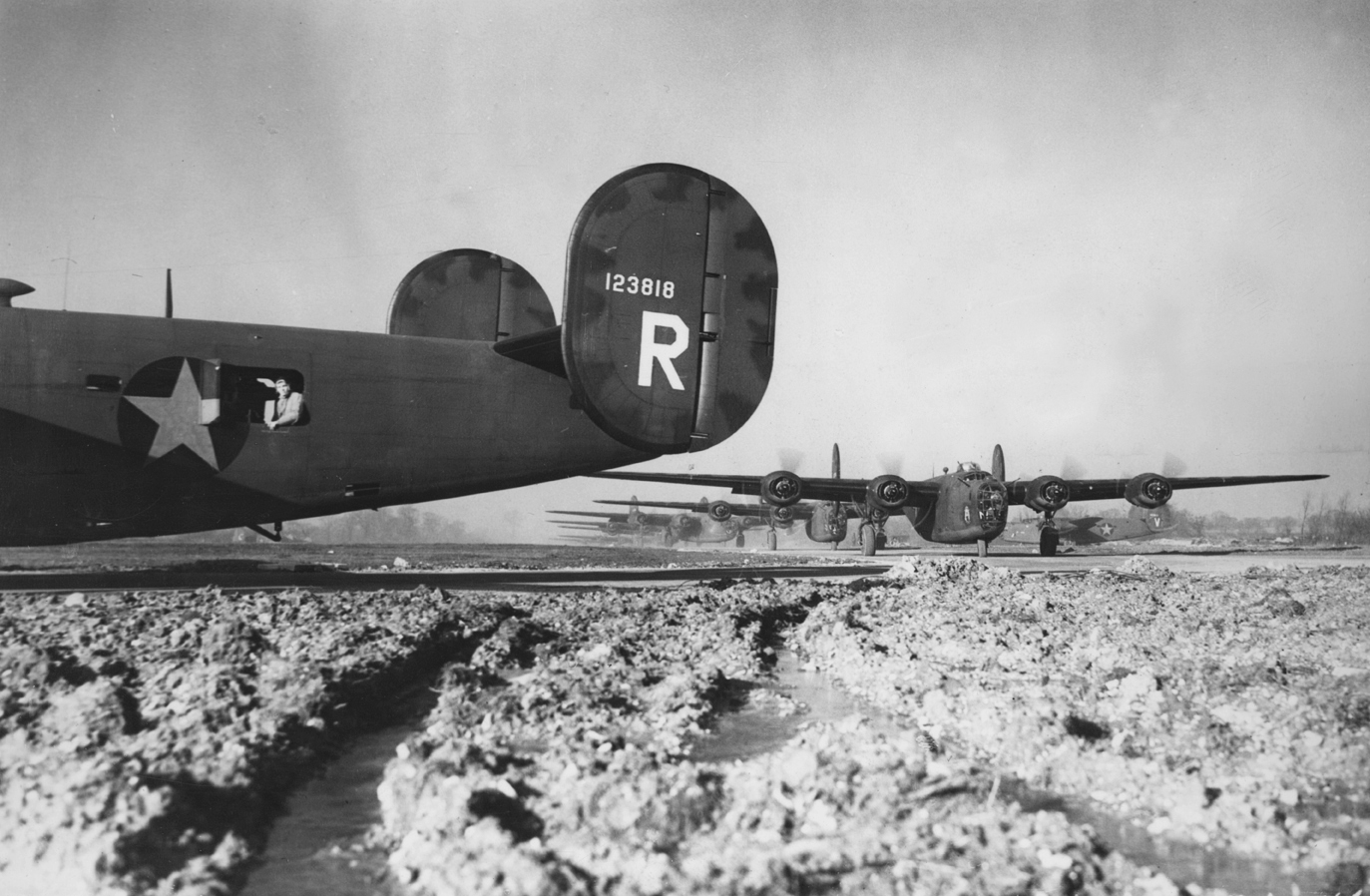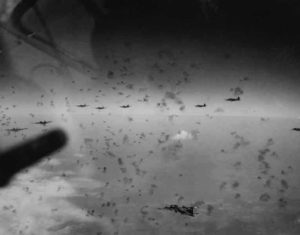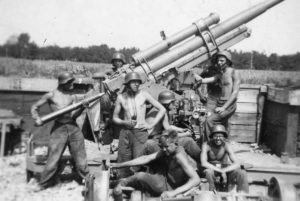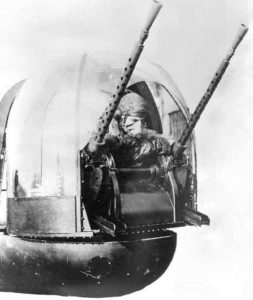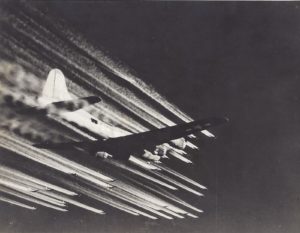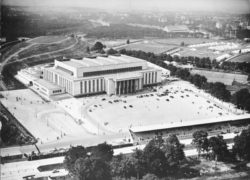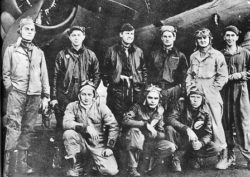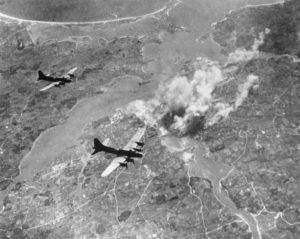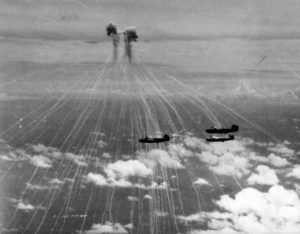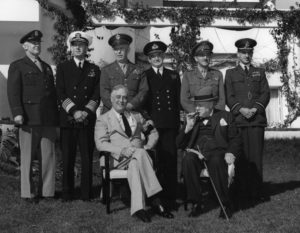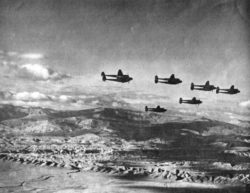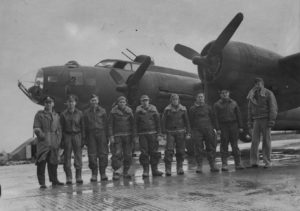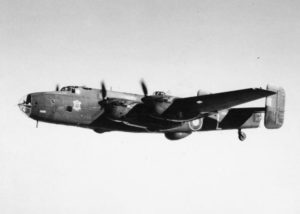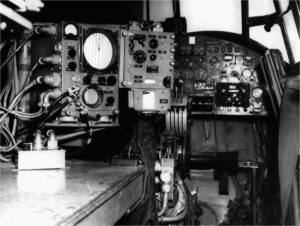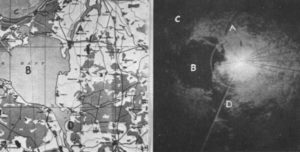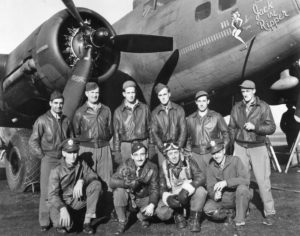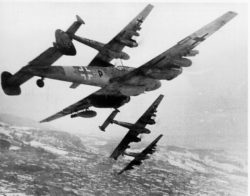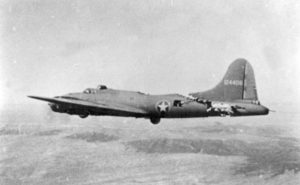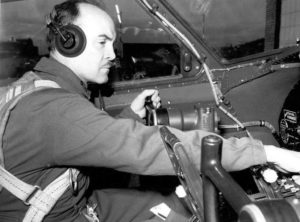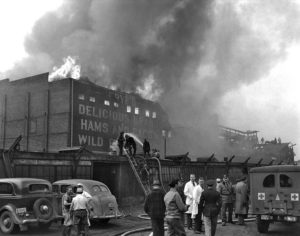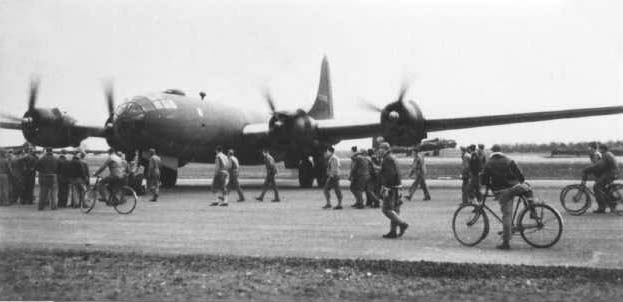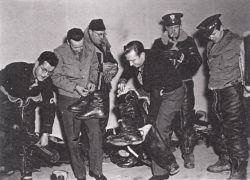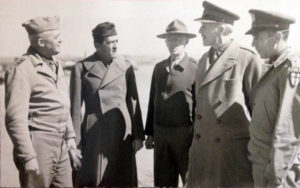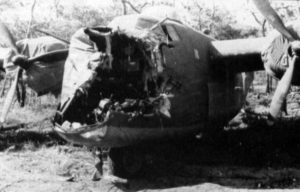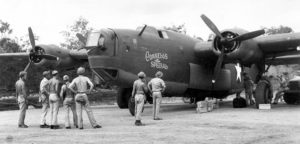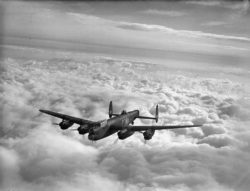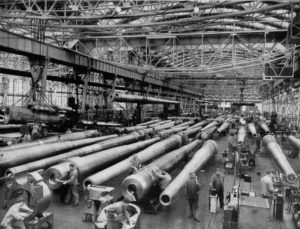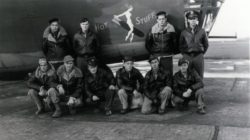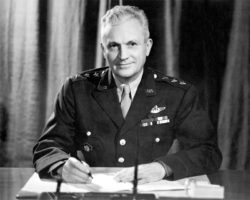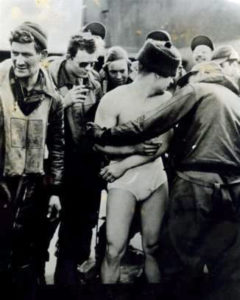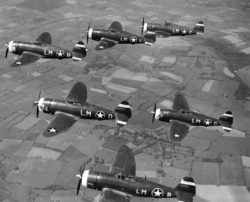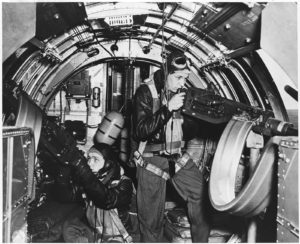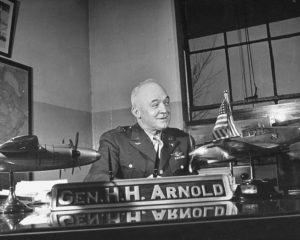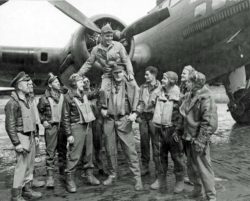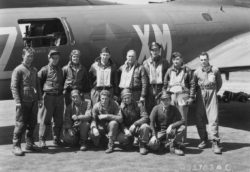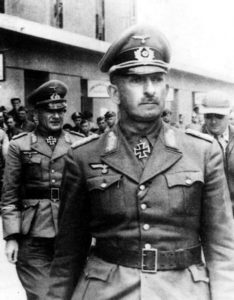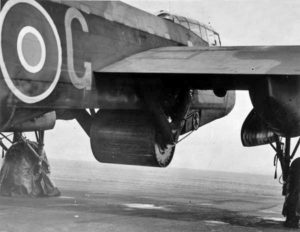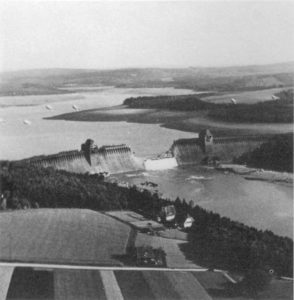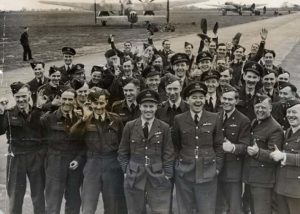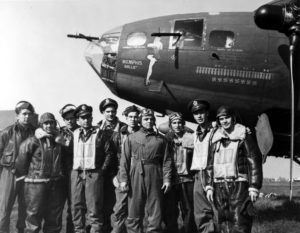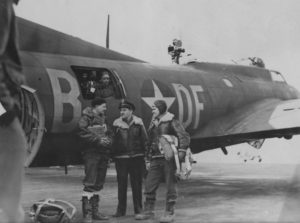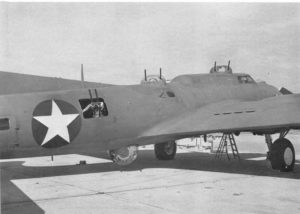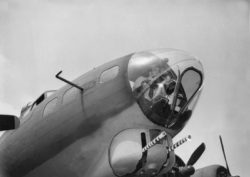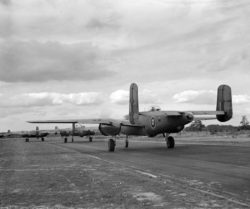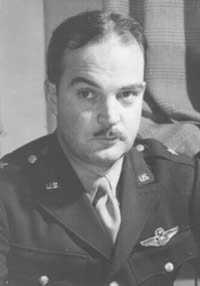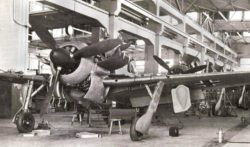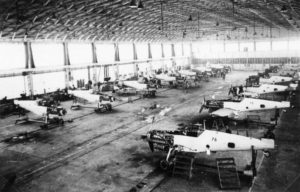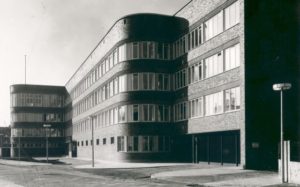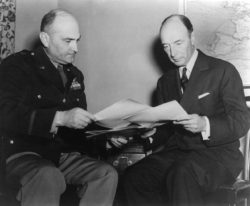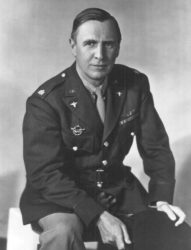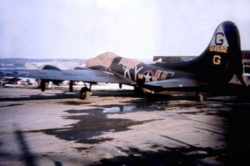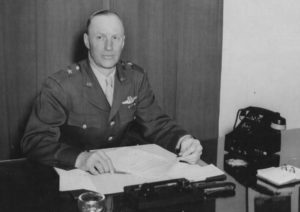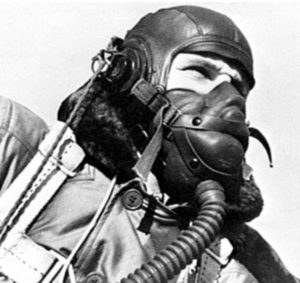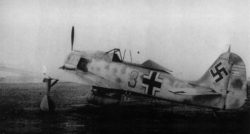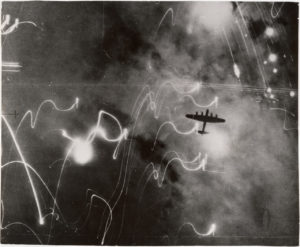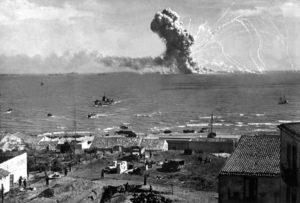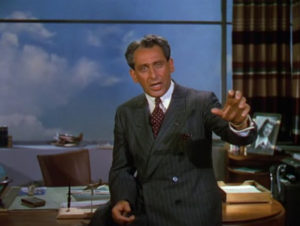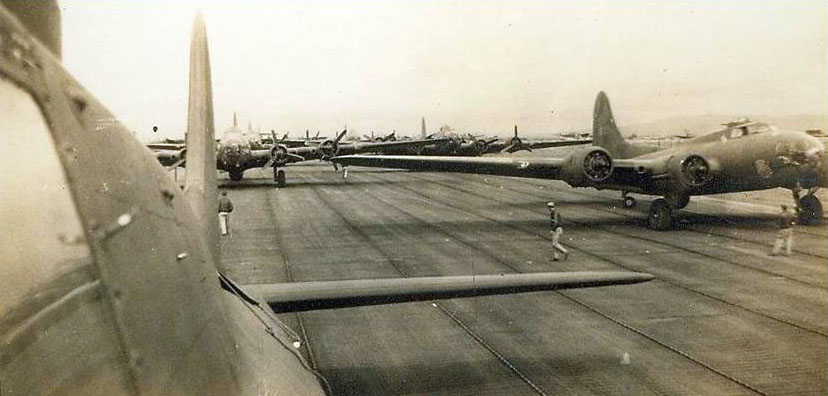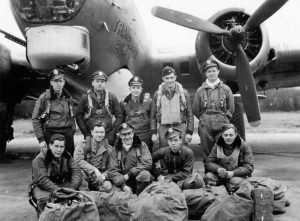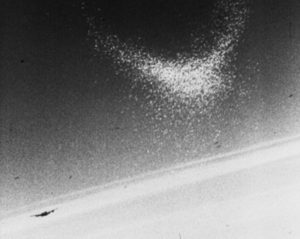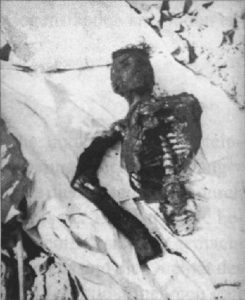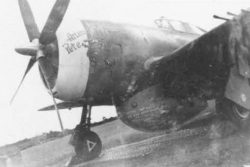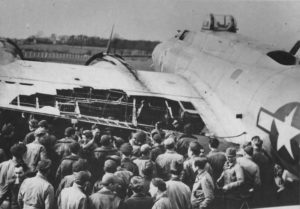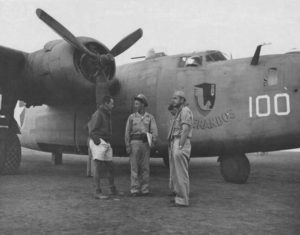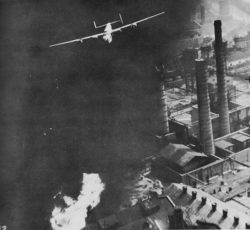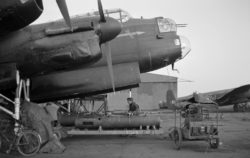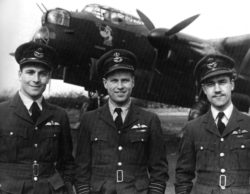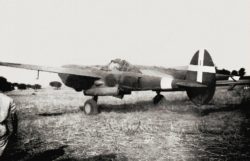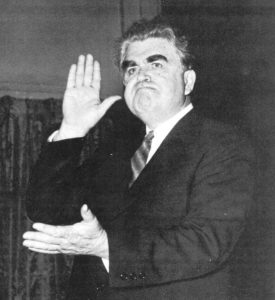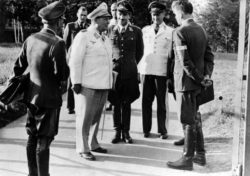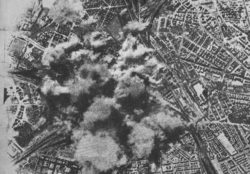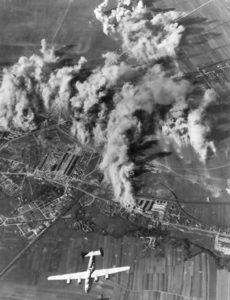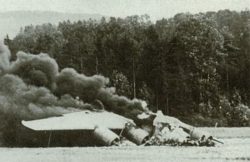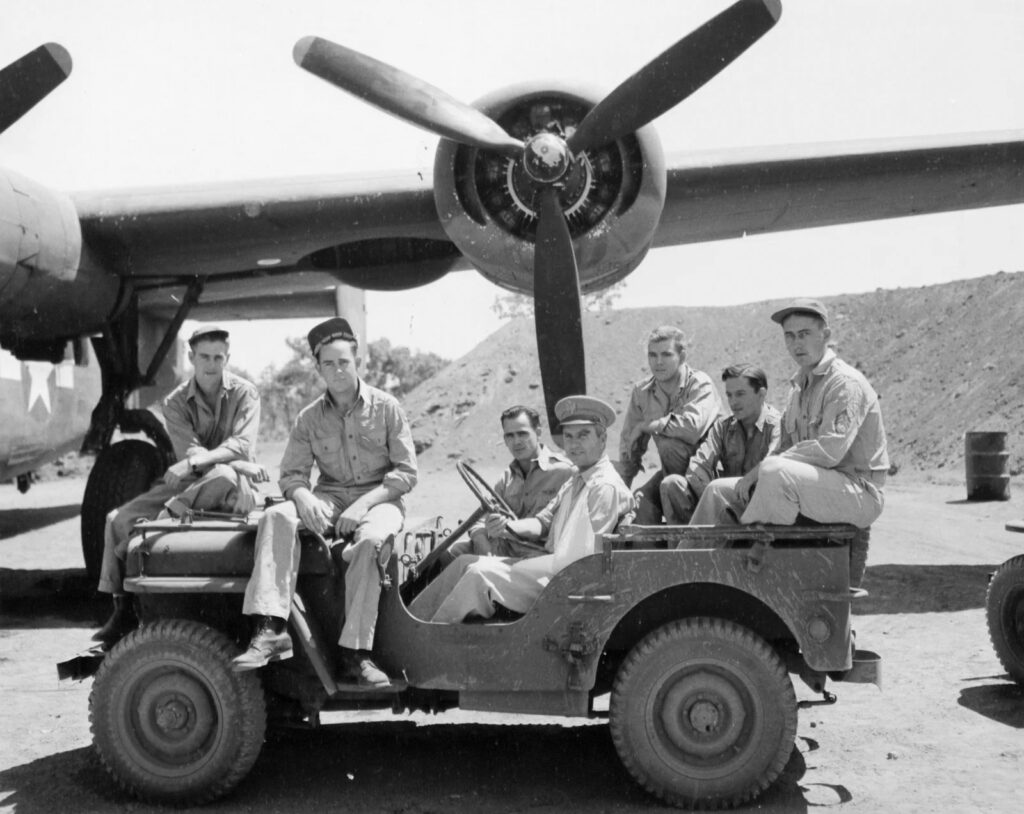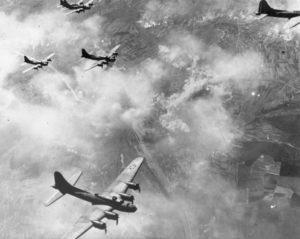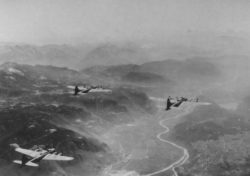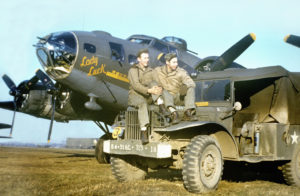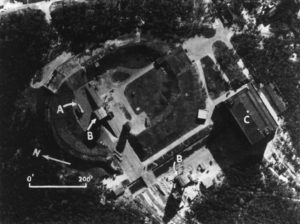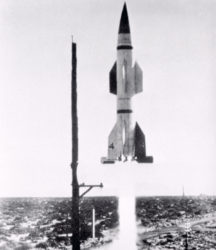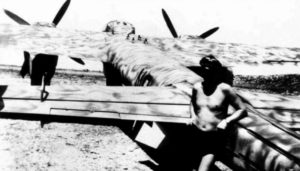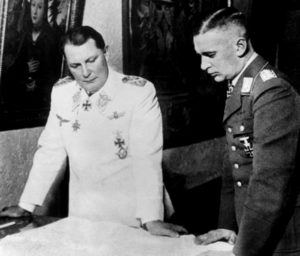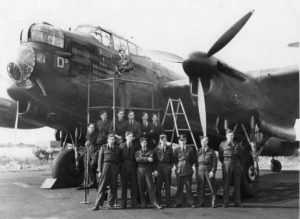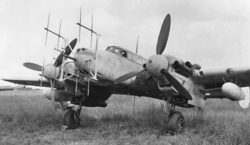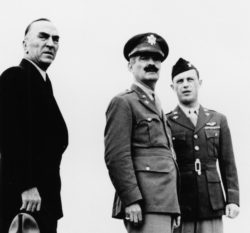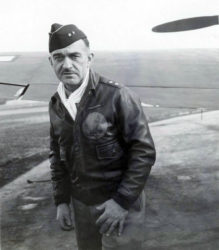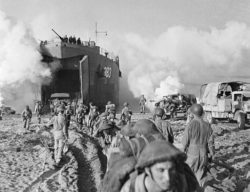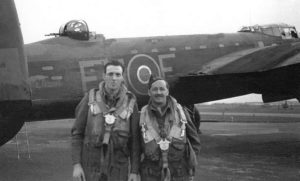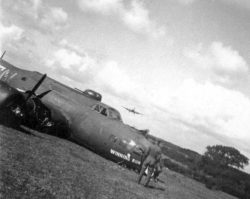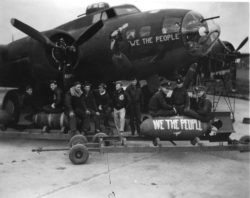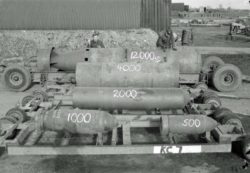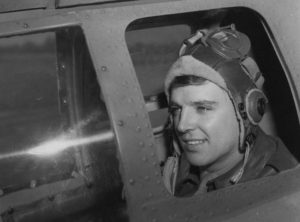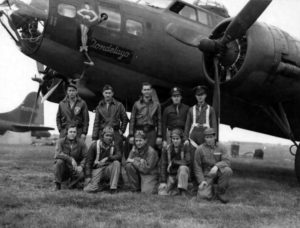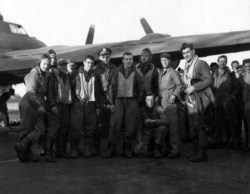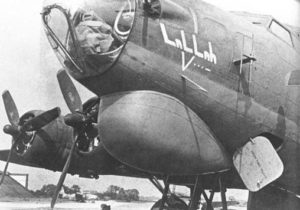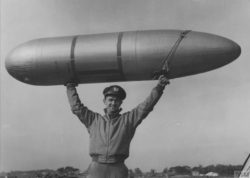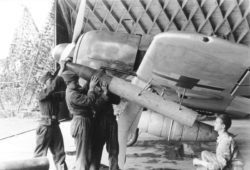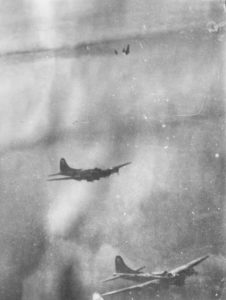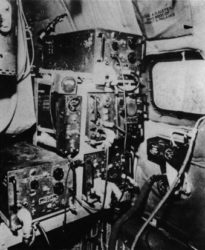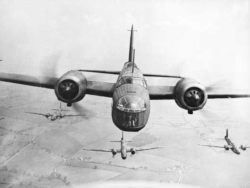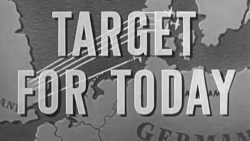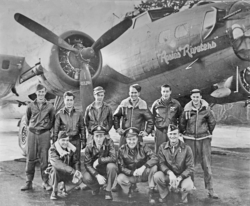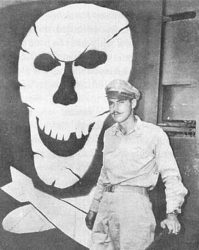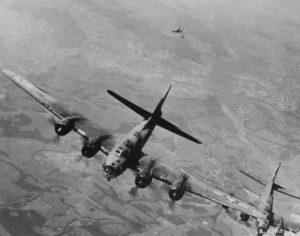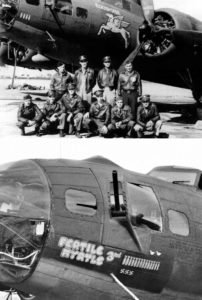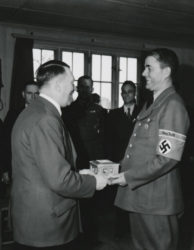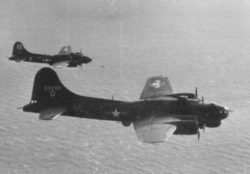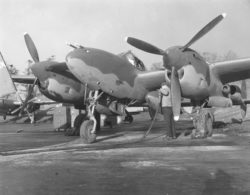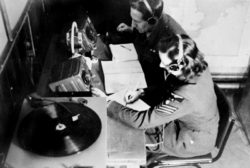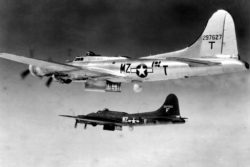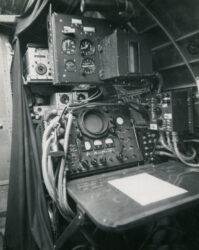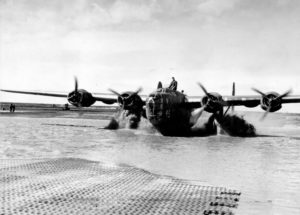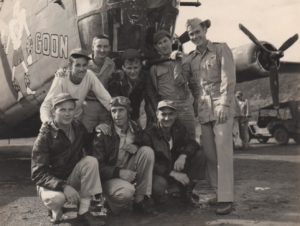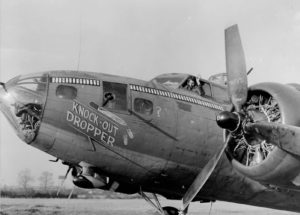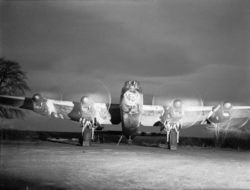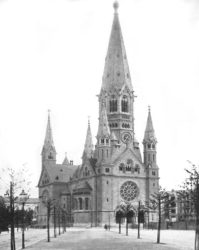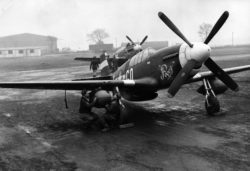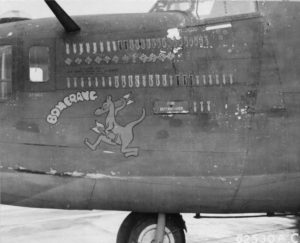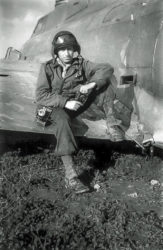Timeline of Strategic Aviation
Second World War
1943
3 JANUARY 1943
The US 8AF launches 72 Boeing B-17s and 13 Consolidated B-24s, led by CO 1BW COL Haywood S. Hansell, Jr. aboard “S-Sugar” (41-24619, 303BG), against the submarine pens of Saint-Nazaire, France for the first time since 23 November 1942. The force is escorted by fighters of RAF FC. A number of changes are made on this strike, namely “bombing on the leader,” wherein only the lead aircraft of each formation – crewed by handpicked airmen – aim for the target. The other aircraft simply release their bombs on the leader’s signal. This tactic proves effective when reconnaissance photos later show heavy damage to the dockyards.
| Bombers Launched: | 85 |
| Bombers Effective: | 68 |
| Bombers MIA: | 7 |
| Bombers DBR: | 3 |
| Bombers Abort: | 17 |
| Abort Rate: | 20% |
| Loss Rate: | 12% |
| E/A Destroyed: | 3 |
| Aircraft Type | Serial No. | Name | Code | Unit | MACR |
| Boeing B-17F-35-BO | 42-5084 | Panhandle Doggie II | OR-unk | 323BS/91BG | 2286 |
| Boeing B-17F-20-BO | 41-24526 | Leapin' Liz | VK-J | 358BS/303BG | 7650 |
| Boeing B-17F-27-BO | 41-24608 | Yehoodi | BN-S | 359BS/303BG | 15720 |
| Boeing B-17F-27-BO | 41-24620 | Snap! Crackle! Pop! | PU-D | 360BS/303BG | 15464 |
| Boeing B-17F-20-BO | 41-24517 | Kali | GN-O | 427BS/303BG | 6141 |
| Boeing B-17F-15-BO | 41-24501 | BO-unk | 368BS/306BG | 15627 |
| Boeing B-17F-10-BO | 41-24470 | Sons Of Fury | WW-unk | 369BS/306BG | 16427 |
SSGT Alan E. Magee, ball turret gunner on Snap! Crackle! Pop! (41-24620, 303BG) survives a fall of some 21,000 ft without a parachute, crashing through the glass of the St. Nazaire railway station. While seriously injured, Magee receives medical attention and makes a slow recovery, resulting in Magee holding the record for the highest survived freefall until 1972.
Rather than try and track the bombers, this day also sees the first use of predicted concentration AAA fire, as opposed to barrage or continuously pointed fire. Similar to the latter, this form of flak requires the successful calculation of target altitude and heading, though fires in grouped bursts rather than individually. This form of AAA is rather limited in its use, as it is easily confused by preplanned courses with regular changes in altitude and heading. German anti-aircraft defense is largely built around the Krupp 88 mm gun. History's most influential AAA, the 88 mm fires a 20 lb shell at a maximum range of 32,480 ft – the service ceilings of Allied bombers is such that only the US B-17 can easily outclimb it, which, in the interests of accuracy, it rarely does. As lethal in the anti-tank role as in the anti-aircraft one, some 27,000 88 mm guns are built during the war, the vast majority of them being pressed into the AAA service by war’s end.
| Krupp 88 mm Fliegerabwehrkanone | ||
| Rate of Fire: | 15 rpm | |
| Muzzle Velocity: | 2,756 ft/s | |
| Effective Range: | 8,749 yd | |
11 January 1943
AVM Ralf S. Sorley, Controller of Research & Development at the British Ministry of Aircraft Production, calls for the development of 20 mm and .50 caliber gun turrets. While the RAF already equips its bombers with .303 caliber MGs in pairs and quads in the nose, tail, and upper deck, the small bullet and short range of the .303 leaves British turrets unequal to the task of bomber defense. Dissatisfied with the slow progress of major firms, CINC RAF BC Air Mshl Sir Arthur T. Harris goes outside of official channels, privately contracting Rose Brothers for a new design. While the .50 caliber Rose turret eventually enters service in June 1944, too few are built to make any significant impact. Harris is critical of British manufacturers and their sluggish production with good reason; Nash & Thompson, for example, fails to complete their .50 caliber design, the FN82, until January 1945 – four months before the war’s end.
No turret enters wartime service with RAF BC using 20 mm autocannon and few bombers are outfitted with .50 caliber turrets, most of these being Canadian-built Lancasters carrying Martin 250CEs.
| Browning AN-M2 .30 caliber MG (7.62 mm) | ||
| Rate of Fire: | 1,200 rpm | |
| Muzzle Velocity: | 2,800 ft/s | |
| Effective Range: | 1,500 yd | |
| Browning AN-M2 .50 caliber MG (12.7 mm) | ||
| Rate of Fire: | 800 rpm | |
| Muzzle Velocity: | 2,910 ft/s | |
| Effective Range: | 2,500 yd | |
| Hispano-Suiza M24 Autocannon (20 mm) | ||
| Rate of Fire: | 650 rpm | |
| Muzzle Velocity: | 2,850 ft/s | |
| Effective Range: | 2,000 yd | |
13 January 1943
The US 8AF launches 72 Boeing B-17s against the Atelier d’Hellemmes (Hellemmes Rail Works) of Lille, France while 16 Consolidated B-24s fly a diversionary route. The bombers are escorted by 69 Supermarine Spitfires, with additional escort provided by RAF FC. This day sees the first use of the box formation as tactical doctrine throughout the entire 8AF. Originally developed by CO 305BG COL Curtis E. LeMay, the formation was first tested on 6 December 1942 in an 18-plane group format. With the growth of Luftwaffe tactics that target bombers head-on, the box formation is altered to stagger aircraft back from one another, forcing interceptors to either pull away or fly through a long stream of returning fire. The 18-plane group-formation model is also expanded, using the same concept for 54-plane bombardment wings. In response, German tactics increasingly seek methods of spreading out the formation so as to attack bombers piecemeal.
The box formation remains standard operating procedure for the rest of the war.
| Bombers Launched: | 88 |
| Bombers Effective: | 80 |
| Bombers MIA: | 3 |
| Bombers Abort: | 8 |
| Abort Rate: | 9% |
| Loss Rate: | 3% |
| E/A Destroyed: | 1 |
| Aircraft Type | Serial No. | Name | Code | Unit | MACR |
| Boeing B-17F-27-BO | 41-24601 | XK-P | 365BS/305BG | 15639 |
| Boeing B-17F-15-BO | 41-24498 | WW-unk | 369BS/306BG | 15634 |
| Boeing B-17F-10-BO | 41-24471 | Four Of A Kind | WW-unk | 369BS/306BG | 15502 |
16 January 1943
RAF BC launches this night 11 Handley Page Halifaxes and 190 Avro Lancasters against Berlin, Germany. This is the first British air raid composed solely of four-engine bombers and the first attack on Berlin in over a year.
CINC RAF BC Air Mshl Sir Arthur T. Harris worked hard throughout 1942 to regain public confidence in the British bomber offensive. While the “1,000 Bomber” raids garnered much publicity, they were far from sustainable. Building his numbers, new tactics (such as the Pathfinder forces) and technologies (such as OBOE) encouraged Harris to begin a campaign against Berlin itself. In theory, the destruction of Berlin could bring an early end to the war.
Unfortunately, Berlin lay well-beyond the range of GEE and OBOE, and this night’s strike falters when cloud cover obscures the target area. Despite the aid of Pathfinders - a formal arm of RAF BC (No. 8 Group) as of 8 January - accuracy is nevertheless poor. Repeat operations following the introduction of H2S radar at the end of the month fare little better. (647 total killed)
Pushed by the CCS to adhere to the submarine pen campaign and losing the long winter nights necessary for night attacks on Berlin, the campaign is halted until November.
| 16-Jan-43 | |
| Bombers Launched: | 201 |
| Bombers Effective: | 156 |
| Bombers MIA: | 1 |
| Bombers Abort: | 45 |
| Abort Rate: | 22% |
| Loss Rate: | <1% |
| 17-Jan-43 | |
| Bombers Launched: | 187 |
| Bombers Effective: | 132 |
| Bombers MIA: | 22 |
| Bombers Abort: | 55 |
| Abort Rate: | 29% |
| Loss Rate: | 12% |
| 1-Mar-43 | |
| Bombers Launched: | 302 |
| Bombers Effective: | 248 |
| Bombers MIA: | 17 |
| Bombers Abort: | 54 |
| Abort Rate: | 18% |
| Loss Rate: | 6% |
| 27-Mar-43 | |
| Bombers Launched: | 396 |
| Bombers Effective: | 345 |
| Bombers MIA: | 9 |
| Bombers Abort: | 51 |
| Abort Rate: | 13% |
| Loss Rate: | 2% |
| 29-Mar-43 | |
| Bombers Launched: | 329 |
| Bombers Effective: | 217 |
| Bombers MIA: | 21 |
| Bombers Abort: | 112 |
| Abort Rate: | 34% |
| Loss Rate: | 6% |
| Aircraft Type | Serial No. | Code | Unit |
| Avro Lancaster Mk. I | ED332 | D | 61 Squadron |
| Handley Page Halifax Mk. II | W7886 | C | 35 Squadron |
| Handley Page Halifax Mk. II | DT569 | C | 76 Squadron |
| Handley Page Halifax Mk. II | DT647 | P | 76 Squadron |
| Avro Lancaster Mk. I | W4379 | A | 9 Squadron |
| Avro Lancaster Mk. I | ED436 | G | 9 Squadron |
| Avro Lancaster Mk. I | W4761 | P | 9 Squadron |
| Avro Lancaster Mk. I | W4157 | V | 9 Squadron |
| Avro Lancaster Mk. I | W4789 | E | 12 Squadron |
| Avro Lancaster Mk. I | W4372 | G | 12 Squadron |
| Avro Lancaster Mk. I | W4368 | U | 12 Squadron |
| Avro Lancaster Mk. I | ED388 | Y | 12 Squadron |
| Avro Lancaster Mk. I | ED318 | X | 44 Squadron |
| Avro Lancaster Mk. III | ED444 | C | 49 Squadron |
| Avro Lancaster Mk. III | ED471 | unk | 50 Squadron |
| Avro Lancaster Mk. I | W4767 | J | 61 Squadron |
| Avro Lancaster Mk. I | R5630 | T | 83 Squadron |
| Avro Lancaster Mk. I | R5575 | L | 97 Squadron |
| Avro Lancaster Mk. I | W4321 | P | 101 Squadron |
| Avro Lancaster Mk. I | W4378 | N | 467 Squadron |
| Avro Lancaster Mk. I | W4772 | X | 1654 Combined |
| Avro Lancaster Mk. I | R5843 | C | 1654 Combined |
| Avro Lancaster Mk. I | ED316 | unk | 1656 Combined |
| Short Stirling Mk. I | W7518 | G | 15 Squadron |
| Short Stirling Mk. I | EF347 | T | 15 Squadron |
| Short Stirling Mk. III | BK692 | W | 149 Squadron |
| Short Stirling Mk. I | R9145 | K | 214 Squadron |
| Handley Page Halifax Mk. II | W7877 | O | 35 Squadron |
| Handley Page Halifax Mk. II | BB223 | C | 51 Squadron |
| Handley Page Halifax Mk. II | DT556 | U | 76 Squadron |
| Handley Page Halifax Mk. II | DT767 | V | 76 Squadron |
| Handley Page Halifax Mk. II | DT797 | H | 408 Squadron |
| Handley Page Halifax Mk. II | DT641 | R | 419 Squadron |
| Avro Lancaster Mk. I | W4829 | V | 44 Squadron |
| Avro Lancaster Mk. III | ED592 | B | 50 Squadron |
| Avro Lancaster Mk. III | ED423 | N | 50 Squadron |
| Avro Lancaster Mk. I | W4920 | O | 61 Squadron |
| Avro Lancaster Mk. I | W4825 | H | 97 Squadron |
| Avro Lancaster Mk. I | W4880 | H | 103 Squadron |
| Avro Lancaster Mk. I | W4361 | N | 103 Squadron |
| Short Stirling Mk. I | BF317 | X | 7 Squadron |
| Short Stirling Mk. I | BF453 | L | 214 Squadron |
| Handley Page Halifax Mk. II | W7907 | M | 35 Squadron |
| Handley Page Halifax Mk. II | HR753 | H | 158 Squadron |
| Handley Page Halifax Mk. II | BB334 | H | 408 Squadron |
| Handley Page Halifax Mk. II | DT634 | R | 419 Squadron |
| Avro Lancaster Mk. I | W4839 | F | 44 Squadron |
| Avro Lancaster Mk. I | W4322 | U | 101 Squadron |
| Avro Lancaster Mk. I | W4895 | unk | 156 Squadron |
| Short Stirling Mk. III | BK708 | P | 149 Squadron |
| Short Stirling Mk. III | BK716 | J | 218 Squadron |
| Short Stirling Mk. III | BK702 | O | 218 Squadron |
| Handley Page Halifax Mk. II | BE244 | Q | 51 Squadron |
| Handley Page Halifax Mk. II | DT744 | K | 76 Squadron |
| Handley Page Halifax Mk. II | DT563 | O | 76 Squadron |
| Handley Page Halifax Mk. II | JB842 | E | 77 Squadron |
| Handley Page Halifax Mk. II | HR757 | M | 158 Squadron |
| Handley Page Halifax Mk. II | DT679 | Q | 408 Squadron |
| Handley Page Halifax Mk. II | HR654 | R | 408 Squadron |
| Avro Lancaster Mk. I | W4858 | A | 12 Squadron |
| Avro Lancaster Mk. I | W4199 | H | 44 Squadron |
| Avro Lancaster Mk. III | ED469 | A | 49 Squadron |
| Avro Lancaster Mk. III | ED435 | K | 49 Squadron |
| Avro Lancaster Mk. I | ED761 | Z | 57 Squadron |
| Avro Lancaster Mk. I | R5754 | X | 83 Squadron |
| Avro Lancaster Mk. III | ED596 | H | 106 Squadron |
| Avro Lancaster Mk. II | DS625 | W | 115 Squadron |
| Avro Lancaster Mk. I | W4931 | U | 207 Squadron |
| Avro Lancaster Mk. I | ED391 | E | 460 Squadron |
| Avro Lancaster Mk. I | W4327 | S | 460 Squadron |
23 January 1943
The US 12AF launches two waves of B-17s, escorted by Lockheed P-38s, against the ports of Bizerte, Tunisia while a third wave flies diversion. This strike is the result of a heated confrontation between A-3 12AF COL Lauris Norstad and LTC Paul W. Tibbets, Jr. During the planning for the strike against Bizerte, Tibbets objected to Norstad’s insistence at flying at 6,000 ft. Having flown on strikes against Bizerte before, Tibbets lobbied for the strike to be flown at a higher altitude, threatening Norstad to accompany the strike to prove his point. Norstad backed down and the mission flown without loss, but the incident is not forgotten and Tibbets is afterward reassigned.
A gifted administrator and fiercely ambitious, Norstad was quick to throw his weight around in the MTO. This did not help, what MG George S. Patton, Jr. sarcastically called, his “boy wonder” image (Norstad was 35 years old). Norstad rose far in part due to his relationship with CS 12AF BG Hoyt S. Vandenburg. Vandenburg’s career was facilitated through his uncle, Sen. Arthur H. Vandenburg (R-MI), and Vandenburg and Norstad supported each other’s rapid rise through the ranks – often at the expense of more experienced commanders like Tibbets and BG Elwood P. Quesada. The fact that Tibbets and Quesada possessed superb combat records lends some credence to these accusations. Likewise, CG 12AF MG Jimmy H. Doolittle’s inability to promote Tibbets (a veteran of some 43 combat operations) due to Norstad’s objections speaks volumes, as Doolittle’s recommendations were overruled despite actually being the superior officer.
Also on this day, the US 8AF launches 73 Boeing B-17s against the submarine pens of Brest and Lorient, France while 17 Consolidated B-24s fly a diversionary route. The strike is escorted by fighters of RAF FC. This day sees the first recorded use of Luftwaffe interceptors dropping bombs into US bomber formations. Providing that large formations are tightly held, the box formation proved to be a formidable challenge. It is hoped that this tactic can break up US bomber formations, allowing interceptors to pick off straggling aircraft piece-meal. During the strike, Beats Me!? (41-24567, 303BG) becomes the first US bomber brought down by a “formation mine.” Air bursts prove effective at breaking up tight formations but rarely cause heavy damage. The clumsiness of this tactic will later encourage German development of air-to-air missiles.
| Bombers Launched: | 90 |
| Bombers Effective: | 71 |
| Bombers MIA: | 5 |
| Bombers DBR: | 2 |
| Bombers Abort: | 19 |
| Abort Rate: | 21% |
| Loss Rate: | 8% |
| E/A Destroyed: | 1 |
| Aircraft Type | Serial No. | Name | Code | Unit | MACR |
| Boeing B-17F-25-BO | 41-24580 | Hellcat | VK-C | 358BS/303BG | |
| Boeing B-17F-27-BO | 41-24603 | Green Hornet | BN-Y | 359BS/303BG | |
| Boeing B-17F-25-BO | 41-24567 | Beats Me!? | PU-J | 360BS/303BG | 15571 |
| Boeing B-17F-25-BO | 41-24584 | SUSFU | GN-Q | 427BS/303BG | |
| Boeing B-17F-27-BO | 41-24607 | Jerry Jinx | GN-W | 427BS/303BG | 15473 |
24 January 1943
The Casablanca Conference (SYMBOL) concludes in occupied-Morocco after 10 days of meetings between US Pres. Franklin D. Roosevelt (D-NY), British PM the Rt. Hon. Winston L. Spencer-Churchill (CP), and the Combined Chiefs of Staff (CCS). The conference covers a variety of topics, namely the leadership of the Free French government, the “unconditional surrender” of the Axis powers, and the consolidation of Allied forces in the Mediterranean under CG SHEAF LTG Dwight D. Eisenhower (with Air Chf Mshl Sir Arthur W. Tedder in command of the air forces). Rather than a cross-channel invasion of Europe, a compromise is reached through an invasion of Italy, beginning with Sicily that summer. Churchill hoped to invade the Balkans via Italy and approach Germany through Eastern Europe, simultaneously denying Germany its oil and the Soviet Union its imperial ambitions. The US agrees to this on the condition that a formal invasion of Western Europe via France still eventually take place. For Allied air leaders this establishes a ticking-clock element to the strategic bombing campaigns: if they are to pay any dividends they must do so before the landings in France if they are to justify their worth. Unfortunately, political support for the US effort is already beginning to waver.
Just as British airmen are starting to show support for the fledgling US campaign, Churchill grows increasingly wary of daylight bomber losses. Noting that the US 8AF is beginning to suffer losses akin to those suffered by the RAF in 1940, Churchill favors consolidating the 8AF under British command and expanding on the RAF’s night campaign. An impassioned presentation by CG 8AF MG Ira C. Eaker is made on behalf of the US’s daylight offensive and Churchill is won over with the phrase “round-the-clock bombing,” meaning that constant day and night offensives would require the dispersal of Luftwaffe interceptors and the overwork of AAA defenses.
On 21 January 1943 the CCS releases a formal directive for the heavy bombing campaigns, reiterating sub-pens as top priority targets. For Eaker, this means expanding the US sub-pen campaign to include strikes against German ports - after all, AWPD-42 had argued that the only way to affect sub-pens was to target the infrastructure which supported them. CINC RAF BC Air Mshl Sir Arthur T. Harris uses the vague phrasing of the directive to simply continue his area-bombing offensive. The listing of oil refineries as fourth priority goes counter to the British Ministry of Economic Warfare, who had consistently highlighted Germany’s petroleum issues. Partially as a solvent for this, but more-so as a concession toward Churchill’s desires to take the Balkans, CG USAAF LTG Henry H. Arnold proposes denying Germany the oil of Eastern Europe through aerial bombardment. As such, Arnold's advisory staff begins drafting a potential strike against Ploiești, România.
Lastly, Arnold formalizes the decision to send all further Lockheed P-38 deliveries to the MTO. The previous year had seen the 1FG and 14FG transfer from the 8AF to the MTO, taking away the 8AF's entire P-38 complement. At face value, this decision is wise: the P-38 is a notoriously poor performer in the cold temperatures of high altitude operations, and keeping the P-38s in North Africa and the Republic P-47s in England simplifies the supply chain. However, the P-38's range is somewhat longer than that of the P-47. As such, if the ever deepening 8AF strikes are to be accompanied by fighter escort, a means must be found to effectively lengthen the P-47's range beforehand. This does not take place.
27 January 1943
The US 8AF launches 84 Boeing B-17s and seven Consolidated B-24s against the submarine pens of Wilhelmshaven. This is the first US heavy bomber strike against Germany. The force is led by CO 306BG COL Frank A. Armstrong, Jr. aboard Meadowlark (42-5378) and is escorted by fighters of RAF FC. Armstrong replaced the 306BG’s original CO, COL Charles B. Overacker, Jr., on 4 January 1943 because of the unit’s hard-luck reputation and high-abort rate. While AWPD-42 listed 15% as an acceptable abort rate, the 306BG's rate had reached 47%, with all but one of its 30 December force aborting (the final straw for Overacker) . It should be noted that high abort rates plague Allied bomber units, with airmen often reporting phony equipment malfunctions to avoid going into combat. Solutions for this varied, with CO 305BG COL Curtis E. LeMay, in particular, gaining a reputation for hard-nosed punishments and on-the-spot demotions. Armstrong’s solutions are similar, including such imaginative measures as having convicted airmen wear their oxygen masks for a full 24 hrs. Armstrong is promoted to CO 1BW on 15 June when its former commander, BG Haywood S. Hansell, Jr., is reassigned on charges of stress; this promotion is short-lived as Armstrong is badly burned in a fire the following month, necessitating a transfer to a stateside training command.
While it is not uncommon for historians to dismiss the effectiveness of aerial gunners, it is worth noting that they could be quite deadly when not approached with proper tactics. Luftwaffe interceptors suffer unusually high losses this day, most of whom come from JG1, who until this point had never faced a US airstrike.
Armstrong’s strict discipline and the resulting improvement in unit performance is later dramatized in the 1949 film Twelve O’Clock High starring Gregory Peck. Under the guise of fictitious names and units, Peck is essentially cast as Armstrong, Gary Merrill as Overacker, and, with a strong physical resemblance, Millard Mitchell as CG 8AF MG Ira C. Eaker. The film is a rare favorite amongst veterans.
| Bombers Launched: | 91 |
| Bombers Effective: | 55 |
| Bombers MIA: | 3 |
| Bombers Abort: | 36 |
| Abort Rate: | 40% |
| Loss Rate: | 3% |
| E/A Destroyed: | 7 |
| Aircraft Type | Serial No. | Name | Code | Unit | MACR |
| Boeing B-17F-27-BO | 41-24637 | KY-F | 366BS/305BG | 15501 |
| Consolidated B-24D-1-CO | 41-23690 | GJ-O | 68BS/44BG | 15637 |
| Consolidated B-24D-5-CO | 41-23776 | Spirit Of '76 | GJ-W | 68BS/44BG | 15459 |
30 January 1943
RAF BC launches this night seven Short Stirlings, six Handley Page Halifaxes, and 135 Avro Lancasters against Hamburg, Germany. The Stirlings and Halifaxes are Pathfinders and are equipped with the new H2S radar system (also known as Stinky) – the first airborne, ground-mapping radar. (58 killed)
The concept of bombing via radar originated as a solution to the problems noted in the Butt Report, as researchers under Phillip I. Dee noted that their ground-based, short-wave radar stations showed strong returns from nearby towns. On 1 January 1942 the Telecommunications Research Establishment set up a team under A. C. Bernard Lovell to develop an S-band, airborne ground-mapping radar, performing their first aerial test on 23 April 1942 aboard Halifax Mk. II V9977. Debates raged about the benefits of a using a glass-based klystron versus a copper-based magnetron, the concern being that a magnetron unit might fall into German hands. Regardless, personal intervention from PM the Rt. Hon. Winston L. Spencer-Churchill (CP) on 15 September 1942 authorized H2S for operational usage, demanding 200 radar-equipped aircraft by 15 October 1942. This goal was not met and the first sets went to aircraft of Coastal Command, thought to be the safer option. Regardless of these concerns, an intact radar is recovered by the Germans on 2 February 1943 - the night of H2S's second usage.
H2S works by reading the echoes of a radio signal transmitted below the bomber. The echoes are mapped onto a screen, giving a rudimentary, curved picture of the area below. While large cities and bodies of water give strong readings on the scopes, other images are more difficult to interpret. As such, choosing Hamburg as H2S’s first operational target is wise; as a coastal city, it is easier to locate than inland targets. While accuracy this night is poor due to inexperienced radar operators, H2S units eventually see heavy use as the most advanced “blind-bombing” technology to see service in the Second World War. CINC RAF BC Air Mshl Sir Arthur T. Harris orders on 21 February 1943 that all RAF BC aircraft be equipped with H2S to aid both in accuracy and navigation. The US later adopts its own variant, H2X, in late-1943, favoring the Pathfinder system of radar-equipped lead bombers.
Earlier this day, RAF BC launches a surprise daylight raid against Berlin. Timed to coincide with public appearances by RLM RM Hermann W. Göring and RMVP Minister P. Joseph Goebbels, six de Havilland Mosquitoes successfully disrupt the day’s events. This is the first daylight air raid on Berlin.
| Bombers Launched: | 154 |
| Bombers Effective: | 102 |
| Bombers MIA: | 6 |
| Bombers Abort: | 52 |
| Abort Rate: | 35% |
| Loss Rate: | 4% |
| Aircraft Type | Serial No. | Code | Unit |
| de Havilland Mosquito Mk. IV | DZ367 | J | 105 Squadron |
| Avro Lancaster Mk. III | ED477 | O | 9 Squadron |
| Avro Lancaster Mk. I | W4189 | unk | 57 Squadron |
| Avro Lancaster Mk. I | W4835 | H | 97 Squadron |
| Avro Lancaster Mk. I | ED447 | Q | 101 Squadron |
| Avro Lancaster Mk. I | W4826 | D | 106 Squadron |
4 February 1943
The US 8AF launches 65 Boeing B-17s and 21 Consolidated B-24s against the the marshaling yards of Hamm, Germany; due to cloud cover, the strike is diverted to Emden. This day sees the crew of Jack The Ripper (41-24490, 91BG) fly their final combat mission, becoming the first airmen in the 8AF to return to the US. Having completed 11 sorties under 2LT William J. Crumm, the crew is chosen to author a report entitled "Bombing the Nazis," instructing ETO-bound crews on what to expect overseas. Jack The Ripper's crew return in a specially-modified B-17F (42-5796), the intent being to show what changes are desired ETO-bound B-17s.
This is the third 8AF heavy bomber operation to be launched without fighter escort.
| Bombers Launched: | 86 |
| Bombers Effective: | 39 |
| Bombers MIA: | 5 |
| Bombers Abort: | 47 |
| Abort Rate: | 55% |
| Loss Rate: | 6% |
| E/A Destroyed: | 9 |
| Aircraft Type | Serial No. | Name | Code | Unit | MACR |
| Boeing B-17F-25-BO | 41-24544 | Pennsylvania Polka | OR-O | 323BS/91BG | 3557/4635 |
| Boeing B-17F-27-BO | 41-24589 | Texas Bronco | OR-R | 323BS/91BG | 15124 |
| Boeing B-17F-25-BO | 41-24569 | Memphis Tot | GN-V | 427BS/303BG | 15348 |
| Boeing B-17F-27-BO | 41-24593 | El Lobo | WF-G | 364BS/305BG | 15395 |
| Boeing B-17F-30-BO | 42-5060 | What's Cookin', Doc? | JJ-Q | 422BS/305BG |
This day also sees the first use of twin-engine night-fighters like the Ju-88 and Bf-110 against US bombers. The massive armament of the Bf-110 makes it a capable bomber-destroyer, though its slow speeds and large size make it far easier for US gunners to target. Escort fighters lucky enough to encounter them refer to them derisively as “meat on the table.”
The astounding resiliency of the B-17 proves a difficult problem for German interceptors. The Battle of Britain highlighted the deficiencies in coupling .30 caliber-type machine guns with 20 mm autocannon, but now the issue was becoming critical. Early interceptions revealed the ubiquitous MG 17 (7.62 mm) as practically useless, and an average of twenty direct 20 mm hits were required to down a single heavy bomber. German designers scramble to find new ways of increasing armament size on their single-engine fighters while the Luftwaffe turns to night fighters - whose heavier armament betrays a sore lack of speed and maneuverability - to augment US bomber interceptions. Day fighter variants designed to carry heavier armament generally feature large bulges in the nose and wings to accommodate weapons, with the Bf-109G-6 entering service later this month and the FW-109A-6 entering service in July.
| Messerschmitt Bf-109G-6 |
| 2x Rheinmetall MG 131 .51 Caliber MGs (13 mm) |
| 1x Mauser MG 151/20 Autcannon (20 mm) |
| Focke-Wulf FW-190A-6 |
| 2x Rheinmetall MG 17 .32 Caliber MGs (7.92 mm) |
| 4x Mauser MG 151/20 Autcannon (20 mm) |
| Messerschmitt Bf-110G-2 |
| 4x Rheinmetall MG 17 .32 Caliber MGs (7.92 mm) |
| 1x Mauser MG 81 .32 Caliber MG (7.92 mm) |
| 2x Mauser MG 151/20 Autcannon (20 mm) |
18 February 1943
Boeing’s second prototype B-29 (41-0003) crashes after catching fire above Seattle, WA. While the B-29 made its first flight on 21 September 1942, it wasn’t until 30 December that a prototype was flown with its Central Fire Control system. Unfortunately, the extra weight of this equipment, along with the bomber’s troublesome Wright R-3350 engines, resulted in a fire caused by engine-overheating. This day’s flight – the bomber’s second attempt – again results in a engine fire. Attempting to reach Boeing Field, the flaming bomber weaves through the Seattle skyscrapers, falling short and hitting the Frye Meat Packing Plant; Boeing’s chief aerodymnacist, Eddie T. Allen, is killed along with 27 others.
The B-29 is the world’s most advanced airplane, sporting a new mid-wing design, a rounded nose, standard-issue radar, remote-control computerized gunnery system, and heated and pressurized crew compartments. The program to build the B-29 is the single most expensive program of the war (including the Manhattan project) and the US goes to great lengths to ensure the bomber’s completion and usage. Despite this day’s upset, the bomber still goes into production, with some 3,970 being built before its retirement on 21 June 1960.
Two Boeing B-29s currently survive in airworthy configuration, both salvaged from the Naval Air Weapons Station in China Lake, CA where they were used for target practice: Fifi (44-62070) and Doc (44-69972). However, outside the two nuclear-strike aircraft (see Enola Gay and Bock’s Car), pitifully few B-29s retain their combat configurations, their armament being particularly rare. Raz’n Hell (44-61535) is perhaps the most complete surviving B-29, sitting unrestored outdoors at the Castle Air Museum in Atwater, CA. Another B-29, 44-69729, features a restored gunnery system, but budget cuts by Boeing have unwisely left the bomber on outdoor display at the Museum of Flight in Seattle, WA. Outside the missing gunnery system, perhaps the most pristine restoration is Jack’s Hack (44-61975), currently on display at the New England Air Museum in Windsor Locks, CT.
| Powerplant: | 4x Wright R-3350 Air-Cooled 18-Cylinder Two-Row |
| 2,670 lb 2,200 hp Turbocharged Piston Engines | |
| Armament: | 12x Browning AN-M2 .50 Caliber MGs |
| 1x Hispano-Suiza M24 20 mm Autocannon | |
| Bombload: | 20,000 lbs |
| Cruise Speed: | 220 mph |
| Service Ceiling: | 33,600 ft |
| Range: | 5,600 mi |
The US 8AF launches 76 Boeing B-17s and 17 Consolidated B-24s against the ports of Emden, Germany. The strike is escorted by fighters of RAF FC. This operation had been delayed over a week due to poor weather and still yet, poor weather forces the bombers to divert to their secondary target: the submarine pens of Wilhelmshaven. This strike sees the first instance wherein press officials are allowed to accompany an 8AF combat operation. Bowing to pressure from the American news media, the USAAF required a small group of reporters take a week-long course in high altitude survival training prior to the operation. One of the reporters, Bob P. Post of The New York Times, is killed this day, after which the USAAF halts further requests for journalists to accompany combat operations. This directive is eventually relaxed in the coming months.
| Bombers Launched: | 93 |
| Bombers Effective: | 65 |
| Bombers MIA: | 7 |
| Bombers DBR: | 1 |
| Bombers Abort: | 28 |
| Abort Rate: | 19% |
| Loss Rate: | 9% |
| E/A Destroyed: | 3 |
| Aircraft Type | Serial No. | Name | Code | Unit | MACR |
| Boeing B-17F-50-BO | 42-5362 | Short Snorter II | LL-F | 401BS/91BG | 15712 |
| Boeing B-17F-10-BO | 41-24447 | Kickapoo | LL-H | 401BS/91BG | 3575 |
| Boeing B-17F-30-BO | 42-5056 | Devil's Playmate | WF-C | 364BS/305BG | 15120 |
| Boeing B-17F-27-BO | 41-24623 | XK-V | 365BS/305BG | 16054 |
| Boeing B-17F-27-BO | 41-24604 | Arkie | KY-D | 366BS/305BG | 15443 |
| Consolidated B-24D-5-CO | 41-23777 | Maisey | H | 66BS/44BG | 16067 |
| Consolidated B-24D-5-CO | 41-23804 | Sad Sack | J | 66BS/44BG | 16503 |
| Journalist | Aircraft Type | Serial No. | Name | Code | Unit |
| Homer W. Bigart (NY Herald) | Boeing B-17F-25-BO | 41-24559 | Ooold Soljer | PU-C | 360BS/303BG |
| Walter L. Cronkite, Jr. (UP) | Boeing B-17F-27-BO | 41-24619 | GN-S | 427BS/303BG | |
| Gladwin Hill (AP) | Boeing B-17 | unk | unk | unk/305BG | |
| William W. Wade (International) | Boeing B-17 | unk | unk | unk/305BG | |
| Andy A. Rooney (Stars & Stripes) | Boeing B-17F-10-BO | 42-24488 | Banshee II | WW-F | 369BS/306BG |
| Bob P. Post (NY Times) | Consolidated B-24D-5-CO | 41-23804 | Sad Sack | J | 66BS/44BG |
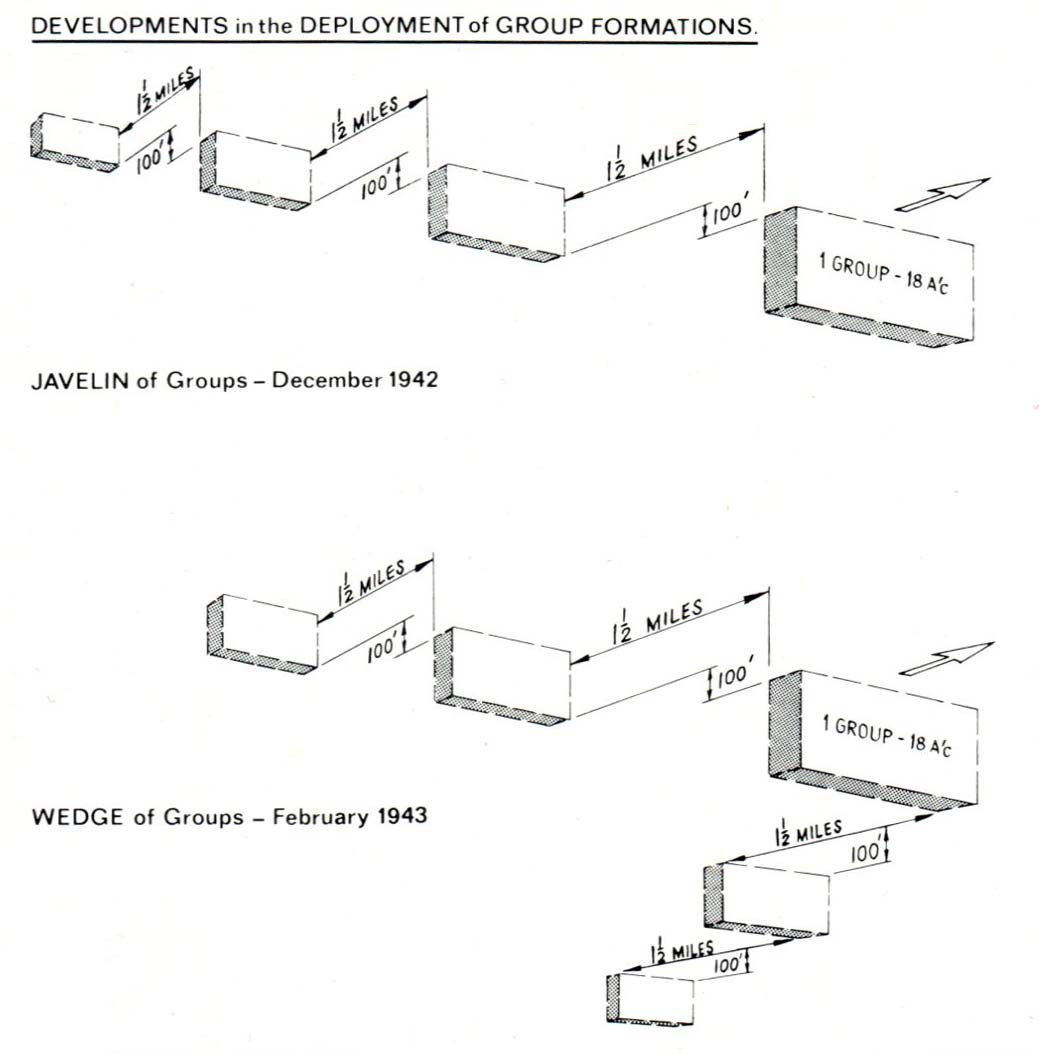
Roger A. Freeman, The Mighty Eighth War Manual, artwork by Norman Ottaway (New York, NY: Jane's Publishing, Inc., 1984).
When the US 8AF adopted CO 305BG COL Curtis E. LeMay's box formation as tactical doctrine, there was some question as to how to space the groups throughout each combat wing. Initially, the idea was to stack the groups in much the same way as the aircraft in the formations, slanting each group down toward the sun in a mock javelin. Once again, this decision was based on the increasing regularity of head-on attacks, the idea being to increase the length of time interceptors would have to fly through US formations. Unfortunately stacking the altitude of each group was problematic, as the engine strain suffered at higher altitudes affected the ability of the higher groups to keep pace with the lower ones. This was changed starting on 16 February by swinging the groups out in a sort of wedge, with the lead group flying an altitude centered between the following units. Because of the 8AF's still relatively small size, this for a time requires mixed wings of B-17s and B-24s, the latter usually flying the low groups because of their inferior altitude performance.
28 February 1943
CG USAAF LTG Henry H. Arnold has the first of a series of heart attacks that will eventually take his life. At 56 years old, he looks far older, a testament to his fiery temper and exhaustive work ethic. This event occurs immediately after returning from the SYMBOL conference, travelling on an inspection tour through India and China. Arnold’s mission was, in actuality, to convey the conclusions reached at Casablanca to Chinese premier Tèjí Shàngjiàng Chiang Kai-shek. Arnold’s findings in China were not pleasant. Kai-shek dismissed the Germany-first policy and, amidst a host of other outrageous demands, insisted on concentrating all the power in China under favored US commander BG Claire L. Chennault (CG China Air Task Force, 10AF). Despite Arnold’s misgivings, and those of CG China LTG Joseph W. Stillwell, Chennault is given command of the newly created 14AF on 10 March 1943.
Upon return to Washington, DC, Arnold had traveled 27,842 mi in 40 days. An electrocardiogram at the insistence of his family and staff at Walter Reed Army Medical Center confirms the heart attack and Arnold is sent on three weeks leave at the Biltmore Hotel in Coral Gables, FL. Pres. Franklin D. Roosevelt (D-NY) grants Arnold a waver, allowing him to keep his job despite what should have been grounds for early-retirement. VCSA LTG Joseph T. McNarney oversees Arnold’s work during his convalescence.
3 March 1943
The Consolidated B-24D Connell’s Special (41-23765) returns to active duty with the US 5AF at Iron Range, Australia. Connell’s Special, originally named Susabella, was one of four aircraft damaged when Bombs To Nip On ( 41-23942, 90BG) exploded on takeoff the previous November. XO 90BG LTC Arthur H. Rogers took this opportunity to modify Susabella, his personal aircraft, to carry a tail turret in the aircraft’s nose - a novel solution to the problem of forward-facing armament. Modified at a depot in Brisbane, Australia, the aircraft is renamed Connell’s Special after the depot’s commander, BG Carl W. Connell.
Combat testing on 10 April 1943 over Wewak, New Guinea proves the success of the modification and all further Pacific-bound B-24s are depot-altered this way before going into combat. Consolidated later updates their design, with the first nose-turret equipped B-24s – the Ford B-24H and the Consolidated B-24J – rolling off the assembly-line in June 1943. Concerns over the added weight on the already heavy B-24 are assuaged when it is learned that the additional weight in the nose increases the B-24’s angle-of-attack, slightly improving cruise speed.
| Consolidated B-24D | |
| Cruise Speed: | 200 mph |
| Service Ceiling: | 32,000 ft |
| Range: | 2,300 mi |
| Consolidated B-24J | |
| Cruise Speed: | 215 mph |
| Service Ceiling: | 28,000 ft |
| Range: | 1,540 mi |
5 March 1943
RAF BC launches this night 131 Vickers Wellingtons, 52 Short Stirlings, 94 Handley Page Halifaxes, eight de Havilland Mosquitoes, and 157 Avro Lancasters against Essen, Germany. This is the first raid of a sustained campaign against the cities of the Ruhr Valley (interspersed with strikes outside the valley to confuse German predictions). Lacking the long winter nights necessary to launch deep-penetrations, OBOE at least offers the possibility of accurate bombing within a range of 300 miles. The Ruhr valley – Germany’s industrial heartland – lay within easy reach of OBOE, and was subjected to rigorous OBOE testing in the months prior. Using OBOE, Mosquitoes of 109 Squadron act as Pathfinders, dropping Target Indicators to provide aiming points for the following bomber stream. (4,755 killed total)
Despite CINC RAF BC Air Mshl Sir Arthur T. Harris’s disdain for the industrial-web theory – he refers to its adherents “panacea merchants” – the “Battle of the Ruhr” nevertheless has a decisive impact on Germany’s economy. In fact, economically, the Ruhr Valley campaign of 1943 is second only to the US Oil Campaign of 1944 in crippling Germany's ability to wage war. Cities like Duisburg and Dortmund, heavily bombed on 12 May and 23 May, are crucial to steel production, with postwar surveys later acknowledging that a bomber offensive specifically targeting steel production was a missed opportunity. Without knowing, RAF BC dropped German steel production by 180,000 tons and armament production by 360,000 tons. Even though RBM B. K. H. Albert Speer was given a free hand in controlling the German economy, his planned increase in production fell drastically short, the effects of the bombing being so far reaching as to cause a zulieferungskrise (sub-components crisis). This crisis included not only a halting of locomotive and shell fuse production (as well as significant delays in tank and armament production) but the reallocation of over 8,000 88 mm artillery guns from the Eastern front.
The 3 April raid on Essen is the first of three to include amongst its personnel a recording team from the BBC, briefly recording intercom chatter aboard Lancaster "T for Tommy" (JB459, 83 Squadron).
Click here to listen to the RAF BC Combat Audio of 3 April 1943.
Another recording is made aboard the same aircraft on the night of 20 April, during a raid on Stettin intended to divert attention away from the Ruhr campaign.
Click here to listen to the RAF BC Combat Audio of 20 April 1943.
| 5-Mar-43 | |
| Target: | Essen |
| Bombers Launched: | 442 |
| Bombers Effective: | 372 |
| Bombers MIA: | 14 |
| Bombers Abort: | 70 |
| Abort Rate: | 16% |
| Loss Rate: | 3% |
| 12-Mar-43 | |
| Target: | Essen |
| Bombers Launched: | 457 |
| Bombers Effective: | 391 |
| Bombers MIA: | 23 |
| Bombers Abort: | 66 |
| Abort Rate: | 14% |
| Loss Rate: | 5% |
| 26-Mar-43 | |
| Target: | Duisburg |
| Bombers Launched: | 455 |
| Bombers Effective: | 392 |
| Bombers MIA: | 6 |
| Bombers Abort: | 63 |
| Abort Rate: | 14% |
| Loss Rate: | 1% |
| 29-Mar-43 | |
| Target: | Bochum |
| Bombers Launched: | 157 |
| Bombers Effective: | 108 |
| Bombers MIA: | 13 |
| Bombers Abort: | 49 |
| Abort Rate: | 31% |
| Loss Rate: | 8% |
| 3-Apr-43 | |
| Target: | Essen |
| Bombers Launched: | 348 |
| Bombers Effective: | 300 |
| Bombers MIA: | 21 |
| Bombers Abort: | 48 |
| Abort Rate: | 14% |
| Loss Rate: | 6% |
| 8-Apr-43 | |
| Target: | Duisburg |
| Bombers Launched: | 392 |
| Bombers Effective: | 302 |
| Bombers MIA: | 19 |
| Bombers Abort: | 90 |
| Abort Rate: | 23% |
| Loss Rate: | 5% |
| 9-Apr-43 | |
| Target: | Duisburg |
| Bombers Launched: | 109 |
| Bombers Effective: | 91 |
| Bombers MIA: | 8 |
| Bombers Abort: | 18 |
| Abort Rate: | 17% |
| Loss Rate: | 7% |
| 26-Apr-43 | |
| Target: | Duisburg |
| Bombers Launched: | 561 |
| Bombers Effective: | 504 |
| Bombers MIA: | 17 |
| Bombers Abort: | 57 |
| Abort Rate: | 10% |
| Loss Rate: | 3% |
| 30-Apr-43 | |
| Target: | Essen |
| Bombers Launched: | 305 |
| Bombers Effective: | 242 |
| Bombers MIA: | 12 |
| Bombers Abort: | 63 |
| Abort Rate: | 21% |
| Loss Rate: | 4% |
| 4-May-43 | |
| Target: | Dortmund |
| Bombers Launched: | 596 |
| Bombers Effective: | 512 |
| Bombers MIA: | 31 |
| Bombers Abort: | 84 |
| Abort Rate: | 14% |
| Loss Rate: | 5% |
| 12-May-43 | |
| Target: | Duisburg |
| Bombers Launched: | 572 |
| Bombers Effective: | 491 |
| Bombers MIA: | 34 |
| Bombers Abort: | 81 |
| Abort Rate: | 14% |
| Loss Rate: | 6% |
| 13-May-43 | |
| Target: | Bochum |
| Bombers Launched: | 442 |
| Bombers Effective: | 376 |
| Bombers MIA: | 23 |
| Bombers Abort: | 66 |
| Abort Rate: | 15% |
| Loss Rate: | 5% |
| 23-May-43 | |
| Target: | Dortmund |
| Bombers Launched: | 826 |
| Bombers Effective: | 731 |
| Bombers MIA: | 38 |
| Bombers Abort: | 95 |
| Abort Rate: | 12% |
| Loss Rate: | 5% |
| 27-May-43 | |
| Target: | Essen |
| Bombers Launched: | 518 |
| Bombers Effective: | 476 |
| Bombers MIA: | 23 |
| Bombers Abort: | 42 |
| Abort Rate: | 8% |
| Loss Rate: | 4% |
| 12-Jun-43 | |
| Target: | Bochum |
| Bombers Launched: | 503 |
| Bombers Effective: | 436 |
| Bombers MIA: | 24 |
| Bombers Abort: | 67 |
| Abort Rate: | 13% |
| Loss Rate: | 5% |
| 14-Jun-43 | |
| Target: | Oberhausen |
| Bombers Launched: | 203 |
| Bombers Effective: | 152 |
| Bombers MIA: | 17 |
| Bombers Abort: | 51 |
| Abort Rate: | 25% |
| Loss Rate: | 8% |
| 22-Jun-43 | |
| Target: | Mülheim |
| Bombers Launched: | 557 |
| Bombers Effective: | 468 |
| Bombers MIA: | 35 |
| Bombers Abort: | 89 |
| Abort Rate: | 16% |
| Loss Rate: | 6% |
| 25-Jun-43 | |
| Target: | Gelsenkirchen |
| Bombers Launched: | 473 |
| Bombers Effective: | 400 |
| Bombers MIA: | 30 |
| Bombers Abort: | 73 |
| Abort Rate: | 15% |
| Loss Rate: | 6% |
| 9-Jul-43 | |
| Target: | Gelsenkirchen |
| Bombers Launched: | 422 |
| Bombers Effective: | 378 |
| Bombers MIA: | 10 |
| Bombers Abort: | 44 |
| Abort Rate: | 10% |
| Loss Rate: | 2% |
| 25-Jul-43 | |
| Target: | Essen |
| Bombers Launched: | 705 |
| Bombers Effective: | 613 |
| Bombers MIA: | 23 |
| Bombers Abort: | 92 |
| Abort Rate: | 13% |
| Loss Rate: | 3% |
| Aircraft Type | Serial No. | Code | Unit |
| Vickers Wellington Mk. III | BK150 | Q | 300 Squadron |
| Vickers Wellington Mk. X | HE280 | V | 420 Squadron |
| Vickers Wellington Mk. III | BK401 | M | 426 Squadron |
| Vickers Wellington Mk. X | HZ270 | Q | 466 Squadron |
| Short Stirling Mk. I | R9271 | Q | 90 Squadron |
| Short Stirling Mk. III | BK662 | K | 214 Squadron |
| Short Stirling Mk. I | R9333 | Y | 218 Squadron |
| Handley Page Halifax Mk. II | BB282 | R | 76 Squadron |
| Handley Page Halifax Mk. II | HR687 | G | 78 Squadron |
| Handley Page Halifax Mk. II | DT646 | C | 419 Squadron |
| Avro Lancaster Mk. III | ED431 | M | 49 Squadron |
| Avro Lancaster Mk. I | W4847 | V | 83 Squadron |
| Avro Lancaster Mk. I | W4918 | D | 106 Squadron |
| Avro Lancaster Mk. I | LM304 | J | 156 Squadron |
12-Mar-43
| Vickers Wellington Mk. III | BJ756 | Q | 115 Squadron |
| Vickers Wellington Mk. X | HX263 | E | 199 Squadron |
| Vickers Wellington Mk. X | HE519 | X | 199 Squadron |
| Vickers Wellington Mk. X | HE690 | U | 420 Squadron |
| Vickers Wellington Mk. III | BK348 | J | 424 Squadron |
| Vickers Wellington Mk. III | BK340 | T | 425 Squadron |
| Short Stirling Mk. I | BK592 | P | 7 Squadron |
| Short Stirling Mk. I | EF330 | P | 149 Squadron |
| Handley Page Halifax Mk. II | DT778 | N | 10 Squadron |
| Handley Page Halifax Mk. II | HR692 | R | 10 Squadron |
| Handley Page Halifax Mk. II | DT751 | C | 76 Squadron |
| Handley Page Halifax Mk. II | DT774 | E | 78 Squadron |
| Handley Page Halifax Mk. II | DT799 | L | 102 Squadron |
| Handley Page Halifax Mk. II | DT739 | P | 102 Squadron |
| Handley Page Halifax Mk. II | JB836 | T | 102 Squadron |
| Avro Lancaster Mk. III | ED449 | T | 50 Squadron |
| Avro Lancaster Mk. I | W4928 | S | 83 Squadron |
| Avro Lancaster Mk. I | R5607 | X | 97 Squadron |
| Avro Lancaster Mk. I | ED544 | Q | 100 Squadron |
| Avro Lancaster Mk. I | W4862 | E | 101 Squadron |
| Avro Lancaster Mk. I | ED419 | X | 103 Squadron |
| Avro Lancaster Mk. I | R5749 | G | 106 Squadron |
| Avro Lancaster Mk. I | ED604 | A | 207 Squadron |
26-Mar-43
| Vickers Wellington Mk. III | X3696 | T | 426 Squadron |
| Vickers Wellington Mk. X | MS487 | C | 429 Squadron |
| Vickers Wellington Mk. X | HE503 | S | 431 Squadron |
| Handley Page Halifax Mk. II | W7931 | J | 78 Squadron |
| de Havilland Mosquito Mk. IV | DK318 | B | 109 Squadron |
| Avro Lancaster Mk. I | ED354 | O | 460 Squadron |
29-Mar-43
| Vickers Wellington Mk. X | HE545 | H | 166 Squadron |
| Vickers Wellington Mk. III | X3965 | L | 166 Squadron |
| Vickers Wellington Mk. X | HE385 | M | 196 Squadron |
| Vickers Wellington Mk. X | HE548 | unk | 196 Squadron |
| Vickers Wellington Mk. X | MS484 | unk | 420 Squadron |
| Vickers Wellington Mk. III | X3814 | unk | 420 Squadron |
| Vickers Wellington Mk. III | BJ762 | O | 426 Squadron |
| Vickers Wellington Mk. X | HE744 | J | 427 Squadron |
| Vickers Wellington Mk. III | BK564 | R | 428 Squadron |
| Vickers Wellington Mk. X | HE175 | U | 428 Squadron |
| Vickers Wellington Mk. III | BJ920 | R | 429 Squadron |
| Vickers Wellington Mk. III | BK540 | unk | 429 Squadron |
| Vickers Wellington Mk. X | HE182 | A | 431 Squadron |
3-Apr-43
| Handley Page Halifax Mk. II | W7805 | M | 76 Squadron |
| Handley Page Halifax Mk. II | DT738 | D | 51 Squadron |
| Handley Page Halifax Mk. II | DT780 | unk | 78 Squadron |
| Handley Page Halifax Mk. II | JB845 | unk | 78 Squadron |
| Handley Page Halifax Mk. II | W7937 | unk | 78 Squadron |
| Handley Page Halifax Mk. II | DT635 | F | 158 Squadron |
| Handley Page Halifax Mk. II | DT795 | N | 158 Squadron |
| Handley Page Halifax Mk. II | DT723 | F | 405 Squadron |
| Handley Page Halifax Mk. II | DT808 | V | 405 Squadron |
| Handley Page Halifax Mk. II | HR713 | F | 408 Squadron |
| Handley Page Halifax Mk. II | JB866 | T | 408 Squadron |
| Handley Page Halifax Mk. II | DT617 | G | 419 Squadron |
| Avro Lancaster Mk. III | ED694 | Y | 9 Squadron |
| Avro Lancaster Mk. III | ED479 | Z | 9 Squadron |
| Avro Lancaster Mk. I | LM302 | H | 83 Squadron |
| Avro Lancaster Mk. I | R5626 | M | 83 Squadron |
| Avro Lancaster Mk. I | ED334 | R | 83 Squadron |
| Avro Lancaster Mk. III | ED736 | W | 101 Squadron |
| Avro Lancaster Mk. III | ED542 | unk | 106 Squadron |
| Avro Lancaster Mk. I | W4894 | T | 156 Squadron |
| Avro Lancaster Mk. III | ED524 | T | 467 Squadron |
8-Apr-43
| Vickers Wellington Mk. X | HE658 | S | 166 Squadron |
| Vickers Wellington Mk. III | BK361 | F | 166 Squadron |
| Vickers Wellington Mk. X | HE148 | T | 300 Squadron |
| Vickers Wellington Mk. X | MS479 | F | 420 Squadron |
| Vickers Wellington Mk. X | HE592 | Q | 425 Squadron |
| Vickers Wellington Mk. III | DF635 | I | 428 Squadron |
| Vickers Wellington Mk. X | HE155 | H | 466 Squadron |
| Short Stirling Mk. I | R9199 | F | 7 Squadron |
| Short Stirling Mk. III | EF359 | B | 15 Squadron |
| Short Stirling Mk. III | BF502 | P | 218 Squadron |
| Handley Page Halifax Mk. II | W1236 | G | 76 Squadron |
| Handley Page Halifax Mk. II | JB847 | V | 77 Squadron |
| Handley Page Halifax Mk. II | BB327 | Q | 419 Squadron |
| Avro Lancaster Mk. I | ED351 | Y | 44 Squadron |
| Avro Lancaster Mk. III | ED590 | L | 49 Squadron |
| Avro Lancaster Mk. III | ED568 | T | 100 Squadron |
| Avro Lancaster Mk. I | W4156 | unk | 106 Squadron |
| Avro Lancaster Mk. I | ED622 | Q | 156 Squadron |
| Avro Lancaster Mk. I | W4785 | J | 460 Squadron |
9-Apr-43
| Avro Lancaster Mk. III | ED566 | J | 9 Squadron |
| Avro Lancaster Mk. III | ED806 | L | 9 Squadron |
| Avro Lancaster Mk. III | ED502 | V | 9 Squadron |
| Avro Lancaster Mk. I | R5898 | G | 44 Squadron |
| Avro Lancaster Mk. III | ED608 | T | 101 Squadron |
| Avro Lancaster Mk. III | ED618 | X | 101 Squadron |
| Avro Lancaster Mk. I | ED554 | Q | 207 Squadron |
| Avro Lancaster Mk. I | ED521 | B | 460 Squadron |
26-Apr-43
| Vickers Wellington Mk. X | HE168 | X | 196 Squadron |
| Vickers Wellington Mk. X | HE693 | W | 420 Squadron |
| Vickers Wellington Mk. X | HE737 | V | 424 Squadron |
| Vickers Wellington Mk. X | HZ365 | U | 428 Squadron |
| Vickers Wellington Mk. X | HE382 | Y | 429 Squadron |
| Short Stirling Mk. III | BK657 | C | 15 Squadron |
| Short Stirling Mk. I | BF383 | T | 90 Squadron |
| Handley Page Halifax Mk. II | HR787 | J | 51 Squadron |
| Handley Page Halifax Mk. II | HR778 | unk | 51 Squadron |
| Handley Page Halifax Mk. V | DG423 | H | 76 Squadron |
| Handley Page Halifax Mk. II | DT796 | D | 77 Squadron |
| Handley Page Halifax Mk. II | JB918 | T | 102 Squadron |
| Handley Page Halifax Mk. II | HR737 | U | 158 Squadron |
| Handley Page Halifax Mk. II | JB920 | F | 405 Squadron |
| Avro Lancaster Mk. II | DS609 | M | 115 Squadron |
| Avro Lancaster Mk. I | W4140 | K | 156 Squadron |
| Avro Lancaster Mk. I | W4171 | J | 207 Squadron |
30-Apr-43
| Handley Page Halifax Mk. II | HR733 | unk | 51 Squadron |
| Handley Page Halifax Mk. V | DK171 | J | 76 Squadron |
| Handley Page Halifax Mk. II | JB803 | G | 77 Squadron |
| Handley Page Halifax Mk. II | JB846 | L | 77 Squadron |
| Handley Page Halifax Mk. II | JB783 | N | 77 Squadron |
| Handley Page Halifax Mk. II | DT741 | P | 405 Squadron |
| Avro Lancaster Mk. III | ED838 | R | 9 Squadron |
| Avro Lancaster Mk. I | W4925 | N | 12 Squadron |
| Avro Lancaster Mk. III | ED783 | F | 44 Squadron |
| Avro Lancaster Mk. III | ED706 | A | 57 Squadron |
| Avro Lancaster Mk. III | ED451 | O | 106 Squadron |
| Avro Lancaster Mk. III | ED771 | E | 467 Squadron |
4-May-43
| Vickers Wellington Mk. X | HE244 | D | 166 Squadron |
| Vickers Wellington Mk. X | HE923 | R | 166 Squadron |
| Vickers Wellington Mk. X | HE162 | unk | 196 Squadron |
| Vickers Wellington Mk. X | HE864 | D | 428 Squadron |
| Vickers Wellington Mk. X | HE727 | K | 428 Squadron |
| Vickers Wellington Mk. X | HE530 | unk | 466 Squadron |
| Short Stirling Mk. III | BK773 | T | 7 Squadron |
| Short Stirling Mk. III | BK658 | K | 15 Squadron |
| Short Stirling Mk. III | BK782 | X | 15 Squadron |
| Short Stirling Mk. I | EF345 | M | 15 Squadron |
| Short Stirling Mk. III | BK814 | T | 90 Squadron |
| Short Stirling Mk. I | EF343 | B | 149 Squadron |
| Short Stirling Mk. III | BF505 | Z | 218 Squqadron |
| Handley Page Halifax Mk. V | DK134 | Y | 76 Squadron |
| Handley Page Halifax Mk. II | JB915 | M | 78 Squadron |
| Handley Page Halifax Mk. II | JB973 | unk | 78 Squadron |
| Handley Page Halifax Mk. II | JB903 | unk | 78 Squadron |
| Handley Page Halifax Mk. II | JB869 | H | 102 Squadron |
| Handley Page Halifax Mk. II | HR667 | O | 102 Squadron |
| Handley Page Halifax Mk. II | W7820 | V | 102 Squadron |
| Handley Page Halifax Mk. II | JB904 | E | 405 Squadron |
| Handley Page Halifax Mk. II | JB898 | Q | 408 Squadron |
| Handley Page Halifax Mk. II | HR658 | V | 408 Squadron |
| Handley Page Halifax Mk. II | W7817 | A | 419 Squadron |
| Handley Page Halifax Mk. II | DT794 | Y | 419 Squadron |
| Avro Lancaster Mk. III | ED390 | V | 57 Squadron |
| Avro Lancaster Mk. I | R5629 | J | 83 Squadron |
| Avro Lancaster Mk. I | W4784 | E | 101 Squadron |
| Avro Lancaster Mk. I | W4888 | P | 101 Squadron |
| Avro Lancaster Mk. III | ED877 | unk | 156 Squadron |
| Avro Lancaster Mk. I | W4818 | B | 460 Squadron |
12-May-43
| Vickers Wellington Mk. X | HE398 | unk | 196 Squadron |
| Vickers Wellington Mk. X | HE702 | Y | 199 Squadron |
| Vickers Wellington Mk. X | HE295 | P | 300 Squadron |
| Vickers Wellington Mk. X | HE157 | N | 426 Squadron |
| Vickers Wellington Mk. X | HE905 | V | 426 Squadron |
| Vickers Wellington Mk. X | HE656 | A | 428 Squadron |
| Vickers Wellington Mk. X | HE321 | Z | 428 Squadron |
| Vickers Wellington Mk. X | HE423 | A | 429 Squadron |
| Vickers Wellington Mk. X | HE913 | L | 429 Squadron |
| Vickers Wellington Mk. X | HE440 | Y | 431 Squadron |
| Short Stirling Mk. III | BF523 | G | 90 Squadron |
| Short Stirling Mk. III | BK661 | O | 90 Squadron |
| Short Stirling Mk. I | EF357 | V | 149 Squadron |
| Short Stirling Mk. I | BF381 | P2 | 214 Squadron |
| Short Stirling Mk. III | BK705 | K | 218 Squadron |
| Handley Page Halifax Mk. II | DT801 | A | 35 Squadron |
| Handley Page Halifax Mk. II | DT685 | A | 51 Squadron |
| Handley Page Halifax Mk. II | DT645 | B | 51 Squadron |
| Handley Page Halifax Mk. II | HR786 | J | 51 Squadron |
| Handley Page Halifax Mk. II | JB806 | J- | 51 Squadron |
| Handley Page Halifax Mk. II | DT632 | Z | 77 Squadron |
| Handley Page Halifax Mk. II | JB799 | E | 102 Squadron |
| Handley Page Halifax Mk. I | JB861 | C | 419 Squadron |
| Handley Page Halifax Mk. II | JB791 | X | 419 Squadron |
| Avro Lancaster Mk. III | ED476 | N | 12 Squadron |
| Avro Lancaster Mk. I | W4762 | unk | 50 Squadron |
| Avro Lancaster Mk. I | ED329 | T | 57 Squadron |
| Avro Lancaster Mk. I | ED778 | unk | 57 Squadron |
| Avro Lancaster Mk. I | W4269 | unk | 61 Squadron |
| Avro Lancaster Mk. I | W4955 | R | 83 Squadron |
| Avro Lancaster Mk. III | ED837 | unk | 156 Squadron |
| Avro Lancaster Mk. III | ED857 | unk | 156 Squadron |
| Avro Lancaster Mk. I | ED418 | G | 207 Squadron |
| Avro Lancaster Mk. I | W4938 | A | 207 Squadron |
13-May-43
| Vickers Wellington Mk. X | HZ280 | Q | 166 Squadron |
| Vickers Wellington Mk. X | HE243 | E | 426 Squadron |
| Vickers Wellington Mk. X | HE697 | M | 426 Squadron |
| Vickers Wellington Mk. X | LN439 | N | 429 Squadron |
| Vickers Wellington Mk. X | HE183 | J | 431 Squadron |
| Vickers Wellington Mk. X | MS473 | Q | 466 Squadron |
| Short Stirling Mk. III | BK704 | Z | 15 Squadron |
| Short Stirling Mk. III | BF479 | E | 149 Squadron |
| Short Stirling Mk. III | BK726 | Z | 149 Squadron |
| Short Stirling Mk. I | R9242 | O | 214 Squadron |
| Handley Page Halifax Mk. II | DT732 | X | 10 Squadron |
| Handley Page Halifax Mk. II | HR790 | S | 51 Squadron |
| Handley Page Halifax Mk. II | DT526 | V | 51 Squadron |
| Handley Page Halifax Mk. II | JB892 | E | 77 Squadron |
| Handley Page Halifax Mk. II | JB873 | J | 78 Squadron |
| Handley Page Halifax Mk. II | JB924 | M | 78 Squadron |
| Handley Page Halifax Mk. II | DT777 | T | 78 Squadron |
| Handley Page Halifax Mk. II | JB964 | G | 102 Squadron |
| Handley Page Halifax Mk. II | JB966 | D | 405 Squadron |
| Handley Page Halifax Mk. II | JB931 | O | 408 Squadron |
| Handley Page Halifax Mk. II | DT672 | D | 419 Squadron |
| Handley Page Halifax Mk. II | JD113 | Z | 419 Squadron |
| Avro Lancaster Mk. I | W4366 | R | 12 Squadron |
23-May-43
| Vickers Wellington Mk. X | HE290 | J | 166 Squadron |
| Vickers Wellington Mk. X | HE486 | L | 166 Squadron |
| Vickers Wellington Mk. X | HE655 | D | 166 Squadron |
| Vickers Wellington Mk. X | HZ582 | unk | 199 Squadron |
| Vickers Wellington Mk. X | HZ374 | K | 300 Squadron |
| Vickers Wellington Mk. X | HE281 | D | 426 Squadron |
| Short Stirling Mk. III | BF482 | R | 15 Squadron |
| Short Stirling Mk. III | BK783 | Q | 75 Squadron |
| Short Stirling Mk. III | BF478 | G | 214 Squadron |
| Short Stirling Mk. III | MZ261 | T | 214 Squadron |
| Short Stirling Mk. III | BF528 | L2 | 214 Squadron |
| Short Stirling Mk. III | BK706 | Y | 218 Squadron |
| Handley Page Halifax Mk. II | DT789 | B | 10 Squadron |
| Handley Page Halifax Mk. II | HR696 | G | 10 Squadron |
| Handley Page Halifax Mk. II | W1217 | Z | 10 Squadron |
| Handley Page Halifax Mk. II | DT488 | Q | 35 Squadron |
| Handley Page Halifax Mk. II | HR835 | unk | 51 Squadron |
| Handley Page Halifax Mk. II | HR836 | unk | 51 Squadron |
| Handley Page Halifax Mk. II | HR842 | unk | 51 Squadron |
| Handley Page Halifax Mk. II | HR844 | unk | 51 Squadron |
| Handley Page Halifax Mk. V | DK172 | L | 76 Squadron |
| Handley Page Halifax Mk. V | DK169 | M | 76 Squadron |
| Handley Page Halifax Mk. II | JD122 | A | 78 Squadron |
| Handley Page Halifax Mk. II | W7926 | P | 78 Squadron |
| Handley Page Halifax Mk. II | JD160 | unk | 78 Squadron |
| Handley Page Halifax Mk. II | JD112 | H | 102 Squadron |
| Handley Page Halifax Mk. II | HR781 | F | 158 Squadron |
| Handley Page Halifax Mk. II | JB896 | C | 405 Squadron |
| Handley Page Halifax Mk. II | JB841 | K | 408 Squadron |
| Handley Page Halifax Mk. II | JB862 | U | 419 Squadron |
| Avro Lancaster Mk. I | W4861 | M | 12 Squadron |
| Avro Lancaster Mk. III | ED723 | U | 44 Squadron |
| Avro Lancaster Mk. III | ED813 | W | 49 Squadron |
| Avro Lancaster Mk. III | ED707 | unk | 57 Squadron |
| Avro Lancaster Mk. III | ED970 | unk | 57 Squadron |
| Avro Lancaster Mk. I | W4919 | A | 101 Squadron |
| Avro Lancaster Mk. III | W4986 | F | 460 Squadron |
| Avro Lancaster Mk. III | W4984 | J | 460 Squadron |
27-May-43
| Vickers Wellington Mk. X | HE752 | W | 166 Squadron |
| Vickers Wellington Mk. X | HE634 | S | 199 Squadron |
| Vickers Wellington Mk. X | HZ485 | G | 428 Squadron |
| Vickers Wellington Mk. X | MS481 | Q | 428 Squadron |
| Vickers Wellington Mk. X | HE294 | P | 432 Squadron |
| Handley Page Halifax Mk. II | JB960 | N | 10 Squadron |
| Handley Page Halifax Mk. II | JB958 | W | 10 Squadron |
| Handley Page Halifax Mk. II | HR795 | M | 35 Squadron |
| Handley Page Halifax Mk. II | HR750 | W | 51 Squadron |
| Handley Page Halifax Mk. II | HR789 | Z | 51 Squadron |
| Handley Page Halifax Mk. V | DK147 | A | 76 Squadron |
| Handley Page Halifax Mk. II | JD152 | Z | 77 Squadron |
| Handley Page Halifax Mk. II | JD149 | H | 102 Squadron |
| Handley Page Halifax Mk. II | HR775 | V | 158 Squadron |
| Handley Page Halifax Mk. II | HR807 | G | 405 Squadron |
| Handley Page Halifax Mk. II | DT674 | A | 408 Squadron |
| de Havilland Mosquito Mk. IV | DZ432 | N | 109 Squadron |
| Avro Lancaster Mk. III | ED821 | A | 100 Squadron |
| Avro Lancaster Mk. I | W4842 | H | 106 Squadron |
| Avro Lancaster Mk. II | DS655 | M | 115 Squadron |
| Avro Lancaster Mk. I | W4943 | Q | 156 Squadron |
| Avro Lancaster Mk. III | ED804 | Z | 460 Squadron |
| Avro Lancaster Mk. III | ED504 | K | 467 Squadron |
12-Jun-43
| Handley Page Halifax Mk. II | W7909 | Z | 10 Squadron |
| Handley Page Halifax Mk. II | DT568 | F | 51 Squadron |
| Handley Page Halifax Mk. V | DK177 | H | 76 Squadron |
| Handley Page Halifax Mk. II | JD145 | unk | 78 Squadron |
| Handley Page Halifax Mk. II | JB868 | T | 102 Squadron |
| Handley Page Halifax Mk. II | HR740 | K | 158 Squadron |
| Handley Page Halifax Mk. II | HR724 | W | 158 Squadron |
| Handley Page Halifax Mk. II | JB790 | V | 408 Squadron |
| Handley Page Halifax Mk. II | DT616 | K | 419 Squadron |
| Handley Page Halifax Mk. V | DK183 | S | 427 Squadron |
| Avro Lancaster Mk. III | ED558 | N | 9 Squadron |
| Avro Lancaster Mk. III | ED584 | U | 49 Squadron |
| Avro Lancaster Mk. III | ED828 | S | 50 Squadron |
| Avro Lancaster Mk. III | ED429 | unk | 50 Squadron |
| Avro Lancaster Mk. III | ED472 | unk | 50 Squadron |
| Avro Lancaster Mk. III | ED668 | Y | 57 Squadron |
| Avro Lancaster Mk. III | ED603 | L | 83 Squadron |
| Avro Lancaster Mk. III | ED816 | U | 97 Squadron |
| Avro Lancaster Mk. III | W4989 | F2 | 100 Squadron |
| Avro Lancaster Mk. III | ED987 | A | 101 Squadron |
| Avro Lancaster Mk. III | ED916 | J | 103 Squadron |
| Avro Lancaster Mk. II | DS652 | B | 115 Squadron |
| Avro Lancaster Mk. I | W4329 | K | 460 Squadron |
| Avro Lancaster Mk. I | W4316 | Q | 460 Squadron |
| Avro Lancaster Mk. III | LM329 | Q | 9 Squadron |
| Avro Lancaster Mk. III | W4992 | A | 12 Squadron |
| Avro Lancaster Mk. I | W4949 | H | 44 Squadron |
| Avro Lancaster Mk. I | W4936 | W | 44 Squadron |
| Avro Lancaster Mk. III | ED453 | G | 49 Squadron |
| Avro Lancaster Mk. III | ED432 | N | 49 Squadron |
| Avro Lancaster Mk. III | ED434 | T | 49 Squadron |
| Avro Lancaster Mk. III | ED810 | Z | 50 Squadron |
| Avro Lancaster Mk. III | ED973 | D | 100 Squadron |
| Avro Lancaster Mk. III | ED612 | J | 103 Squadron |
| Avro Lancaster Mk. III | ED396 | unk | 103 Squadron |
| Avro Lancaster Mk. I | R5551 | V | 106 Squadron |
| Avro Lancaster Mk. III | ED649 | X | 106 Squadron |
| Avro Lancaster Mk. III | EE167 | R | 460 Squadron |
| Avro Lancaster Mk. III | DV160 | unk | 460 Squadron |
| Avro Lancaster Mk. III | LM324 | unk | 460 Squadron |
| Avro Lancaster Mk. III | ED980 | unk | 619 Squadron |
22-Jun-43
| Vickers Wellington Mk. X | HZ312 | F | 429 Squadron |
| Vickers Wellington Mk. X | HF457 | H | 429 Squadron |
| Vickers Wellington Mk. X | HE394 | V | 431 Squadron |
| Vickers Wellington Mk. X | HE326 | J | 466 Squadron |
| Short Stirling Mk. III | BK656 | A | 15 Squadron |
| Short Stirling Mk. I | EF348 | N | 15 Squadron |
| Short Stirling Mk. III | BK810 | G | 75 Squadron |
| Short Stirling Mk. I | EF399 | O | 75 Squadron |
| Short Stirling Mk. III | EF408 | P | 75 Squadron |
| Short Stirling Mk. III | EF889 | Z | 75 Squadron |
| Short Stirling Mk. III | BK665 | D | 90 Squadron |
| Short Stirling Mk. III | BK804 | J | 90 Squadron |
| Short Stirling Mk. III | EH882 | O | 214 Squadron |
| Short Stirling Mk. III | BF572 | K | 218 Squadron |
| Short Stirling Mk. III | EE875 | A | 620 Squadron |
| Handley Page Halifax Mk. II | BB324 | X | 10 Squadron |
| Handley Page Halifax Mk. II | JD251 | X | 51 Squadron |
| Handley Page Halifax Mk. V | DK224 | Q | 76 Squadron |
| Handley Page Halifax Mk. II | DT700 | U | 77 Squadron |
| Handley Page Halifax Mk. II | JD213 | V | 77 Squadron |
| Handley Page Halifax Mk. II | JB855 | H | 78 Squadron |
| Handley Page Halifax Mk. II | W7930 | W | 78 Squadron |
| Handley Page Halifax Mk. II | JD259 | R | 158 Squadron |
| Handley Page Halifax Mk. V | DK141 | C | 427 Squadron |
| Handley Page Halifax Mk. V | DK225 | J | 427 Squadron |
| Handley Page Halifax Mk. V | DK191 | K | 427 Squadron |
| Handley Page Halifax Mk. V | DK139 | P | 427 Squadron |
| Avro Lancaster Mk. III | ED699 | L | 9 Squadron |
| Avro Lancaster Mk. I | W4982 | O | 83 Squadron |
| Avro Lancaster Mk. III | ED928 | B | 97 Squadron |
| Avro Lancaster Mk. III | LM325 | J | 101 Squadron |
| Avro Lancaster Mk. I | ED773 | U | 103 Squadron |
| Avro Lancaster Mk. III | ED599 | unk | 156 Squadron |
| Avro Lancaster Mk. I | ED692 | W | 207 Squadron |
| Avro Lancaster Mk. III | EE166 | unk | 460 Squadron |
25-Jun-43
| Vickers Wellington Mk. X | HE346 | M | 166 Squadron |
| Vickers Wellington Mk. X | HF589 | W | 166 Squadron |
| Vickers Wellington Mk. X | HE412 | unk | 196 Squadron |
| Vickers Wellington Mk. X | HF544 | Q | 466 Squadron |
| Short Stirling Mk. III | BK699 | E | 15 Squadron |
| Short Stirling Mk. III | BK768 | L | 75 Squadron |
| Short Stirling Mk. III | EH900 | Y | 90 Squadron |
| Short Stirling Mk. III | BK767 | L | 214 Squadron |
| Short Stirling Mk. III | EH898 | G | 218 Squadron |
| Short Stirling Mk. III | EF430 | W | 218 Squadron |
| Handley Page Halifax Mk. II | JD261 | J | 51 Squadron |
| Handley Page Halifax Mk. II | JB928 | S | 78 Squadron |
| Handley Page Halifax Mk. II | JB843 | F | 102 Squadron |
| Handley Page Halifax Mk. II | JB858 | S | 408 Squadron |
| Handley Page Halifax Mk. V | DK190 | F | 427 Squadron |
| Handley Page Halifax Mk. V | DK180 | R | 427 Squadron |
| Avro Lancaster Mk. III | ED831 | H | 9 Squadron |
| Avro Lancaster Mk. I | R5740 | O | 44 Squadron |
| Avro Lancaster Mk. III | ED943 | unk | 57 Squadron |
| Avro Lancaster Mk. III | ED988 | J | 100 Squadron |
| Avro Lancaster Mk. I | ED373 | K | 101 Squadron |
| Avro Lancaster Mk. III | LM318 | Y | 101 Squadron |
| Avro Lancaster Mk. I | W4827 | W | 103 Squadron |
| Avro Lancaster Mk. I | ED528 | Z | 103 Squadron |
| Avro Lancaster Mk. I | R5572 | M | 106 Squadron |
| Avro Lancaster Mk. I | W4256 | V | 106 Squadron |
| Avro Lancaster Mk. III | ED125 | unk | 106 Squadron |
| Avro Lancaster Mk. I | W4367 | unk | 106 Squadron |
| Avro Lancaster Mk. II | DS663 | C | 115 Squadron |
| Avro Lancaster Mk. II | DS666 | J | 115 Squadron |
9-Jul-43
| Handley Page Halifax Mk. II | JD126 | C | 77 Squadron |
| Handley Page Halifax Mk. II | BB249 | Z | 102 Squadron |
| Handley Page Halifax Mk. II | HR933 | P | 158 Squadron |
| Handley Page Halifax Mk. II | JB922 | H | 408 Squadron |
| Handley Page Halifax Mk. II | JD216 | P | 408 Squadron |
| Handley Page Halifax Mk. V | DK229 | W | 428 Squadron |
| Avro Lancaster Mk. III | ED480 | U | 9 Squadron |
| Avro Lancaster Mk. III | DV164 | W | 12 Squadron |
| Avro Lancaster Mk. III | ED617 | T | 50 Squadron |
| Avro Lancaster Mk. I | W4763 | unk | 61 Squadron |
25-Jul-43
| Vickers Wellington Mk. X | HZ486 | Z | 300 Squadron |
| Vickers Wellington Mk. X | HE803 | W | 429 Squadron |
| Vickers Wellington Mk. X | HZ580 | C | 466 Squadron |
| Short Stirling Mk. III | BK805 | U | 15 Squadron |
| Short Stirling Mk. III | EE892 | F | 75 Squadron |
| Short Stirling Mk. III | EE904 | S | 90 Squadron |
| Short Stirling Mk. III | BK686 | C | 214 Squadron |
| Short Stirling Mk. III | BF511 | A | 620 Squadron |
| Short Stirling Mk. III | EH924 | B | 620 Squadron |
| Short Stirling Mk. III | EE906 | C | 620 Squadron |
| Handley Page Halifax Mk. II | JD207 | V | 10 Squadron |
| Handley Page Halifax Mk. II | JB787 | Z | 35 Squadron |
| Handley Page Halifax Mk. II | HR731 | C | 51 Squadron |
| Handley Page Halifax Mk. II | HR934 | S | 51 Squadron |
| Handley Page Halifax Mk. II | JB838 | U | 77 Squadron |
| Handley Page Halifax Mk. II | JD330 | F | 78 Squadron |
| Handley Page Halifax Mk. II | JD169 | J | 102 Squadron |
| Handley Page Halifax Mk. II | JN884 | F | 158 Squadron |
| Handley Page Halifax Mk. II | HR864 | M | 405 Squadron |
| Handley Page Halifax Mk. II | JD256 | A | 419 Squadron |
| Avro Lancaster Mk. III | ED753 | M | 50 Squadron |
| Avro Lancaster Mk. III | ED613 | unk | 61 Squadron |
| Avro Lancaster Mk. III | JA855 | A | 103 Squadron |
| Avro Lancaster Mk. III | ED884 | L | 103 Squadron |
| Avro Lancaster Mk. III | ED734 | H | 156 Squadron |
31 March 1943
The US 8AF launches 78 Boeing B-17s and 24 Consolidated B-24s against the shipyards of Rotterdam, Netherlands. The strike is escorted by fighters of RAF FC. This day sees the B-24D Hot Stuff (41-23728, 93BG) fly her 31st and final combat mission. A point of confusion for many historians, Hot Stuff's unit was actually on loan to the 9AF in North Africa at the time of the 25-mission tour announcement. This, combined with her racy noseart, results in Hot Stuff not reaching nearly as much press as later bombers who accomplish this same feat.
Hot Stuff returns home for a war bond tour on 3 May 1943, carrying with her CG ETO LTG F. Max Andrews and his staff, who are to report to the JCS in Washington, DC. Unfortunately, Hot Stuff crashes near Reykjanes, Iceland during the flight, killing all but one of her crew and passengers. Among those lost is Andrews himself, who many believe was slated to command the invasion of France the following year. A devastating loss of one of the US's most influential airmen, Andrews is replaced by former CG US Armored Force LTG Jacob L. Devers.
| Bombers Launched: | 102 |
| Bombers Effective: | 33 |
| Bombers MIA: | 4 |
| Bombers DBR: | 3 |
| Bombers Abort: | 69 |
| Abort Rate: | 68% |
| Loss Rate: | 7% |
| E/A Destroyed: | 1 |
| Aircraft Type | Serial No. | Name | Code | Unit | MACR |
| Boeing B-17F-60-BO | 42-29573 | Two Beauts | VK-H | 358BS/303BG |
| Boeing B-17F-25-BO | 41-24559 | Ooold Soljer | PU-C | 360BS/303BG |
| Boeing B-17F-27-BO | 41-24617 | Southern Comfort | WF-J | 364BS/305BG |
| Consoliidated B-24D-15-CO | 41-24025 | Satan's Chariot | 48 | 409BS/93BG |
Two Beauts (42-29573) and Ooold Soljer (41-24559) of the 303BG suffer a midair collision.
5 April 1943
TSGT Michael Roskovich, radio operator on Old Faithful (41-24475, 306BG), becomes the first US 8AF serviceman to complete a 25 mission tour-of-duty. The group celebrates by stripping Roskovich down to his underwear and papakha, painting the number 25 on his back, and loudly cheering as he rides a bicycle around the base. Rather than return home, Roskovich accepts a commission as an officer, staying with the group until 4 February 1944, when he is killed in an accident over Scotland.
TSGT Michael Roskovich’s 25th mission sees 79 Boeing B-17s and 25 Consolidated B-24s strike the Erla Fronreparaturwerk (Front Repair Works) of Antwerp, Belgium. Led by CG 1BW BG Frank A. Armstrong aboard Dark Horse (42-29498, 306BG), the strike is escorted by fighters of RAF FC.
| Bombers Launched: | 104 |
| Bombers Effective: | 82 |
| Bombers MIA: | 4 |
| Bombers Abort: | 22 |
| Abort Rate: | 27% |
| Loss Rate: | 4% |
| E/A Destroyed: | 6 |
| Aircraft Type | Serial No. | Name | Code | Unit | MACR |
| Boeing B-17F-65-BO | 42-29660 | Li'l Abner | GY-unk | 367BS/306BG |
| Boeing B-17F-30-BO | 42-5072 | GY-unk | 367BS/306BG | 15533 |
| Boeing B-17F-10-BO | 41-24465 | Montana Power | BO-unk | 368BS/306BG | 15534 |
| Boeing B-17F-50-BO | 42-5431 | BO-unk | 368BS/306BG |
| Aircraft Type | Serial No. | Pilot | Code | Unit | MACR |
| Supermarine Spitfire Mk. IX | ES291 | Sersjant Sverre N. Larssen | unk | 332 Squadron |
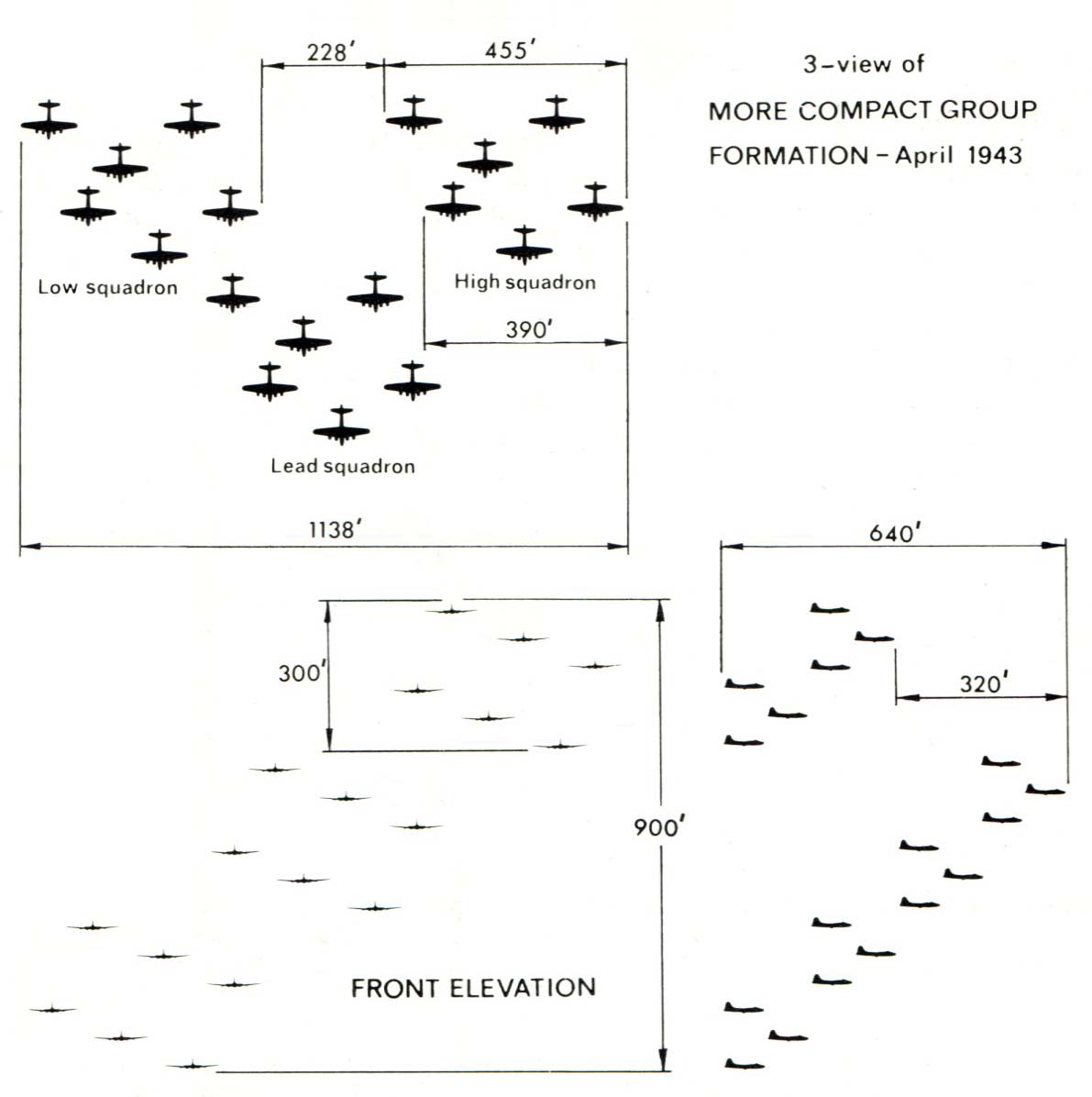
Roger A. Freeman, The Mighty Eighth War Manual, artwork by Norman Ottaway (New York, NY: Jane's Publishing, Inc., 1984).
A modification of CO 305BG COL Curtis E. LeMay's box formation, this variant was introduced in April 1943 as a means of tightening the design. Unlike the previous formation, this design stacked the aircraft of each element in the opposite direction of the overall group. This box formation was the most successful yet tried, remaining in place up through October and seeing optional usage all the way until July 1944. Regardless, the formation was not without issues, chief among them being the relatively unprotected aircraft at the extreme ends of the formation - 'Purple Heart corner.' Attempts to resolve this issue were made, with varying degrees of success, by reversing the 'javelin' angle of the rear-most elements. As the numbers of aircraft grew in the latter part of the year, this problem was further aided by occasionally adding a forth aircraft to each element and even adding entirely new elements to each squadron.
LeMay's formation proved a difficult challenge for German interceptors and the overwhelming majority of aircraft lost throughout 1943 were those who, for one reason or another, fell out of formation. As such, turning the formation was particularly dangerous, as the task of holding position while partially losing sight of one another often unintentionally spread the formations apart. Still, it was effective enough to encourage German development of air-to-air missiles, firing them into formations for the sole purpose of spreading the aircraft apart.
8 April 1943
The US 8AF launches 23 Republic P-47s on a patrol (code-named RODEO) of the area around Dunkirk, France. This is the first VIII FC operation using P-47s. Distrusted by Allied pilots because of its large size and ungainly appearance, US Supermarine Spitfire units are nevertheless converted to P-47s. The last VIII FC Spitfire operation is flown on 1 April, patrolling local shipping lanes. No enemy aircraft are encountered on either of these patrols – an occurrence common to all RODEO operations.
The P-47’s large size is due to its turbocharger, with a large air-duct running from the engine to the turbine beneath the fuselage rear. This, combined with its superb armament, makes the P-47 an excellent high-altitude dogfighter. Unfortunately, the new fighter still has teething problems. The fighter is markedly different from any of its predecessors, and while pilots slowly adjust to it, ground crews struggle to adapt auxiliary fuel tanks and VHF radio systems into the design. These issues are slowly corrected throughout summer 1943 but painfully slow progress is made increasing P-47's range. Because its combat radius is only slightly better than that of the Spitfire, senior American airmen in Europe almost immediately begin requesting droptanks for the P-47 based on the old 52-gallon design used by the Curtiss P-40.
17 April 1943
The US 8AF launches 115 Boeing B-17s against the Focke-Wulf Flugzeugbau (Focke-Wulfe Aircraft Construction) plants of Bremen, Germany. The force is escorted by fighters of RAF FC. This day sees the first organized interception of US bombers, resulting in the highest losses yet suffered on an 8AF strike. This proves an embarrassment as a party is planned for some 150 visiting politicians and dignitaries this same night. Missing guests and drunken outbursts from survivors result in a vocal crisis of confidence in the 8AF's ability to wage war. It does not help that CG 8AF MG Ira C. Eaker is not in attendance, being back in the US to present his plan to implement the Casablanca Directive.
| Bombers Launched: | 115 |
| Bombers Effective: | 107 |
| Bombers MIA: | 16 |
| Bombers Abort: | 8 |
| Abort Rate: | 7% |
| Loss Rate: | 14% |
| E/A Destroyed: | 5 |
One of the bombers lost is Invasion 2nd (42-5070, 91BG), whose crew was supposed to attend the aforementioned party, held at her airbase. Until now, Invasion 2nd was the focus of a film project headed by Hollywood director William Wyler. Encouraged by CG USAAF GEN Henry H. Arnold to arouse support for the strategic bombing offensive, Wyler supervised the filming of a variety of 8AF aircraft since January. Wyler hoped to center his documentary around whichever bomber was first to complete its tour-of-duty and had his camera-crews follow those bombers which, up to this point, had completed the most combat missions. This was dangerous work, as cinematographer Harold J. Tannenbaum was killed when his B-24 (93BG) exploded over Brest on 16 April. With the loss of Invasion 2nd, Wyler is forced to select another bomber on which to focus his film. Wyler settles on Memphis Belle (41-24485, 91BG), bluntly informing the crew that, should they be lost, he had another front runner, Hell’s Angels (41-24577, 303BG), as a backup.
Invasion 2nd was on her 23rd combat mission.
| Aircraft Type | Serial No. | Name | Code | Unit | MACR |
| Boeing B-17F-30-BO | 42-5070 | Invasion 2nd | LL-A | 401BS/91BG | 15519 |
| Boeing B-17F-10-BO | 41-24459 | Hellzapoppin' | LL-B | 401BS/91BG | 15523 |
| Boeing B-17F-50-BO | 42-5391 | Rain of Terror | LL-D | 401BS/91BG | 15522 |
| Boeing B-17F-60-BO | 42-29574 | Sky Wolf II | LL-G | 401BS/91BG | 6574 |
| Boeing B-17F-45-BO | 42-5337 | Short Snorter III | LL-J | 401BS/91BG | 15807 |
| Boeing B-17F-40-BO | 42-5172 | Thunderbird | LL-Z | 401BS/91BG | 15521 |
| Boeing B-17F-50-BO | 42-5394 | GY-O | 367BS/306BG | 15516 |
| Boeing B-17F-65-BO | 42-29658 | GY-unk | 367BS/306BG | 15446 |
| Boeing B-17F-65-BO | 42-29643 | GY-unk | 367BS/306BG | 15520 |
| Boeing B-17F-15-DL | 42-3034 | BO-unk | 368BS/306BG | 11518 |
| Boeing B-17F-40-BO | 42-5171 | BO-unk | 368BS/306BG | 15524 |
| Boeing B-17F-45-BO | 42-5251 | Bodacious Critter | BO-unk | 368BS/306BG | 15456 |
| Boeing B-17F-10-BO | 41-24467 | Grim Reaper | BO-unk | 368BS/306BG | 15525 |
| Boeing B-17F-60-BO | 42-29625 | WW-B | 369BS/306BG | 15517 |
| Boeing B-17F-10-BO | 41-24488 | Banshee II | WW-F | 369BS/306BG | 15445 |
| Boeing B-17F-60-BO | 42-29631 | Unmentionable | RD-unk | 423BS/306BG | 15444 |
10 May 1943
CG USAAF GEN Henry H. Arnold suffers his second heart attack of the war. Always driving himself into exhaustion, Arnold’s heart attack may in part be due to the untimely death of CG ETO LTG F. Max Andrews and his constant agonizing over the 8AF's progress. In Arnold’s eyes, the 8AF is not living up to its purpose, going so far as to suggest the relief of CG VIII BC BG Newton Longfellow and VIII FC BG Frank O. Hunter despite stringent protests from CG 8AF MG Ira C. Eaker.
Arnold wrote CG ETO LTG F. Max Andrews on 26 April:
I am rapidly coming to the conclusion that our bombing outfit in the Eighth Air Force is assuming a state of routine repetition . . . Has Monk Hunter lost his spirit – his dash? I know he is not the Monk Hunter I used to know. He seems to be playing it safe on most of his missions. . . . Is not the same thing true of Bomber Command? Does it not lack an aggressive leader?
Eaker's presentation in Washington (29 April) garnered some sympathy but the conviction remained. On 2 May - the day before Andrews's death - Arnold again warned:
...watch carefully the selection of officer personnel for the various top level staffs in England. These staffs will either make or break the commanders and in view of the complex and difficult job facing everyone in England, you will need to the best brains you can get, and emotion and friendship must not in any way be allowed to enter into the picture.
Arnold had a reputation for impatience and the 8AF was certainly a habitual target of his temper. The degree to which his failing health played into this is unknown, nor is the degree to which Arnold was receiving inaccurate intelligence reports. What is clear is that Arnold was pushing for operations beyond the 8AF's ability. In fact, CO 1BW BG Haywood S. Hansell, one of the authors of AWPD-42, went so far as to recommend standing down all operations until the 8AF was supplied with adequate numbers of aircraft and the problems were resolved in extending the range on the Republic P-47. In light of Soviet Premier Joseph V. J. Stalin's fierce demands for a second front, this otherwise logical decision could not be done. Despite acknowledging the soundness of Eaker's presentation, Arnold questions his numerical requirements.
Arnold is sent to 10 days convalescence at Walter Reed Army Medical Center, leaving early to speak at his son’s graduation from West Point and to take a short vacation in OR. Arnold returns to active duty on 27 May 1943.
13 May 1943
The crew of Hell’s Angels (41-24577, 303BG) becomes the first in the US 8AF to complete their tour-of-duty of 25 combat missions. Hell’s Angels goes on to fly 23 more missions before returning to the US for a war bond tour at the end of the year. It should be noted that the 25 mission tour does not necessarily entail the aircraft themselves, with the first B-17 to complete 25 missions, Delta Rebel 2 (42-5077, 91BG), having completed her 25th mission on 1 May. Hell’s Angels 25th mission sees 169 B-17s strike the Potez Aéronautique (Aeronautics) factory of Méaulte and the airfields of Saint-Omer, France. The strike is escorted by 124 Republic P-47s, with additional escort provided by RAF FC. This is the first time P-47s are used in the escort role - no doubt a result of CG USAAF GEN Henry H. Arnold's growing impatience.
This day also sees a major influx of replacement aircraft and crews from the US. Among the new arrivals is the newly-formed 4BW (BG Fred L. Anderson, Jr.), who fly their first mission this day. The new airmen perform poorly, abandoning the mission in droves when their lead bomber aborts under technical issues. Worse, a rather stupid mistake by a gunner on 42-29752 (96BG) results in his weapon firing out-of-control while still in the stowed-position - the controls on the right side shot out, this aircraft spins out of control into the North Sea. It will take time for these replacements to learn their trade.
| Bombers Launched: | 169 |
| Bombers Effective: | 119 |
| Bombers MIA: | 4 |
| Bombers DBR: | 1 |
| Bombers Abort: | 50 |
| Fighters MIA: | 5 |
| Abort Rate: | 30% |
| Loss Rate: | 3% |
| E/A Destroyed: | 10 |
| Aircraft Type | Serial No. | Name | Code | Unit | MACR |
| Boeing B-17F-65-BO | 42-29642 | Vulgar Virgin | OR-L | 323BS/91BG | 8015 |
| Boeing B-17F-50-BO | 42-5406 | OR-unk | 323BS/91BG | 15542 |
| Boeing B-17F-70-BO | 42-29752 | BX-unk | 338BS/96BG |
| Boeing B-17F-65-BO | 42-29647 | XK-unk | 365BS/305BG | 16542 |
| Aircraft Type | Serial No. | Pilot | Code | Unit | MACR |
| Supermarine Spitfire Mk. IX | BS410 | Fg Off Piotr Kuryllowicz | A | 315 Squadron |
| Supermarine Spitfire Mk. IX | LZ946 | Fenrik Bjorn Raeder | unk | 332 Squadron |
| Supermarine Spitfire Mk. IX | BS104 | FltSgt William G. Uttley | R | 403 Squadron |
| Supermarine Spitfire Mk. IX | BS430 | Sqn Ldr Foss H. Boulton | N | 416 Squadron |
| Supermarine Spitfire Mk. IX | BR626 | Sgt Charles W. McKim | T | 416 Squadron |
It should be noted that training is the bane of the USAAF throughout the war. To keep up the flow of replacement aircrews, frightfully large numbers of airmen enter combat without instrument-ratings and experience in formation flight and multi-engine aircraft. Likewise, aerial gunners are often trained with little more than shotguns and clay pigeons to teach the concept of deflection. Even the incident noted above is a common result of aerial gunners not being taught that aircraft weaponry cannot be lubricated (lest it freeze at altitude). Virtually all US air forces set up theater orientation programs to account for these issues. Even by the war's end, few commanders are satisfied with the quality of their replacement crews, though it must be noted that US air training is still far more intense than the war's other combatants.
This day also sees Armeegruppe Afrika, under the joint-command GenObt Hans-Jürgen von Arnim and Maresciallo d’Italia Giovanni Messe, surrender to Lt-Gen Kenneth A. N. Anderson (British First Army), representing the Allied Forces in Tunisia under GEN Dwight D. Eisenhower. This brings an end to the North African campaign after two years, 11 months, and three days. The overall Axis commander in North Africa, GenFM J. Erwin E. Rommel, escapes capture, having been absent from North Africa for some two months.
16 May 1943
RAF BC launches this night 19 Avro Lancasters against the hydroelectric dams of the German Ruhr Valley. Code-named Operation CHASTISE, the plan is the brainchild of aircraft designer Barnes N. Wallis (of Vickers Wellington fame), who developed a rather ingenious method of bypassing the torpedo-nets that protect the dams. Rather than torpedoing the dams, a 6,600 lb drum-shaped bomb (UPKEEP) is skipped across the water (and torpedo-nets below), sinking at the foot of the dam and detonating where the dam is most vulnerable: below the waterline. In order for the bomb to properly skip, an electric motor spins the bomb backwards at a speed of 500 rpm prior to release. Wallis spent over a year developing the 'dambuster' concept, dedicating enough time to practice flights and bomb design that he was rebuked by Vickers Aircraft (his employer) and RAF BC. Despite these setbacks, Wallis was granted approval by CAS Air Chf Mshl Sir Charles F. A. Portal on 26 February 1943 to create a special unit, 617 Squadron under Wg Cdr Guy P. Gibson, to train with 'dambuster' bombs. The bombers are to follow the rivers on approach, using a clever marker-light combination to determine altitude. The strike is comprised of three forces:
-Formation I: Nine aircraft led by Wg Cdr Guy P. Gibson aboard “G for George” (ED932), targeting the Möhne Reservoir near Dortmund and the Eders Dam near Hesse.
-Formation II: Five aircraft led by Flt Lt Joseph C. McCarthy aboard “T for Tommy” (ED825), targeting the Sorpe Dam near Sundern.
-Formation III: Five aircraft led by Plt Off Warner H. T. Ottley aboard “C for Charlie” (ED910), acting as a reserve force, with secondary targets listed as the Lister Reservoir near Attendorn, the Ennepe Dam near Radevormwald, and the Diemel Dam near Korbach, Germany.
A total of five attacks are made against the Möhne and three against the Eder before they are successfully breached; the other dams targeted receive little damage. Some 1,294 people drown in the attack, with 749 of them being foreign laborers and POWs. Follow-up conventional strikes are ignored and, with repairs going uninterrupted, the dams are fully-restored by 27 July 1943. Still, the raid is heralded as a great success by the British media. Gibson is awarded the Victoria Cross and Wallis’s ideas are given greater respect by the Air Ministry, resulting in the development of more large-capacity bombs - something Wallis had long championed. 617 Squadron is retained as a specialist unit and as a result, are the first to test said bombs when they are developed.
| Bombers Launched: | 19 |
| Bombers Effective: | 11 |
| Bombers MIA: | 8 |
| Bombers Abort: | 8 |
| Abort Rate: | 42% |
| Loss Rate: | 42% |
The events of Operation CHASTISE are later dramatized in the 1955 film The Dambusters starring Sir Michael S. Redgrave as Barnes N. Wallis and Richard A. P. Todd as Guy P. Gibson. The film is rather well-made in regard to accuracy and is regarded as something of a British classic.
| Aircraft Type | Serial No. | Code | Unit | ||
| Formation I: | Avro Lancaster Mk. III | ED932 | G | 617 Squadron | |
| Avro Lancaster Mk. III | ED887 | A | 617 Squadron | ||
| Avro Lancaster Mk. III | ED864 | B | 617 Squadron | ||
| Avro Lancaster Mk. III | ED906 | J | 617 Squadron | ||
| Avro Lancaster Mk. III | ED929 | L | 617 Squadron | ||
| Avro Lancaster Mk. III | ED925 | M | 617 Squadron | ||
| Avro Lancaster Mk. III | ED912 | N | 617 Squadron | ||
| Avro Lancaster Mk. III | ED909 | P | 617 Squadron | ||
| Avro Lancaster Mk. III | ED937 | Z | 617 Squadron | ||
| Formation II: | Avro Lancaster Mk. III | ED825 | T | 617 Squadron | |
| Avro Lancaster Mk. III | ED927 | E | 617 Squadron | ||
| Avro Lancaster Mk. III | ED936 | H | 617 Squadron | ||
| Avro Lancaster Mk. III | ED934 | K | 617 Squadron | ||
| Avro Lancaster Mk. III | ED921 | W | 617 Squadron | ||
| Formation III: | Avro Lancaster Mk. III | ED910 | C | 617 Squadron | |
| Avro Lancaster Mk. III | ED918 | F | 617 Squadron | ||
| Avro Lancaster Mk. III | ED886 | O | 617 Squadron | ||
| Avro Lancaster Mk. III | ED865 | S | 617 Squadron | ||
| Avro Lancaster Mk. III | ED924 | Y | 617 Squadron |
No losses are due to fighter interception.
19 May 1943
Memphis Belle (41-24485, 91BG) becomes the first aircraft in the US 8AF to complete her tour-of-duty of 25 missions and return home. The distinction between the Belle's accomplishment and that of Hell’s Angels (41-24577, 303BG) is minimal, the former taking media precedence simply because of its documentary film and subsequent war bond tour. Hollywood director William Wyler supervised filming of the bomber since mid-April and the finished film, Memphis Belle: A Story of a Flying Fortress, is released on 13 April 1944. Memphis Belle’s final combat mission sees 187 B-17s strike the shipyards of Flensburg and the submarine pens of Kiel, Germany, while another 24 B-17s and 117 Republic P-47s fly a diversionary route.
| Bombers Launched: | 211 |
| Bombers Effective: | 182 |
| Fighters Launched: | 117 |
| Bombers MIA: | 6 |
| Bombers Abort: | 29 |
| Abort Rate: | 14% |
| Loss Rate: | 3% |
| E/A Destroyed: | 2 |
The 25-mission tour-of-duty is often the subject of much historical misunderstanding. This system was by no means applicable to all US air forces. Likewise, combat tours based on sorties have been criticized due to the comparatively low number of aerial victories achieved by Allied airmen in comparison to that of the Axis. Acknowledging that this discrepancy is at least in part due to different definitions of 'aerial victory,' it is worth noting that the US did not actually discharge airmen when they completed their tours. Rather, they were usually given the option of staying with their unit or returning to the US to serve as instructors. The wisdom of this decision becomes blatantly evident later in the war when experienced German and Japanese airmen are increasingly killed and replaced with trainees who lack the skill of their US counterparts.
A film adaptation of the Memphis Belle is released in 1990 starring Eric Stoltz, Matthew Modine, and D. B. Sweeney. Loosely based on the Belle, the script originally followed a fictitious crew on their final mission. The addition of William Wyler’s daughter, Catherine, as producer, saw the story altered slightly to reflect the actual Belle. Keeping this in mind, the low regard of the film held by historians is unduly harsh. Virtually everything shown in the film is based on historical precedent (though not necessarily of the Belle herself) and, considering that the film is one of the last to portray air combat using real aircraft rather computer-generated imagery, it is likely as good a portrayal of WWII air combat as will ever be filmed.
The Boeing B-17F Memphis Belle is currently on display at the National Museum of the US Air Force in Dayton, OH. The author of this website is proud to have played a small part in this restoration.
| Aircraft Type | Serial No. | Name | Code | Unit | MACR |
| Boeing B-17F-10-BO | 41-24483 | Spirit of Alcohol | LG-U | 322BS/91BG | 15632 |
| Boeing B-17F-27-BO | 41-24590 | WF-B | 364BS/305BG |
| Boeing B-17F-25-BO | 41-24573 | WF-N | 364BS/305BG | 15329 |
| Boeing B-17F-40-BO | 42-5155 | XK-T | 365BS/305BG | 15488 |
| Boeing B-17F-27-BO | 41-24624 | Madame Butterfly | JJ-J | 422BS/305BG | 15549 |
| Boeing B-17F-65-BO | 42-29701 | In The Mood | TU-B | 510BS/351BG | 15719 |
25 May 1943
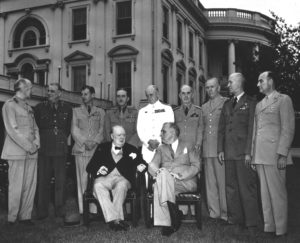
The CCS at TRIDENT.
Back row, left to right:
Lt-Gen Hastings L. Ismay (Churchill’s CS)
Air Chf Mshl Sir Charles F. A. Portal (CAS)
Gen Sir Alan F. Brooke (CGS)
Adm Sir A. Dudley P. R. Pound (1SL/CNS)
ADM William D. Leahy (Roosevelt’s CS)
GEN George C. Marshall, Jr. (CSA)
ADM Ernest J. King (CNO)
LTG Joseph T. McNarney (VCSA)
The Third Washington Conference (TRIDENT) concludes after 13 days of meetings between US Pres. Franklin D. Roosevelt (D-NY), British PM the Rt. Hon. Winston L. Spencer-Churchill (CP), and the Combined Chiefs of Staff (CCS). With the fall of North Africa earlier this month, frictions come to a head between US and British leaders over the best strategy for invading the European continent. Churchill still favored an invasion through Italy, operations against which were already underway, whilst the US service chiefs favored a cross-channel invasion of France. Growing impatient, the US chiefs overrule the British, setting the date for France’s invasion to 1 May 1944, furthermore setting a cap on supply diversions from the 8AF to the Mediterranean.
This latter act is helped by the approval of the "Eaker Plan," otherwise known as the "Combined Bomber Offensive." Spelling out the US 8AF's needs, the Eaker plan details exactly what is to be achieved by the 8AF and RAF BC, and the materiel needs required to reach said goals. In doing so, they discourage using 8AF as a pool from other theaters can pull resources. Regardless, TRIDENT calls for yet another redeployment of 8AF units, transferring its Consolidated B-24 units to the US 9AF (CG MG Lewis H. Brereton). This decision is due to another plan approved at TRIDENT: Operation SOAPSUDS. Presented by COL Jacob E. Smart, SOAPSUDS plans to knock out the oil refineries of Ploiești, România via a low-level strike out of Benghazi, Libya. While the bombers are intended to be on loan for no more than 15 days, they actually stay in North Africa some four months.
Click here to read the Eaker Plan (Combined Bomber Offensive).
It is worth noting the difficulties suffered by CG 8AF MG Ira C. Eaker in regard to expectation versus reality. CG USAAF GEN Henry H. Arnold had long pressed Eaker for deep penetration strikes to affect some kind of strategic paralysis on Germany prior to the invasion of Northern Europe. This means that Eaker now has just one year to achieve air superiority and then cripple the German economy. There are several issues which will make this difficult. Allocations for Lockheed P-38 fighter units are not scheduled to arrive until January, forcing Eaker to depend on his small number of Republic P-47 units - whose range they are still struggling to expand. Likewise, the Eaker Plan called for RAF BC to supplement US strikes by area bombing cities which contain targets critical to the US effort. Despite his vocal support, CINC RAF BC Air Mshl Sir Arthur T. Harris fails to actually follow suit.
Arnold, still recovering from his heart attack, does not attend TRIDENT; VCSA LTG Joseph T. McNarney takes his place instead.
29 May 1943
The Boeing YB-40 gunship flies its first combat operation. The gunship program was essentially stopgap, as AWPD-42 suggested using converted bombers as long range escorts until effective fighter escorts could be developed. Using the Boeing B-17F and Consolidated B-24D as a basis, the YB-40 and XB-41 gunships (respectively) strengthen the original designs’ already considerable firepower by adding electric turrets amidships and under the nose, hydraulically-boosted guns in staggered waist positions, and additional armor and ammunition. The YB-40 proves the more stable of the two designs and sees limited combat service, being phased out once pressurized external fuel tanks for fighters enter service. Some 25 YB-40s are built, 13 of which are assigned to the 92BG, taking part in 14 strikes before their retirement. Only a single YB-40, Wango Wango (42-5735), is ever lost to enemy action, being shot down over Hüls, Germany on 22 June 1943.
The YB-40’s staggered waist guns and chin turret, both highly regarded in service, are later standardized on the Boeing B-17G, the latter turret proving to be an unprecedented success. An adaptation of the failed Bendix belly turret on the North American B-25C, the B-17G’s chin turret is controlled by the bombardier sitting above in the nose. Rather than a clumsy field-modification involving braced guns in the Plexiglas nose, the chin turret is unobtrusive, fast, and effective. As such, the YB-40 definitively solves the problem of forward-facing armament on the B-17. The B-17G – easily distinguished by its chin turret – is first flown on 16 August 1943 and remains the mainstay of the 8AF for the remainder of the war. Fittingly, 16 August 1943 is also the date of the YB-40’s final combat mission.
This day sees the 8AF launch 241 Boeing B-17s and 38 Consolidated B-24s against the submarine pens of St. Nazaire and La Rochelle, as well as the naval supply depot of Rennes, France. The strike is escorted by 131 Republic P-47s and eight YB-40s, with additional escort provided by RAF FC.
| Bombers Launched: | 271 |
| Bombers Effective: | 238 |
| Bombers MIA: | 14 |
| Bombers DBR: | 2 |
| Bombers Abort: | 33 |
| Abort Rate: | 12% |
| Loss Rate: | 6% |
| E/A Destroyed: | 7 |
| Aircraft Type | Serial No. | Name | Code | Unit | MACR |
| Boeing B-17F-55-BO | 42-29476 | SNAFU | GL-M | 410BS/94BG |
| Boeing B-17F-65-BO | 42-29692 | Man O' War | GL-R | 410BS/94BG |
| Boeing B-17F-65-BO | 42-29710 | Hell Below | GL-W | 410BS/94BG | 15139 |
| Boeing B-17F-65-BO | 42-29689 | Skack Buster | BG-H | 334BS/95BG | 4895 |
| Boeing B-17F-30-VE | 42-5858 | ET-L | 336BS/95BG | 4894 |
| Boeing B-17F-20-DL | 42-3042 | Cabin Heater | AW-unk | 337BS/96BG | 3984 |
| Boeing B-17F-27-BO | 41-24602 | Yardbird | PU-A | 360BS/303BG |
| Boeing B-17F-70-BO | 42-29792 | KY-G | 336BS/305BG |
| Boeing B-17F-70-BO | 42-29742 | Barrel House Bessie | KY-M | 336BS/305BG |
| Boeing B-17F-55-BO | 42-29531 | JJ-Z | 422BS/305BG |
| Boeing B-17F-75-BO | 42-29838 | Concho Clipper | RQ-U | 509BS/351BG |
| Boeing B-17F-25-DL | 42-3113 | FR-F | 525BS/379BG | 1292 |
| Boeing B-17F-70-BO | 42-29773 | Up & At 'Em | LF-F | 526BS/379BG | 1370 |
| Boeing B-17F-75-BO | 42-29878 | Lady Godiva | LF-G | 526BS/379BG | 1293 |
| Aircraft Type | Serial No. | Name | Code | Unit | |
| Boeing XB-40 (B-17F-1-BO) | 41-24341 | ||||
| Boeing YB-40 (B-17F-10-VE) | 42-5732 | Mugger | UX-unk | 327BS/92BG | |
| Boeing YB-40 (B-17F-10-VE) | 42-5733 | Peoria Prowler | UX-F | 327BS/92BG | |
| Boeing YB-40 (B-17F-10-VE) | 42-5734 | Seymour Angel | UX-D | 327BS/92BG | |
| Boeing YB-40 (B-17F-10-VE) | 42-5735 | Wango Wango | UX-B | 327BS/92BG | |
| Boeing YB-40 (B-17F-10-VE) | 42-5736 | Tampa Tornado | UX-C | 327BS/92BG | |
| Boeing YB-40 (B-17F-10-VE) | 42-5737 | Dakota Demon | UX-K | 327BS/92BG | |
| Boeing YB-40 (B-17F-10-VE) | 42-5738 | Boston Tea Party | UX-G | 327BS/92BG | |
| Boeing YB-40 (B-17F-10-VE) | 42-5739 | Lufkin Ruffian | UX-J | 327BS/92BG | |
| Boeing YB-40 (B-17F-10-VE) | 42-5740 | Monticello | UX-E | 327BS/92BG | |
| Boeing YB-40 (B-17F-10-VE) | 42-5741 | Chicago | UX-H | 327BS/92BG | |
| Boeing YB-40 (B-17F-10-VE) | 42-5742 | Plain Dealing Express | UX-L | 327BS/92BG | |
| Boeing YB-40 (B-17F-10-VE) | 42-5743 | Woolaroc | UX-M | 327BS/92BG | |
| Boeing YB-40 (B-17F-10-VE) | 42-5744 | Dollie Madison | UX-A | 327BS/92BG | |
| Boeing YB-40 (B-17F-25-VE) | 42-5833 | ||||
| Boeing YB-40 (B-17F-25-VE) | 42-5834 | ||||
| Boeing YB-40 (B-17F-30-VE) | 42-5871 | ||||
| Boeing YB-40 (B-17F-30-VE) | 42-5872 | ||||
| Boeing YB-40 (B-17F-35-VE) | 42-5920 | ||||
| Boeing YB-40 (B-17F-35-VE) | 42-5921 | ||||
| Boeing YB-40 (B-17F-35-VE) | 42-5923 | ||||
| Boeing YB-40 (B-17F-35-VE) | 42-5924 | ||||
| Boeing YB-40 (B-17F-35-VE) | 42-5925 | ||||
| Boeing YB-40 (B-17F-35-VE) | 42-5926 | ||||
| Boeing YB-40 (B-17F-35-VE) | 42-5927 |
31 May 1943
RAF BC launches 30 Lockheed Venturas against the power plants of Zeebrugge, Belguim, the airfield of Caen, and the dockyard of Cherbourg, France, while 12 North American B-25s bomb the shipyards of Vlissingen in the Netherlands. This is the last operation of 2 Group with RAF BC before being transferred to the 2TAF.
2 Group is RAF BC's last dedicated daylight unit of the Second World war.
| Bombers Launched: | 54 |
| Bombers MIA: | 1 |
| Loss Rate: | 2% |
| Aircraft Type | Serial No. | Code | Unit |
| North American B-25C | FL198 | P | 180 Squadron |
13 June 1943
The US 8AF launches 227 Boeing B-17s against the submarine pens of Bremen and Kiel, Germany, with the 1BW striking Bremen and the 4BW striking Kiel. The 1BW is led by Eight Ball (41-24635, 303BG) and the 4BW by "E-Easy" (42-30164, 95BG). This is the costliest operation of the 8AF thus far and the fourth costliest of the war in terms of percentage.
Flying as an observer aboard "E-Easy" is BG Nathan B. Forrest, III, grandson of the famous Confederate cavalryman. On loan from the 2AF, Forrest is intended to replace CG 4BW BG Fred L. Anderson, Jr (who is soon to be promoted). Forrest's demeanor is not enduring. He is accompanied by COLs William L. Kennedy and Delmar T. Spivey, directors of aerial gunnery training at Harlingen and Buckingham Fields, to observe combat operations - no doubt the result of the 4BW's poor initial performance the previous May. Forrest has the 95BG test a new formation, similar to that used by the 8AF previous year, as well as a new gun oil supposedly resistant to freezing (8AF practice is not to lubricate the guns). The strike on Kiel succeeds in diverting attention from the Bremen force but at a great cost: Forrest’s formation limits the fields-of-fire and worse, nearly 40% of the group’s guns jam from freezing. Nearly half of the 8AF’s losses this day come from the 95BG. The ferocity launched against the Kiel force spur rumors that a short-lived radio rivalry with Lord Haw-Haw (William B. Joyce) had singled Forrest out prior to the raid. Forrest, one of three observers aboard "E for Easy," is in the nose compartment when his aircraft is lost, and witnesses report seeing his parachute become entangled with the No. 2 prop upon bailout. Forrest is confirmed dead three months later when his body washes ashore
This is the sixth 8AF heavy bomber operation to be launched without fighter escort.
| Bombers Launched: | 227 |
| Bombers Effective: | 182 |
| Bombers MIA: | 26 |
| Bombers DBR: | 1 |
| Bombers Abort: | 45 |
| Abort Rate: | 20% |
| Loss Rate: | 12% |
| E/A Destroyed: | 7 |
| Aircraft Type | Serial No. | Name | Code | Unit | MACR |
| Boeing B-17F-70-BO | 42-29822 | Visiting Fireman | QE-unk | 331BS/94BG |
| Boeing B-17F-80-BO | 42-29957 | Helno Gal II | QE-unk | 331BS/94BG | 15556 |
| Boeing B-17F-80-BO | 42-29940 | XM-unk | 332BS/94BG | 16201 |
| Boeing B-17F-80-BO | 42-29949 | Sick Call | XM-unk | 332BS/94BG |
| Boeing B-17F-65-BO | 42-29708 | Shackeroo! | TS-unk | 333BS/94BG |
| Boeing B-17F-85-BO | 42-30113 | Wolf Pack | TS-unk | 333BS/94BG |
| Boeing B-17F-65-BO | 42-29715 | Klo Kay | GL-unk | 410BS/94BG | 15162 |
| Boeing B-17F-20-DL | 42-3063 | Ole Tobe | GL-unk | 410BS/94BG | 6142 |
| Boeing B-17F-30-DL | 42-3187 | Buckshot | GL-unk | 410BS/94BG | 15839 |
| Boeing B-17F-90-BO | 42-30164 | BG-E | 334BS/95BG | 1371/8960 |
| Boeing B-17F-85-BO | 42-30118 | OE-N | 335BS/95BG | 4738 |
| Boeing B-17F-65-BO | 42-29675 | OE-S | 335BS/95BG | 2169 |
| Boeing B-17F-35-DL | 42-3206 | OE-T | 335BS/95BG | 4404/15199 |
| Boeing B-17F-70-BO | 42-29827 | OE-V | 335BS/95BG | 4901 |
| Boeing B-17F-70-BO | 42-29763 | OE-X | 335BS/95BG | 4899 |
| Boeing B-17F-45-DL | 42-3286 | ET-E | 336BS/95BG | 2453 |
| Boeing B-17F-65-BO | 42-29702 | Rat Killer | ET-H | 336BS/95BG | 4896 |
| Boeing B-17F-65-BO | 42-29680 | Battlin' B | ET-R | 336BS/95BG | 2751 |
| Boeing B-17F-70-BO | 42-29737 | Louise | QW-N | 412BS/95BG | 4898 |
| Boeing B-17F-25-DL | 42-3107 | AW-unk | 337BS/96BG | 2458/3687 |
| Boeing B-17F-70-BO | 42-29748 | Paradise Lost | BX-unk | 338BS/96BG | 15631 |
| Boeing B-17F-70-BO | 42-29756 | Big Chief II | QJ-unk | 339BS/96BG | 16142 |
| Boeing B-17F-35-BO | 42-5125 | XK-Q | 365BS/305BG |
| Boeing B-17F-40-BO | 42-5218 | Sky Wolf | RD-J | 423BS/306BG |
| Boeing B-17F-25-VE | 42-5814 | YB-B | 508BS/351BG |
| Boeing B-17F-25-VE | 42-5815 | RQ-Q | 509BS/351BG |
14 June 1943
The CCS issues Operation POINTBLANK, amending the Casablanca Directive to now list German aircraft factories as top-priority for strategic air operations. The decisions reached at TRIDENT sealed the invasion of France for 1 May 1944, and with the failure of the Allies to secure the port of Dieppe in August 1942, the need for air superiority over the European continent is acknowledged to be of vital importance. With the obvious success of the Allied anti-submarine campaign growing apparent (little thanks to the strategic bombing campaign), the British and US air effort is now to face the difficult task of crippling Germany's aviation industry.
In fact, CINC OKM Großadmiral Karl Dönitz had actually halted Germany's U-boat anti-shipping campaign on 24 May 1943. Advances in Allied tactics, such as the “creeping attack” developed by Capt F. John Walker, and new technologies such as the air-dropped Mk 24 homing torpedo and hedgehog mortar, intensified the growing threat of US-built destroyers, escort carriers, and Consolidated B-24s. May was the costliest month for Dönitz’s U-Boat force, losing an incredible 42 submarines - over half from air attack.
Essentially, POINTBLANK puts the Eaker Plan into effect. The Eaker Plan planned for its counter-air offensive to begin in July once reaching the anticipated complement of 800 bomber aircraft. Set up in phases, the Eaker plan focuses primarily on FW-190 production, whose Bremen and Kassel plants are within the relatively shallow 400 mi range of Phases 1 and 2. Messerschmitt production areas are more difficult, its Wiener Neustädt, Austria and Regensburg, Germany complexes overseeing nearly the entire production of the Bf-109 and Bf-110 interceptors (the Luftwaffe's primary day and night fighters, respectively). As such, the Austrian plants are dependent on strikes from the Mediterranean and Regensburg will require a deep penetration beyond the range of contemporary escorts.
Complicating this are concurrent CCS plans for heavy bomber strikes against the oil refineries of Ploiești, România and the ball-bearing plants of Schweinfurt, Germany. Both obvious economic bottlenecks for Germany, these campaigns have the potential to seriously pull resources from the counter-air campaign. The latter is a particularly tempting target, as the Schweinfurt complexes are the only major ball-bearing producers in Axis-occupied Europe, the removal of which could be potentially catastrophic. Whereas the successful destruction of the Ploiești oil fields would require shifting the bombing campaign toward further petroleum-oil-lubrication (POL) targets, successfully targeting Schweinfurt offered the possibility of an immediate effect.
The POINTBLANK Directive is formally approved on 15 August 1943 at the QUADRANT conference in Quebec, Canada. By this point, POINTBLANK is already well underway and, in his review, CAS Air Chf Mshl Sir Charles F. A. Portal is rather damning of the fact that the Eaker Plan's numbers are not being met.
18 June 1943
Asst. Secretary of War for Air Robert A. Lovett (R-NY) submits a letter to CG USAAF GEN Henry H. Arnold concluding his inspection tour of the US 8AF (17 May - 30 May). Lovett's findings are valuable beyond measure, particularly in light of the increasingly fiery war-of-words between Arnold and CG 8AF MG Ira C. Eaker over the former's criticisms. In the line of people who had come to Eaker's defense - CG ETO LTG Jacob L. Devers, Lend-Lease Envoy W. Averell Harriman (D-NY), etc. - none possessed Lovett's influence and technical knowledge. The vast majority of Lovett's recommendations echo those of Eaker - better training, shifting theater alterations to the US, more aircraft, crews, and maintenance equipment, etc. - but his biggest concern is:
...the immediate need for long range fighters. This may be met by proper tanks for the [Republic] P-47s, but ultimately [Lockheed] P-38s and [North American] P-51s will be needed. . . . On the general subject of use of fighters out of Britain, it is increasingly apparent that fighter escort will have to be provided for the B-17s on as many missions as possible in order particularly to get them through the first wave of the German fighter defense, which is now put up in depth so that the B-17s are forced to run the gauntlet both in to the target and out from it. The P-47s can serve as top cover if satisfactory tanks are developed for them. The ideal plane, however, now in production is the P-38 for long range escort duty. . . . It has been used in over water escort duty on operations with a radius of slightly over 400 miles. However, the moment it drops its wing tanks it must turn back. High hopes are felt for the P-51 with wing tanks.
CG VIII FC BG Frank O. Hunter called for UK production of external fuel tanks for his fighters as early as 24 January, recognizing the tardiness at which development was progressing in the US (Arnold ordered research on this topic on 20 February 1942). In fact, the US 5AF and 8AFs both develop external fuel tanks for their fighters before the USAAF Technical Section. Hunter is particularly hesitant to replace the P-47, arguing that it is not fair to damn the design until its teething issues are resolved. He has a point: the P-38 is notoriously ill-suited for the cold of high-altitudes and is far less maneuverable in combat, and the P-51 is still new and untested.
Lovett deserves credit for singling out the P-51 amongst a slew of fighter prototypes. The British lineage of the fighter certainly made its acceptance an uphill battle. With the Army having used up its 1942 fighter budget on P-38s and P-47s, War Production Board member BG Oliver P. Echols was only able to secure production of the P-51 by ordering it as an attack aircraft: the A-36 Apache. Likewise, its adoption as a fighter was solely the result of MAJ Tommy Hitchcock, Jr., American Air Attaché to England, championing the success of British test flights which showed increased performance when coupled with the Rolls-Royce Merlin engine. Contracting the engine through the Packard Motor Co., North American began limited production of the first Merlin-powered P-51s at the end of the year, with the first flight occurring on 5 May 1943.
Arnold orders staff member LTG Barney M. Giles to tackle the escort range issue on 22 June:
About six months remain before deep daylight penetration of Germany begins. With this next six months, you have got to get a fighter that can protect our bombers. Whether you use an existing type or have to start from scratch is your problem. Get to work on this right away because by January 44, I want fighter escort for all of our bombers from UK into Germany.
Giles immediately takes up the mantle for the P-51, visiting designer J. H. "Dutch" Kindelberger in person to help find ways of extending the P-51's combat radius. Despite this crash-program, the first P-51 units will not reach Europe until December. Arnold's reference to 'six months' shows that he wants long range escorts available before the Eaker Plan's Phase Three. Unfortunately, this ignores the needs of Phases One and Two, as the plan goes into effect on 1 July and the Republic P-47 is still not up to the job.
28 June 1943
The US War Department issues a directive that the standard blue-circle-and-white-star roundel be upgraded to include a pair of white bars on either side, with a thick red line wrapping around the roundel's outer edge. The red border on the roundel is not popular and is officially replaced with a blue border on 18 September 1943.
A sign of the 8AF's slowly growing numbers, the 1BW, 2BW, and 4BW are reorganized on 13 September into the 1st, 2nd, and 3rd Air Divisions to encompass new bombardment wings. This order also calls for individual division and group insignia, which the 8AF implements by having white geometric shapes painted on the tail and right wing, inside of which are blue letters that signify the groups. While the shapes-and-letters marking system remains in place for divisions and groups, bombardment wings are not assigned individual markings until 1 August 1944. Regardless, this marking system remains in place for the duration of the Second World War, with other US air forces implementing variations of this theme.
1 July 1943
CG US VIII BC BG Newton Longfellow is relieved of command following a recommendation given by CG USAAF GEN Henry H. Arnold. While Arnold was clearly micromanaging CG 8AF MG Ira C. Eaker, Longfellow's relief is symptomatic of a larger crisis of command. No doubt worsened by Arnold's prodding, the senior officers of the 8AF were reaching undue levels of fatigue and stress - Longfellow, for example, was secretly nicknamed "Screaming Eagle" for his frequent yelling episodes. CO 1BW BG Haywood S. Hansell was relieved on charges of fatigue on 15 June and his replacement, BG Frank A. Armstrong, only managed to stay a month before his relief on 31 July. Eaker long opposed Longfellow's relief on the basis that there were no officers with enough experience to replace him, noting that Hansell - the logical choice - was too "nervous and high-strung." Regardless, Longfellow is now replaced by relatively new CG 4BW BG Fred L. Anderson, Jr. CO 305BG COL Curtis E. LeMay takes over as CG 4BW.
While his subordinates regarded him as a martinet, Eaker recommends Longfellow to CG 2AF MG Davenport Johnson, writing:
He is a tireless worker and despite the fact that we almost killed him off here working, or carrying the responsibility, for 24 hours a day, seven days a week, I believe he will spring back after a few weeks' rest and do a tremendous job.
Also on this day, the USAAF standardizes the A-14 oxygen mask. A product of Ohio Chemical and Manufacturing, the A-14 is a demand-flow oxygen mask. Oxygen development in the US had been troublesome. The constant-flow A-8 mask, while comfortable, wasted oxygen and tended to freeze condensation in its narrow fittings (fatal if left unchecked). A wrap-around demand-flow mask was the obvious solution but successive demand-flow mask designs consistently suffered from poor comfort and oxygen leakage. The success of the new A-14 is such that it remains standard issue until 1954.
3 July 1943
RAF BC launches this night 89 Vickers Wellingtons, 76 Short Stirlings, 182 Handley Page Halifaxes, 13 de Havilland Mosquitoes, and 293 Avro Lancasters against Cologne, Germany. Pathfinders direct the force to the eastern side of the city wherein much of the industry is located. This night sees the first employment of Luftwaffe Wilde Sau (Wild Boar) units against RAF bombers. Conceived by OLt Hans-Joachim Herrmann, a bomber pilot noted for his successes over Greece and Malta in 1941, Wild Boars are in fact little more than single-engine fighter interceptors operating at night. (588 killed)
| Bombers Launched: | 653 |
| Bombers Effective: | 568 |
| Bombers MIA: | 30 |
| Bombers Abort: | 85 |
| Abort Rate: | 15% |
| Loss Rate: | 5% |
Wild Boar tactics are not easy. Night fighters are traditionally larger, twin-engine aircraft in order to accommodate blind-navigation equipment - not only do single-engine fighters lack such equipment, but their pilots are also generally not instrument-rated. As such, Herrmann hopes that by concentrating single-engine fighters over a predicted target area, the pilots can visually locate enemy bombers via searchlights and flak illumination (or if necessary, the fires caused by the bombs). Since this requires a great deal of expertise in night flying, Wild Boar pilots are disproportionately former bomber pilots and instructors. 12 of this night’s losses are claimed by Herrmann’s Wild Boar unit, JG300, and two more units (JG301 and JG302) enter service after the disastrous Hamburg firestorm later this month. More of a stopgap than an actual solution, Wild Boars achieve much success throughout 1943.
| Aircraft Type | Serial No. | Code | Unit |
| Vickers Wellington Mk. X | HF595 | Y | 166 Squadron |
| Vickers Wellington Mk. X | HE980 | unk | 196 Squadron |
| Vickers Wellington Mk. X | HZ478 | unk | 196 Squadron |
| Vickers Wellington Mk. X | LN296 | unk | 429 Squadron |
| Vickers Wellington Mk. X | LN284 | Q | 431 Squadron |
| Vickers Wellington Mk. X | LN285 | K | 432 Squadron |
| Vickers Wellington Mk. X | HZ481 | W | 432 Squadron |
| Vickers Wellington Mk. X | HF569 | S | 466 Squadron |
| Short Stirling Mk. III | BK648 | J | 15 Squadron |
| Short Stirling Mk. III | BK718 | M | 90 Squadron |
| Short Stirling Mk. III | EH907 | O | 90 Squadron |
| Short Stirling Mk. III | BF530 | B | 149 Squadron |
| Short Stirling Mk. III | BK717 | U | 214 Squadron |
| Handley Page Halifax Mk. II | DT784 | M | 10 Squadron |
| Handley Page Halifax Mk. II | HR673 | B | 35 Squadron |
| Handley Page Halifax Mk. II | JD262 | E | 51 Squadron |
| Handley Page Halifax Mk. II | BB428 | Q | 102 Squadron |
| Handley Page Halifax Mk. II | HR734 | P | 158 Squadron |
| Handley Page Halifax Mk. II | HR813 | H | 405 Squadron |
| Handley Page Halifax Mk. II | JB796 | C | 408 Squadron |
| Handley Page Halifax Mk. II | JB913 | F | 408 Squadron |
| Handley Page Halifax Mk. II | JD159 | Y | 419 Squadron |
| Avro Lancaster Mk. III | ED689 | K | 9 Squadron |
| Avro Lancaster Mk. III | ED820 | A | 12 Squadron |
| Avro Lancaster Mk. I | W4958 | B | 12 Squadron |
| Avro Lancaster Mk. III | ED917 | O | 97 Squadron |
| Avro Lancaster Mk. III | JA672 | E | 103 Squadron |
| Avro Lancaster Mk. III | W5012 | O | 103 Squadron |
| Avro Lancaster Mk. II | DS662 | L | 115 Squadron |
| Avro Lancaster Mk. I | W4844 | Z | 460 Squadron |
13 July 1943
The US Seventh (LTG George S. Patton, Jr.) and British Eighth Armies (Gen Bernard L. Montgomery), under the 15th Army Group (Gen the Hon. Sir Harold R. L. G. Alexander), initiate Operation HUSKY and begin the invasion of Sicily. The island is to be used as a staging area for the invasion of Italy, set to begin that autumn. The operation begins in a fiasco when US 82nd Airborne and British 1st Airborne Division transport aircraft are mistakenly fired on by Allied vessels.
Despite the successful completion of the operation, international tensions between the US and Great Britain run high as the armies race for the city of Messina while German and Italian forces evacuate the island. In November, journalist Drew R. Pearson exposes an incident that occurred during this campaign where Patton had slapped an enlisted man for cowardice, resulting in a rushed public reprimanding for an incident previously thought forgotten. Secretary of War Henry L. Stimson (R-NY) demands an investigation into obvious War Department leaks and Patton is shockingly relieved of command, not seeing another combat command until August 1944. The island of Sicily is deemed secure on 17 August 1943.
17 July 1943
The Walt Disney Company releases the film Victory through Air Power. Impressed by the book written by MAJ Alexander N. P. de Seversky the previous year and convinced of its importance, Walt E. Disney rushed the development of this film. Divided into halves, the first part of the film is a brief history of aviation while the second half, hosted by Seversky himself, is a complex argument on the importance of strategic bombardment. In the end, Disney (and by extension, Seversky) achieves his goal, as the film is shown at the Quebec Conference (QUADRANT) that August on personal request of British PM the Rt. Hon. Winston L. Spencer-Churchill (CP). US Pres. Franklin D. Roosevelt (D-NY), likewise impressed with the film, later orders a screening for the JCS.
Political correctness makes the film an embarrassment to the Disney Corporation in the years following Walt E. Disney’s death (1966), resulting in copies of this animation landmark being difficult to find.
19 July 1943
As per Operation CROSSPOINT, the US 12AF launches 149 Boeing B-17s and 143 Consolidated B-24s from bases in Oran, Algeria, led by CG 12AF MG Jimmy H. Doolittle, against the San Lorenzo and Scalo del Littorio marshaling yards of Rome, Italy. This is the first US airstrike against Rome. With RAF BC dropping warning leaflets the night before, and medium bombers attacking the Ciampino airport in support, this is also the largest US bomber operation to date. No heavy bombers are lost.
The bombing of Rome was a controversial subject, with US Pres. Franklin D. Roosevelt (D-NY) particularly resisting its attack under concern of alienating Roman Catholics. However, with the rapid success of Operation HUSKY and the Allied invasion of Italy imminent, Rome's importance could no longer be ignored. While RAF BC had made a limited effort against northern Italian cities since 11 June 1940, the effect was greater than expected. Supply lines and industries were relocated south in the wake of these raids, as the Italian government was fully aware of Rome's 'protected' status. An Allied conference in Algiers (29 May - 3 June) concluded that Rome might be safely bombed if done in daylight, as the Tiber river served as a demarcation line between the railyards and the Vatican, and well-known Italian war-weariness suggested that the psychological effect of such a strike might outweigh its logistical effect. They were correct.
Allied and Axis newspapers both denounced the bombing, with many falsely claiming that the Basilica of San Lorenzo was destroyed. In truth, the bombing was quite accurate, though Italian casualties were high. Public appearances by Pope Pius XII (Eugenio M. G. G. Pacelli), and Re Vittorio Emanuele F. M. G. Savoy met with varying degrees of reception, the latter using the bombing as an excuse to request Presidente Benito A. A. Mussolini's resignation the very next day. Following Mussolini's refusal, the Gran Consiglio del Fascismo declares a vote of 'no confidence' in Mussolini on 25 July, arresting him and replacing him with Maresciallo d'Italia Pietro Badoglio. (717 killed)
22 July 1943
CG USAAF GEN Henry H. Arnold cancels all contracts for leather flight gear, including the massive sheepskin B-3 jacket and the much beloved A-2 jacket. The old B-3 jacket and A-3 trousers - which are issued as sets - are to be replaced by the alpaca-lined canvas B-10 jacket (paired with A-9 trousers), with an improved variant, the B-15 (paired with A-11 trousers), entering service on 7 April 1944 . Despite the all-weather superiority and lighter weight of the B-10 and B-15, airmen consistently prefer the A-2, with many still wearing the A-2 as late as the 1950s. The B-10 and B-15 stay in service up through the Korean War, where the cramped cockpits of jet aircraft forces the entry of nylon flight jackets like the MA-1 and MA-2.
Also on this day, CG ETO LTG Jacob L. Devers orders the US 8AF begin training its crews for night operations. Crews are to be handpicked out of the 305BG and their aircraft fitted with night equipment such as exhaust flame dampers and MG flash suppressors. CG US VIII BC BG Fred L. Anderson, Jr. endorses this memo, suggesting that 8AF units experiment with night operations should it become necessary to abandon daylight bombardment, encouraging leaflet drops over occupied-Europe as a form of practice. Flying as an observer, Anderson accompanies two RAF BC raids against Hamburg in the coming week.
24 July 1943
RAF BC launches this night 73 Vickers Wellingtons, 125 Short Stirlings, 246 Handley Page Halifaxes, and 347 Avro Lancasters against the city of Hamburg, Germany in the first raid of Operation GOMORRAH. While Hamburg has been bombed some 98 times by this point, none of the raids were on the massive scale characterized by the “1,000 Bomber” operations of 1942. As Germany’s largest port and second-largest city, Hamburg is a valuable target frustratingly out of range for OBOE. However, being a port city, Hamburg is an ideal target for H2S radar.
This night sees the first use of chaff, code-named WINDOW by the British. By this point over a year old, WINDOW was withheld over concerns that it might be obtained and copied by the Luftwaffe. Little more than bundles of aluminum strips trimmed to half of the enemy's wavelength - in this case, 27 x 2 cm for the 54 cm WÜRZBURG - chaff disrupts radar systems by overwhelming them with false echoes. WINDOW proves frightfully effective at overcoming the Kammhuber Line, resulting in the strikes against Hamburg meeting far less resistance than expected.
Click here to see a preserved bundle of WWII-era chaff.
GOMORRAH also sees the first and only US participation in a RAF BC operation, the following day seeing 123 Boeing B-17s bomb the Blohm & Voss plant of Hamburg while another 200 bomb the shipyards of Kiel and the Heinkel Flugzeugwerke of Warnemünde. The strike is escorted by fighters of RAF FC. Unfortunately, smoke from the previous night causes the US force to divert its attack toward the city’s shipyards. For this reason, combined with a public policy of distancing the USAAF from area bombing, the 8AF no longer pursues following-up on RAF strikes.
The night of 27 July sees GOMORRAH’s greatest success, as the narrow streets, low-humidity, and unusually high-temperatures (86° F that morning) combine to create an horrific aberration known as a “firestorm.” RAF BC quickly changes its standard payload in the hopes of creating more firestorms, but despite fears from the German government, firestorms prove difficult to create on demand. Thunderstorms over the target area hinder the final strike and GOMORRAH is brought to an end after 2 August.
Postwar studies unequivocally cite GAMORRAH as the most destructive conventional bombing operation of the war. Oddly enough, the destruction of Hamburg is eclipsed in contemporary minds by the burning of Dresden two years later. While this is partially due to inflated records of Dresden dead, it is primarily due to the fact that Hamburg, unlike Dresden, was an inarguable target of military value. Over a million people evacuate Hamburg in the following months and the city never again reaches pre-raid production levels.
Some 42,600 people are killed throughout the course of Operation GOMORRAH.
| 24-Jul-43 | |
| Bombers Launched: | 791 |
| Bombers Effective: | 733 |
| Bombers MIA: | 12 |
| Bombers Abort: | 58 |
| Abort Rate: | 7% |
| Loss Rate: | 2% |
| 27-Jul-43 | |
| Bombers Launched: | 787 |
| Bombers Effective: | 726 |
| Bombers MIA: | 17 |
| Bombers Abort: | 61 |
| Abort Rate: | 8% |
| Loss Rate: | 2% |
| 29-Jul-43 | |
| Bombers Launched: | 777 |
| Bombers Effective: | 703 |
| Bombers MIA: | 28 |
| Bombers Abort: | 74 |
| Abort Rate: | 10% |
| Loss Rate: | 4% |
| 2-Aug-43 | |
| Bombers Launched: | 740 |
| Bombers Effective: | 590 |
| Bombers MIA: | 30 |
| Bombers Abort: | 150 |
| Abort Rate: | 20% |
| Loss Rate: | 4% |
| Aircraft Type | Serial No. | Code | Unit |
| Vickers Wellington Mk. X | HZ314 | P | 166 Squadron |
| Short Stirling Mk. III | EE890 | L | 75 Squadron |
| Short Stirling Mk. III | EE902 | P | 214 Squadron |
| Short Stirling Mk. III | BF567 | P | 218 Squadron |
| Handley Page Halifax Mk. II | HR940 | unk | 51 Squadron |
| Handley Page Halifax Mk. V | DK187 | M | 76 Squadron |
| Handley Page Halifax Mk. II | JD316 | X | 102 Squadron |
| Handley Page Halifax Mk. II | HR941 | A | 158 Squadron |
| Avro Lancaster Mk. III | JA866 | E | 103 Squadron |
| Avro Lancaster Mk. III | ED878 | V | 103 Squadron |
| Avro Lancaster Mk. I | ED389 | J2 | 103 Squadron |
| Avro Lancaster Mk. III | W4987 | unk | 460 Squadron |
27-Jul-43
| Vickers Wellington Mk. X | JA114 | A | 429 Squadron |
| Short Stirling Mk. III | EH893 | J | 15 Squadron |
| Handley Page Halifax Mk. II | JD148 | A | 78 Squadron |
| Handley Page Halifax Mk. II | JD150 | A | 102 Squadron |
| Handley Page Halifax Mk. II | JB864 | E | 102 Squadron |
| Handley Page Halifax Mk. II | DT749 | O | 408 Squadron |
| Avro Lancaster Mk. III | EE142 | G | 12 Squadron |
| Avro Lancaster Mk. I | R5687 | D | 50 Squadron |
| Avro Lancaster Mk. III | EE169 | O | 100 Squadron |
| Avro Lancaster Mk. III | JA863 | U2 | 101 Squadron |
| Avro Lancaster Mk. I | ED303 | unk | 106 Squadron |
| Avro Lancaster Mk. III | ED708 | unk | 106 Squadron |
| Avro Lancaster Mk. III | EE178 | R | 156 Squadron |
| Avro Lancaster Mk. III | JA709 | unk | 156 Squadron |
| Avro Lancaster Mk. I | W4962 | B | 207 Squadron |
| Avro Lancaster Mk. III | W5003 | H | 467 Squadron |
| Avro Lancaster Mk. I | W4946 | U | 467 Squadron |
29-Jul-43
| Vickers Wellington Mk. X | HE810 | Y | 166 Squadron |
| Vickers Wellington Mk. X | LN294 | E | 432 Squadron |
| Short Stirling Mk. III | EF364 | X | 7 Squadron |
| Short Stirling Mk. III | EF407 | A | 214 Squadron |
| Short Stirling Mk. III | BF578 | A | 218 Squadron |
| Short Stirling Mk. III | EE895 | S | 218 Squadron |
| Handley Page Halifax Mk. II | HR906 | L | 35 Squadron |
| Handley Page Halifax Mk. II | HR851 | T | 35 Squadron |
| Handley Page Halifax Mk. II | JD309 | unk | 51 Squadron |
| Handley Page Halifax Mk. V | ED244 | X | 76 Squadron |
| Handley Page Halifax Mk. II | JB956 | O | 77 Squadron |
| Handley Page Halifax Mk. II | JB798 | P | 78 Squadron |
| Handley Page Halifax Mk. II | JD252 | W | 78 Squadron |
| Handley Page Halifax Mk. II | HR711 | C | 102 Squadron |
| Handley Page Halifax Mk. II | W7883 | R | 102 Squadron |
| Handley Page Halifax Mk. II | JD277 | G | 158 Squadron |
| Handley Page Halifax Mk. V | DK239 | Q | 428 Squadron |
| Avro Lancaster Mk. III | JA692 | D | 9 Squadron |
| Avro Lancaster Mk. III | ED468 | unk | 50 Squadron |
| Avro Lancaster Mk. III | ED616 | unk | 57 Squadron |
| Avro Lancaster Mk. III | ED931 | C | 57 Squadron |
| Avro Lancaster Mk. III | ED782 | unk | 61 Squadron |
| Avro Lancaster Mk. III | EE172 | O | 97 Squadron |
| Avro Lancaster Mk. III | ED862 | P | 97 Squadron |
| Avro Lancaster Mk. III | ED598 | unk | 156 Squadron |
| Avro Lancaster Mk. III | ED822 | unk | 156 Squadron |
| Avro Lancaster Mk. III | ED535 | unk | 460 Squadron |
| Avro Lancaster Mk. III | ED534 | R | 467 Squadron |
2-Aug-43
| Vickers Wellington Mk. X | HE464 | W | 166 Squadron |
| Vickers Wellington Mk. X | HF605 | P | 300 Squadron |
| Vickers Wellington Mk. X | HZ467 | C | 305 Squadron |
| Vickers Wellington Mk. X | HE906 | H | 432 Squadron |
| Short Stirling Mk. III | EH928 | A | 75 Squadron |
| Short Stirling Mk. III | BF577 | M | 75 Squadron |
| Short Stirling Mk. III | EF409 | V | 214 Squadron |
| Handley Page Halifax Mk. II | HR863 | V | 35 Squadron |
| Handley Page Halifax Mk. II | HR859 | unk | 51 Squadron |
| Handley Page Halifax Mk. V | EB249 | E | 76 Squadron |
| Handley Page Halifax Mk. II | HR751 | J | 158 Squadron |
| Handley Page Halifax Mk. II | HR871 | B | 405 Squadron |
| Handley Page Halifax Mk. II | HR849 | E | 405 Squadron |
| Handley Page Halifax Mk. II | HR917 | G | 405 Squadron |
| Handley Page Halifax Mk. II | DT798 | T | 419 Squadron |
| Handley Page Halifax Mk. V | EB274 | H | 428 Squadron |
| Handley Page Halifax Mk. V | EB212 | U | 428 Squadron |
| Avro Lancaster Mk. III | ED493 | A | 9 Squadron |
| Avro Lancaster Mk. III | DV224 | G | 12 Squadron |
| Avro Lancaster Mk. I | W4778 | T | 44 Squadron |
| Avro Lancaster Mk. III | JA696 | J | 57 Squadron |
| Avro Lancaster Mk. III | W5000 | B | 61 Squadron |
| Avro Lancaster Mk. III | JA873 | unk | 61 Squadron |
| Avro Lancaster Mk. III | ED688 | A | 100 Squadron |
| Avro Lancaster Mk. III | ED705 | C | 100 Squadron |
| Avro Lancaster Mk. III | ED922 | C | 103 Squadron |
| Avro Lancaster Mk. III | ED645 | F | 103 Squadron |
| Avro Lancaster Mk. II | DS685 | A | 115 Squadron |
| Avro Lancaster Mk. II | DS715 | Q | 115 Squadron |
| Avro Lancaster Mk. II | DS673 | V | 115 Squadron |
| 25-Jul-43 | |
| Bombers Launched: | 323 |
| Bombers Effective: | 218 |
| Bombers MIA: | 19 |
| Bombers DBR: | 1 |
| Bombers Abort: | 105 |
| Abort Rate: | 33% |
| Loss Rate: | 6% |
| E/A Destroyed: | 8 |
| Aircraft Type | Serial No. | Name | Code | Unit | MACR |
| Boeing B-17F-70-BO | 42-29813 | DF-B | 324BS/91BG | 94 |
| Boeing B-17F-90-BO | 42-30206 | Happy Daze | GL-unk | 410BS/94BG | 89 |
| Boeing B-17F-40-DL | 42-3277 | ET-G | 336BG/95BG | 194 |
| Boeing B-17F-30-VE | 42-5862 | Duration Plus Six | LN-T | 350BS/100BG | 117 |
| Boeing B-17F-60-BO | 42-29606 | Toots | PU-M | 360BS/303BG | 91 |
| Boeing B-17F-40-DL | 42-3272 | Captain Bill | DS-M | 511BS/351BG | 92 |
| Boeing B-17F-30-DL | 42-3175 | Ha! | WA-T | 524BS/379BG | 1766 |
| Boeing B-17F-35-VE | 42-5917 | Bouncin' Butch | LF-L | 526BS/379BG | 1767 |
| Boeing B-17F-80-BO | 42-30013 | Lethal Lady | VE-E | 532BS/381BG | 130 |
| Boeing B-17F-80-BO | 42-29976 | Sad Sack | VE-Q | 532BS/381BG | 128 |
| Boeing B-17F-90-BO | 42-30153 | Worry Wart | VE-unk | 532BS/381BG | 131 |
| Boeing B-17F-30-VE | 42-5883 | No-Name Jive | SU-D | 544BS/384BG |
| Boeing B-17F-20-DL | 42-3069 | Passes Cancelled | SU-F | 544BS/384BG |
| Boeing B-17F-25-DL | 42-3088 | Sugar Puss | SU-G | 544BS/384BG |
| Boeing B-17F-65-BO | 42-29670 | Thundermug | SU-K | 544BS/384BG |
| Boeing B-17F-25-DL | 42-3075 | Longhorn | SU-M | 544BS/384BG |
| Boeing B-17F-25-DL | 42-3122 | April's Fool | JD-N | 545BS/384BG |
| Boeing B-17F-15-DL | 42-3024 | Royal Flush | BK-K | 546BS/384BG | 16117 |
| Boeing B-17F-35-VE | 42-5907 | Wing and a Prayer | unk | 563BS/388BG | 3120 |
28 July 1943
The US 8AF launches 302 Boeing B-17s against the Fieseler Flugzeugbau (Fieseler Aircraft Construction) plant of Kassel and the AGO Flugzeugwerke (Aviator Gustav Otto Aircraft Works) of Oschersleben, Germany. The strike is escorted by 123 US 8AF Republic P-47s, with additional escort provided by RAF FC. This day sees the 8AF use external fuel tanks on its Republic P-47s for the first time. Struggling to increase fighter range, 8AF P-47s are already altered to carry auxiliary fuel tanks in their fuselages. External fuel tanks are an uneconomical but effective solution, the fighters simply dropping the extra flammable weight whenever entering combat - hence the name "droptanks." Crudely altering the P-47's gigantic 205 gal. ferry tank - which was not designed for combat usage - so that it could be jettisoned, US fighters penetrate German airspace for the first time this day. Since these droptanks lack pressurization, they are only half-filled and are dropped upon reaching "feet dry" (crossing the French coast).
Despite the ad hoc nature of this day's escort, the result is undeniable - more German interceptors are shot down this day than on any prior strike. For comparison's sake, the highest interception loss prior to 28 July was 17 May, with 16 German fighters destroyed. This trend continues on 30 July, again using ferry tanks for external fuel, downing an incredible 31 German fighters.
| Bombers Launched: | 302 |
| Bombers Effective: | 95 |
| Fighters Launched: | 123 |
| Bombers MIA: | 22 |
| Bombers DBR: | 5 |
| Bombers Abort: | 207 |
| Fighters MIA: | 1 |
| Abort Rate: | 69% |
| Loss Rate: | 9% |
| E/A Destroyed: | 23 |
This day also sees the first recorded use of the Mk108 30 mm autocannon. The Mk 108 proves far more effective than the old MG151/20, being capable of downing a bomber in less than three rounds, and is compact enough to fit most interceptors. In the coming months, Mk 108s see heavy usage as a centerline mount for Bf-109s and in pairs on Bf-110 bomber-destroyers. The Mk 108 is not without serious shortcomings, including low ammo capacity, low rate-of-fire, and an extremely heavy ballistic-drop – so much so that 328 yd is rated as its maximum effective range. An even larger version, the Mk 112 55 mm, is not completed in time to see combat operations.
Similarly, it should be noted that US airmen report seeing German interceptors use air-to-air missiles for the first time this day. In reality, these missiles had been in use since 21 May 1943. Only effective at spreading apart formations due to their inaccuracy, it will not be until 27 September 1943 that an air-to-air missile successfully downs a US bomber.
| Browning AN-M2 .50 caliber MG (12.7 mm) | |
| Rate of Fire: | 800 rpm |
| Muzzle Velocity: | 2,910 ft/s |
| Effective Range: | 2,500 yd |
| Rheinmetall MG 131 .51 caliber MG (13 mm) | |
| Rate of Fire: | 900 rpm |
| Muzzle Velocity: | 2,500 ft/s |
| Effective Range: | 2,000 yd |
| Mauser MG 151/20 Autocannon (20 mm) | |
| Rate of Fire: | 700 rpm |
| Muzzle Velocity: | 2,440 ft/s |
| Effective Range: | 874 yd |
| Rheinmetall Mk 108 Autocannon (30 mm) | |
| Rate of Fire: | 650 rpm |
| Muzzle Velocity: | 1,770 ft/s |
| Effective Range: | 328 yd |
| Aircraft Type | Serial No. | Name | Code | Unit | MACR |
| Boeing B-17F-70-BO | 42-29798 | JW-L | 326BS/92BG | 657 |
| Boeing B-17F-25-DL | 42-3116 | PY-U | 407BS/92BG | 373 |
| Boeing B-17F-40-DL | 42-3282 | BG-J | 334BS/95BG | 118 |
| Boeing B-17-30-VE | 42-5882 | Spook III | ET-D | 336BS/95BG | 216 |
| Boeing B-17F-90-BO | 42-30150 | Exterminator | QW-S | 412BS/95BG | 214 |
| Boeing B-17F-90-BO | 42-30141 | Liberty Belle | AW-B | 337BS/96BG | 140 |
| Boeing B-17F-100-BO | 42-30355 | Dallas Rebel | AW-unk | 337BS/96BG | 141 |
| Boeing B-17F-50-DL | 42-3345 | Paper Doll | BX-unk | 338BS/96BG | 138 |
| Boeing B-17F-100-BO | 42-30401 | BX-unk | 338BS/96BG | 139 |
| Boeing B-17F-100-BO | 42-30351 | Alcohol Annie | QJ-unk | 339BS/96BG | 142 |
| Boeing B-17F-100-BO | 42-30394 | QJ-unk | 339BS/96BG | 143 |
| Boeing B-17F-45-DL | 42-3326 | Moore Fidite II | MZ-unk | 413BS/96BG | 137 |
| Boeing B-17F-80-BO | 42-29970 | WF-unk | 364BS/305BG | 192 |
| Boeing B-17F-80-BO | 42-29779 | Bab's Best | RD-A | 423BS/306BG | 124 |
| Boeing B-17F-80-BO | 42-29777 | Peck's Bad Boys | RD-H | 423BS/306BG | 125 |
| Boeing B-17F-70-BO | 42-29796 | FO-M | 527BS/379BG | 1761 |
| Boeing B-17F-85-BO | 42-30032 | Sky Queen | BK-D | 546BS/384BG | 15165 |
| Boeing B-17F-95-BO | 42-30285 | Roundtrip Ticket | XA-unk | 549BS/385BG | 189D |
| Boeing B-17F-90-BO | 42-30179 | Grim Reaper | SG-C | 550BS/385BG | 189A |
| Boeing B-17F-45-DL | 42-3316 | Big Stinky | SG-F | 550BS/385BG | 189B |
| Boeing B-17F-95-BO | 42-30257 | Lady Susie II | SG-J | 550BS/385BG | 189C |
| Boeing B-17F-90-BO | 42-30216 | Johnnie | S | 563BS/388BG | 3128 |
| Aircraft Type | Serial No. | Pilot | Code | Unit | MACR |
| Republic P-47C-2-RE | 41-6238 | 1LT Henry L. Ayres Jr. | VF-H | 336FS/4FG |
1 August 1943
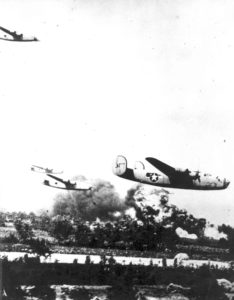
B-24Ds of White IV fly past the Columbia Aquila Română Plant, already burning from a strike by White II who, having realized White I’s error, broke formation and sought targets of opportunity.
Under Operation TIDAL WAVE, the US 9AF launches 180 modified Consolidated B-24s (five groups worth, with two on loan from the 8AF) from bases in occupied-Benghazi, Libya against the oil refineries surrounding Ploiești, România. The attack wing is split into seven strike forces:
-White I: 28 aircraft led by CO 376BG COL Keith K. Compton aboard Teggie Ann (42-40664), targeting the Româno-Americană Refinery. CG IX BC BG Uzal G. Ent also flies aboard as an observer.
-White II: 24 aircraft led by XO 93BG LTC Addison E. Baker aboard Hell’s Wench (42-40994) targeting the Concordia Vega refinery.
-White III: 13 aircraft led by CO 330BS (93BG) MAJ Ramsay D. Potts aboard Duchess (41-24147) targeting the Standard Petrol Block refinery.
-White IV: 48 aircraft led by CO 98BG COL John R. Kane aboard Hail, Columbia (41-11825) targeting the Unirea Orion and Astra Română refineries.
-White V: 16 aircraft led by CO 44BG COL Leon W. Johnson aboard Suzy Q (41-23817) targeting the Columbia Aquila Română Plant.
-Blue I: 21 aircraft led by XO 44BG LTC James T. Posey aboard V for Victory (41-23813) targeting the Creditul Minier Plant at nearby Brazi.
-Red I: 30 aircraft led by CO 389BG COL Jack W. Wood aboard Scorpion (42-40629) targeting the Steaua Română Plant at nearby Câmpina.
Following a complex plan developed by COL Jacob E. Smart originally titled SOAPSUDS, the mission seeks to minimalize radar detection and save fuel by having the bombers approach at tree-top height. The plan goes awry when the forces arrive at two different intervals and later when the lead group makes a navigational error; the result is chaos as the latter five fly on to meet fully-prepared air defenses. These mistakes are due, in part, to a disagreement between Compton and Kane in regard to throttle settings, resulting in the gap between the first three forces and the latter four. While Kane should have obeyed the order given to him by Compton, it is Compton's performance that is truly damning. Compton micromanaged his navigator and was responsible for the wrong turn that unraveled the entire operation. Despite multiple aircraft breaking radio silence to correct the error, Compton ignored these calls until Baker decided to lead his group against a target-of-opportunity (White IV). It was at this point that Ent intervened and gave the order that the remaining aircraft do the same, at which most simply dumped their loads and turned for home - including Compton himself, who jettisoned his aircraft's load without notifying the bombardier, the bombs tearing through the doors. In the end, only Blue I and Red I - the targets outside of Ploiești itself - are attacked as brief (to considerable success). Blame for the debacle is assigned to Kane and Ent and they are later returned stateside, though Compton escapes censure. TIDAL WAVE is the costliest USAAF strike of the war and the most decorated, with five Congressional Medals of Honor awarded, three of which are posthumous.
| Bombers Launched: | 180 | |
| Bombers Effective: | 162 | |
| Bombers MIA: | 54 | |
| Bombers DBR: | 8 | |
| Bombers Abort: | 16 | |
| Abort Rate: | 9% | |
| Loss Rate: | 34% | |
Click here to see the formation charts of the TIDAL WAVE strike forces.
| Aircraft Type | Serial No. | Name | Code | Unit | MACR | |
| White I | Consolidated B-24D-85-CO | 42-40664 | Teggie Ann | 100 | 514BS/376BG | |
| Consolidated B-24D-25-CO | 41-24297 | Chief Wahoo | 20 | 512BS/376BG | ||
| Consolidated B-24D-1-CO | 41-23724 | Doodlebug | 22 | 512BS/376BG | ||
| Consolidated B-24D-25-CO | 41-24258 | Desert Lilly | 23 | 512BS/376BG | ||
| Consolidated B-24D-70-CO | 42-40563 | Wongo Wongo! | 28 | 512BS/376BG | 150 | |
| Consolidated B-24D-40-CO | 42-40229 | Bomb Boogie | 31 | 512BS/376BG | ||
| Consolidated B-24D-25-CO | 41-24294 | Brewery Wagon | 36 | 512BS/376BG | 154 | |
| Consolidated B-24D-85-CO | 42-40658 | Warmaid | 38 | 512BS/376BG | ||
| Consolidated B-24D-45-CO | 42-40315 | Wolf Pack | 40 | 513BS/376BG | ||
| Consolidated B-24D-CO | 41-11779 | Li'l Abner | 41 | 513BS/376BG | ||
| Consolidated B-24D-CO | 41-11916 | Tangerine | 42 | 513BS/376BG | ||
| Consolidated B-24D-CO | 41-11591 | Queen Bee | 45 | 513BS/376BG | ||
| Consolidated B-24D-15-CO | 41-24032 | Let's Go! | 51 | 513BS/376BG | ||
| Consolidated B-24D-45-CO | 42-40317 | Barrel House Bessie | 54 | 513BS/376BG | ||
| Consolidated B-24D-85-CO | 42-40660 | Little Richard | 56 | 513BS/376BG | ||
| Consolidated B-24D-CO | 41-11935 | Per Diem II | 60 | 514BS/376BG | ||
| Consolidated B-24D-25-CO | 41-24310 | 62 | 514BS/376BG | |||
| Consolidated B-24D-CO | 41-11636 | Wash's Tub | 63 | 514BS/376BG | ||
| Consolidated B-24D-35-CO | 42-40206 | 8 Ball | 64 | 514BS/376BG | ||
| Consolidated B-24D-25-CO | 41-24252 | 70 | 514BS/376BG | |||
| Consolidated B-24D-15-CO | 41-24035 | Gremlin | 72 | 514BS/376BG | ||
| Consolidated B-24D-85-CO | 42-40657 | G.I. Ginnie | 74 | 514BS/376BG | ||
| Consolidated B-24D-35-CO | 42-40203 | Little Isadore | 81 | 514BS/376BG | ||
| Consolidated B-24D-CO | 41-11630 | Chum-V | 83 | 514BS/376BG | ||
| Consolidated B-24D-40-CO | 42-40232 | Joey Uptown | 85 | 514BS/376BG | ||
| Consolidated B-24D-45-CO | 42-40319 | Dopey Goldberg | 88 | 514BS/376BG | ||
| Consolidated B-24D-15-CO | 41-24030 | Good Time Charley | 90 | 514BS/376BG | ||
| Consolidated B-24D-15-CO | 41-24031 | Angie The Ox | 94 | 514BS/376BG | ||
| White II | Consolidated B-24D-120-CO | 42-40994 | Hell's Wench | D | 328BS/93BG | 331 |
| Consolidated B-24D-20-CO | 41-24192 | Dogpatch Raider | A | 328BS/93BG | ||
| Consolidated B-24D-1-CO | 41-23711 | Jerks Natural | B | 328BS/93BG | ||
| Consolidated B-24D-1-CO | 41-23722 | Bomerang | C | 328BS/93BG | ||
| Consolidated B-24D-40-CO | 42-40246 | Thunder Mug | F | 328BS/93BG | ||
| Consolidated B-24D-75-CO | 42-40604 | Satan's Angels | I | 328BS/93BG | ||
| Consolidated B-24D-30-CO | 42-40128 | War Baby | J | 328BS/93BG | ||
| Consolidated B-24D-75-CO | 42-40612 | Euroclydon The Storm | K | 328BS/93BG | 332/6465 | |
| Consolidated B-24D-75-CO | 42-40608 | Vulgar Virgin | M | 328BS/93BG | ||
| Consolidated B-24D-1-CO | 41-23682 | Blasted Event | Q | 329BS/93BG | ||
| Consolidated B-24D-5-CO | 41-23810 | TARFU | S | 329BS/93BG | ||
| Consolidated B-24D-95-CO | 42-40765 | Valiant Virgin | T | 329BS/93BG | ||
| Consolidated B-24D-1-CO | 41-23717 | Exterminator | H | 330BS/93BG | 334 | |
| Consolidated B-24D-20-CO | 41-24121 | Let'er Rip | J | 330BS/93BG | 462 | |
| Consolidated B-24D-25-CO | 41-24226 | Utah Man | L | 330BS/93BG | ||
| Consolidated B-24D-80-CO | 42-40617 | Jose Carioca | N | 409BS/93BG | 6464 | |
| Consolidated B-24D-20-CO | 41-24105 | Tupelo Lass | Q | 409BS/93BG | ||
| Consolidated B-24D-1-CO | 41-23742 | Liberty Lad | R | 409BS/93BG | ||
| Consolidated B-24D-20-CO | 41-24215 | Lucky | S | 409BS/93BG | ||
| Consolidated B-24D-5-CO | 41-23754 | Little Lady | U | 409BS/93BG | ||
| Consolidated B-24D-25-CO | 41-24298 | Queenie | V | 409BS/93BG | ||
| Consolidated B-24D-45-CO | 42-40265 | Honky Tonk Gal | W | 409BS/93BG | 330 | |
| Consolidated B-24D-75-CO | 42-40611 | Death Dealer | X | 409BS/93BG | ||
| Consolidated B-24D-75-CO | 42-40610 | Y | 409BS/93BG | |||
| White III | Consolidated B-24D-20-CO | 41-24147 | Duchess | A | 330BS/93BG | |
| Consolidated B-24D-1-CO | 41-23729 | Shoot Luke | D | 328BS/93BG | ||
| Consolidated B-24D-5-CO | 41-23809 | Hellsadroppin II | N | 329BS/93BG | ||
| Consolidated B-24D-30-CO | 42-40127 | Thar She Blows, Again | O | 329BS/93BG | ||
| Consolidated B-24D-20-CO | 41-24111 | Piccadilly Filly | P | 329BS/93BG | ||
| Consolidated B-24D-95-CO | 42-40781 | Hell's Angels | U | 329BS/93BG | 327 | |
| Consolidated B-24D-100-CO | 42-40804 | Lady Jane | X | 329BS/93BG | 328 | |
| Consolidated B-24D-25-CO | 41-24230 | Jo-Jo's Special Delivery | Z | 329BS/93BG | 329/6466 | |
| Consolidated B-24D-120-CO | 42-40969 | Big Noise | A | 330BS/93BG | ||
| Consolidated B-24D-20-CO | 41-24109 | Ready & Willing | C | 330BS/93BG | ||
| Consolidated B-24D-80-CO | 42-40613 | Pudgy | E | 330BS/93BG | 333 | |
| Consolidated B-24D-75-CO | 42-40609 | Jersey Bounce | I | 330BS/93BG | 335 | |
| Consolidated B-24D-25-CO | 41-24259 | War Maid | 30 | 512BS/376BG | ||
| White IV | Consolidated B-24D-CO | 41-11825 | Hail, Columbia | V | 344BS/98BG | |
| Consolidated B-24D-CO | 41-11776 | Bashful | O | 343BS/98BG | 171 | |
| Consolidated B-24D-CO | 41-11840 | Witch | P | 343BS/98BG | 173 | |
| Consolidated B-24D-125-CO | 42-41007 | Margie | P | 343BS/98BG | 170 | |
| Consolidated B-24D-CO | 41-11767 | Shanghai Lil | Q | 343BS/98BG | ||
| Consolidated B-24D-CO | 41-11761 | Squaw | R | 343BS/98BG | ||
| Consolidated B-24D-85-CO | 42-40655 | Damfino | S | 343BS/98BG | 174 | |
| Consolidated B-24D-30-CO | 42-40082 | Prince Charming | T | 343BS/98BG | ||
| Consolidated B-24D-CO | 41-11896 | Nightmare | U- | 343BS/98BG | ||
| Consolidated B-24D-CO | 41-11921 | Doc | W | 343BS/98BG | ||
| Consolidated B-24D-45-CO | 42-40313 | Boots | X | 343BS/98BG | 172 | |
| Consolidated B-24D-53-CO | 42-40364 | Snow White & the Seven Dwarfs | Y | 343BS/98BG | 165 | |
| Consolidated B-24D-CO | 41-11620 | Edna Elizabeth | Z | 343BS/98BG | ||
| Consolidated B-24D-20-CO | 41-24197 | Tagalong | A | 344BS/98BG | 168 | |
| Consolidated B-24D-15-CO | 41-24026 | Baby | B | 344BS/98BG | ||
| Consolidated B-24D-20-CO | 41-24198 | Vulgar Virgin | C | 344BS/98BG | 166 | |
| Consolidated B-24D-CO | 41-11768 | Kickapoo | D | 344BS/98BG | ||
| Consolidated B-24D-CO | 41-11803 | Rosie Wreck'em | E | 344BS/98BG | ||
| Consolidated B-24D-15-CO | 41-24040 | Big Operator | F | 344BS/98BG | ||
| Consolidated B-24D-CO | 41-11819 | Raunchy | G | 344BS/98BG | 169 | |
| Consolidated B-24D-1-CO | 41-23656 | Rowdy II | H | 344BS/98BG | ||
| Consolidated B-24D-5-CO | 41-23795 | Sneezy | I | 344BS/98BG | ||
| Consolidated B-24D-1-CO | 41-23733 | Skipper | J | 344BS/98BG | ||
| Consolidated B-24D-35-CO | 42-40208 | Sad Sack | K | 344BS/98BG | ||
| Consolidated B-24D-25-CO | 41-24311 | Hadley's Harem | L | 344BS/98BG | 167 | |
| Consolidated B-24D-25-CO | 41-24246 | Semper Felix | N | 345BS/98BG | 225 | |
| Consolidated B-24D-CO | 41-11774 | Chief | O | 345BS/98BG | ||
| Consolidated B-24D-85-CO | 42-40663 | Maternity Ward | P | 345BS/98BG | 224 | |
| Consolidated B-24D-120-CO | 42-40991 | Kate Smith | Q | 345BS/98BG | 226 | |
| Consolidated B-24D-CO | 41-11886 | Li'l Joe | S | 345BS/98BG | 222 | |
| Consolidated B-24D-30-CO | 42-40102 | Old Baldy | T | 345BS/98BG | 223 | |
| Consolidated B-24D-1-CO | 41-23661 | Black Jack | U | 345BS/98BG | ||
| Consolidated B-24D-CO | 41-11766 | Chug-A-Lug | V | 345BS/98BG | ||
| Consolidated B-24D-55-CO | 42-40402 | Sandman | W | 345BS/98BG | ||
| Consolidated B-24D-45-CO | 42-40316 | Snake Eyes | X | 345BS/98BG | ||
| Consolidated B-24D-45-CO | 42-40312 | Aire Lobo | Y | 345BS/98BG | 227 | |
| Consolidated B-24D-85-CO | 42-40662 | Black Magic | A | 415BS/98BG | ||
| Consolidated B-24D-20-CO | 41-24195 | Little Joe | B | 415BS/98BG | ||
| Consolidated B-24D-1-CF | 42-63758 | Li'l Jughaid | D | 415BS/98BG | ||
| Consolidated B-24D-5-CO | 41-23782 | Boiler Maker II | E | 415BS/98BG | 177 | |
| Consolidated B-24D-35-CO | 42-40195 | Penelope | F | 415BS/98BG | ||
| Consolidated B-24D-CO | 41-11815 | Daisy Mae | G | 415BS/98BG | ||
| Consolidated B-24D-CO | 41-11817 | Stinger | H | 415BS/98BG | ||
| Consolidated B-24D-CO | 41-11836 | Li'l De-icer | I | 415BS/98BG | ||
| Consolidated B-24D-15-CO | 41-24023 | Fertile Myrtle | J | 415BS/98BG | ||
| Consolidated B-24D-45-CO | 42-40322 | Cornhusker | K | 415BS/98BG | 178 | |
| Consolidated B-24D-65-CO | 42-40520 | Yen Tu | M | 415BS/98BG | 176 | |
| Consolidated B-24D-120-CO | 42-40973 | Battleaxe | Z | 415BS/98BG | ||
| White V | Consolidated B-24D-5-CO | 41-23817 | Suzy Q | L | 67BS/44BG | |
| Consolidated B-24D-15-CO | 41-24024 | Bewitching Witch | 34 | 512BS/376BG | 15859 | |
| Consolidated B-24D-35-CO | 42-40182 | Forky II | A | 66BS/44BG | 2415 | |
| Consolidated B-24D-5-CO | 41-23778 | Lady Luck | F | 66BS/44BG | ||
| Consolidated B-24D-53-CO | 42-40375 | Scrappy II | G | 66BS/44BG | 1646 | |
| Consolidated B-24D-13-CO | 41-23936 | Queen Anne | J | 66BS/44BG | ||
| Consolidated B-24D-5-CO | 41-23811 | Fascinatin' Witch | K | 66BS/44BG | ||
| Consolidated B-24D-20-CO | 41-24153 | Sad Sack II | L | 66BS/44BG | 2414 | |
| Consolidated B-24D-95-CO | 42-40777 | Flossie Flirt | N | 66BS/44BG | ||
| Consolidated B-24D-15-CO | 41-24015 | Wing Dinger | R | 66BS/44BG | 2410 | |
| Consolidated B-24D-1-CF | 42-63761 | Li'l Abner | D | 67BS/44BG | 2413 | |
| Consolidated B-24D-5-CO | 41-23779 | 4Q2 | G | 67BS/44BG | ||
| Consolidated B-24D-95-CO | 42-40780 | Available Jones | H | 67BS/44BG | 2411 | |
| Consolidated B-24D-25-CO | 41-24232 | Calaban | M | 67BS/44BG | ||
| Consolidated B-24D-45-CO | 42-40267 | Horse Fly | N | 67BS/44BG | ||
| Consolidated B-24D-25-CO | 41-24229 | Buzzin' Bear | P | 67BS/44BG | ||
| Blue I | Consolidated B-24D-5-CO | 41-23813 | V for Victory | V | 68BS/44BG | |
| Consolidated B-24D-25-CO | 41-24235 | Earthquake McGoon | C | 506BS/44BG | ||
| Consolidated B-24D-35-CO | 42-40172 | Lynn Bari II | C | 506BS/44BG | ||
| Consolidated B-24D-125-CO | 42-41013 | Trouble | D | 506BS/44BG | ||
| Consolidated B-24D-20-CO | 41-24201 | Baldy & his Brood | O | 506BS/44BG | ||
| Consolidated B-24D-95-CO | 42-40778 | Southern Comfort | T | 506BS/44BG | ||
| Consolidated B-24D-25-CO | 41-24234 | Mr. 5x5 | U | 506BS/44BG | ||
| Consolidated B-24D-53-CO | 42-40370 | Heaven Can Wait | V | 506BS/44BG | ||
| Consolidated B-24D-75-CO | 42-40606 | Timba-a-h! | X | 506BS/44BG | ||
| Consolidated B-24D-25-CO | 42-24282 | Ruth-Less | Y | 506BS/44BG | ||
| Consolidated B-24D-25-CO | 41-24283 | Old Crow | Z | 506BS/44BG | ||
| Consolidated B-24D-95-CO | 42-40764 | Helen B. Happy | M | 66BS/44BG | ||
| Consolidated B-24D-53-CO | 42-40371 | G.I. Gal | Q | 67BS/44BG | 2412 | |
| Consolidated B-24D-120-CO | 42-40995 | Marguerite | C | 68BS/44BG | 2416/3147 | |
| Consolidated B-24D-30-CO | 42-40071 | Margaret Ann II | C | 68BS/44BG | ||
| Consolidated B-24D-5-CO | 41-23788 | Avenger | D | 68BS/44BG | ||
| Consolidated B-24D-90-CO | 42-40731 | Hag Mag the Mothball Queen | N | 68BS/44BG | ||
| Consolidated B-24D-1-CO | 41-23699 | Lemon Drop | P | 68BS/44BG | ||
| Consolidated B-24D-25-CO | 41-24225 | Flak Alley | T | 68BS/44BG | ||
| Consolidated B-24D-20-CO | 41-24211 | Wing & A Prayer | U | 68BS/44BG | ||
| Consolidated B-24D-53-CO | 42-40373 | Natchez Belle | Z | 68BS/44BG | ||
| Red I | Consolidated B-24D-80-CO | 42-40629 | Scorpion | N | 565BS/389BG | |
| Consolidated B-24D-30-CO | 42-40115 | Boomerang | A- | 343BS/98BG | 159 | |
| Consolidated B-24D-CO | 41-11767 | Shanghai Lil | Q | 343BS/98BG | ||
| Consolidated B-24D-95-CO | 42-40746 | Ole Irish | B | 564BS/389BG | ||
| Consolidated B-24D-95-CO | 42-40772 | Scheherezade | C | 564BS/389BG | ||
| Consolidated B-24D-100-CO | 42-40803 | F | 564BS/389BG | |||
| Consolidated B-24D-95-CO | 42-40776 | Old Blister Butt | H | 564BS/389BG | ||
| Consolidated B-24D-95-CO | 42-40773 | I | 564BS/389BG | |||
| Consolidated B-24D-95-CO | 42-40753 | Old Kickapoo | J | 564BS/389BG | 157 | |
| Consolidated B-24D-95-CO | 42-40749 | Sack-Time Sally | P | 565BS/389BG | ||
| Consolidated B-24D-90-CO | 42-40716 | Yours Truly | R | 565BS/389BG | ||
| Consolidated B-24D-95-CO | 42-40744 | S | 565BS/389BG | 243 | ||
| Consolidated B-24D-95-CO | 42-40787 | Vagabond King | V | 565BS/389BG | ||
| Consolidated B-24D-100-CO | 42-40795 | Golden Sandstorm | X | 565BS/389BG | ||
| Consolidated B-24D-95-CO | 42-40775 | Wolf Wagon | Y | 565BS/389BG | ||
| Consolidated B-24D-13-CO | 41-23933 | Sweet Adeline II | Z | 565BS/389BG | ||
| Consolidated B-24D-90-CO | 42-40722 | Little Gramper | B- | 566BS/389BG | ||
| Consolidated B-24D-90-CO | 42-40735 | Sand Witch | C- | 566BS/389BG | 156 | |
| Consolidated B-24D-90-CO | 42-40706 | Tondelao | F- | 566BS/389BG | ||
| Consolidated B-24D-80-CO | 42-40623 | I- | 566BS/389BG | |||
| Consolidated B-24D-90-CO | 42-40738 | Oklahoman | J- | 566BS/389BG | ||
| Consolidated B-24D-100-CO | 42-40793 | Blonds Away | H- | 567BS/389BG | ||
| Consolidated B-24D-80-CO | 42-40619 | N- | 567BS/389BG | |||
| Consolidated B-24D-95-CO | 42-40743 | O- | 567BS/389BG | |||
| Consolidated B-24D-70-CO | 42-40544 | Hitler's Hearse | R- | 567BS/389BG | ||
| Consolidated B-24D-95-CO | 42-40747 | S- | 567BS/389BG | |||
| Consolidated B-24D-100-CO | 42-40807 | U- | 567BS/389BG | |||
| Consolidated B-24D-90-CO | 42-40733 | V- | 567BS/389BG | |||
| Consolidated B-24D-95-CO | 42-40782 | Chattanooga Choo-Choo | X- | 567BS/389BG | 158 | |
| Consolidated B-24D-95-CO | 42-40751 | Touch Of Texas | Y- | 567BS/389BG |
Exterminator (41-23717) and Let'er Rip (42-24121) of the 93BG suffer a mid-air collision on return from the strike.
Flossie Flirt (42-40777, 44BG), Horse Fly (42-40267, 44BG), Vulgar Virgin (42-40608, 93BG), Little Lady (41-23754, 93BG), Chief Wahoo (41-24297, 376BG), "S-Sugar" (42-40744, 389BG), and Hitler's Hearse (42-40544, 389BG) land in neutral Turkey and are interned.
This day also sees the first Canadian-built Avro Lancaster, Ruhr Express (KB700, 419 Squadron), roll off the assembly line. The Air Ministry expanded Lancaster production into Canada on 8 September 1941, with the British government taking control of Victory Aircraft on 4 November 1942 following the arrival of pattern aircraft R5727. This was not an easy task. Canada's native aviation industry was by no means as advanced as Britain's, requiring much of the bomber's equipment (the engines in particular) be subcontracted through the United States. Starting with "F for Freddy" (KB855, 428 Squadron) in December 1944, one of the most distinguishing aspects of Canadian-built Lancasters are the American-built Martin 250CE upper turrets - a far superior turret to the British FN150. A total of 430 Canadian Lancasters, deemed Mk. Xs, are built by war's end, eventually achieving a production level of one bomber per day. Of these, 275 are altered to carry American-made Martin turrets.
7 August 1943
Due to the overwhelming political impact of US 12AF airstrikes against Napales (17 July) and Rome (19 July), the CCS push RAF BC to increase their attacks against northern Italy in the hopes of pressuring Italy to accept Allied surrender terms. This night sees the first of these RAF BC strikes, with 197 Avro Lancasters bombing Genoa, Milan, and Turin. The bombers are directed by Gp Capt John H. Searby, perfecting what would later become the “Master Bomber” technique.
| Bombers Launched: | 202 |
| Bombers Effective: | 201 |
| Bombers MIA: | 2 |
| Bombers Abort: | 1 |
| Abort Rate: | ≤1% |
| Loss Rate: | 1% |
| Aircraft Type | Serial No. | Code | Unit |
| Avro Lancaster Mk. III | LM339 | unk | 61 Squadron |
| Avro Lancaster Mk. III | DV196 | K | 106 Squadron |
11 August 1943
The US 12AF launches 72 Boeing B-17s against the marshaling yards of Terni, Italy in preparation of Operation AVALANCHE – the invasion of Italy - which is set to begin next month. One of the B-17s, Bonnie Sue (42-30307, 301BG), is shot down by a captured Lockheed P-38 piloted by Ten. Col. Angelo Tondi. Using the P-38’s distinctive silhouette, Tondi is able to approach his target undisturbed, though gunfire from other bombers prevents him from following up on this success. Despite several claims to the contrary, this is the only documented instance of a US bomber being downed by a captured Allied fighter.
| Bombers Launched: | 72 |
| Bombers MIA: | 1 |
| Bombers DBR: | 1 |
| Loss Rate: | 3% |
| Aircraft Type | Serial No. | Name | Code | Unit | MACR |
| Boeing B-17F-95-BO | 42-30307 | Bonnie Sue | unk | 419BS/301BG | 490 |
The exact origin of this fighter cannot be determined as, while Italian records confirm the capture of a P-38 that mistakenly landed on Sardinia on 12 July 1943, no US record has been found to identify this aircraft. Rumors had long persisted about the supposed use of Allied fighters to lure victims into a false sense of security. Earlier claims existed, such as one made by 2LT Harold C. Lentz (1FG) on 25 March 1943, but no other incidents can be confirmed. Despite several friendly-fire incidents, no more captured-aircraft attacks take place, largely due to the fact that Axis synthetic fuels are painfully damaging to Allied engines.
Much exaggeration has arisen from this incident, largely through the efforts of author Martin Caidin. A science-fiction author, liberal journalist, and self-proclaimed psychic, Caidin fancied himself an expert in historic aviation and contributed heavily to the historiography of airpower in the Second World War. Caidin promoted a tale wherein a captured P-38, piloted by a “Guido Rossi,” was finally brought to justice by an enterprising American airman who goaded the Italian by painting his wife nude on the side of a YB-40 gunship. No YB-40 ever saw service in the Mediterranean and no such person exists in Italian air records. Unfortunately, this tall-tale still persists in many otherwise respectable circles.
12 August 1943
The US 8AF launches 330 Boeing B-17s who, failing to locate their targets, bomb targets-of-opportunity Bochum, Bonn, Gelsenkirchen, and Recklinghausen, Germany. The force is escorted by 131 Republic P-47s, with additional escort provided by RAF FC. This day sees the first use of the pressurized droptanks on US fighter aircraft.
Among those lost this day is A-3 Eastern Flight Training Command (EFTC) COL Delmar T. Spivey, the USAAF's ranking officer in aerial gunnery. Observing aerial gunnery in the 8AF, Spivey bails out of USS Aliquippa (42-30081, 92BG), becoming for a time the highest ranking US POW in the ETO.
| Bombers Launched: | 330 |
| Bombers Effective: | 243 |
| Bombers MIA: | 25 |
| Bombers DBR: | 3 |
| Bombers Abort: | 87 |
| Abort Rate: | 26% |
| Loss Rate: | 8% |
| E/A Destroyed: | 11 |
The long-range escort issue long plagued USAAF leaders - in fact, CG USAAF GEN Henry H. Arnold received weekly reports on the subject. The P-47 had certainly not earned a gleaming reputation, with VIII FC needing to constantly update the fighter's internal systems, including the troublesome addition of an auxiliary fuel tank behind the pilot. Still, this was not enough. YB-40 escort gunships were little more than extra bombers, and using ferry tanks on the P-47s, while expedient, was clumsy and dangerous. A design based on the old Curtiss P-40's belly tank was obviously worth study and it was from here that the new 75 gal. droptank was based. With VIII FC's Technical Section having discovered a means to pressurize the tanks, the issue was now one of quantity. Here the economic might of the US failed, the UK outproducing the US throughout 1943 largely due to labor strikes hindering steel production. In the interest of expediency, VIII FC pushed UK firms to supplement droptank numbers, with impatience on both sides hindering an already touchy subject.
Regardless of the slowness of droptank production, the psychological impact of US fighters flying over Germany cannot be overstated. Gen d JgFl Adolf J. F. Galland and RBM B. K. H. Albert Speer - two of the more competent leaders in German high-command - personally appeal to Führer Adolf Hitler on the seriousness of Operation GOMORRAH and the increasing appearance of US fighters. Hitler dismisses the US fighters outright, citing RLM RM Hermann W. Göring's insistence that such ranges are technologically impossible. This leads to a public incident on 17 August 1943 when Galland confronts Göring with the physical evidence of a P-47 wreck in Aachen. Göring's response is to insist that the fighter in question had lost power over France and glided into Germany. Galland's brother, Wilhelm-Ferdinand (JG26), was in fact killed by a P-47 piloted by CPT W. M. "Bud" Mahurin (56FG) that very morning.
| Republic P-47D | |
| Fuel Capacity: | 370 gal |
| Combat Radius - Standard: | 230 mi |
| Combat Radius - x1 75 gal droptank: | 280 mi |
| Combat Radius - x2 75 gal droptanks: | 340 mi |
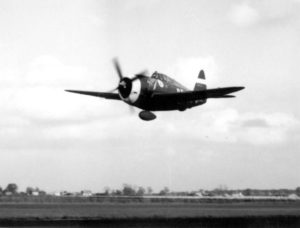
Kathie (42-8424, 487FG), piloted by 1LT William D. Schwenke, Jr., flies by with a 75 gal droptank on its belly.
| Aircraft Type | Serial No. | Name | Code | Unit | MACR |
| Boeing B-17F-30-BO | 42-5077 | Delta Rebel No. 2 | OR-T | 323BS/91BG | 261 |
| Boeing B-17F-20-VE | 42-5787 | Billie Kay | OR-U | 323BS/91BG | 262 |
| Boeing B-17F-30-DL | 42-3162 | Buccaneer | LL-A | 401BS/91BG | 259 |
| Boeing B-17F-60-BO | 42-29587 | Jolly Roger | LL-J | 401BS/91BG | 260 |
| Boeing B-17F-75-BO | 42-29884 | JW-D | 326BS/92BG | 374 |
| Boeing B-17F-80-BO | 42-29945 | Daisy June II | JW-unk | 326BS/92BG | 658 |
| Boeing B-17F-20-VE | 42-5801 | Flak Happy | UX-J | 327BS/92BG | 656 |
| Boeing B-17F-85-BO | 42-30081 | USS Aliquippa | PY-O | 407BS/92BG | 655 |
| Boeing B-17F-100-BO | 42-30418 | Picadilly Commando | BG-L | 334BS/95BG | 254 |
| Boeing B-17F-90-BO | 42-30194 | We Ain't Scared | OE-O | 335BS/95BG | 253 |
| Boeing B-17F-65-BO | 42-29640 | Ol' Ironsides | BN-X | 359BS/303BG | 256 |
| Boeing B-17F-60-BO | 42-29553 | Arkie II | KY-D | 366BS/305BG | 252 |
| Boeing B-17F-55-DL | 42-3406 | Big Operator | GY-V | 367BS/306BG | 255 |
| Boeing B-17F-75-BO | 42-29898 | Scarlett O'Hara | WA-I | 524BS/379BG | 1762 |
| Boeing B-17F-35-DL | 42-3199 | Calamity Jane | WA-Z | 524BS/379BG | 905 |
| Boeing B-17F-25-VE | 42-5820 | Mystic | LF-C | 526BS/379BG | 1359 |
| Boeing B-17F-25-VE | 42-5821 | Cindy | FO-O | 527BS/379BG | 1360 |
| Boeing B-17F-25-VE | 42-5847 | Margie Mae | VE-T | 532BS/381BG | 660 |
| Boeing B-17F-80-BO | 42-29954 | Devil's Angel | GD-D | 534BS/381BG | 383 |
| Boeing B-17F-80-BO | 42-29950 | Forget Me Not | MS-N | 535BS/381BG | 385 |
| Boeing B-17F-40-DL | 42-3231 | Inferno | JD-M | 545BS/384BG | 287 |
| Boeing B-17F-25-VE | 42-5806 | JD-Z | 545BS/384BG | 288 |
| Boeing B-17F-85-BO | 42-30046 | Merrie Hell | BK-H | 546BS/384BG | 289 |
| Boeing B-17F-25-DL | 42-3104 | Raider | SO-A | 547BS/384BG | 286 |
| Boeing B-17F-65-BO | 42-29686 | Pie Eyed Piper | SO-B | 547BS/384BG | 290 |
13 August 1943
The US 12AF launches 106 Boeing B-17s, escorted by 45 Lockheed P-38s, out of Oran, Algeria against the San Lorenzo and Scalo del Littorio marshaling yards of Rome. No heavy bombers are lost.
Despite ousting Presidente Benito A. A. Mussolini from power following the strke of 19 July, the new Italian government under Maresciallo d'Italia Pietro Badoglio was slow to accept the Allied terms of surrender. Not only was the issue of 'unconditional surrender' difficult to accept - as it would entail removing the royal family under Re Vittorio Emanuele F. M. G. Savoy - but Allied expectations of Italy were unclear should surrender actually occur. After all, German forces were already occupying Italy en force, and Mussolini's oust from power had already caused German leaders to plan for an immediate takeover should Italy abandon its Axis obligations. Italy was in a true 'damned if you do, damned if you don't' situation. Nevertheless, this second strike on Rome, carefully planned to force the issue of surrender, achieves its goal. Badoglio declares Rome an 'open city' the following day, beginning secret surrender talks on 16 August. (502 killed)
This day also sees the US 9AF launch 114 Consolidated B-24s, still aided by 8AF transfers, out of Benghazi, Libya against the Messerschmitt Flugzeugwerke plants of Wiener Neustädt, Austria. This is the first strike of Operation JUGGLER. Conceived as a means of fulfilling the POINTBLANK directive, JUGGLER targets the Messerschmitt plants of Regensburg, Germany and Wiener Neustädt, Austria. Since the issuance of POINTBLANK on 14 June, the 8AF counter-air campaign focused on Focke-Wulf production centers like Bremen, Kassel, and Oschersleben - targets relatively close to the combat radius of the Republic P-47. With 8AF bomber numbers finally crossing the 800 mark in July, pressure is on for the USAAF in Europe to begin deep penetration strikes. JUGGLER hopes to compensate for its lack of long-range escort by attempting to confuse the Luftwaffe and spread its forces thin.
JUGGLER’s start is a rough one. Originally, the idea was for the 9AF to strike Wiener Neustädt the same day that the 8AF targeted Regensburg, diverting Luftwaffe resources from one another. Poor British weather makes this impossible so the 8AF instead couples the Regesnburg strike with that of Schweinfurt, planned for 17 August (the anniversary of the 8AF's first mission), while the Wiener Neustädt strike is launched alone. It makes little difference. The heavy losses incurred during TIDAL WAVE a week earlier leaves the 9AF's JUGGLER component massively understrength, with combat fatigue and hurried repairs resulting in a massive number of mission aborts. Still, there are some minor successes. The strike catches the defenders by surprise and only four interceptors manage to attack the formation. Despite minimal accuracy, this day's operation destroys some 50 newly-completed Bf-109s and halts factory production well-into October.
After this day's operation, 8AF units on loan to the 9AF begin the slow process of returning to their bases in the UK.
| Bombers Launched: | 114 | |
| Bombers Effective: | 61 | |
| Bombers MIA: | 2 | |
| Bombers Abort: | 53 | |
| Abort Rate: | 46% | |
| Loss Rate: | 2% | |
One of the B-24s, Death Dealer (42-40611, 93BG), is severely damaged and lands in neutral Switzerland - the first US bomber to do so. As a neutral country (though favorable to Nazi Germany), Switzerland interns Allied aircraft and crews who cross its borders. Over 150 US aircraft are interned in Switzerland by the war’s end, and while there are genuine concerns that some of the bombers are landing there on purpose to escape combat, records are unclear as to how widespread this practice actually is.
| Aircraft Type | Serial No. | Name | Code | Unit | MACR |
| Consolidated B-24D-75-CO | 42-40611 | Death Dealer | X | 409BS/93BG |
| Consolidated B-24D-53-CO | 42-40392 | Chum VII | 84 | 515BS/376BG |
| Aircraft Type | Serial No. | Name | Unit | Date |
| Consolidated B-24D-75-CO | 42-40611 | Death Dealer | 409BS/93BG/9AF | 13-Aug-43 |
| Boeing B-17F-85-BO | 42-30080 | High Life | 351BS/100BG/8AF | 17-Aug-43 |
| Boeing B-17F-95-BO | 42-30315 | Battle Queen | 569BS/390BG/8AF | 17-Aug-43 |
| Boeing B-17F-85-BO | 42-30057 | Raunchy | 351BS/100BG/8AF | 6-Sep-43 |
| Boeing B-17F-60-DL | 42-3434 | So What? | 364BS/305BG/8AF | 6-Sep-43 |
| Boeing B-17F-27-BO | 42-24592 | Madame Butterfly | 366BS/305BG/8AF | 6-Sep-43 |
| Boeing B-17F-25-VE | 42-5841 | Est Nulla Via In Via Virtuti | 423BS/306BG/8AF | 6-Sep-43 |
| Boeing B-17F-105-BO | 42-30478 | Impatient Virgin II | 560BS/388BG/8AF | 6-Sep-43 |
| Boeing B-17F-30-VE | 42-5856 | Hubba Hubba | 347BS/99BG/15AF | 1-Oct-43 |
| Boeing B-17F-85-BO | 42-30126 | Sugar Foot | 416BS/99BG/15AF | 1-Oct-43 |
| Boeing B-17F-120-BO | 42-30831 | Lazy Baby | 364BS/305BG/8AF | 14-Oct-43 |
| Consolidated B-24H-1FO | 42-7519 | 328BS/93BG/8AF | 7-Jan-44 |
| Boeing B-17G-10-DL | 42-37755 | Dottie G | 325BS/92BG/8AF | 25-Feb-44 |
| Consolidated B-24H-10-FO | 42-52148 | Liberty Lady | 720BS/450BG/15AF | 25-Feb-44 |
| Boeing B-17G-20-BO | 42-31585 | Mount 'N Ride | 323BS/91BG/8AF | 16-Mar-44 |
| Consolidated B-24D-120-CO | 42-40969 | Big Noise | 330BS/93BG/8AF | 16-Mar-44 |
| Consolidated B-24J-70-CO | 42-100116 | 330BS/93BG/8AF | 16-Mar-44 |
| Boeing B-17G-10-BO | 42-31329 | 334BS/95BG/8AF | 16-Mar-44 |
| Boeing B-17G-30-DL | 42-38195 | Damn Yankee | 549BS/92BG/8AF | 16-Mar-44 |
| Boeing B-17G-30-DL | 42-38160 | Lonesome Polecat | 550BS/385BG/8AF | 16-Mar-44 |
| Consolidated B-24J-90-CO | 42-100332 | Galloping Katie | 566BS/389BG/8AF | 16-Mar-44 |
| Boeing B-17G-15-VE | 42-97515 | Little Runt | 325BS/92BG/8AF | 18-Mar-44 |
| Boeing B-17G-15-DL | 42-37825 | Super Ball | 511BS/351BG/8AF | 18-Mar-44 |
| Boeing B-17G-30-BO | 42-31871 | 547BS/384BG/8AF | 18-Mar-44 |
| Boeing B-17G-10-DL | 42-37793 | Spirit Of Winsome Winn II | 547BS/384BG/8AF | 18-Mar-44 |
| Consolidated B-24H-1-FO | 42-7618 | Hell's Kitchen | 66BS/44BG/8AF | 18-Mar-44 |
| Consolidated B-24J-65-CO | 42-100073 | Sack Artists | 67BS/44BG/8AF | 18-Mar-44 |
| Consolidated B-24J-105-CO | 42-109800 | 68BS/44BG/8AF | 18-Mar-44 |
| Consolidated B-24J-70-CO | 42-100112 | 68BS/44BG/8AF | 18-Mar-44 |
| Consolidated B-24H-15-CF | 41-29431 | Shoo Shoo Baby | 68BS/44BG/8AF | 18-Mar-44 |
| Consolidated B-24J-100-CO | 42-100400 | Wotto Load | 506BS/44BG/8AF | 18-Mar-44 |
| Consolidated B-24H-10-DT | 41-28692 | Hell's Wagon | 576BS/392BG/8AF | 18-Mar-44 |
| Consolidated B-24J-105-CO | 42-109826 | Late Date II | 577BS/392BG/8AF | 18-Mar-44 |
| Consolidated B-24H-1-CF | 42-29127 | Li'l Gypsy | 579BS/392BG/8AF | 18-Mar-44 |
| Consolidated B-24H-1-FO | 42-7513 | Pistol Packin' Mama | 702BS/445BG/8AF | 18-Mar-44 |
| Consolidated B-24H-1-FO | 42-7625 | Flying Termite | 705BS/446BG/8AF | 18-Mar-44 |
| Consolidated B-24J-85-CO | 42-100284 | 714BS/448BG/8AF | 18-Mar-44 |
| Boeing B-17G-30-BO | 42-31747 | Angel In The Skies | 332BS/94BG/8AF | 13-Apr-44 |
| Boeing B-17G-35-BO | 42-31977 | 332BS/94BG/8AF | 13-Apr-44 |
| Boeing B-17F-95-BO | 42-30233 | Rhapsody In Flak | 412BS/95BG/8AF | 13-Apr-44 |
| Boeing B-17G-35-BO | 42-32073 | 339BS/96BG/8AF | 13-Apr-44 |
| Boeing B-17G-30-BO | 42-31866 | Pride Of The Yankees | 550BS/385BG/8AF | 13-Apr-44 |
| Boeing B-17G-30-DL | 42-38196 | 550BS/385BG/8AF | 13-Apr-44 |
| Boeing B-17G-25-BO | 42-31691 | Lassie | 571BS/390BG/8AF | 13-Apr-44 |
| Boeing B-17G-35-DL | 42-107021 | 710BS/447BG/8AF | 13-Apr-44 |
| Boeing B-17G-5-BO | 42-31184 | Wichita Witch | 711BS/447BG/8AF | 13-Apr-44 |
| Boeing B-17G-40-BO | 42-97064 | 711BS/447BG/8AF | 13-Apr-44 |
| Consolidated B-24J-90-CO | 42-100330 | 67BS/44BG/8AF | 13-Apr-44 |
| Consolidated B-24H-1-DT | 42-28629 | Blondes Away | 734BS/453BG/8AF | 13-Apr-44 |
| Consolidated B-24H-15-FO | 42-52567 | 787BS/466BG/8AF | 13-Apr-44 |
| Boeing B-17G-30-BO | 42-31914 | Butch | 326BS/92BG/8AF | 24-Apr-44 |
| Boeing B-17G-45-BO | 42-97203 | Baby | 407BS/92BG/8AF | 24-Apr-44 |
| Boeing B-17G-30-BO | 42-31921 | Li'l Brat | 407BS/92BG/8AF | 24-Apr-44 |
| Boeing B-17G-40-BO | 42-97138 | 332BS/94BG/8AF | 24-Apr-44 |
| Boeing B-17G-35-BO | 42-31993 | Gen'ril Oop | 334BS/95BG/8AF | 24-Apr-44 |
| Boeing B-17G-25-BO | 42-31632 | 335BS/95BG/8AF | 24-Apr-44 |
| Boeing B-17G-25-BO | 42-31669 | Shoo Shoo Baby | 358BS/303BG/8AF | 24-Apr-44 |
| Boeing B-17G-30-DL | 42-38204 | 360BS/303BG/8AF | 24-Apr-44 |
| Boeing B-17G-5-BO | 42-31172 | 367BS/306BG/8AF | 24-Apr-44 |
| Boeing B-17G-30-BO | 42-31758 | 367BS/306BG/8AF | 24-Apr-44 |
| Boeing B-17G-20-BO | 42-31539 | 423BS/306BG/8AF | 24-Apr-44 |
| Boeing B-17G-15-DL | 42-37885 | Frostie | 545BS/384BG/8AF | 24-Apr-44 |
| Boeing B-17G-50-BO | 42-102446 | Little Chub | 545BS/384BG/8AF | 24-Apr-44 |
| Consolidated B-24J-135-CO | 42-110098 | Flying Sac | 715BS/448BG/8AF | 24-Apr-44 |
| Consolidated B-24H-1-DT | 41-28583 | Rum Runner | 713BS/448BG/8AF | 25-Apr-44 |
| Consolidated B-24H-1-DT | 41-28602 | Commando | 713BS/448BG/8AF | 25-Apr-44 |
| Consolidated B-24G-10-NT | 42-78184 | Rowdy Dowdy's | 720BS/450BG/15AF | 25-Apr-44 |
| Consolidated B-24H-10-CF | 42-64496 | Borsuk's Bitch | 735BS/453BG/8AF | 25-Apr-44 |
| Consolidated B-24H-10-DT | 41-28738 | Meat Around the Corner | 754BS/458BG/8AF | 11-Jun-44 |
| Consolidated B-24H-20-CF | 42-50354 | Fickle Finger Of Fate | 790BS/467BG/8AF | 11-Jun-44 |
| Boeing B-17G-30-BO | 42-31865 | Old Ironsides | 775BS/463BG/15AF | 13-Jun-44 |
| Consolidated B-24H-15-FO | 42-52347 | Belle Ringer | 763BS/460BG/15AF | 13-Jun-44 |
| Consolidated B-24H-15-FO | 42-52661 | Sinful Cynthia | 827BS/484BG/15AF | 13-Jun-44 |
| Boeing B-17G-35-DL | 42-107042 | Liberty Run | 401BS/91BG/8AF | 27-Jun-44 |
| Boeing B-17G-20-VE | 42-97603 | Gremlin Buggy II | 333BS/94BG/8AF | 27-Jun-44 |
| Boeing B-17G-30-BO | 42-31899 | Chatterbox | 510BS/351BG/8AF | 27-Jun-44 |
| Consolidated B-24H-20-FO | 42-94946 | Cat's Ass | 752BS/458BG/8AF | 27-Jun-44 |
| Consolidated B-24J-145-CO | 44-40102 | Heaven Can Wait | 856BS/492BG/8AF | 27-Jun-44 |
| North American P-51B-5-NA | 43-6556 | Chicago Gun Mole | 362FG/357FG/8AF | 27-Jun-44 |
| Consolidated B-24H-25-FO | 42-95056 | 565BS/389BG/8AF | 28-Jun-44 |
| Boeing B-17G-55-BO | 42-102651 | Piccadilly Ann II | 710BS/447BG/8AF | 11-Jul-44 |
| Boeing B-17G-15-DL | 42-37873 | 710BS/447BG/8AF | 11-Jul-44 |
| Consolidated B-24H-25-DT | 42-51106 | Georgia Peach | 576BS/392BG/8AF | 11-Jul-44 |
| Consolidated B-24H-25-FO | 42-95033 | 578BS/392BG/8AF | 11-Jul-44 |
| Consolidated B-24H-1-FO | 42-7571 | Lillian Ann II | 703BS/445BG/8AF | 11-Jul-44 |
| Consolidated B-24H-25-FO | 42-95196 | 856BS/492BG/8AF | 11-Jul-44 |
| Consolidated B-24J-150-CO | 44-40168 | Tequila Daisy | 857BS/492BG/8AF | 11-Jul-44 |
| Boeing B-17G-50-BO | 42-102457 | Gloria | 410BS/94BG/8AF | 12-Jul-44 |
| Boeing B-17G-40-VE | 42-97957 | Beyond My Dreams | 570BS/390BG/8AF | 12-Jul-44 |
| Boeing B-17G-20-BO | 42-31552 | My Buddy | 748BS/457BG/8AF | 12-Jul-44 |
| Boeing B-17G-40-DL | 44-6111 | Hell's Belle | 749BS/457BG/8AF | 12-Jul-44 |
| Consolidated B-24H-20-DT | 41-28948 | 565BS/389BG/8AF | 12-Jul-44 |
| Consolidated B-24H-1-FO | 42-7591 | Fat Stuff II | 712BS/448BG/8AF | 12-Jul-44 |
| Consolidated B-24H-15-FO | 42-94735 | Bim Bam Bola | 714BS/448BG/8AF | 12-Jul-44 |
| Consolidated B-24H-25-FO | 42-95096 | Bombs Away | 754BS/458BG/8AF | 12-Jul-44 |
| Consolidated B-24H-15-FO | 42-52559 | Miss Fortune | 790BS/467BG/8AF | 12-Jul-44 |
| Consolidated B-24H-25-DT | 42-51113 | 855BS/491BG/8AF | 12-Jul-44 |
| Boeing B-17G-35-DL | 42-107137 | 349BS/100BG/8AF | 13-Jul-44 |
| Boeing B-17G-1-BO | 42-31074 | Calepit | 350BS/100BG/8AF | 13-Jul-44 |
| Boeing B-17G-35-VE | 42-97905 | 360BS/303BG/8AF | 13-Jul-44 |
| Boeing B-17G-35-DL | 42-107137 | 550BS/385BG/8AF | 13-Jul-44 |
| Consolidated B-24H-20-FO | 42-94989 | Battlin' Baby | 713BS/448BG/8AF | 13-Jul-44 |
| Boeing B-17G-40-DL | 44-6112 | 550BS/385BG/8AF | 16-Jul-44 |
| Boeing B-17G-30-BO | 42-31889 | Mommy Yokum | 429BS/2BG/15AF | 18-Jul-44 |
| Boeing B-17G-35-DL | 42-107075 | Champagne Girl | 323BS/91BG/8AF | 19-Jul-44 |
| Boeing B-17G-45-BO | 42-97237 | Royal Flush II | 547BS/384BG/8AF | 19-Jul-44 |
| Consolidated B-24J-20-CF | 42-99813 | Sleepy Time Gal | 776BS/464BG/15AF | 19-Jul-44 |
| Consolidated B-24H-15-FO | 42-52466 | Jackpine Joe | 780BS/465BG/15AF | 19-Jul-44 |
| North American P-51B-10-NA | 42-106438 | 335FS/4FG/8AF | 19-Jul-44 |
| Boeing B-17F-75-DL | 42-3524 | Vonnie Gal | 527BS/389BG/8AF | 20-Jul-44 |
| Consolidated B-24G-10-NT | 42-78197 | 722BS/450BG/15AF | 20-Jul-44 |
| Consolidated B-24H-25-DT | 42-51132 | 739BS/454BG/15AF | 20-Jul-44 |
| Consolidated B-24H-10-CF | 42-64470 | Rau De Dau | 747BS/456BG/15AF | 20-Jul-44 |
| Consolidated B-24H-15-FO | 42-52358 | Hell's Bells | 756BS/459BG/15AF | 20-Jul-44 |
| Consolidated B-24G-15-NT | 42-78207 | Wikie | 759BS/459BG/15AF | 20-Jul-44 |
| Consolidated B-24H-25-FO | 42-95226 | Channel Hopper | 68BS/44BG/8AF | 21-Jul-44 |
| Consolidated B-24J-130-CO | 42-110049 | Mary Harriet | 68BS/44BG/8AF | 21-Jul-44 |
| Consolidated B-24H-25-FO | 42-95077 | Ginny Gal | 565BS/389BG/8AF | 21-Jul-44 |
| Consolidated B-24H-10-DT | 41-28711 | Little Sheppard | 712BS/448BG/8AF | 21-Jul-44 |
| Consolidated B-24H-20-FO | 42-94821 | Pete The Pelican | 851BS/490BG/8AF | 21-Jul-44 |
| Consolidated B-24H-25-FO | 42-95218 | 853BS/491BG/8AF | 21-Jul-44 |
| Consolidated B-24J-55-CF | 44-10496 | Puritanical Bitch | 859BS/492BG/8AF | 21-Jul-44 |
| Consolidated B-24J-155-CO | 44-40290 | 859BS/492BG/8AF | 21-Jul-44 |
| Boeing B-17G-75-BO | 42-38034 | Twats It To You | 332BS/94BG/8AF | 31-Jul-44 |
| Boeing B-17G-35-DL | 42-107092 | Umbriago | 615BS/401BG/8AF | 31-Jul-44 |
| Boeing B-17G-25-BO | 42-31655 | 429BS/2BG/15AF | 3-Aug-44 |
| Consolidated B-24G-16-NT | 42-78439 | 825BS/484BG/15AF | 3-Aug-44 |
| Consolidated B-24H-15-FO | 42-94785 | Struggle Buggy | 845BS/489BG/8AF | 11-Aug-44 |
| Consolidated B-24J-195-CO | 44-41121 | 780BS/465BG/15AF | 16-Aug-44 |
| Boeing B-17G-15-DL | 43-37866 | Blues In The Night | 571BS/390BG/8AF | 5-Sep-44 |
| Consolidated B-24H-25-FO | 42-95205 | Lonesome Polecat | 564BS/389BG/8AF | 5-Sep-44 |
| Consolidated B-24H-20-DT | 41-28994 | Chattanooga Choo-Choo | 740BS/455BG/15AF | 12-Sep-44 |
| Consolidated B-24J-15-CF | 42-99748 | 740BS/455BG/15AF | 12-Sep-44 |
| Consolidated B-24H-20-DT | 41-28989 | Reddy Teddy, Too | 742BS/455BG/15AF | 12-Sep-44 |
| Boeing B-17G-35-BO | 42-31995 | Heaven's Above | 327BS/92BG/8AF | 13-Sep-44 |
| Consolidated B-24H-20-DT | 41-28997 | Naughty Nan | 761BS/460BG/15AF | 22-Sep-44 |
| Consolidated B-24H-25-CF | 42-50404 | Flying Outhouse | 783BS/465BG/15AF | 22-Sep-44 |
| Boeing B-17G-30-BO | 42-31834 | Holey Joe | 773BS/463BG/15AF | 23-Sep-44 |
| Consolidated B-24H-15-FO | 42-52485 | Brown Nose | 778BS/464BG/15AF | 4-Oct-44 |
| Stinson L-5 | 42-99186 | 315FS/324FG/12AF | 12-Oct-44 |
| Republic P-47D-22-RE | 42-26063 | 81FS/50FG/9AF | 15-Oct-44 |
| Consolidated B-24J-10-FO | 42-51672 | Lady Patricia | 745BS/456BG/15AF | 16-Nov-44 |
| Consolidated B-24H-30-FO | 42-95340 | Chick | 777BS/464BG/15AF | 16-Nov-44 |
| Boeing B-17G-50-VE | 44-8193 | 773BS/463BG/15AF | 9-Dec-44 |
| Consolidated B-24G-16-NT | 42-78356 | Maiden America | 723BS/450BG/15AF | 25-Dec-44 |
| Boeing B-17G-60-DL | 44-6678 | 429BS/2BG/15AF | 5-Feb-45 |
| North American B-25J-1 | 43-4067 | Big Swing | 448BS/321BG/12AF | 7-Feb-45 |
| North American P-51B-15-NA | 43-24853 | Little Ambassador | 5FS/52FG/15AF | 22-Feb-45 |
| Boeing B-17G-35-BO | 42-31989 | Black Magic | 336BS/95BG/8AF | 25-Feb-45 |
| Boeing B-17G-100-BO | 42-39018 | Dinah Might | 337BS/96BG/8AF | 25-Feb-45 |
| Boeing B-17G-70-BO | 42-37854 | Torchy Tess | 509BS/351BG/8AF | 25-Feb-45 |
| Boeing B-17G-50-VE | 44-8248 | Mickey | 414BS/97BG/15AF | 27-Feb-45 |
| Boeing B-17G-50-VE | 44-8187 | 346BS/99BG/15AF | 27-Feb-45 |
| Consolidated B-24G-16-NT | 42-78458 | 737BS/454BS/15AF | 27-Feb-45 |
| Consolidated B-24J-15-FO | 42-51974 | Sissy Lee | 741BS/455BG/15AF | 27-Feb-45 |
| Consolidated B-24J-20-FO | 44-48775 | 742BS/455BG/15AF | 27-Feb-45 |
| Consolidated B-24L-15-FO | 44-49928 | 742BS/455BG/15AF | 27-Feb-45 |
| Consolidated B-24L-5-FO | 44-49421 | 759BS/459BG/15AF | 27-Feb-45 |
| Consolidated B-24J-15-FO | 42-51903 | Willy | 777BS/464BG/15AF | 27-Feb-45 |
| North American B-25J-1 | 43-4076 | 448BS/321BG/12AF | 27-Feb-45 |
| Consolidated B-24J-195-CO | 44-41075 | Ole 075 | 756BS/459BG/15AF | 24-Mar-45 |
| Consolidated B-24J-1-NT | 42-78600 | Kathryn Anne | 343BS/98BG/15AF | 8-Apr-45 |
| Consolidated B-24J-10-FO | 42-51623 | Strange Cargo | 721BS/450BG/15AF | 8-Apr-45 |
| Martin B-26G-15-MA | 44-67894 | 559BS/387BG/9AF | 16-Apr-45 |
| Boeing B-17G-50-DL | 44-6347 | Princess O'Rourke | 32BS/301BG/15AF | 20-Apr-45 |
Lastly, this night sees the US 5AF launch 12 Consolidated B-24s against the former Standard Oil refineries of Balikpapan in the Japanese-occupied Dutch East Indies. Launching from Darwin, Australia, the 380BG’s aircraft are modified in a similar manner to those of TIDAL WAVE, carrying extra fuel and limited bombloads, though the longer distance of this strike requires the bombers forego formations in favor of individual approaches. Led by LTC William A. Miller aboard Alley-Oop (41-24248), the bombers cover an incredible 2,200 mi, arriving just after dark with half the force targeting the refineries and the other half the harbor.
The Japanese conquest of this area was predicated on its need for foreign oil, particularly considering the prewar embargo caused by Japan's invasion of China. Palambang alone accounted for some 38% of Japan's oil and AWPD-42 had long recommended targeting these facilities. Ideally this would be done using Boeing B-29s and, for a time, it seemed like the SWPA would receive priority in deliveries of this aircraft. This would prove not to be the case. Intelligence reports that the previously damaged refineries were now fully operational suggested the possibility of a series of harassment strikes against Balikpapan – which stood at the extreme end of the B-24’s range. This strike is the longest strategic bombing operation of the war thus far. Follow-up strikes over the next few days meet alerted Japanese defenses and further operations against Balikpapan are postponed until they can be launched in force.
| 13-Aug-43 | |
| Bombers Launched: | 12 |
| Bombers Effective: | 9 |
| Bombers DBR: | 1 |
| Bombers Abort: | 4 |
| Abort Rate: | 33% |
| Loss Rate: | 8% |
| 15-Aug-43 | |
| Bombers Launched: | 2 |
| Bombers Effective: | 2 |
| 17-Aug-43 | |
| Bombers Launched: | 11 |
| Bombers Effective: | 9 |
| Bombers Abort: | 4 |
| Abort Rate: | 36% |
17 August 1943
The US 8AF launches 376 Boeing B-17s against Regensburg and Schweinfurt, Germany as per Operation JUGGLER. The strike is escorted by 240 Republic P-47s, with additional escort provided by RAF FC. By attacking these targets, the USAAF is able to target aircraft production whilst still maintaining a commitment to its industrial-web doctrine. The operation is split into two forces:
-The 1BW, consisting of 230 aircraft led by CO 1BW COL Robert B. Williams aboard Lady Luck (42-29837, 91BG), striking the Vereinigte Kullagerfabriken (United Ball-Bearings), Kugelfischer, and Fichtel & Sachs ball-bearing plants of Schweinfurt.
-The 4BW, consisting of 146 aircraft led by CO 4BW COL Curtis E. LeMay aboard Fertile Myrtle 3rd (42-30366, 96BG), striking the Messerschmitt Flugzeugwerke of Regensburg.
The plan calls for the smaller force to fly on to occupied-Algeria while the second returns to England, the idea being that one force fights its way in while the second fights its way out. The plan turns to disaster when poor weather causes a massive delay between forces, allowing the Luftwaffe to rearm and refuel between interceptions. LeMay's force took off despite the bad weather, knowing a delay would make the "shuttle" flight to Algeria impossible; Williams instead waited for the fog to clear. Worse, this decision also results in several of the fighter escort groups failing to rendezvous with their wards, with almost all who do turning home before the Germans attack. This lack of visible escort results in harsh criticism from crews over a perceived lack of concern over fighter escort. This weather delay, which should have resulted in a recall, ultimately negates the sole protective aspect of JUGGLER. While the Regensburg strike is shockingly accurate and devastating, the Schweinfurt force is less fortunate, with reconnaissance photos revealing poor accuracy. They will have to go back.
| Bombers Launched: | 376 |
| Bombers Effective: | 315 |
| Bombers MIA: | 60 |
| Bombers DBR: | 4 |
| Bombers Abort: | 61 |
| Fighters MIA: | 5 |
| Abort Rate: | 16% |
| Loss Rate: | 17% |
| E/A Destroyed: | 51 |
| Aircraft Type | Serial No. | Name | Code | Unit | MACR |
| Boeing B-17F-15-BO | 41-24453 | Bearded Beauty | LG-O | 322BS/91BG | 275 |
| Boeing B-17F-10-DL | 42-2990 | Dame Satan | LG-R | 322BS/91BG | 277 |
| Boeing B-17F-35-BO | 42-5139 | Chief Sly II | LG-V | 322BS/91BG | 276 |
| Boeing B-17F-20-BO | 41-24524 | Eagle's Wrath | OR-O | 323BS/91BG | 279 |
| Boeing B-17F-60-BO | 42-29559 | Stupntakit | OR-Q | 323BS/91BG | 278 |
| Boeing B-17F-40-BO | 42-5225 | Stormy Weather | OR-S | 323BS/91BG | 280 |
| Boeing B-17F-30-BO | 42-5069 | Our Gang | DF-G | 324BS/91BG | 281 |
| Boeing B-17F-20-BO | 41-24527 | Great Speckled Bird | DF-Y | 324BS/91BG | 274 |
| Boeing B-17F-20-DL | 42-3043 | Hitler's Gremlin | LL-B | 401BS/91BG |
| Boeing B-17F-45-BO | 42-5437 | Frank's Nightmare | LL-H | 401BS/91BG | 282 |
| Boeing B-17F-60-DL | 42-3435 | UX-F | 327BS/92BG | 654 |
| Boeing B-17F-75-BO | 42-29853 | UX-U | 327BS/92BG | 653 |
| Boeing B-17F-100-BO | 42-30389 | Dear Mom | QE-Z | 331BS/94BG | 323 |
| Boeing B-17F-35-DL | 42-3194 | Little Hell | BG-A | 334BS/95BG | 400 |
| Boeing B-17F-95-BO | 42-30283 | Mason's Morons | BG-C | 334BS/95BG | 403 |
| Boeing B-17F-95-BO | 42-30274 | Our Bay-Bee | BG-Q | 334BS/95BG | 402 |
| Boeing B-17F-90-BO | 42-30176 | Assassin | OE-P | 335BS/95BG | 401 |
| Boeing B-17F-80-BO | 42-30002 | WAAC Hunter | XR-F | 349BS/100BG | 680 |
| Boeing B-17F-85-BO | 42-30042 | Oh, Nausea | XR-L | 349BS/100BG | 682 |
| Boeing B-17F-30-VE | 42-5867 | Alice From Dallas | LN-O | 350BS/100BG | 678 |
| Boeing B-17F-85-BO | 42-30070 | Tweedle-O-Twill | LN-S | 350BS/100BG | 679 |
| Boeing B-17F-95-BO | 42-30311 | Maybe | LN-T | 350BS/100BG | 681 |
| Boeing B-17F-40-DL | 42-3232 | Flak Happy | LN-V | 350BS/100BG | 676 |
| Boeing B-17F-85-BO | 42-30080 | High Life | EP-F | 351BS/100BG | 683 |
| Boeing B-17F-30-VE | 42-5860 | Escape Kit | LD-P | 418BS/100BG | 675 |
| Boeing B-17F-85-BO | 42-30063 | Picklepuss | LD-S | 418BS/100BG | 677 |
| Boeing B-17F-25-BO | 41-24564 | Patches | XK-W | 365BS/305BG | 300 |
| Boeing B-17F-90-BO | 42-30159 | Settin' Bull | KY-H | 366BS/305BG | 301 |
| Boeing B-17F-75-BO | 42-29839 | Cherokee Girl | TU-C | 510BS/351BG | 303 |
| Boeing B-17F-25-VE | 42-5812 | Cannon Ball | DS-O | 511BS/351BG | 302 |
| Boeing B-17F-70-BO | 42-29830 | Peter Wabbit | FR-A | 525BS/379BG | 1350 |
| Boeing B-17F-90-BO | 42-30191 | Bolevich | FR-C | 525BS/379BG | 1765 |
| Boeing B-17F-95-BO | 42-30309 | Raging Red | FR-P | 525BS/379BG | 1763 |
| Boeing B-17F-90-BO | 42-30158 | Mary Jane II | FR-X | 525BS/379BG | 1764 |
| Boeing B-17F-65-BO | 42-29731 | Moore-Fidite | VE-E | 532BS/381BG | 663 |
| Boeing B-17F-90-BO | 42-30140 | King Malfunction II | VE-V | 532BS/381BG | 379 |
| Boeing B-17F-70-BO | 42-29735 | Rum Boogie | VE-unk | 532BS/381BG |
| Boeing B-17F-25-DL | 42-3092 | Strato-Sam | VP-T | 533BS/381BG | 399 |
| Boeing B-17F-80-BO | 42-29983 | Uncle Sammy | VP-X | 533BS/381BG | 398 |
| Boeing B-17F-80-BO | 42-29978 | Hell's Angels | GD-F | 534BS/381BG | 382 |
| Boeing B-17F-35-DL | 42-3227 | GD-G | 534BS/381BG | 661 |
| Boeing B-17F-80-BO | 42-30028 | Sweet Leiani | GD-H | 534BS/381BG | 380 |
| Boeing B-17F-95-BO | 42-30245 | Lady Luck | GD-L | 534BS/381BG | 381 |
| Boeing B-17F-35-DL | 42-3220 | Damfino | MS-M | 535BS/381BG | 384 |
| Boeing B-17F-35-DL | 42-3225 | Chug A-Lug Lu-Lu | MS-V | 535BS/381BG | 378 |
| Boeing B-17F-80-BO | 42-29956 | Vertical Shaft | SU-B | 544BS/384BG | 296 |
| Boeing B-17F-90-BO | 42-30147 | M'Honey | SU-O | 544BS/384BG | 291 |
| Boeing B-17F-90-BO | 42-30139 | Snuffy | JD-O | 545BS/384BG | 294 |
| Boeing B-17F-35-DL | 42-3222 | Deuces Wild | JD-P | 545BS/384BG | 292 |
| Boeing B-17F-40-DL | 42-3230 | Yankee Powerhouse II | JD-U | 545BS/384BG | 293 |
| Boeing B-17F-30-VE | 42-5886 | Jolly Roger | GX-D | 548BS/385BG | 387A |
| Boeing B-17F-35-VE | 42-5914 | Sack Time | XA-Q | 549BS/385BG | 387B |
| Boeing B-17F-30-VE | 42-5892 | Pregnant Portia | HR-B | 551BS/385BG |
| Boeing B-17F-55-DL | 42-3414 | Paddlefoot | F | 561BS/388BG |
| Boeing B-17F-45-DL | 42-3305 | Fertile Myrtle | BI-E | 568BS/390BG | 392 |
| Boeing B-17F-45-DL | 42-3310 | Blood, Guts & Rust | BI-F | 568BS/390BG | 396 |
| Boeing B-17F-80-BO | 42-30017 | All Shot To Hell | BI-G | 568BS/390BG | 388 |
| Boeing B-17F-95-BO | 42-30316 | Maudie | BI-J | 568BS/390BG | 390 |
| Boeing B-17F-45-DL | 42-3333 | Purgatory Pete | CC-O | 569BS/390BG | 389 |
| Boeing B-17F-95-BO | 42-30315 | Battle Queen | CC-S | 569BS/390BG | 391 |
DAMAGED BEYOND REPAIR
| Boeing B-17F-5-VE | 42-5712 | My Prayer | LG-S | 322BS/91BG |
| Boeing B-17F-90-BO | 42-30185 | Wee Bonnie | QW-H | 412BS/95BG |
| Boeing B-17F-65-BO | 42-29635 | Augerhead | VK-M | 358BS/303BG |
| Boeing B-17F-65-BO | 42-29728 | El Rauncho | SU-J | 544BS/384BG |
| Aircraft Type | Serial No. | Pilot | Code | Unit | MACR |
| Supermarine Spitfire Mk. IX | LZ997 | Flt Lt Walter A. G. Conrad | A | 403 Squadron |
| Supermarine Spitfire Mk. IX | MA615 | FltSgt Graham M. Shouldice | unk | 403 Squadron |
| Republic P-47D-1-RE | 42-7891 | 1LT Vooris H. Day | LM-unk | 62FS/56FG | 264 |
| Republic P-47C-5-RE | 41-6398 | 1LT Robert M. Stultz | LM-unk | 62FS/56FG | 263 |
| Republic P-47C-5-RE | 41-6372 | 2LT Arthur Sugas | UN-unk | 63FS/56FG | 265 |
RAF BC launches this night 324 Avro Lancasters, 218 Handley-Page Halifaxes, and 54 Short Stirlings against the research center of Peenemünde, Germany as per Operation HYDRA. HYDRA is the first of many bombing raids under Operation CROSSBOW, targeting Germany’s Vergeltungswaffen (Reprisal Weapon) program. Concerned about the possibility of chemical and biological weapons being used in these early cruise missiles, this strike is launched under a full moon at an operational altitude of 8,000 ft (compared to the standard 17,000 ft) for maximum success. For the first time, the bomber stream is directed by a Master Bomber of “Pathfinder Force” (No. 8 Group). By communicating with the bombers as they approach, the Master Bomber - in this case, Gp Capt John H. Searby aboard "W for Willie" (JA928, 83 Squadron) - is able to ensure that no section of the facility remains untouched. This uncharacteristically precise raid is a great success, halting production on the supersonic V-2 rocket for nearly two months and forcing a greater dispersal of the V-weapon program – this mainly entails, much to the chagrin of director Werner M. M. F. von Braun, the use of slave labor and an SS takeover of the program. (180 killed)
| Bombers Launched: | 597 |
| Bombers Effective: | 534 |
| Bombers MIA: | 40 |
| Bombers Abort: | 63 |
| Abort Rate: | 11% |
| Loss Rate: | 7% |
| Aircraft Type | Serial No. | Code | Unit |
| Short Stirling Mk. III | EE908 | V | 15 Squadron |
| Short Stirling Mk. III | EF457 | A | 620 Squadron |
| Handley Page Halifax Mk. II | JD200 | S | 10 Squadron |
| Handley Page Halifax Mk. II | HR862 | X | 35 Squadron |
| Handley Page Halifax Mk. II | JD324 | U | 77 Squadron |
| Handley Page Halifax Mk. II | JD260 | S | 158 Squadron |
| Handley Page Halifax Mk. II | HR817 | C | 405 Squadron |
| Handley Page Halifax Mk. II | JD458 | C | 419 Squadron |
| Handley Page Halifax Mk. II | JD158 | D | 419 Squadron |
| Handley Page Halifax Mk. II | JD163 | N | 419 Squadron |
| Handley Page Halifax Mk. V | DK243 | F | 427 Squadron |
| Handley Page Halifax Mk. V | EB211 | F | 428 Squadron |
| Handley Page Halifax Mk. V | DK238 | I | 428 Squadron |
| Handley Page Halifax Mk. V | DK230 | V | 428 Squadron |
| Handley Page Halifax Mk. V | EB276 | G | 434 Squadron |
| Handley Page Halifax Mk. V | DK260 | M | 434 Squadron |
| Handley Page Halifax Mk. V | EB258 | T | 434 Squadron |
| Avro Lancaster Mk. III | DV168 | F | 12 Squadron |
| Avro Lancaster Mk. III | JA897 | H | 44 Squadron |
| Avro Lancaster Mk. I | W4935 | M | 44 Squadron |
| Avro Lancaster Mk. III | DV202 | Z | 44 Squadron |
| Avro Lancaster Mk. III | JA691 | L | 49 Squadron |
| Avro Lancaster Mk. III | JA851 | P | 49 Squadron |
| Avro Lancaster Mk. III | ED805 | S | 49 Squadron |
| Avro Lancaster Mk. III | JA892 | unk | 49 Squadron |
| Avro Lancaster Mk. III | ED989 | F | 57 Squadron |
| Avro Lancaster Mk. I | W4766 | J | 61 Squadron |
| Avro Lancaster Mk. I | W4934 | S | 61 Squadron |
| Avro Lancaster Mk. I | ED661 | unk | 61 Squadron |
| Avro Lancaster Mk. III | JA900 | unk | 61 Squadron |
| Avro Lancaster Mk. III | ED647 | T | 100 Squadron |
| Avro Lancaster Mk. III | ED725 | P | 103 Squadron |
| Avro Lancaster Mk. II | DS630 | H | 115 Squadron |
| Avro Lancaster Mk. II | DS674 | M | 426 Squadron |
| Avro Lancaster Mk. II | DS681 | V | 426 Squadron |
| Avro Lancaster Mk. III | ED764 | N | 467 Squadron |
| Avro Lancaster Mk. III | LM342 | unk | 467 Squadron |
| Avro Lancaster Mk. III | ED982 | D | 619 Squadron |
| Avro Lancaster Mk. III | EE117 | L | 619 Squadron |
| Avro Lancaster Mk. III | EE147 | P | 619 Squadron |
One of those killed at Peenemünde is Walter Thiel, the chief engine designer for Germany’s rocket program. Germany’s rocket program had been in full force since 3 October 1942 when, following their first successful launch, Braun and GenMaj Walter Dornberger were directed to mass-produce their designs as cruise missiles (the aforementioned V-weapons). The manic pace demanded by the German government, combined with a multitude of competing designs all undergoing simultaneous testing, played havoc with the scientists at Peenemünde. Thiel's death particularly impacts Germany's surface-to-air missile (SAM) program, of which his radio-controlled Wasserfall (Waterfall) is the most promising. While tests with the Wasserfall continue throughout 1944, the program never really recovers from Thiel’s death. Despite arguments to its lost-potential, it is unlikely the Wasserfall could have had a decisive impact, Germany's lack of proximity fuses making it unlikely for these early SAMs to do any real damage to US bomber formations.
A single, complete Wasserfall SAM still exists and is currently on display at the National Museum of the US Air Force in Dayton, OH.
This night also sees the first operational use of schräge musik (jazz music) night fighters. Designed by OLt Rudolf Schönert and OFwl Paul Mahle of NJG2, schräge musik mounts upward-firing MG 151/20 20 mm autocannon in the fuselage behind the pilot. Doing so allows the pilot to avoid approaching the bomber from behind where he is likely to be detected by MONICA radar or spotted by the tail gunner (standard RAF procedure is for the gunner to call for a “corkscrew” - a series of violent maneuvers used to lose a fighter in the dark). By flying below, the pilot is able to fire into the bomber’s fuel tanks and bombbay without being spotted. Since radar-equipped night fighters are already large, schräge musik installations in Bf-110s, Do-217s, and Ju-88s go smoothly and Schönert alone is able to make 18 such kills before the end of the year. Schräge musik-equipped night fighters remain a problem throughout the entire war as the RAF fails to find an effective means to combat them (many British bombers had been designed with retractable belly turrets but problems with aiming and buffeting result in few actually seeing service). Six RAF bombers are shot down using schräge musik this night.
Lastly, this night sees the suicide of RLM CS GenObt Hans Jeschonnek. Outspoken and highly critical of CINC RLM RM Hermann W. Göring (with good reason), Jeschonnek failed to work within the political cronyism of German high command. Dismissive of the threat Allied air raids posed against occupied-Europe, Jeschonnek’s reputation had already suffered when campaigns against Great Britain and the Soviet Union revealed serious deficiencies in the Luftwaffe’s logistical system – many of which he had previously lobbied to correct. The increasing seriousness of the Allied bombing offensive and Göring's almost willfull ignorance of actual circumstances further weighed heavily on Jeschonnek. This day’s events, which culminated in a massive friendly-fire mishap over Berlin, prove to be the final straw. Jeschonnek reportedly leaves behind a note requesting Göring be banned from attending his funeral. Regardless of whether such a note actually existed, Göring attends Jeschonnek's funeral.
23 August 1943
RAF BC launches this night 124 Short Stirlings, 251 Handley Page Halifaxes, 17 de Havilland Mosquitoes, and 335 Avro Lancasters against Berlin, Germany. The force is directed by a Master Bomber, Lancaster Mk. III “L for London” (JA916, 97 Squadron), flown by Wg Cdr Kenneth H. Burns. This night sees the first organized use of Zahme Sau or “Tame Boar” interceptors. First proposed by Oberst Viktor von Loßberg, the Tame Boar concept abandons the Kammhuber line system wherein night fighters are constrained to individual cells. Instead, night fighters are directed by ground-based WÜRZBURG radar to the bomber stream using a variation of Y-Gerät. This tactic not only concentrates a greater number of night fighters against British bombers, but if interception is made early enough, allows the fighters to track the stream via airborne radar, vectoring in additional interceptors. This night sees the highest losses suffered thus far suffered on a RAF BC operation.
The Pathfinders fail to locate the city using H2S this night, instead marking the southern city limits. Despite this mistake, German casualties are high as civilians panic and fail to take appropriate shelter. (854 killed)
One of the bombers is Billie (W4364, 103 Squadron), who on this night becomes the first Lancaster to complete 50 combat missions.
| Bombers Launched: | 727 |
| Bombers Effective: | 592 |
| Bombers MIA: | 58 |
| Bombers Abort: | 135 |
| Abort Rate: | 19% |
| Loss Rate: | 9% |
| Aircraft Type | Serial No. | Code | Unit |
| Short Stirling Mk. III | EH875 | S | 15 Squadron |
| Short Stirling Mk. III | BF465 | K | 75 Squadron |
| Short Stirling Mk. III | BF564 | W | 75 Squadron |
| Short Stirling Mk. III | EE938 | X | 75 Squadron |
| Short Stirling Mk. III | BK779 | L | 90 Squadron |
| Short Stirling Mk. III | EH937 | S | 90 Squadron |
| Short Stirling Mk. III | BK765 | P | 149 Squadron |
| Short Stirling Mk. III | EE894 | R | 149 Squadron |
| Short Stirling Mk. III | EH927 | E | 199 Squadron |
| Short Stirling Mk. III | EH934 | K | 199 Squadron |
| Short Stirling Mk. III | EH895 | M | 214 Squadron |
| Short Stirling Mk. III | BF522 | N | 218 Squadron |
| Short Stirling Mk. III | EH986 | X | 218 Squadron |
| Short Stirling Mk. III | BK801 | X | 620 Squadron |
| Short Stirling Mk. III | BF521 | H | 622 Squadron |
| Short Stirling Mk. III | EH925 | C | 623 Squadron |
| Handley Page Halifax Mk. II | HR865 | A | 35 Squadron |
| Handley Page Halifax Mk. II | JB786 | G | 35 Squadron |
| Handley Page Halifax Mk. II | HR846 | H | 35 Squadron |
| Handley Page Halifax Mk. II | HR928 | R | 35 Squadron |
| Handley Page Halifax Mk. II | HR936 | J | 51 Squadron |
| Handley Page Halifax Mk. II | JD379 | M | 77 Squadron |
| Handley Page Halifax Mk. II | JD465 | U | 77 Squadron |
| Handley Page Halifax Mk. II | BB238 | Y | 77 Squadron |
| Handley Page Halifax Mk. II | JD305 | C | 78 Squadron |
| Handley Page Halifax Mk. II | JD248 | J | 78 Squadron |
| Handley Page Halifax Mk. II | JD310 | Z | 78 Squadron |
| Handley Page Halifax Mk. II | JD407 | R | 102 Squadron |
| Handley Page Halifax Mk. II | HR718 | A | 158 Squadron |
| Handley Page Halifax Mk. II | HR725 | C | 158 Squadron |
| Handley Page Halifax Mk. II | HR980 | E | 158 Squadron |
| Handley Page Halifax Mk. II | HR944 | K | 158 Squadron |
| Handley Page Halifax Mk. II | HR979 | L | 158 Squadron |
| Handley Page Halifax Mk. II | HR918 | G | 405 Squadron |
| Handley Page Halifax Mk. II | HR923 | V | 405 Squadron |
| Handley Page Halifax Mk. V | DK184 | G | 427 Squadron |
| Handley Page Halifax Mk. V | EB243 | H | 427 Squadron |
| Handley Page Halifax Mk. V | DK267 | M | 428 Squadron |
| Handley Page Halifax Mk. V | DK261 | V | 434 Squadron |
| Avro Lancaster Mk. III | JA678 | S | 7 Squadron |
| Avro Lancaster Mk. III | DV158 | A2 | 12 Squadron |
| Avro Lancaster Mk. III | ED984 | A | 83 Squadron |
| Avro Lancaster Mk. III | JA927 | O | 83 Squadron |
| Avro Lancaster Mk. III | EE105 | Q | 97 Squadron |
| Avro Lancaster Mk. III | ED950 | X | 97 Squadron |
| Avro Lancaster Mk. III | EE180 | D | 100 Squadron |
| Avro Lancaster Mk. I | ED774 | L | 100 Squadron |
| Avro Lancaster Mk. III | LM333 | V | 100 Squadron |
| Avro Lancaster Mk. III | EE171 | Z | 100 Squadron |
| Avro Lancaster Mk. I | ED328 | S | 101 Squadron |
| Avro Lancaster Mk. III | EE192 | Y | 101 Squadron |
| Avro Lancaster Mk. II | DS722 | N | 115 Squadron |
| Avro Lancaster Mk. III | ED829 | Z | 156 Squadron |
| Avro Lancaster Mk. I | ED550 | K | 207 Squadron |
| Avro Lancaster Mk. II | DS676 | O | 426 Squadron |
| Avro Lancaster Mk. I | ED421 | U | 460 Squadron |
| Avro Lancaster Mk. III | JB124 | unk | 467 Squadron |
| Avro Lancaster Mk. III | ED981 | V | 619 Squadron |
29 August 1943
CG US VIII FC BG Frank O. Hunter is relieved and transferred stateside on the recommendation of CG USAAF GEN Henry H. Arnold. He is to be replaced by former CG 4AF MG William E. Kepner. A Great War veteran with nine aerial victories to his name, it was previously hoped that Hunter would prove to be a natural fighter commander. Unfortunately, VIII FC's lack of any significant success since its inception brought increasing scrutiny, and the bomber losses of JUGGLER were the final straw. Like other interwar pursuit advocates, Hunter long eschewed using fighter aircraft in the escort role, instead advocating fighter sweeps akin to those in the Great War. Hunter justified that this was necessary to train pilots and perfect tactics for "an airplane which in all round performance is definitely inferior to that of the enemy." While there was some truth to there being a tactical learning curve, in the tiny few recent engagements where the fighters carried droptanks, the Republic P-47 performed admirably. Arnold wrote CG 8AF MG Ira C. Eaker on 26 July:
Of grave concern to me is the employment of your fighters. I cannot comprehend what value is derived from the frequently reported so-called offensive fighter sweeps in which the enemy is rarely sighted. Except as a means of consuming gasoline I see no purpose in this practice. Meanwhile your bombardment goes out and returns unescorted or inadequately escorted to a distance which is definitely short of the . . . [P-47’s] capabilities. Bombardment is bearing full brunt of enemy attacks and to date have had no real support from American fighters. Apparently Germans know that our escort will leave bombers shortly after reaching the mainland and consequently withhold their attack until the departure of fighters. . . . What is the reason for the short escort? I hesitate to ascribe it to the range characteristic of the P-47. This airplane has large internal tankage which should enable it to provide escort . . . up to a distance of at least 300 hundred miles. I understand it is a practice in your theater to climb to altitude on the belly tank thus consuming about one hundred gallons even though no combat is imminent. . . . I understand further that it is a universal practice to cruise at high power while escorting in order to have speed up for combat if encountered. By throttling back and obtaining increased range should not our fighters have ample time to accelerate before actually engaging in combat? German pilots are known to avoid clashes with our fighters and go direct for the bombers. This practice should afford our fighters an advantage. I feel that a vigorous escort can successfully be accomplished if the fighters are less cautious. Higher fighter combat losses than those now reported may result from this policy but will be more than offset by reduced bomber losses.
When shown this letter, Hunter threatened to resign and demand a court-martial. Instead, Hunter prepared a letter of his own to defended the record of VIII FC, stressing the small number of fighter groups in theater (four fighter groups, compared to 16 bomber groups) and the short period of time in which the Republic P-47 was in service (four months).
| 1942 | |
| US Bombers MIA: | 31 |
| US Fighters MIA: | 11 |
| E/A Destroyed: | 35 |
| 1943* | |
| US Bombers MIA: | 456 |
| US Fighters MIA: | 54 |
| E/A Destroyed: | 392 |
| *Up until 29 August |
As far as Arnold was concerned, this was little consolation to the fact that deep penetrations were commencing and Hunter's fighters were not doing everything they could to protect them. Hunter's sin was in misplaced priorities. This was reflected in the haphazard manner in which droptank procurement was handled. Throughout the entirety of 1943, relations between VIII FC and droptank producers were a ball-of-confusion with inconsistent orders, unclear authority structures, and bitter scapegoating. Rather than take charge, Hunter lashed out, washing his hands of the situation and leaving this crucial subject to his arguably subpar staff without any clear delegation. The almost total absence of 8AF fighters during JUGGLER was the ultimate result of this attitude.
Kepner, who came from the unlikely background of an Army balloonist, was Eaker’s choice for Hunter’s replacement since May. Hunter, however, was a friend of Arnold’s, and as such, was given some leeway to improve performance. Arnold’s expectations were high – at times, ridiculously so – and Eaker was acquiescent in the relief of BG Newton Longfellow the previous July even though he personally opposed that relief. The relief of Hunter, however, was nowhere near as controversial and began to pay dramatic dividends in the months afterwards.
3 September 1943
The US Fifteenth (LTG Mark W. Clark) and British Eighth Armies (Gen Bernard L. Montgomery), under the 15th Army Group (Gen the Hon. Sir Harold R. L. G. Alexander), initiate Operation AVALANCHE and begin the invasion of Italy. On this same day, the Kingdom of Italy, represented by Gen. B. Giuseppe Castellano, surrenders to MG W. Bedell Smith, representing the Allied Forces in the Mediterranean under GEN Dwight D. Eisenhower. When the armistice is publicly revealed five days later, Italy’s former German allies violently turn against them, seizing the Foggia Airfield Complex and sending special forces to free Benito A. A. Mussolini from imprisonment.
RAF BC launches this night four de Havilland Mosquitos and 316 Avro Lancasters against Berlin, Germany. Because of high casualty rates among their crews, no Handley Page Halifaxes and Short Stirlings are dispatched. The raid on Berlin is the last of three to include amongst its personnel a recording team from the BBC.
| Bombers Launched: | 320 |
| Bombers Effective: | 282 |
| Bombers MIA: | 22 |
| Bombers Abort: | 38 |
| Abort Rate: | 12% |
| Loss Rate: | 7% |
Click here to listen to the RAF BC Combat Audio of 3 September 1943.
| Aircraft Type | Serial No. | Code | Unit |
| Avro Lancaster Mk. III | JA929 | N | 7 Squadron |
| Avro Lancaster Mk. III | JA713 | V | 7 Squadron |
| Avro Lancaster Mk. III | JA854 | X | 7 Squadron |
| Avro Lancaster Mk. III | DV155 | G | 44 Squadron |
| Avro Lancaster Mk. I | W4961 | S | 44 Squadron |
| Avro Lancaster Mk. III | JB126 | S | 49 Squadron |
| Avro Lancaster Mk. III | ED755 | Q | 50 Squadron |
| Avro Lancaster Mk. III | JA914 | O | 57 Squadron |
| Avro Lancaster Mk. III | JA969 | N | 100 Squadron |
| Avro Lancaster Mk. III | JA930 | Y | 100 Squadron |
| Avro Lancaster Mk. III | ED659 | T | 101 Squadron |
| Avro Lancaster Mk. III | JB149 | R2 | 101 Squadron |
| Avro Lancaster Mk. III | ED410 | X2 | 101 Squadron |
| Avro Lancaster Mk. III | JA893 | C | 106 Squadron |
| Avro Lancaster Mk. I | ED385 | unk | 106 Squadron |
| Avro Lancaster Mk. III | JA681 | unk | 156 Squadron |
| Avro Lancaster Mk. III | ED832 | X | 207 Squadron |
| Avro Lancaster Mk. III | W4988 | Q | 460 Squadron |
| Avro Lancaster Mk. III | EE132 | unk | 460 Squadron |
| Avro Lancaster Mk. III | EE138 | unk | 460 Squadron |
| Avro Lancaster Mk. III | DV237 | unk | 467 Squadron |
| Avro Lancaster Mk. III | ED541 | unk | 467 Squadron |
6 September 1943
The US 8AF launches 338 Boeing B-17s against the industrial district of Stuttgart, Germany while 69 Consolidated B-24s fly a diversionary route over the North Sea. The strike is led by CG 41BW BG Robert F. Travis aboard Satan's Workshop (42-29931, 303BG) and is escorted by 176 Republic P-47s, with additional escort provided by RAF FC. This is the first operation using B-24s since they returned from North Africa and the first deep penetration since the Schweinfurt-Regensburg strike the previous month.
The operation proves to be a disaster and the main culprit is gasoline. Most of the fighter units still lack droptanks and weather delays disrupt the carefully planned rendezvous points – common problems in the 8AF. More uncommon however is the disastrous effect the weather delays have on the bombers's gasoline. Many of the older B-17s lack the outer-wing fuel tanks (known as “Tokyo Tanks”) used to extend the bombers' already considerable range. While bomber range is normally not an issue, the weather delays over Stuttgart cause many bombers (the vast majority of those lost) to run out of fuel on the flight home - largely the result of Travis calling for the force to circle the target four times due to cloud cover.
The problems suffered this day prove to be the final straw, with the 8AF not launching another daylight operation against Germany until 27 September. When the 27 September strike takes place, not only are US fighters equipped with 108 gal droptanks for the first time, but the bombers are led by Pathfinders carrying ground-reading radar for all-weather bombing.
One of the bombers lost this day is Lucky Thirteen (42-3455, 384BG). Lucky Thirteen is currently being rebuilt by the Hangar Thirteen Foundation in Asheville, NC and, when completed, will be the sole-surviving participant of the Schweinfurt-Regensburg strike of 17 August 1943. The author is proud to be a part of this effort.
| Bombers Launched: | 407 |
| Bombers Effective: | 322 |
| Bombers MIA: | 45 |
| Bombers DBR: | 10 |
| Bombers Abort: | 85 |
| Fighters MIA: | 1 |
| Abort Rate: | 21% |
| Loss Rate: | 14% |
| E/A Destroyed: | 23 |
| Aircraft Type | Serial No. | Name | Code | Unit | MACR |
| Boeing B-17F-15-BO | 41-24497 | Mizpah II | LG-P | 322BS/91BG |
| Boeing B-17F-60-BO | 42-29540 | Shooting Star | OR-P | 323BS/91BG | 515 |
| Boeing B-17F-15-VE | 42-5763 | Bomb Boogie | LL-F | 401BS/91BG | 514 |
| Boeing B-17F-115-BO | 42-30668 | JW-J | 326BS/92BG |
| Boeing B-17F-80-BO | 42-30007 | UX-B | 327BS/92BG |
| Boeing B-17F-80-BO | 42-30000 | UX-D | 327BS/92BG | 741 |
| Boeing B-17 F-30-VE | 42-5890 | Rosie The Redskin | UX-F | 327BS/92BG | 740 |
| Boeing B-17F-80-BO | 42-29965 | PY-L | 407BS/92BG |
| Boeing B-17F-60-DL | 42-3428 | PY-O | 407BS/92BG |
| Boeing B-17F-80-BO | 42-30010 | PY-X | 407BS/92BG | 739 |
| Boeing B-17F-95-BO | 42-30300 | Hell N' Back | BG-C | 334BS/95BG | 546 |
| Boeing B-17F-95-BO | 42-30271 | Bomb Boogie | OE-R | 335BS/95BG | 545 |
| Boeing B-17F-90-BO | 42-30161 | Cuddle Cat | ET-B | 336BS/95BG | 547 |
| Boeing B-17F-45-DL | 42-3321 | Kathy Jane II | ET-K | 336BS/95BG |
| Boeing B-17F-100-BO | 42-30335 | Sans Finis | LN-U | 350BS/100BG | 687 |
| Boeing B-17F-85-BO | 42-30057 | Raunchy | EP-D | 351BS/100BG | 689 |
| Boeing B-17F-100-BO | 42-30402 | Poontang | LD-W | 418BS/100BG | 688 |
| Boeing B-17F-10-DL | 42-3002 | Old Squaw | BN-Z | 359BS/303BG |
| Boeing B-17F-60-DL | 42-3434 | So What? | WF-E | 364BS/305BG | 1342/2155 |
| Boeing B-17F-80-BO | 42-30004 | Janice | WF-Q | 364BS/305BG |
| Boeing B-17F-27-BO | 41-24591 | Rigor Mortis | KY-B | 366BS/305BG | 1344 |
| Boeing B-17F-27-BO | 41-24592 | Madame Butterfly | KY-G | 366BS/305BG | 1345 |
| Boeing B-17F-30-BO | 42-5057 | Dry Martini | JJ-M | 422BS/305BG | 1343 |
| Boeing B-17F-90-BO | 42-30163 | BO-D | 368BS/306BG | 518 |
| Boeing B-17F-25-VE | 42-5841 | Est Nulla Via In Via Virtuti | RD-I | 423BS/306BG | 519 |
| Boeing B-17F-65-BO | 42-29684 | Eager Eagle | RQ-T | 509BS/351BG |
| Boeing B-17F-30-DL | 42-3150 | Foul Ball | DS-Q | 511BS/351BG |
| Boeing B-17F-75-BO | 42-29896 | Tondelayo | FO-V | 527BS/379BG |
| Boeing B-17F-25-DL | 42-3145 | Gremlin | FO-W | 527BS/379BG |
| Boeing B-17F-20-DL | 42-3041 | SU-H | 544BS/384BG | 773 |
| Boeing B-17F-5-VE | 42-5720 | Slightly Dangerous | SU-A | 544BS/384BG | 776 |
| Boeing B-17F-20-BO | 41-24507 | Yankee Raider | BK-B | 546BS/384BG | 772 |
| Boeing B-17F-65-DL | 42-3455 | Lucky Thirteen | BK-M | 546BS/384BG | 775 |
| Boeing B-17F-25-VE | 42-5843 | Black Ghost | SO-S | 547BS/384BG | 774/1455 |
| Boeing B-17F-45-DL | 42-3293 | Slightly Dangerous | A | 560BS/388BG | 3113 |
| Boeing B-17F-90-BO | 42-30201 | Shedonwanna | F | 560BS/388BG | 3124 |
| Boeing B-17F-90-BO | 42-30203 | Shack-Up | G | 560BS/388BG | 3126 |
| Boeing B-17F-105-BO | 42-30478 | Impatient Virgin II | L | 560BS/388BG | 3136 |
| Boeing B-17F-45-DL | 42-3289 | Wolf Pack | A | 562BS/388BG | 3066 |
| Boeing B-17F-95-BO | 42-30234 | P | 563BS/388BG | 3132 |
| Boeing B-17F-50-DL | 42-3378 | Sky Shy | Q | 563BS/388BG | 3114 |
| Boeing B-17F-35-VE | 42-5942 | Wenatchee Special | R | 563BS/388BG | 3121 |
| Boeing B-17F-90-BO | 42-30222 | Lone Wolf | T | 563BS/388BG | 3129 |
| Boeing B-17F-100-BO | 42-30349 | W | 563BS/388BG | 2409 |
| Boeing B-17F-60-DL | 42-3425 | In God We Trust | X | 563BS/388BG | 3115 |
| Aircraft Type | Serial No. | Pilot | Code | Unit | MACR |
| Republic P-47D-1-RE | 42-7905 | FO Earl W. Perry, Jr. | SX-Z | 352FS/353FG | 541 |
8 September 1943
The US 8AF takes part in its first night raid of the war, launching five Boeing B-17s alongside a RAF BC force of 119 Vickers Wellingtons, 112 Short Stirlings, 16 de Havilland Mosquitoes, and 10 Handley Page Halifaxes against the V-3 artillery-complex of Boulogne-sur-Mer, France. While the Casablanca conference (SYMBOL) won the US an allowance to continue its daylight offensive, the increasingly heavy losses suffered afterward did not warrant confidence. Serious consideration was given to shifting the 8AF to night operations as early as 22 July and, in response, several bombers of the 305BG were converted for night operations. These modifications primarily entail the addition of flame suppressors to the guns and engine exhausts. The 305BG takes part in eight RAF raids before stopping, the result of Lockheed P-38 escorts finally arriving in the ETO. The USAAF does not, however, cease all night operations, continuing leaflet drops throughout the entire war. Beginning 4 January 1944, these drops are supplemented by Operation CARPETBAGGER, wherein weapons caches and special operatives are dropped into occupied-Europe under cover of darkness.
The night of 15 September also sees RAF BC implement Operation GARLIC. GARLIC targets the canals which connect the inland city of Dortmund to the seaport of Emden, Germany, focusing on the Ladbergen aqueduct which allows the canal to pass over the river Ems. It is hoped that eight Lancasters of 617 Squadron, famed for breaching the Möhne and Eder dams, can breach this canal using a series of 12,000 lb bombs based on the 4,000 lb “cookie” design. The raid proves to be a disaster. Already delayed 24 hrs by poor weather, the bombers are violently picked off as they struggle to identify their targets in the mist, lingering over what is a considerably defended target area. In the end, five of the Lancasters are shot down by ground fire, killing CO 617 Squadron Sqn Ldr George W. Holden. The losses of this strike, alongside those suffered in similar operations like CHASTISE and TIDAL WAVE, brings an end to low-altitude strikes using heavy bombers. 617 Squadron retains its specialty status testing experimental ordnance, but from here on does so at high-altitude.
| 8-Sep-43 | |
| Target: | Montluçon, France (Dunlop Rubber Plant) |
| Bombers Launched: | 258 (+5 USAAF Boeing B-17s) |
| Bombers Effective: | 235 (+5 USAAF Boeing B-17s) |
| Bombers Abort: | 23 |
| Abort Rate: | 9% |
| 15-Sep-43 | |
| Target: | Montluçon, France (Dunlop Rubber Plant) |
| Bombers Launched: | 369 (+5 USAAF Boeing B-17s) |
| Bombers Effective: | 348 (+5 USAAF Boeing B-17s) |
| Bombers MIA: | 3 |
| Bombers Abort: | 21 |
| Abort Rate: | 6% |
| Loss Rate: | 1% |
| 16-Sep-43 | |
| Target: | Modane, France (Railyards) |
| Bombers Launched: | 340 (+5 USAAF Boeing B-17s) |
| Bombers Effective: | 298 (+5 USAAF Boeing B-17s) |
| Bombers MIA: | 3 |
| Bombers Abort: | 42 |
| Abort Rate: | 12% |
| Loss Rate: | 1% |
| 22-Sep-43 | |
| Target: | Hannover, Germany |
| Bombers Launched: | 711 (+5 USAAF Boeing B-17s) |
| Bombers Effective: | 642 (+5 USAAF Boeing B-17s) |
| Bombers MIA: | 27 |
| Bombers Abort: | 69 |
| Abort Rate: | 10% |
| Loss Rate: | 4% |
| 23-Sep-43 | |
| Target: | Mannheim, Germany |
| Bombers Launched: | 630 (+5 USAAF Boeing B-17s) |
| Bombers Effective: | 556 (+4 USAAF Boeing B-17s) |
| Bombers MIA: | 32 |
| Bombers Abort: | 74 (+1 USAAF Boeing B-17) |
| Abort Rate: | 12% |
| Loss Rate: | 5% |
| 27-Sep-43 | |
| Target: | Hannover, Germany |
| Bombers Launched: | 678 (+5 USAAF Boeing B-17s) |
| Bombers Effective: | 579 (+4 USAAF Boeing B-17s) |
| Bombers MIA: | 38 (+1 USAAF Boeing B-17) |
| Bombers Abort: | 99 (+1 USAAF Boeing B-17) |
| Abort Rate: | 15% |
| Loss Rate: | 6% |
| 2-Oct-43 | |
| Target: | Munich, Germany |
| Bombers Launched: | 294 (+3 USAAF Boeing B-17s) |
| Bombers Effective: | 269 (+2 USAAF Boeing B-17s) |
| Bombers MIA: | 8 |
| Bombers Abort: | 25 (+1 USAAF Boeing B-17) |
| Abort Rate: | 9% |
| Loss Rate: | 3% |
| 4-Oct-43 | |
| Target: | Frankfurt, Germany |
| Bombers Launched: | 402 (+3 USAAF Boeing B-17s) |
| Bombers Effective: | 350 (+2 USAAF Boeing B-17s) |
| Bombers MIA: | 10 (+1 USAAF Boeing B-17) |
| Bombers Abort: | 52 (+1 USAAF Boeing B-17) |
| Abort Rate: | 13% |
| Loss Rate: | 2% |
| Aircraft Type | Serial No. | Code | Unit |
| Short Stirling Mk. III | BF569 | V | 15 Squadron |
| Handley Page Halifax Mk. II | HR920 | L | 10 Squadron |
| Handley Page Halifax Mk. V | LK913 | N | 428 Squadron |
16-Sep-43
| Short Stirling Mk. III | EF114 | H | 196 Squadron |
| Handley Page Halifax Mk. II | JN904 | K | 158 Squadron |
| Handley Page Halifax Mk. II | LW240 | S | 419 Squadron |
22-Sep-43
| Vickers Wellington Mk. X | LN547 | G | 432 Squadron |
| Vickers Wellington Mk. X | LN554 | unk | 432 Squadron |
| Short Stirling Mk. III | BF566 | G | 90 Squadron |
| Short Stirling Mk. I | EF393 | R | 214 Squadron |
| Short Stirling Mk. I | R9258 | W | 214 Squadron |
| Short Stirling Mk. III | EF139 | B | 218 Squadron |
| Short Stirling Mk. III | BK700 | L | 218 Squadron |
| Handley Page Halifax Mk. II | JN901 | unk | 51 Squadron |
| Handley Page Halifax Mk. V | EB253 | C | 76 Squadron |
| Handley Page Halifax Mk. V | LK645 | S | 76 Squadron |
| Handley Page Halifax Mk. II | JB850 | E | 77 Squadron |
| Handley Page Halifax Mk. II | LW224 | T | 77 Squadron |
| Handley Page Halifax Mk. II | LW232 | O | 78 Squadron |
| Handley Page Halifax Mk. II | HX154 | K | 102 Squadron |
| Handley Page Halifax Mk. II | HR776 | S | 158 Squadron |
| Handley Page Halifax Mk. II | LW261 | V | 158 Squadron |
| Handley Page Halifax Mk. V | LK635 | H | 428 Squadron |
| Handley Page Halifax Mk. V | LK914 | K | 428 Squadron |
| Handley Page Halifax Mk. V | LK909 | G | 434 Squadron |
| Avro Lancaster Mk. III | JB184 | V | 7 Squadron |
| Avro Lancaster Mk. I | R5700 | N | 9 Squadron |
| Avro Lancaster Mk. I | W4948 | S | 57 Squadron |
| Avro Lancaster Mk. I | W4324 | M | 101 Squadron |
| Avro Lancaster Mk. II | DS675 | E | 115 Squadron |
| Avro Lancaster Mk. III | ED442 | W | 207 Squadron |
| Avro Lancaster Mk. III | DV219 | unk | 460 Squadron |
| Avro Lancaster Mk. III | JA859 | unk | 460 Squadron |
23-Sep-43
| Short Stirling Mk. III | EH941 | V | 15 Squadron |
| Short Stirling Mk. III | BF459 | G | 75 Squadron |
| Short Stirling Mk. III | EH935 | K | 75 Squadron |
| Short Stirling Mk. III | EH936 | W | 75 Squadron |
| Short Stirling Mk. III | EF458 | Y | 90 Squadron |
| Short Stirling Mk. III | EH883 | A | 149 Squadron |
| Short Stirling Mk. III | EJ104 | G | 218 Squadron |
| Handley Page Halifax Mk. II | JD301 | L | 77 Squadron |
| Handley Page Halifax Mk. II | LW273 | L | 78 Squadron |
| Handley Page Halifax Mk. II | LW266 | V | 78 Squadron |
| Handley Page Halifax Mk. II | JD457 | F | 419 Squadron |
| Handley Page Halifax Mk. II | JB971 | X | 419 Squadron |
| Handley Page Halifax Mk. V | EB207 | B | 428 Squadron |
| Handley Page Halifax Mk. V | DK271 | Q | 428 Squadron |
| Avro Lancaster Mk. III | JA852 | L | 9 Squadron |
| Avro Lancaster Mk. III | DV225 | H | 12 Squadron |
| Avro Lancaster Mk. III | W4991 | Q | 12 Squadron |
| Avro Lancaster Mk. III | ED702 | D | 49 Squadron |
| Avro Lancaster Mk. III | JB301 | unk | 49 Squadron |
| Avro Lancaster Mk. III | ED415 | N | 50 Squadron |
| Avro Lancaster Mk. III | LM336 | G | 57 Squadron |
| Avro Lancaster Mk. III | JA875 | K | 57 Squadron |
| Avro Lancaster Mk. III | DV201 | M | 57 Squadron |
| Avro Lancaster Mk. III | ED868 | A | 97 Squadron |
| Avro Lancaster Mk. III | JA708 | P | 97 Squadron |
| Avro Lancaster Mk. III | ED883 | V | 100 Squadron |
| Avro Lancaster Mk. III | JA977 | J | 101 Squadron |
| Avro Lancaster Mk. III | JB152 | H | 103 Squadron |
| Avro Lancaster Mk. III | DV271 | unk | 106 Squadron |
| Avro Lancaster Mk. III | DV174 | unk | 460 Squadron |
| Avro Lancaster Mk. III | EE135 | Y | 467 Squadron |
| Avro Lancaster Mk. III | DV233 | unk | 467 Squadron |
27-Sep-43
| Boeing B-17F-60-BO | 42-29555 | JJ-D | 422BS/305BG |
| Vickers Wellington Mk. X | HE817 | K | 432 Squadron |
| Short Stirling Mk. X | EE940 | Y | 15 Squadron |
| Short Stirling Mk. X | EH877 | C | 75 Squadron |
| Short Stirling Mk. X | EF515 | F | 75 Squadron |
| Short Stirling Mk. X | EF495 | R | 149 Squadron |
| Short Stirling Mk. X | EF118 | O | 199 Squadron |
| Short Stirling Mk. X | EF402 | E | 214 Squadron |
| Short Stirling Mk. X | EE937 | A | 218 Squadron |
| Short Stirling Mk. X | BF472 | D | 218 Squadron |
| Short Stirling Mk. X | EH945 | H | 620 Squadron |
| Short Stirling Mk. X | EH991 | P | 622 Squadron |
| Handley Page Halifax Mk. II | JD272 | F | 10 Squadron |
| Handley Page Halifax Mk. II | HX159 | L | 10 Squadron |
| Handley Page Halifax Mk. II | HR922 | P | 10 Squadron |
| Handley Page Halifax Mk. II | HR907 | P | 35 Squadron |
| Handley Page Halifax Mk. V | DK266 | O | 76 Squadron |
| Handley Page Halifax Mk. V | LK891 | X | 76 Squadron |
| Handley Page Halifax Mk. II | LW228 | U | 77 Squadron |
| Handley Page Halifax Mk. II | LW265 | Y | 77 Squadron |
| Handley Page Halifax Mk. II | JD416 | F | 78 Squadron |
| Handley Page Halifax Mk. II | LW230 | G | 78 Squadron |
| Handley Page Halifax Mk. II | JD476 | M | 78 Squadron |
| Handley Page Halifax Mk. II | JN905 | L | 158 Squadron |
| Handley Page Halifax Mk. II | JB968 | R | 428 Squadron |
| Handley Page Halifax Mk. V | EB215 | T | 428 Squadron |
| Handley Page Halifax Mk. V | LK915 | V | 428 Squadron |
| Handley Page Halifax Mk. V | LK648 | F | 434 Squadron |
| Handley Page Halifax Mk. V | LK919 | R | 434 Squadron |
| Handley Page Halifax Mk. V | LK917 | X | 434 Squadron |
| Avro Lancaster Mk. III | JA849 | F | 7 Squadron |
| Avro Lancaster Mk. III | EE189 | S | 50 Squadron |
| Avro Lancaster Mk. I | ED314 | Y | 61 Squadron |
| Avro Lancaster Mk. III | JA965 | K2 | 101 Squadron |
| Avro Lancaster Mk. III | DV221 | K | 103 Squadron |
| Avro Lancaster Mk. III | JA919 | unk | 156 Squadron |
| Avro Lancaster Mk. I | ED372 | unk | 166 Squadron |
| Avro Lancaster Mk. II | JA704 | unk | 166 Squadron |
| Avro Lancaster Mk. III | JB120 | D | 405 Squadron |
| Avro Lancaster Mk. III | LM345 | L | 405 Squadron |
| Avro Lancaster Mk. III | JA861 | unk | 460 Squadron |
2-Oct-43
| Avro Lancaster Mk. III | DV222 | G2 | 12 Squadron |
| Avro Lancaster Mk. III | JB136 | T | 44 Squadron |
| Avro Lancaster Mk. III | DV235 | C | 57 Squadron |
| Avro Lancaster Mk. III | ED718 | P | 61 Squadron |
| Avro Lancaster Mk. III | JA856 | C | 460 Squadron |
| Avro Lancaster Mk. I | W4301 | H | 460 Squadron |
| Avro Lancaster Mk. III | ED530 | O | 467 Squadron |
| Avro Lancaster Mk. III | ED621 | V | 467 Squadron |
4-Oct-43
| Boeing B-17F-25-DL | 42-3091 | JJ-S | 422BS/305BG |
| Short Stirling Mk. III | EE954 | J | 15 Squadron |
| Short Stirling Mk. III | EF130 | M | 75 Squadron |
| Handley Page Halifax Mk. II | JD463 | D | 419 Squadron |
| Handley Page Halifax Mk. II | JD204 | L | 419 Squadron |
| Handley Page Halifax Mk. V | LK920 | J | 427 Squadron |
| Handley Page Halifax Mk. V | LK931 | W | 428 Squadron |
| Handley Page Halifax Mk. V | DK250 | W | 434 Squadron |
| Avro Lancaster Mk. I | W4905 | H | 50 Squadron |
| Avro Lancaster Mk. III | JA923 | H | 97 Squadron |
| Avro Lancaster Mk. III | JB242 | Y | 156 Squadron |
| Bombers Launched: | 8 |
| Bombers Effective: | 2 |
| Bombers MIA: | 5 |
| Bombers Abort: | 6 |
| Abort Rate: | 75 |
| Loss Rate: | 63 |
| Aircraft Type | Serial No. | Code | Unit |
| Avro Lancaster Mk. III | EE130 | A | 617 Squadron |
| Avro Lancaster Mk. III | JA874 | E | 617 Squadron |
| Avro Lancaster Mk. III | JB144 | N | 617 Squadron |
| Avro Lancaster Mk. III | EE144 | S | 617 Squadron |
| Avro Lancaster Mk. III | JA898 | X | 617 Squadron |
16 September 1943
The US 8AF launches 295 Boeing B-17s against the ports and airfields of La Rochelle and Nantes, France. The strike is escorted by 79 Republic P-47s, with additional escort provided by RAF FC. On this strike, SSGT Donald W. Crossley, tail gunner on Brass Rail (42-3111, 95BG), claims his 12th and final aerial victory. Crossley is awarded a DFC for this feat and is slated to be made an instructor of aerial gunnery, though he is killed in an car accident before this takes place. Another gunner is sent home instead, SSGT Michael Arooth, tail gunner on the Tondelayo (42-29896, 379BG), whose score is slightly behind Crossley's with nine aerial victories. Crossley and Arooth are believed to be the highest scoring aerial gunners of the 8AF.
Arooth's final combat mission was the ill-fated strike of 6 September against Stuttgart. Like many lost that day, Tondelayo - named for Hedy Lamarr's jungle sex-bomb in White Cargo (1942) - ran out fuel on the return home, ditching in the English Channel. Tondelayo's crew were all safely recovered.
| Bombers Launched: | 295 |
| Bombers Effective: | 224 |
| Bombers MIA: | 11 |
| Bombers DBR: | 6 |
| Bombers Abort: | 71 |
| Abort Rate: | 24% |
| Loss Rate: | 6% |
| E/A Destroyed: | 8 |
| Aircraft Type | Serial No. | Name | Code | Unit | MACR |
| Boeing B-17F-25-DL | 42-3079 | OR-X | 323BS/91BG | 501 |
| Boeing B-17F-95-BO | 42-30276 | Terry and the Pirates | ET-F | 336BS/95BG | 615 |
| Boeing B-17F-85-BO | 42-30064 | Wild Cargo | LD-T | 418BS/100BG | 647 |
| Boeing B-17F-75-BO | 42-29893 | WA-Q | 524BS/379BG | 1346 |
| Boeing B-17F-75-BO | 42-29876 | Battlin' Bobbie | FR-B | 525BS/379BG | 978 |
| Boeing B-17F-80-BO | 42-29934 | LF-G | 526BS/379BG | 1348 |
| Boeing B-17F-75-BO | 42-29901 | LF-K | 526BS/379BG | 1347 |
| Boeing B-17F-25-VE | 42-5849 | Hell's Belles II | SO-N | 547BS/384BG | 722 |
| Boeing B-17F-65-BO | 42-29699 | Old Battle Axe | XM-F | 547BS/384BG |
| Boeing B-17F-80-BO | 42-30030 | Old Ironsides | F | 560BS/388BG | 16289 |
| Boeing B-17F-30-VE | 42-5903 | Ascend Charlie | FC-R | 571BS/390BG | 3720 |
23 September 1943
The US 8AF launches 247 Boeing B-17s against the port of Nantes and the airfields of Vannes and Ploemeur, France. The strike is escorted by 158 Republic P-47s, with additional escorted provided by RAF FC. This is the first time the 8AF launches two combat operations on the same day.
This day also sees Hollywood actor W. Clark Gable fly his fifth and final combat mission, flying as a gunner aboard Duchess (42-29925, 351BG). Gable was one of several Hollywood celebrities who sought military assignments during the war, and Gable was appropriately tasked with creating a training film for aerial gunners. Following the death of his wife Carole Lombard (Jane Alice Peters) on 16 January 1942, Gable threw himself into the project, attending basic training, OCS, and flexible gunnery school alongside real servicemen, with Gable and his team ultimately being attached to the 351BG. Arriving in Europe alongside the first major influx of replacements in May, Gable's presence was well-known to the general public and German forces were encouraged to capture Gable alive. When Gable was nearly killed aboard Kentucky Babe (42-29863) on 12 August - with one crewman dead and two wounded - calls for Gable to transferred away from combat became too loud to ignore. Gable's completed film, Combat America (1945), is finished not as a training film but as a travelogue, and is one of three documentaries to film US air operations over Europe in 1943.
| Bombers Launched: | 364 |
| Bombers Effective: | 260 |
| Fighters Launched: | 267 |
| Bombers MIA: | 3 |
| Bombers DBR: | 14 |
| Bombers Abort: | 104 |
| Fighters MIA: | 1 |
| Abort Rate: | 29% |
| Loss Rate: | 1% |
| E/A Destroyed: | 13 |
| Aircraft Type | Serial No. | Name | Code | Unit | MACR |
| Boeing B-17F-45-DL | 42-3318 | Shack Rabbit II | AW-M | 337BS/96BG | 670 |
| Boeing B-17F-80-BO | 42-29937 | FR-C | 525BS/379BG | 1051 | |
| Boeing B-17F-65-DL | 42-3459 | Jolly Roger | BK-F | 546BS/384BG | 748 |
| Aircraft Type | Serial No. | Pilot | Code | Unit | MACR |
| Republic P-47D-2-RE | 42-7995 | 2LT George S. Dietz | SX-X | 352FS/353FG | 757 |
27 September 1943
The US 8AF launches 305 Boeing B-17s and 24 Consolidated B-24s, led by three Pathfinders, against the ports of Emden, Germany. The strike is escorted by 262 Republic P-47s, with additional escort provided by RAF FC. Due to a lack of familiarity with the radar equipment, accuracy is poor and the bombs scatter over the city. This will become a trademark of future radar-guided strikes.
First used by RAF BC on 30 January over Hamburg, H2S radar allows bomber crews to map the ground below regardless of weather conditions. The success of radar bombing saw CG 8AF MG Ira C. Eaker formally request that H2S sets be installed on US aircraft on 15 March. A. Bernard Lovell of the British TRE was placed in charge of this effort, working since June to adapt the system, designed to function at 15,000 ft, for operations at 30,000 ft. Eight B-17Fs were converted to carry H2S sets, being assigned to the new 482BG: the 8AF's first Pathfinder unit. As previously noted, these ground-mapping radars are particularly adept at distinguishing bodies of water, hence the choice of Emden as target. The two air divisions are each led by a pair of Pathfinder bombers. While accuracy is poor this day (much of the bombing is done visually) a near-identical strike on 2 October shows great promise.
This day also sees the first use of 108 gal drop tanks by US fighters. The inability of the US to meet demand (a combination of labor strikes and slow technical development) forced airmen to turn to Great Britain for supply as early as 24 January. Unfortunately, Britain was subjected to strict steel rationing, a problem which was resolved thanks to the efforts of CO VIII FC Technical Section COL Cass S. Hough. The solution was papier-mâché. Made by Bowater Pulp & Paper, these 108 gal paper tanks were formed on wooden baffles, coated with lacquer and cellulose dope, and pressure tested to 6 psi. Some 13,000 paper droptanks are made by the end of the war, with more than half of all 8AF droptanks being produced in Great Britain. Unfortunately, it takes time for British manufacturers to meet demand, with fighter groups using up their supply of paper droptanks almost as quickly as they are supplied.
| Republic P-47D-25 | ||||||
| Fuel Capacity: | 370 gal | |||||
| Combat Radius - Standard: | 230 mi | |||||
| Combat Radius - x1 75 gal droptank: | 280 mi | |||||
| Combat Radius - x2 75 gal droptanks: | 340 mi | |||||
| Combat Radius - x1 108 gal droptank: | 375 mi | |||||
| Combat Radius - x2 108 gal droptank: | 475 mi | |||||
Lastly, this day sees first aerial victory using a BR-21 air-to-air missile when OLt Heinz Knoke (JG11) shoots down B-17F Elusive Elcy (42-5888, 94BG). The Werfer-Granate/Bordrakete (Grenade Launcher/Rocket Mortar) BR-21 is adapted from the Nebelwerfer (smoke-thrower) rocket as a means of attacking US bombers outside the 2,000 yd effective range of their .50 caliber MGs. First used on 21 May 1943 and usually launched by the staffel (squadron) to increase accuracy, the notoriously heavy BR-21 launches a 90 lb warhead up to 1,300 yds, detonating into a 98 ft blast radius. While inaccurate, these rockets prove effective at breaking up formations, allowing interceptors to attack the bombers piecemeal as they struggle to rejoin. However, missile-equipped aircraft are somewhat slow and heavy, and the growing range of US escorts make this practice increasingly hazardous to attempt.
| Bombers Launched: | 332 |
| Bombers Effective: | 246 |
| Bombers MIA: | 7 |
| Bombers DBR: | 1 |
| Bombers Abort: | 86 |
| Abort Rate: | 26% |
| Loss Rate: | 2% |
| E/A Destroyed: | 28 |
| Aircraft Type | Serial No. | Name | Code | Unit |
| Boeing B-17F-20-VE | 42-5793 | Stinky | PC-M | 813BS/482BG |
| Boeing B-17F-35-VE | 42-5909 | PC-N | 813BS/482BG |
| Boeing B-17F-55-DL | 42-3398 | Mrs Satan, Queen of Hell | PC-Q | 813BS/482BG |
| Boeing B-17F-25-VE | 42-5819 | PC-R | 813BS/482BG |
| Boeing B-17F-50-DL | 42-3357 | PC-S | 813BS/482BG |
| Boeing B-17F-40-VE | 42-5970 | PC-T | 813BS/482BG |
| Boeing B-17F-115-BO | 42-30731 | PC-U | 813BS/482BG |
| Boeing B-17F-115-BO | 42-30729 | PC-V | 813BS/482BG |
| Aircraft Type | Serial No. | Name | Code | Unit | MACR |
| Boeing B-17F-115-BO | 42-30624 | LG-Q | 322BS/91BG | 669 |
| Boeing B-17F-70-BO | 42-29750 | Rebel's Revenge | OR-L | 323BS/91BG | 668 |
| Boeing B-17F-25-DL | 42-3111 | Local Girl | DF-A | 324BS/91BG | 667 |
| Boeing B-17F-40-VE | 42-5989 | Marge H | QE-S | 331BS/94BG | 5674 |
| Boeing B-17F-30-VE | 42-5888 | Elusive Elcy | QE-X | 331BS/94BG | 732 |
| Boeing B-17F-105-BO | 42-30454 | Reluctant Dragon | TS-B | 333BS/94BG | 733 |
| Boeing B-17F-120-BO | 42-30792 | QJ-E | 339BS/96BG | 756 |
| Aircraft Type | Serial No. | Pilot | Code | Unit | MACR |
| Republic P-47C-2-RE | 41-6199 | 1LT Harry P. Dugas, Jr. | UN-W | 63FS/56FG | 747 |
8 October 1943
The US 8AF launches 334 Boeing B-17s and 55 Consolidated B-24s, escorted by 274 Republic P-47s, against the shipyards of Bremen, Germany. The strike sees the first US use of electronic countermeasures (ECM) with the AN-APT-2 CARPET I radar jammer.
While the US 8AF first introduced its Operational Research Section in 1942, it was not until April 1943 that a dedicated countermeasures section was created under Kenneth A. Norton. Norton’s work focused on countering AAA fire, overseeing the slow introduction of the APT-1 (designed to counter FREYA) and APT-2 (designed to counter WÜRZBURG) systems. An airborne radar transmitter, the APT-2 functions as a barrage jammer, transmitting a continuous signal on a range preset between 450-710 mc. To increase effectiveness, the APT-2 is best used in large numbers, and while Norton pushes for at least half of 8AF bombers to carry ECM gear, acquisition is slow.
The APT-2 is later upgraded with AN-APQ-9 CARPET III in 1944, with the goal being that 12 aircraft of each group carry APQ-9s, while the rest (providing they are not Pathfinders) carry two sets of APT-2s. If an aircraft is carrying a dedicated ECM operator, the APT-2 and APQ-9 could also be used with the APR-4 receiver to sweep for WÜRZBURG transmissions, allowing for dedicated “spot jamming” on the appropriate frequencies. Even with this early trial, which only sees 40 APT-2s installed throughout aircraft of the 96BG and 388BG, there is a marked loss of AAA effectiveness, with AAA being increasingly forced to rely on barrage rather than predicted fire as ECM usage increases.
| Bombers Launched: | 389 |
| Bombers Effective: | 357 |
| Fighters Launched: | 274 |
| Bombers MIA: | 30 |
| Bombers DBR: | 2 |
| Bombers Abort: | 32 |
| Fighters MIA: | 3 |
| Abort Rate: | 8% |
| Loss Rate: | 8% |
| E/A Destroyed | 33 |
| Aircraft Type | Serial No. | Name | Code | Unit | MACR |
| Boeing B-17F-55-BO | 42-29520 | Fertile Myrtle | OR-S | 323BS/91BG | 909 |
| Boeing B-17F-100-BO | 42-30367 | Flak Happy | AW-Y | 337BS/96BG | 852 |
| Boeing B-17F-100-BO | 42-30373 | Lucky Lady III | BX-T | 338BS/96BG | 854 |
| Boeing B-17G-10-DL | 42-37752 | QJ-A | 339BS/96BG | 853 |
| Boeing B-17F-90-BO | 42-30154 | War Eagle | XR-H | 349BS/100BG | 953 |
| Boeing B-17F-125-BO | 42-30840 | LN-O | 350BS/100BG | 951 |
| Boeing B-17F-40-DL | 42-3233 | Our Baby | LN-R | 350BS/100BG | 950 |
| Boeing B-17F-120-BO | 42-30818 | Salvo Sal | LN-S | 350BS/100BG | 952 |
| Boeing B-17F-100-BO | 42-30358 | Phartzac | LN-X | 350BS/100BG | 947 |
| Boeing B-17F-30-VE | 42-5864 | Piccadilly Lily | EP-A | 351BS/100BG | 948 |
| Boeing B-17F-50-DL | 42-3386 | Marie Helena | EP-H | 351BS/100BG | 949 |
| Boeing B-17G-10-DL | 42-37751 | XK-P | 365BS/305BG | 871 |
| Boeing B-17F-80-BO | 42-29959 | GY-M | 367BS/306BG | 867 |
| Boeing B-17F-80-BO | 42-29985 | Barrel House Bessie | GY-X | 367BS/306BG | 868 |
| Boeing B-17F-30-VE | 42-5855 | RD-T | 423BS/306BG | 869 |
| Boeing B-17F-40-DL | 42-3258 | FO-T | 527BS/379BG | 959 |
| Boeing B-17F-75-BO | 42-29854 | Ole Flak Sack | VE-B | 532BS/381BG | 1395 |
| Boeing B-17F-80-BO | 42-30009 | Feather Merchant | VE-G | 532BS/381BG | 1397 |
| Boeing B-17F-70-BO | 42-29765 | Nip n' Tuck | VP-R | 533BS/381BG | 883 |
| Boeing B-17F-115-BO | 42-30722 | Bobby T | GD-G | 534BS/381BG | 1398 |
| Boeing B-17F-80-BO | 42-29941 | TARFU | MS-R | 535BS/381BG | 884 |
| Boeing B-17F-125-BO | 42-30864 | MS-T | 535BS/381BG | 885 |
| Boeing B-17F-25-DL | 42-3123 | Ron Chee | MS-Z | 535BS/381BG | 1396 |
| Boeing B-17F-95-BO | 42-30275 | Vibrant Virgin | GX-P | 548BS/385BG | 825 |
| Boeing B-17F-95-BO | 42-30330 | Blood, Guts & Rust II | BI-A | 568BS/390BG | 784 |
| Boeing B-17F-95-BO | 42-30292 | Pulsatin' Polly | CC-Q | 569BS/390BG | 783 |
| Boeing B-17F-95-BO | 42-30318 | Devil's Daughter | DI-G | 570BS/390BG | 781 |
| Consolidated B-24D-15-CF | 42-63958 | Lucky Tiger | EE-R | 565BS/389BG | 2444 |
| Consolidated B-24H-1-FO | 42-7488 | Hellzadroppin' | EC-S | 578BS/392BG | 880 |
| Consolidated B-24H-1-FO | 42-7470 | Exterminator | GC-F | 579BS/392BG | 879 |
| Aircraft Type | Serial No. | Pilot | Code | Unit | MACR |
| Republic P-47D-1-RE | 42-7915 | FO Clyde D. Smith | QP-U | 334FS/4FG | 857/937 |
| Republic P-47D-1-RE | 42-7911 | 1LT Robert G. Patterson | WD-P | 335FS/4FG | 882/938 |
| Republic P-47C-2-RE | 41-6268 | 2LT Dover C. Fleming, Jr. | UN-P | 63FS/56FG | 939 |
RAF BC launches this night 26 Vickers Wellingtons, 188 Handley-Page Halifaxes, and 282 Avro Lancasters against Hanover, Germany. This is the last operational use of the Wellington by RAF BC. Of the 88 RAF strikes against Hanover, this one is undoubtedly the most successful, the clear night and waxing moon allowing the Pathfinders to accurately mark their targets. However, this night also sees FREYA successfully predict the course of the bomber stream, and as such, the bombers pay heavily for their success. (1,245 killed)
| Bombers Launched: | 496 |
| Bombers Effective: | 437 |
| Bombers MIA: | 28 |
| Bombers Abort: | 59 |
| Abort Rate: | 12% |
| Loss Rate: | 5% |
| Aircraft Type | Serial No. | Code | Unit |
| Vickers Wellington Mk. X | LN451 | W | 432 Squadron |
| Handley Page Halifax Mk. II | JD253 | E | 51 Squadron |
| Handley Page Halifax Mk. II | N885 | A | 51 Squadron |
| Handley Page Halifax Mk. II | JD455 | K | 78 Squadron |
| Handley Page Halifax Mk. II | LW236 | Q | 78 Squadron |
| Handley Page Halifax Mk. II | LW315 | G | 78 Squadron |
| Handley Page Halifax Mk. II | HX173 | N | 102 Squadron |
| Handley Page Halifax Mk. II | HR945 | Y | 158 Squadron |
| Handley Page Halifax Mk. II | LW317 | P | 158 Squadron |
| Handley Page Halifax Mk. V | LK900 | D | 427 Squadron |
| Handley Page Halifax Mk. II | JD323 | S | 429 Squadron |
| Handley Page Halifax Mk. V | DK265 | C | 431 Squadron |
| Handley Page Halifax Mk. V | LK657 | K | 431 Squadron |
| Handley Page Halifax Mk. V | LK647 | C | 434 Squadron |
| Avro Lancaster Mk. III | JA706 | C | 7 Squadron |
| Avro Lancaster Mk. III | JB181 | V | 7 Squadron |
| Avro Lancaster Mk. III | ED995 | X | 12 Squadron |
| Avro Lancaster Mk. III | EE202 | K | 12 Squadron |
| Avro Lancaster Mk. III | JB406 | D | 12 Squadron |
| Avro Lancaster Mk. I | DV324 | N | 50 Squadron |
| Avro Lancaster Mk. III | DV239 | V | 61 Squadron |
| Avro Lancaster Mk. III | JB174 | S | 97 Squadron |
| Avro Lancaster Mk. III | DV272 | F | 106 Squadron |
| Avro Lancaster Mk. I | W4242 | A | 106 Squadron |
| Avro Lancaster Mk. II | DS691 | B | 115 Squadron |
| Avro Lancaster Mk. III | ED969 | S | 156 Squadron |
| Avro Lancaster Mk. III | JA980 | Z | 405 Squadron |
| Avro Lancaster Mk. III | ED658 | O | 460 Squadron |
9 October 1943
The US 8AF launches 327 Boeing B-17s and 51 Consolidated B-24s against the Arado Flugzeugwerke of Anklam, the Focke-Wulf Flugzeugbau plant of Malbork (Marienburg), and the ports of Gdańsk, Germany and Gdynia, Poland. The strike is escorted by 153 Republic P-47s, with additional escort provided by RAF FC. This operation is the subject of a documentary filmed by the First Motion Picture Unit, titled Target for Today. Released the following year, Target for Today follows the planning and implementation of a typical strategic operation by following the details of this day's strike. While the dialogue is clunky and rehearsed, the people and locations shown are all authentic. This day's operation is later heralded by CG USAAF GEN Henry H. Arnold as the finest example of a precision bombardment strike yet launched, and has its strike photos published in the 8 November issue of Life magazine.
| Bombers Launched: | 378 |
| Bombers Effective: | 352 |
| Fighters Launched: | 153 |
| Bombers MIA: | 28 |
| Bombers DBR: | 3 |
| Bombers Abort: | 26 |
| Abort Rate: | 7% |
| Loss Rate: | 8% |
| E/A Destroyed: | 15 |
| Aircraft Type | Serial No. | Name | Code | Unit | MACR |
| Boeing B-17F-40-BO | 42-5178 | Old Stand By | LG-L | 322BS/91BG | 898 |
| Boeing B-17F-70-BO | 42-29778 | Green Fury | LG-M | 322BS/91BG | 897 |
| Boeing B-17F-65-BO | 42-29711 | Salty's Naturals II | LG-V | 322BS/91BG | 894 |
| Boeing B-17F-70-BO | 42-29740 | Tondelayo | OR-P | 323BS/91BG | 896 |
| Boeing B-17F-120-BO | 42-30772 | OR-V | 323BS/91BG | 895 |
| Boeing B-17F-75-DL | 42-3554 | JW-B | 326BS/92BG | 746 |
| Boeing B-17F-100-BO | 42-30377 | Roger The Lodger II | QW-R | 412BS/95BG | 850 |
| Boeing B-17F-75-DL | 42-3543 | Sack Time Suzy | BX-W | 338BS/96BG | 946 |
| Boeing B-17F-120-BO | 42-30781 | MZ-M | 413BS/96BG | 945 |
| Boeing B-17F-40-BO | 42-5221 | Shades of Stricnine | GN-Z | 427BS/303BG | 874 |
| Boeing B-17F-85-DL | 42-37718 | BO-H | 368BS/306BG | 870 |
| Boeing B-17F-75-BO | 42-29868 | Venus | YB-K | 508BS/351BG | 877 |
| Boeing B-17F-30-DL | 42-3152 | Sleepy Lagoon | TU-A | 510BS/351BG | 876 |
| Boeing B-17F-125-BO | 42-30867 | TU-N | 510BS/351BG | 1035 |
| Boeing B-17F-120-BO | 42-30790 | Cue Ball | DS-Q | 511BS/351BG | 878 |
| Boeing B-17F-60-BO | 42-29603 | Spit Ball | DS-R | 511BS/351BG | 875 |
| Boeing B-17G-10-DL | 42-37728 | FR-G | 525BS/379BG | 1045 |
| Boeing B-17F-50-BO | 42-5407 | Fightin' Pappy | LF-unk | 526BS/379BG | 1354 |
| Boeing B-17F-30-DL | 42-3180 | Forget Me Not II | VP-Y | 533BS/381BG | 888 |
| Boeing B-17F-80-BO | 42-29958 | Battlin' Bombsprayer | GD-J | 534BS/381BG | 886 |
| Boeing B-17F-80-BO | 42-30012 | GD-K | 534BS/381BG | 887 |
| Boeing B-17F-70-BO | 42-29814 | Dallas Rebel | SU-D | 544BS/384BG | 872 |
| Boeing B-17F-65-BO | 42-29712 | Philly-Brooklyn | BK-O | 546BS/384BG | 873 |
| Boeing B-17F-100-BO | 42-30336 | Miss Nonalee II | GX-E | 548BS/385BG | 824 |
| Boeing B-17F-120-BO | 42-30802 | G | 560BS/388BG | 3138 |
| Boeing B-17F-100-BO | 42-30371 | Iza Angel II | H | 560BS/388BG | 3141 |
| Consolidated B-24D-20-CO | 41-23111 | Piccadilly Filly | P | 329BS/93BG | 829 |
| Consolidated B-24D-75-CO | 42-40610 | Satan's Sister | Y | 409BS/93BG | 830 |
Miss Nonalee II (42-30336, 385BG) lands in occupied-Denmark and is captured for use with KG200.
10 October 1943
The US 8AF launches 272 Boeing B-17s, escorted by 216 Republic P-47s, against the marshaling yards and water canals of Münster while 39 Consolidated B-24s fly a diversionary route. Escort for the bombers' withdrawal by RAF FC is cancelled before launch. The strike becomes infamous for its heavy losses, particularly those of the 100BG. The 100BG loses twelve of its thirteen aircraft complement, the sole survivors being the crew of Rosie’s Riveters (42-30758), flying Royal Flush (42-6087) because their regular aircraft was down for repair. The 100BG was originally due to put up 20 aircraft this day, but six aircraft aborted before over occupied-Europe - this loss of formation integrity was no doubt the dominant factor in this day's heavy losses. The 100BG gains a reputation as a "hard luck" unit, with stories spreading that the unit was deliberately targeted by Luftwaffe interceptors for some mythical slight. In reality, the 100BG was not the 8AF unit which suffered the most during the war: that was the 91BG with 197 aircraft, the 100BG coming in third with 177. While Rosie’s Riveters were lucky, this is not the only time this group lost its entire complement save one aircraft.
| Bombers Launched: | 313 |
| Bombers Effective: | 275 |
| Fighters Launched: | 216 |
| Bombers MIA: | 30 |
| Bombers DBR: | 3 |
| Bombers Abort: | 38 |
| Fighters MIA: | 1 |
| Fighters DBR: | 2 |
| Abort Rate: | 12% |
| Loss Rate: | 11% |
| E/A Destroyed: | 34 |
| Aircraft Type | Serial No. | Name | Code | Unit | MACR |
| Boeing B-17G-10-DL | 42-37737 | Tennessee Toddy | LL-K | 401BS/91BG | 941 |
| Boeing B-17F-95-BO | 42-30273 | Patsy Ann III | BG-B | 334BS/95BG | 942 |
| Boeing B-17F-120-BO | 42-30817 | Miss Flower III | BG-G | 334BS/95BG | 1044 |
| Boeing B-17F-40-VE | 42-5986 | Brown's Mute | BG-J | 334BS/95BG | 944 |
| Boeing B-17F-95-BO | 42-30272 | Fritz Blitz | OE-U | 335BS/95BG | 1118 |
| Boeing B-17F-70-DL | 42-3497 | OE-O | 335BS/95BG | 943 |
| Boeing B-17F-75-DL | 42-3516 | BX-S | 338BS/96BG | 893 |
| Boeing B-17F-85-BO | 42-30090 | El P'sstofo | XR-B | 349BS/100BG | 1020 |
| Boeing B-17F-40-DL | 42-3229 | Pasadena Nina | XR-A | 349BS/100BG | 1021 |
| Boeing B-17F-80-BO | 42-30023 | Forever Yours II | XR-M | 349BS/100BG | 1022 |
| Boeing B-17F-85-BO | 42-30047 | Sweater Girl | LN-Q | 350BS/100BG | 1031 |
| Boeing B-17F-60-DL | 42-3433 | Lena | LN-W | 350BS/100BG | 1024 |
| Boeing B-17F-120-BO | 42-30823 | Invadin' Maiden | LN-Y | 350BS/100BG | 1025 |
| Boeing B-17F-115-BO | 42-30725 | Aw-R-Go | LN-Z | 350BS/100BG | 1028 |
| Boeing B-17F-115-BO | 42-30723 | Holy Terror | EP-D | 351BS/100BG | 1027 |
| Boeing B-17F-120-BO | 42-30734 | Slightly Dangerous | EP-G | 351BS/100BG | 1023 |
| Boeing B-17F-85-BO | 42-30087 | Shack Rat | EP-M | 351BS/100BG | 1026 |
| Boeing B-17F-40-DL | 42-3237 | Stymie | LD-R | 418BS/100BG | 1030 |
| Boeing B-17F-120-BO | 42-30830 | M'lle Zig Zig | LD-U | 418BS/100BG | 1029 |
| Boeing B-17F-75-DL | 42-3539 | Michigan Air Force | XA-P | 549BS/385BG | 826 |
| Boeing B-17F-50-VE | 42-6155 | HR-unk | 551BS/385BG | 827 |
| Boeing B-17F-30-VE | 42-5898 | Little Lass | unk | 562BS/388BG | 3117 |
| Boeing B-17F-45-DL | 42-3328 | Miss Fortune | BI-D | 568BS/390BG | 861 |
| Boeing B-17F-95-BO | 42-30262 | Tech Supply | BI-K | 568BS/390BG | 862 |
| Boeing B-17F-35-VE | 42-5915 | Cash & Carry | DI-J | 570BS/390BG | 860 |
| Boeing B-17F-45-DL | 42-3302 | Rick-O-Shay | FC-O | 571BS/390BG | 866 |
| Boeing B-17F-55-DL | 42-3415 | Miss Behavin' | FC-Q | 571BS/390BG | 859 |
| Boeing B-17F-120-BO | 42-30826 | Short Stuff | FC-R | 571BS/390BG | 863 |
| Boeing B-17F-95-BO | 42-30265 | Pinky | FC-V | 571BS/390BG | 865 |
| Boeing B-17F-60-DL | 42-3426 | Kemy, Jr. | FC-Y | 571BS/390BG | 864 |
| Aircraft Type | Serial No. | Pilot | Code | Unit | MACR |
| Republic P-47D-5-RE | 42-8635 | 2LT Fred D. Olson | PE-unk | 328FS/352FG | 851 |
12 October 1943
The US 5AF launches 63 Consolidated B-24s and 107 North American B-25s, escorted by 106 Lockheed P-38s, against Rabaul, New Britain. The first strike of Operation CARTWHEEL, Rabaul is the epicenter of Japanese activity in New Guinea and rather than seizing the area, the Allies elect to bypass it, bombing it until no longer a threat. The strike is led by CO 90BG COL Arthur H. Rogers who, once again using his personal aircraft as a guinea pig, has Connell’s Special (41-23765) stripped of paint prior to the mission. Because of its silver finish, Rogers is dissuaded from flying Connell's Special over Rabaul.
Rogers is an advocate of US aircraft no longer being painted, producing reports which compare the performance of his polished aluminum B-24 to standard OD aircraft in regard to ground visibility and climb-rate when fully loaded. Tests are made at Wright Field using a standard OD aircraft, an unpainted aircraft, and an aircraft whose finish is heavily sanded. These tests find no undue growth in performance between the former two, but a drastic increase in performance in the latter - a find not entirely unrelated to the growing use of flush-rivets, like on the Mitsubishi A6M and Boeing B-29. Regardless, aircraft manufacturers side with Rogers by noting decreased production times and the first unpainted bombers begin entering service in February 1944.
| Bombers Launched: | 170 |
| Fighters Launched: | 106 |
| Bombers MIA: | 3 |
| Loss Rate: | 2% |
| Aircraft Type | Serial No. | Name | Code | Unit | MACR |
| Consolidated B-24D-75-CO | 42-40594 | Pistol Packin' Mama | unk | 321BS/90BG | 805 |
| Consolidated B-24D-155-CO | 42-72789 | Pregnant Polecat | unk | 400BS/90BG | 997 |
| North American B-25D-10-NA | 41-30239 | unk | 405BS/38BG | 811 |
14 October 1943
The US 8AF launches 291 Boeing B-17s against the ball-bearing plants of Schweinfurt, Germany. The strike is escorted by 196 Republic P-47s, with additional escort provided by RAF FC. The attack is split into two forces:
-1AD: 149 aircraft led by XO 40BW COL Budd J. Peaslee aboard Equipoise (42-30580, 92BG) targeting the Vereinigte Kugellagerfabriken Werk I (United Ball Bearings Plant I).
-3AD: 142 aircraft led by CO 45BW BG Archie J. Old, Jr. aboard Fertile Myrtle 3rd (42-30366, 96BG) targeting the Vereinigte Kugellagerfabriken Werk II (United Ball Bearings Plant II).
Recognizing stiff resistance, the plan called for the 2AD to use its Consolidated B-24s as a diversion. Again weather proves to be a hindrance: only 29 of the planned 60 B-24s take part, flying an alternate route from what was planned. Perhaps the most damning failure of Schweinfurt II is the fact that the 8AF's stock of 108 gal droptanks was nearly depleted by this point, meaning that the P-47s, using 75 gal droptanks, could only accompany the bombers for half of the journey. Rendezvous points planned to account for this prove futile when weather prevents all but two fighter groups from joining the bombers.
Of the 16 strikes against Schweinfurt, the one of 14 October 1943 inflicts the most damage, cutting production by some 75%. However, the inability to consistently strike the plants in light of heavy losses allows RBM B. K. H. Albert Speer to disperse the industry between attacks, importing bearings from neutral Sweden. Speer recognized the dangers ball-bearing attacks posed and began this process almost immediately after Schweinfurt I (17 August 1943). Some of the blame for this rests with CINC RAF BC Air Mshl Sir Arthur T. Harris, who steadfastly denied ordering follow-up strikes. Harris justified himself through the unclear language of the Casablanca Directive, arguing over semantics and being so forceful of personality that CAS Air Chf Mshl Sir Charles F. A. Portal was rendered nearly impotent. The 8AF does not strike Schweinfurt again until 21 February 1944. While it is true that morale amongst US bomber crews had reached its lowest ebb at this point, it is a myth that the 8AF halted operations (operations resume with a strike against Düren, Germany on 20 October). Deep-penetrations however, are halted, the 8AF replenishing its numbers and delaying such operations until 30 December 1943. Throughout this period, CG USAAF GEN Henry H. Arnold makes a concerted effort to provide the 8AF with Lockheed P-38 and North American P-51 units to supplement the shorter range of the P-47. Despite these improvements, CG 8AF MG Ira C. Eaker is relieved of command shortly after deep penetrations resume.
The decision to return to Schweinfurt and Eaker's later removal from command is later dramatized in the 1947 play Command Decision by LTC William Wister Haines, the success of which sparks a film adaptation in 1948 starring Clark Gable. The film is surprisingly well done, with Gable standing in for MG Ira C. Eaker and the superb Walter Pidgeon standing in for LTG Carl A. Spaatz.
| Bombers Launched: | 320 |
| Bombers Effective: | 258 |
| Fighters Launched: | ≥196 |
| Bombers MIA: | 60 |
| Bombers DBR: | 9 |
| Bombers Abort: | 62 |
| Fighters MIA: | ≥1 |
| Fighters DBR: | ≥3 |
| Abort Rate: | 19% |
| Loss Rate: | 22% |
| E/A Destroyed: | 51 |
| Aircraft Type | Serial No. | Name | Code | Unit | MACR |
| Boeing B-17F-5-VE | 42-5714 | Old Faithful | OR-N | 323BS/91BG | 899 |
| Boeing B-17F-100-BO | 42-30387 | JW-A | 326BS/92BG | 849 |
| Boeing B-17F-90-BO | 42-30231 | JW-O | 326BS/92BG | 844 |
| Boeing B-17F-120-BO | 42-30824 | Bobby Joe | UX-R | 327BS/92BG | 847 |
| Boeing B-17F-115-BO | 42-30654 | UX-W | 327BS/92BG | 848 |
| Boeing B-17F-115-BO | 42-30708 | PY-L | 407BS/92BG | 845 |
| Boeing B-17F-115-BO | 42-30726 | PY-X | 407BS/92BG | 846 |
| Boeing B-17F-105-BO | 42-30457 | Jimmy Boy II | QE-N | 331BS/94BG | 792 |
| Boeing B-17F-45-DL | 42-3338 | Sleepy Time Gal | QE-P | 331BS/94BG | 791 |
| Boeing B-17F-90-BO | 42-30149 | Spare Parts | XM-A | 332BS/94BG |
| Boeing B-17F-100-BO | 42-30383 | Brennan's Circus | XM-D | 332BS/94BG |
| Boeing B-17F-105-BO | 42-30453 | Thunderbird | TS-K | 333BS/94BG | 788 |
| Boeing B-17F-30-VE | 42-5901 | Superstitious Aloysius | GL-T | 410BS/94BG | 789 |
| Boeing B-17F-90-BO | 42-30135 | Trouble Shooter | BG-H | 334BS/95BG | 855 |
| Boeing B-17F-85-BO | 42-30040 | Wabbit Twacks III | AW-A | 337BS/96BG | 837 |
| Boeing B-17F-50-DL | 42-3348 | Dottie J III | AW-G | 337BS/96BG | 833 |
| Boeing B-17F-60-DL | 42-3430 | Carolina Boomerang | BX-U | 338BS/96BG | 835 |
| Boeing B-17F-120-BO | 42-30806 | V-Packet | QJ-G | 339BS/96BG | 832 |
| Boeing B-17F-115-BO | 42-30709 | QJ-P | 339BS/96BG | 835 |
| Boeing B-17F-75-DL | 42-3528 | QJ-unk | 339BS/96BG | 834 |
| Boeing B-17F-65-DL | 42-3453 | QJ-unk | 339BS/96BG | 831 |
| Boeing B-17F-55-BO | 42-29477 | Joan Of Arc | VK-B | 358BS/303BG | 907 |
| Boeing B-17F-80-BO | 42-29988 | Uncouth Bastard | WF-A | 364BS/305BG | 914 |
| Boeing B-17F-120-BO | 42-30831 | Lazy Baby | WF-H | 364BS/305BG | 913 |
| Boeing B-17F-80-BO | 42-29952 | Sizzle | WF-J | 364BS/305BG | 917 |
| Boeing B-17F-120-BO | 42-30807 | Katy | WF-K | 364BS/305BG | 912 |
| Boeing B-17F-95-BO | 42-30242 | Pappy's Hellions | WF-N | 364BS/305BG | 911 |
| Boeing B-17F-60-DL | 42-3436 | WF-R | 364BS/305BG | 1034 |
| Boeing B-17G-10-DL | 42-37740 | Sundown Sal | XK-E | 365BS/305BG | 920 |
| Boeing B-17F-120-BO | 42-30804 | XK-G | 365BS/305BG | 922 |
| Boeing B-17F-75-DL | 42-3550 | XK-H | 365BS/305BG | 921 |
| Boeing B-17F-120-BO | 42-30814 | Round Tripper | KY-F | 366BS/305BG | 919 |
| Boeing B-17F-75-DL | 42-3549 | KY-H | 366BS/305BG | 918 |
| Boeing B-17G-10-DL | 42-37750 | Mary T | KY-M | 366BS/305BG | 915 |
| Boeing B-17F-35-DL | 42-3195 | KY-O | 366BS/305BG | 916 |
| Boeing B-17F-90-BO | 42-30175 | Hammer of Hell | GY-B | 367BS/306BG | 822 |
| Boeing B-17F-80-DL | 42-37720 | GY-N | 367BS/306BG | 823 |
| Boeing B-17F-115-BO | 42-30727 | Fightin' Bitin' | GY-Z | 367BS/306BG | 817 |
| Boeing B-17F-115-BO | 42-30707 | Piccadilly Commando | WW-B | 369BS/306BG | 816 |
| Boeing B-17F-120-BO | 42-30811 | WW-D | 369BS/306BG | 814 |
| Boeing B-17F-90-BO | 42-30199 | Wicked WAAC | WW-R | 369BS/306BG | 821 |
| Boeing B-17F-120-BO | 42-30779 | WW-U | 369BS/306BG | 815 |
| Boeing B-17F-80-BO | 42-29971 | RD-F | 423BS/306BG | 819 |
| Boeing B-17F-115-BO | 42-30710 | RD-I | 423BS/306BG | 818 |
| Boeing B-17F-120-BO | 42-30813 | Queen Jeannie | RD-L | 423BS/306BG | 820 |
| Boeing B-17F-45-VE | 42-6096 | Onda Ball | DS-W | 511BS/351BG | 1036 |
| Boeing B-17F-30-DL | 42-3176 | Lady Astrid | WA-E | 524BS/379BG | 954 |
| Boeing B-17F-70-BO | 42-29776 | WA-F | 524BS/379BG | 1353 |
| Boeing B-17F-65-BO | 42-29653 | Bad News | FR-D | 525BS/379BG | 956 |
| Boeing B-17F-55-BO | 42-29511 | Iron Maiden | FR-W | 525BS/379BG | 957 |
| Boeing B-17F-20-DL | 42-3056 | FO-R | 527BS/379BG | 955 |
| Boeing B-17F-40-DL | 42-3269 | Piccadilly Willy | FO-U | 527BS/379BG | 958 |
| Boeing B-17F-70-BO | 42-29803 | Flat Foot Floogie | GD-P | 534BS/381BG | 1037 |
| Boeing B-17F-75-BO | 42-29867 | SU-C | 544BS/384BG | 838 |
| Boeing B-17F-35-DL | 42-3216 | Joker | JD-S | 545BS/384BG | 841 |
| Boeing B-17F-75-BO | 42-29870 | Big Moose | JD-T | 545BS/384BG | 1038 |
| Boeing B-17F-70-BO | 42-29800 | Me An' My Gal | BK-H | 546BS/384BG | 840 |
| Boeing B-17F-90-BO | 42-30196 | Sad Sack | BK-V | 546BS/384BG | 839 |
| Boeing B-17G-1-BO | 42-31059 | Patches | SO-N | 547BS/384BG | 842 |
| Boeing B-17F-80-BO | 42-29991 | We'll Never Know | FC-T | 571BS/390BG | 858 |
DAMAGED BEYOND REPAIR
| Boeing B-17F-30-DL | 42-3171 | Blivit | JW-S | 326BS/92BG |
| Boeing B-17F-50-DL | 42-3351 | PY-Z | 407BS/92BG |
| Boeing B-17F-120-BO | 42-30736 | Paper Doll | MZ-A | 413BS/96BG |
| Boeing B-17F-50-BO | 42-5482 | Cat O' Nine Tails | BN-W | 359BS/303BG |
| Boeing B-17F-15-DL | 42-3037 | Windy City Avenger | SU-Z | 544BS/384BG |
| Boeing B-17F-70-BO | 42-29784 | Smilin' Thru | JD-V | 545BS/384BG |
| Boeing B-17F-25-VE | 42-5852 | Natural | SO-T | 547BS/384BG |
| Boeing B-17F-50-DL | 42-3347 | Charlene | SG-C | 550BS/385BG |
| Boeing B-17F-90-BO | 42-30193 | Hard Luck | R | 561BS/388BG |
| Aircraft Type | Serial No. | Pilot | Code | Unit | MACR |
| Republic P-47D-5-RE | 42-8513 | 2LT Dwight A. Fry | LH-Y | 350FS/353FG | 904 |
DAMAGED BEYOND REPAIR
| Republic P-47D-1-RE | 42-7878 | 2LT Russell B. Westfall | UN-G | 63FS/56FG |
| Republic P-47D-5-RE | 42-8465 | FO Anthony S. Cavallo, Jr. | UN-K | 63FS/56FG |
| Republic P-47D-1-RE | 42-7908 | 2LT Robert C. Peters | LH-T | 350FS/353FG |
20 October 1943
The US 8AF launches 212 Boeing B-17s against the Duerener Metallwerke and marshaling yards of Düren, Germany while 70 Consolidated B-24s fly as diversion. The strike is escorted by 39 Lockheed P-38s and 321 Republic P-47s, with additional escort provided by RAF FC. This is first US operation to use the British OBOE blind-bombing system. Failure of OBOE leads to the 1AD aborting, while the 3AD struggles to climb above the 29,000 ft cloud ceiling for visual bombing.
CG USAAF GEN Henry H. Arnold’s constant demands for a greater operational pace saw extensive testing in late-1943 with blind-bombing systems borrowed from the British. All too often the poor weather of Europe prevented US airstrikes – after all, a target that could not be seen was a target that could not be hit. By this time, a US variant of the H2S radar was under development and GEE units were increasingly common on US aircraft. While the poor weather of late-autumn/early-winter brought a reprieve from deep penetrations, it increased the testing of such systems. The finicky nature of OBOE, however, and its limitation of only being able to track a single aircraft a time, results in the 8AF abandoning the system in January after some 15 sortie attempts.
| Bombers Launched: | 282 |
| Bombers Effective: | 184 |
| Fighters Launched: | ≥360 |
| Bombers MIA: | 9 |
| Bombers DBR: | 1 |
| Bombers Abort: | 98 |
| Abort Rate: | 35% |
| Loss Rate: | 4% |
| E/A Destroyed: | 22 |
MISSING IN ACTION
| Aircraft Type | Serial No. | Name | Code | Unit | MACR |
| Boeing B-17F-25-DL | 42-3130 | Nip 'N Tuck | QE-O | 331BS/94BG | 902 |
| Boeing B-17F-95-BO | 42-30303 | Raider II | TS-M2 | 333BS/94BG | 903 |
| Boeing B-17F-85-BO | 42-30114 | Spare Parts | BG-L | 335BS/95BG |
| Boeing B-17F-100-BO | 42-30372 | Shack Rabbit III | MZ-P | 413BS/96BG | 1017 |
| Boeing B-17F-60-DL | 42-3439 | MZ-V | 413BS/96BG | 1018 |
| Boeing B-17F-35-VE | 42-5913 | Shack Bunny | HR-Q | 551BS/385BG |
| Boeing B-17F-115-BO | 42-30719 | Shatzi | CC-P | 569BS/390BG | 1039 |
| Boeing B-17F-27-BO | 41-24629 | VK-G | 358BS/303BG | 1032 |
| Boeing B-17F-60-BO | 42-29571 | Charley Horse | VK-L | 358BS/303BG | 1033 |
DAMAGED BEYOND REPAIR
| Boeing B-17G-10-DL | 42-37749 | AW-O | 337BS/96BG |
This is also the first 8AF strike to use Lockheed P-38s since the previous year's transfers. A damning indictment of the second Schweinfurt operation, the first new P-38 unit, the 55FG, became operational the very next day. Because of its numerous external hardpoints and high combat radius, the P-38 was in high demand at the beginning of the war. However, CG VIII FC Frank O. Hunter was not amongst those who called for the fighter, a mistake that cost the 8AF dearly on strikes outside of the range of Supermarine Spitfires and Republic P-47s. There was some logic to Hunter's preference. The P-38 is nowhere near as agile as the P-47 in combat and is a notoriously poor performer at high altitudes - the latter particularly essential to USAAF operations in northern Europe. The P-38's Allison engines are prone to failure at such altitudes, with half of the P-38's combat losses with the 8AF being the result of engine malfunction. Despite efforts by Allison to improve the aircraft's engines throughout early-1944, its performance fails to meet expectations and P-38s are once again removed from VIII FC by autumn 1944.
| Lockheed P-38G | ||||||
| Fuel Capacity: | 410 gal | |||||
| Combat Radius - Standard: | 275 mi | |||||
| Combat Radius - x2 75 gal droptanks: | 520 mi | |||||
| Combat Radius - x2 108 gal droptanks: | 585 mi | |||||
22 October 1943
RAF BC launches this night 247 Handley Page Halifaxes and 322 Avro Lancasters against Kassel, Germany. Despite FREYA correctly predicting the target, the Pathfinders do an unusually good job marking the city with flares. The resulting accuracy this night results in a major firestorm – the largest since the Hamburg raid of 27 July. Amongst the industrial areas severely hit are the three Gerhard Fieseler plants. These centers are the nation’s primary source of the new V-1 cruise missile and this night, like the 17 August strike on Peenemünde, has a marked effect in delaying the German V-weapons program. (8,899 killed)
This night also sees the beginning of Operation CORONA. Using captured German radio equipment, RAF stations began transmitting false information to German night fighter crews. Working to confuse the already complicated task of night direction, these German-speaking saboteurs quickly become an annoyance to German ground controllers. When an attempt is made on the night of 25 November to catch the British by using a female voice, the British immediately respond with German-speaking WAAF operators, having already prepared for such a contingency.
| Bombers Launched: | 569 |
| Bombers Effective: | 456 |
| Bombers MIA: | 42 |
| Bombers Abort: | 113 |
| Abort Rate: | 20% |
| Loss Rate: | 8% |
| Aircraft Type | Serial No. | Code | Unit |
| Handley Page Halifax Mk. II | HX174 | H | 10 Squadron |
| Handley Page Halifax Mk. II | JD315 | R | 10 Squadron |
| Handley Page Halifax Mk. II | JB974 | T | 10 Squadron |
| Handley Page Halifax Mk. II | HR926 | Z | 35 Squadron |
| Handley Page Halifax Mk. II | JN920 | L | 51 Squadron |
| Handley Page Halifax Mk. V | LK664 | U | 76 Squadron |
| Handley Page Halifax Mk. II | JD121 | D | 77 Squadron |
| Handley Page Halifax Mk. II | JB856 | G | 77 Squadron |
| Handley Page Halifax Mk. II | LW301 | C | 78 Squadron |
| Handley Page Halifax Mk. II | LW293 | L | 78 Squadron |
| Handley Page Halifax Mk. II | HR911 | L | 102 Squadron |
| Handley Page Halifax Mk. II | JN908 | Z | 102 Squadron |
| Handley Page Halifax Mk. II | LW297 | E | 158 Squadron |
| Handley Page Halifax Mk. II | LW259 | F | 158 Squadron |
| Handley Page Halifax Mk. II | JD382 | A | 419 Squadron |
| Handley Page Halifax Mk. V | LK959 | D | 427 Squadron |
| Handley Page Halifax Mk. V | LK633 | G | 427 Squadron |
| Handley Page Halifax Mk. V | DK234 | Z | 427 Squadron |
| Handley Page Halifax Mk. II | JD363 | J | 429 Squadron |
| Handley Page Halifax Mk. II | JD332 | U | 429 Squadron |
| Handley Page Halifax Mk. V | LK639 | E | 431 Squadron |
| Handley Page Halifax Mk. V | EB217 | A | 434 Squadron |
| Handley Page Halifax Mk. V | LK663 | F | 434 Squadron |
| Handley Page Halifax Mk. V | EB218 | N | 434 Squadron |
| Handley Page Halifax Mk. V | LK666 | T | 434 Squadron |
| Avro Lancaster Mk. III | JB287 | F | 12 Squadron |
| Avro Lancaster Mk. III | JB413 | unk | 49 Squadron |
| Avro Lancaster Mk. III | JB416 | unk | 49 Squadron |
| Avro Lancaster Mk. III | ED483 | R | 50 Squadron |
| Avro Lancaster Mk. III | JB320 | X | 57 Squadron |
| Avro Lancaster Mk. II | JB237 | Z | 57 Squadron |
| Avro Lancaster Mk. I | W4357 | A | 61 Squadron |
| Avro Lancaster Mk. III | ED630 | C | 61 Squadron |
| Avro Lancaster Mk. III | DV162 | J2 | 100 Squadron |
| Avro Lancaster Mk. II | JB376 | B | 103 Squadron |
| Avro Lancaster Mk. II | JB276 | F | 103 Squadron |
| Avro Lancaster Mk. III | LM314 | J | 103 Squadron |
| Avro Lancaster Mk. I | ED366 | C | 166 Squadron |
| Avro Lancaster Mk. III | EE196 | Z | 166 Squadron |
| Avro Lancaster Mk. III | EE175 | R | 207 Squadron |
| Avro Lancaster Mk. II | DS778 | U | 408 Squadron |
| Avro Lancaster Mk. III | DV226 | J | 467 Squadron |
1 November 1943
CG USAAF GEN Henry H. Arnold issues a memorandum to the US 8AF and 15AF stating that, with the growing use of blind-bombing equipment, strikes are to no longer be halted on the basis of visibility. Instead, when targets of importance cannot be visually targeted, blind-bombing strikes are to be launched against targets of lesser importance (marshaling yards, for example). While Arnold’s memo is an area-bombing directive in all but name, Arnold discourages any talk that might construe USAAF operations as being such.
Two days later, the 8AF launches its first operation using H2X radar (also known as Mickey), sending 437 Boeing B-17s and 117 Consolidated B-24s, led by 11 Pathfinders and escorted by 45 Lockheed P-38s and 333 Republic P-47s, against the city of Wilhelmshaven, Germany. The Pathfinders fly formation leads and the results prove promising. The 482BG remains the sole Pathfinder unit until the following year when each air division receives their own Pathfinders.
Bombing via Mickey allows the US to keep up the pressure against Nazi Germany regardless of whether or not they do any real damage. For example, December 1943 sees the US 8AF drop more tonnage on Europe than any of the year’s preceding months. By the end of the war, nearly 61% of all US bombs dropped on Germany are via radar, even though barely 8% of said bombs came within 1,000 ft of their intended targets.
| Bombers Launched: | 566 |
| Bombers Effective: | 539 |
| Fighters Launched: | 378 |
| Bombers MIA: | 7 |
| Bombers DBR: | 2 |
| Bombers Abort: | 27 |
| Fighters MIA: | 2 |
| Fighters DBR: | 1 |
| Abort Rate: | 5% |
| Loss Rate: | 1% |
| E/A Destroyed: | 25 |
| Aircraft Type | Serial No. | Name | Code | Unit | MACR |
| Boeing B-17G-1-VE | 42-39802 | LL-D | 401BS/91BG | 1153 |
| Boeing B-17F-120-BO | 42-30805 | Bomb Boogie's Revenge | LL-H | 401BS/91BG | 1155 |
| Boeing B-17G-10-DL | 42-37742 | Vagabond Lady | LL-J | 401BS/91BG | 1154 |
| Boeing B-17G-1-BO | 42-31101 | Margie | XM-unk | 332BS/94BG | 1012 |
| Boeing B-17F-75-DL | 42-3533 | BO-E | 368BS/306BG | 1159 |
| Boeing B-17F-120-BO | 42-30776 | BO-F | 368BS/306BG | 1158 |
| Boeing B-17F-75-BO | 42-29852 | Fireball | DS-V | 511BS/351BG | 1160 |
| Aircraft Type | Serial No. | Pilot | Code | Unit | MACR |
| Republic P-47D-1-RE | 42-7924 | FO Frank D. Gallion | QP-F | 334FS/4FG | 4126 |
| Republic P-47C-5-RE | 41-6587 | 1LT Ivan R. Moon | QP-O | 334FS/4FG | 4139 |
2 November 1943
The 15AF (MG Jimmy H. Doolittle) launches its first strike of the war, sending 86 Boeing B-17s and 51 Consolidated B-24s, escorted by 104 Lockheed P-38s, against the Messerschmitt Flugzeugwerke of Wiener Neustädt, Austria. While opposed by CG 8AF MG Ira C. Eaker for its draw on aircraft and personnel, it is hoped by CG USAAF GEN Henry H. Arnold that a Mediterranean-based strategic force might offer fairer weather opportunities. It does not. However, the 15AF does give the US the ability to regularly strike targets outside of the 8AF's range, namely those of Austria and the Balkans (Ploiești, România in particular). The 15AF's bomber fleet is an amalgamation of units pulled from the 9AF and 12AF. Likewise, the 12AF (MG John K. Cannon) amalgamates tactical units (fighter-bombers and medium bombers) from the 9AF and 12AF. This is the first step in creating mission-based air forces in Europe, with the 8AF and 15AF being strategic units and the 9AF (now in England) and 12AF being tactical units. That said, the majority of future 15AF operations will be interdiction strikes.
| Bombers Launched: | 137 |
| Bombers Effective: | 115 |
| Fighters Launched: | 104 |
| Fighters Effective: | 79 |
| Bombers MIA: | 11 |
| Bombers Abort: | 22 |
| Fighters DBR: | 1 |
| Fighters Abort: | 25 |
| Abort Rate: | 16% |
| Loss Rate: | 8% |
| E/A Destroyed: | 8 |
| Aircraft Type | Serial No. | Name | Code | Unit | MACR |
| Boeing B-17F-50-DL | 42-3341 | Lady Be Good | 429BS/2BG | 1142 |
| Boeing B-17F-90-BO | 42-30133 | Raggedy Ann | 429BS/2BG | 1112 |
| Boeing B-17F-50-DL | 42-3391 | Georgia Peach | 32BS/301BG | 1092 |
| Boeing B-17F-50-DL | 42-3380 | Pistol Packin' Mama | 32BS/301BG | 1095 |
| Boeing B-17F-85-BO | 42-30111 | 32BS/301BG | 1093 |
| Boeing B-17F-85-BO | 42-30127 | 32BS/301BG | 1094 |
| Consolidated B-24D-165-CO | 42-72891 | Finito Benito | L | 334BS/98BG | 1143 |
| Consolidated B-24D-150-CO | 42-41255 | Hula Girl | D | 415BS/98BG | 1139 |
| Consolidated B-24D-145-CO | 42-41183 | Hell's Belles | G | 415BS/98BG | 1138 |
| Consolidated B-24D-25-CO | 41-24258 | Minerva II | 23 | 512BS/376BG | 1099 |
| Consolidated B-24J-10-CO | 42-73084 | Ropes McGonigle | 90 | 515BS/376BG | 1100 |
15 November 1943
The US 14AF launches 20 Consolidated B-24s against the Kowloon dockyards near Hong Kong, China. One of the bombers, The Goon (41-24183, 308BG), struggles to maintain altitude on the return home, resulting in its pilot calling for a bail-out over Gaoyao to save weight. Two of the seven who jump are captured by the Japanese and are later mutilated and crucified. One of these airmen is TSGT Arthur J. Benko, an American Indian from Brisbee, AZ who was the 1939 state rifle and skeet champion. Benko, the bomber's top turret gunner, is reported by Stars and Stripes to be the highest scoring aerial gunner in the USAAF. One anecdote tells of Benko convincing a doubtful superior by downing seven Japanese fighters in a single raid. While Benko's achievements are never confirmed, it is notable that Benko belted his own ammunition and refused to use tracers, arguing that they affected his aim. If Benko's claims are in fact true, he is the highest scoring aerial gunner in military history with 18 aerial victories.
| Bombers Launched: | 20 |
| Bombers Effective: | 5 |
| Bombers MIA: | 1 |
| Bombers Abort: | 15 |
| Abort Rate: | 75% |
| Loss Rate: | 5% |
| Aircraft Type | Serial No. | Name | Code | Unit | MACR |
| Consolidated B-24D-55-CO | 42-40409 | Homesick Susie | 461 | 425BS/308BG |
16 November 1943
The US 8AF launches 349 Boeing B-17s and 39 Consolidated B-24s against the Avesta Järnverks molybdenum mines of Knaben and the Norsk Hydro plant of Rjukan, Norway. The latter target is part of an ongoing effort to deny heavy water to Germany for its fledging nuclear weapons program. One of the B-17s, Knockout Dropper (41-24605, 303BG), this day becomes the first 8AF bomber to complete 50 combat missions.
This strike is also the eighth 8AF heavy bomber operation to be launched without fighter escort. The following day - another Norwegian strike - sees the last unescorted 8AF operation prior to the introduction of the North American P-51. Of the nine unescorted bombing operations flown by the US 8AF prior to the introduction of the P-51, two were against France, five against Germany, and three against Norway, losing a total of 69 US bombers.
| Bombers Launched: | 388 |
| Bombers Effective: | 306 |
| Bombers MIA: | 2 |
| Bombers DBR: | 1 |
| Bombers Abort: | 82 |
| Abort Rate: | 21% |
| Loss Rate: | 1% |
| E/A Destroyed: | 1 |
| Aircraft Type | Serial No. | Name | Code | Unit | MACR |
| Boeing B-17F-80-BO | 42-29996 | Flag Ship | PY-R | 407BS/92BG | 1384 |
| Boeing B-17F-105-BO | 42-30455 | Schifless Skunk | CC-R | 569BS/390BG | 1400 |
18 November 1943
RAF BC launches this night four de Havilland Mosquitoes and 440 Avro Lancasters against Berlin, Germany. This is the beginning of the long and costly "Battle of Berlin." Bounding from the successful campaigns against Hamburg, Kassel, and the Ruhr Valley, CINC RAF BC Air Mshl Sir Arthur T. Harris had pushed for a sustained campaign against Berlin since August. On 12 August, Harris wrote CAS Air Chf Mshl Sir Charles F. A. Portal:
It is my firm belief that we are on the verge of a final showdown in the bombing war, and that the next few months will be vital. Opportunities do not knock repeatedly and continuously. I am certain that given the average weather and concentration on the main job, we can push Germany over by bombing this year
On 3 November he took this argument a step further, outright telling British PM the Rt. Hon. Winston L. Spencer-Churchill (CP) that “We can wreck Berlin from end to end if the USAAF will come in on it. It will cost between 400-500 aircraft. It will cost Germany the war.”
The degree of independence to which Harris was operating bears consideration. After the difficult losses suffered in the autumn phase of POINTBLANK, the US was in no condition to join in such an offensive. And, while the winter season brought about the long nights necessary for the RAF to campaign against Berlin in darkness, the winter weather also brought conditions almost completely at odds with a precision campaign – which was central to US doctrine. These same overcast conditions certainly did not help the RAF, as the accuracy throughout the Berlin campaign was generally awful, with the night of 20 January 1944 believed to have missed Berlin completely.
Harris was allowed such free reign largely because he was able to bring success. RAF BC's successes were indeed impressive, but they played little in relation to Allied strategy. He ignored the POINTBLANK directive, failing to order follow-up strikes against industrial areas bombed by the US. Likewise, Berlin was by no means the center of Germany’s industry and there is little doubt that the war effort would have been better supported by RAF BC continuing its campaign against the Ruhr Valley.
The night of 22 November is particularly destructive - in fact, it is the single most destructive assault on Berlin of the war - with the city breaking out in several small firestorms. This night is also noteworthy in that it is the last time that Short Stirlings are launched against Germany. Stirlings will continue to be used against occupied-Europe until flying its last bombardment mission on 8 September 1944.
The night of 2 December sees the loss of two journalists who had accompanied the operation: J. Nordahl B. Grieg, a Communist Norwegian in-exile writing for the Daily Mail, and Norman Stockton, an Australian writing for the Sydney Sun. Grieg is killed aboard aboard "Harry Squared" (LM316, 460 Squadron) and Norman Stockton is killed aboard "K for King" (W4881, 460 Squadron).
The losses suffered by RAF BC throughout the Berlin campaign are bitter, reaching a crescendo with the 24 March raid (72 aircraft lost), followed a mere six days later by the horrific 30 March attack on Nuremburg (95 aircraft lost) - the costliest RAF BC operation of the war. It is no exaggeration to suggest that the continuance of this campaign would have destroyed RAF BC. In a total of 15 air raids, RAF BC lost 449 aircraft at an average loss rate of 6%. The 14 April 1944 take-over of Allied bombing forces by SHAEF brings about a desperately needed reprieve, as well as a a last-minute saving of Harris’s reputation. Regardless, Harris argues for the rest of his life that, had he been given sufficient support, the Berlin campaign would have brought success. RAF BC never again bombs Berlin in force. (Approx. 8,000 killed)
| 18-Nov-43 | |
| Bombers Launched: | 444 |
| Bombers Effective: | 409 |
| Bombers MIA: | 9 |
| Bombers Abort: | 35 |
| Abort Rate: | 8% |
| Loss Rate: | 2% |
| 22-Nov-43 | |
| Bombers Launched: | 764 |
| Bombers Effective: | 671 |
| Bombers MIA: | 25 |
| Bombers Abort: | 93 |
| Abort Rate: | 12% |
| Loss Rate: | 3% |
| 23-Nov-43 | |
| Bombers Launched: | 383 |
| Bombers Effective: | 317 |
| Bombers MIA: | 21 |
| Bombers Abort: | 66 |
| Abort Rate: | 17% |
| Loss Rate: | 5% |
| 26-Nov-43 | |
| Bombers Launched: | 450 |
| Bombers Effective: | 394 |
| Bombers MIA: | 29 |
| Bombers Abort: | 56 |
| Abort Rate: | 12% |
| Loss Rate: | 6% |
| 2-Dec-43 | |
| Bombers Launched: | 458 |
| Bombers Effective: | 375 |
| Bombers MIA: | 40 |
| Bombers Abort: | 83 |
| Abort Rate: | 18% |
| Loss Rate: | 9% |
| 16-Dec-43 | |
| Bombers Launched: | 493 |
| Bombers Effective: | 437 |
| Bombers MIA: | 25 |
| Bombers Abort: | 56 |
| Abort Rate: | 11% |
| Loss Rate: | 5% |
| 23-Dec-43 | |
| Bombers Launched: | 379 |
| Bombers Effective: | 340 |
| Bombers MIA: | 15 |
| Bombers Abort: | 39 |
| Abort Rate: | 10% |
| Loss Rate: | 4% |
| 29-Dec-43 | |
| Bombers Launched: | 712 |
| Bombers Effective: | 649 |
| Bombers MIA: | 19 |
| Bombers Abort: | 63 |
| Abort Rate: | 9% |
| Loss Rate: | 3% |
| 1-Jan-44 | |
| Bombers Launched: | 421 |
| Bombers Effective: | 364 |
| Bombers MIA: | 28 |
| Bombers Abort: | 57 |
| Abort Rate: | 14% |
| Loss Rate: | 7% |
| 2-Jan-44 | |
| Bombers Launched: | 383 |
| Bombers Effective: | 295 |
| Bombers MIA: | 27 |
| Bombers Abort: | 88 |
| Abort Rate: | 23% |
| Loss Rate: | 7% |
| 20-Jan-44 | |
| Bombers Launched: | 769 |
| Bombers Effective: | 659 |
| Bombers MIA: | 35 |
| Bombers Abort: | 110 |
| Abort Rate: | 14% |
| Loss Rate: | 5% |
| 27-Jan-44 | |
| Bombers Launched: | 530 |
| Bombers Effective: | 459 |
| Bombers MIA: | 32 |
| Bombers Abort: | 71 |
| Abort Rate: | 13% |
| Loss Rate: | 6% |
| 30-Jan-44 | |
| Bombers Launched: | 540 |
| Bombers Effective: | 462 |
| Bombers MIA: | 33 |
| Bombers Abort: | 78 |
| Abort Rate: | 14% |
| Loss Rate: | 6% |
| 15-Feb-44 | |
| Bombers Launched: | 891 |
| Bombers Effective: | 774 |
| Bombers MIA: | 42 |
| Bombers Abort: | 117 |
| Abort Rate: | 13% |
| Loss Rate: | 5% |
| 24-Mar-44 | |
| Bombers Launched: | 811 |
| Bombers Effective: | 689 |
| Bombers MIA: | 72 |
| Bombers Abort: | 122 |
| Abort Rate: | 15% |
| Loss Rate: | 9% |
| Aircraft Type | Serial No. | Code | Unit |
| Avro Lancaster Mk. III | DV284 | G | 9 Squadron |
| Avro Lancaster Mk. III | ED871 | Z | 9 Squadron |
| Avro Lancaster Mk. III | JB418 | I | 57 Squadron |
| Avro Lancaster Mk. III | JB367 | S | 97 Squadron |
| Avro Lancaster Mk. III | ED991 | H | 100 Squadron |
| Avro Lancaster Mk. III | LM370 | K2 | 101 Squadron |
| Avro Lancaster Mk. II | DS680 | L | 115 Squadron |
| Avro Lancaster Mk. III | JB363 | K | 156 Squadron |
| Avro Lancaster Mk. I | DV341 | C2 | 460 Squadron |
| Short Stirling Mk. III | LJ453 | K | 75 Squadron |
| Short Stirling Mk. III | EF148 | R | 75 Squadron |
| Short Stirling Mk. III | EF445 | J | 214 Squadron |
| Short Stirling Mk. III | EF180 | D | 218 Squadron |
| Short Stirling Mk. III | EF150 | E | 622 Squadron |
| Handley Page Halifax Mk. II | JD146 | W | 10 Squadron |
| Handley Page Halifax Mk. II | JD367 | Z | 10 Squadron |
| Handley Page Halifax Mk. II | HR726 | B | 51 Squadron |
| Handley Page Halifax Mk. II | LW286 | H | 51 Squadron |
| Handley Page Halifax Mk. II | LW290 | U | 77 Squadron |
| Handley Page Halifax Mk. II | HR977 | A | 158 Squadron |
| Handley Page Halifax Mk. II | LW231 | F | 419 Squadron |
| Handley Page Halifax Mk. V | LK906 | D | 428 Squadron |
| Handley Page Halifax Mk. V | LK953 | C | 434 Squadron |
| Handley Page Halifax Mk. V | LK702 | E | 434 Squadron |
| Avro Lancaster Mk. III | JB115 | G | 7 Squadron |
| Avro Lancaster Mk. III | EE119 | N | 7 Squadron |
| Avro Lancaster Mk. III | JB368 | G | 49 Squadron |
| Avro Lancaster Mk. I | DV366 | R | 50 Squadron |
| Avro Lancaster Mk. III | JB424 | B | 83 Squadron |
| Avro Lancaster Mk. III | JB238 | A | 97 Squadron |
| Avro Lancaster Mk. III | JB227 | J | 97 Squadron |
| Avro Lancaster Mk. II | DS782 | K | 115 Squadron |
| Avro Lancaster Mk. II | DS764 | S | 115 Squadron |
| Avro Lancaster Mk. III | JB304 | Z | 156 Squadron |
| Avro Lancaster Mk. III | JA694 | unk | 156 Squadron |
| Avro Lancaster Mk. III | JA932 | M | 7 Squadron |
| Avro Lancaster Mk. III | JB480 | N | 7 Squadron |
| Avro Lancaster Mk. III | JB537 | N | 12 Squadron |
| Avro Lancaster Mk. III | LM374 | S | 44 Squadron |
| Avro Lancaster Mk. III | LM373 | V | 44 Squadron |
| Avro Lancaster Mk. I | DV329 | W | 44 Squadron |
| Avro Lancaster Mk. III | JB284 | C | 83 Squadron |
| Avro Lancaster Mk. III | JB218 | Y | 97 Squadron |
| Avro Lancaster Mk. III | JB564 | D2 | 100 Squadron |
| Avro Lancaster Mk. III | JB528 | Q | 103 Squadron |
| Avro Lancaster Mk. III | JB223 | M | 156 Squadron |
| Avro Lancaster Mk. III | JB293 | unk | 156 Squadron |
| Avro Lancaster Mk. III | JA865 | A | 166 Squadron |
| Avro Lancaster Mk. I | W4959 | S | 207 Squadron |
| Avro Lancaster Mk. III | JA939 | C | 405 Squadron |
| Avro Lancaster Mk. III | JB182 | O | 405 Squadron |
| Avro Lancaster Mk. II | LL623 | J | 408 Squadron |
| Avro Lancaster Mk. III | ED664 | A2 | 460 Squadron |
| Avro Lancaster Mk. I | W4162 | J2 | 460 Squadron |
| Avro Lancaster Mk. III | JB135 | L | 630 Squadron |
| Avro Lancaster Mk. III | JB236 | O | 630 Squadron |
| Avro Lancaster Mk. III | JB303 | F | 7 Squadron |
| Avro Lancaster Mk. III | JB538 | G | 7 Squadron |
| Avro Lancaster Mk. III | JB362 | D | 49 Squadron |
| Avro Lancaster Mk. III | DV178 | N | 50 Squadron |
| Avro Lancaster Mk. III | JB485 | L | 57 Squadron |
| Avro Lancaster Mk. I | W4198 | H | 61 Squadron |
| Avro Lancaster Mk. I | DV297 | O | 61 Squadron |
| Avro Lancaster Mk. I | DV339 | W | 61 Squadron |
| Avro Lancaster Mk. III | JA913 | G | 83 Squadron |
| Avro Lancaster Mk. III | JB459 | T | 83 Squadron |
| Avro Lancaster Mk. III | DV285 | Q | 101 Squadron |
| Avro Lancaster Mk. III | DV289 | T | 101 Squadron |
| Avro Lancaster Mk. III | DV268 | O2 | 101 Squadron |
| Avro Lancaster Mk. III | JB527 | B | 103 Squadron |
| Avro Lancaster Mk. III | JB458 | C | 103 Squadron |
| Avro Lancaster Mk. III | JB350 | L | 103 Squadron |
| Avro Lancaster Mk. III | JB592 | W | 106 Squadron |
| Avro Lancaster Mk. III | DS793 | L | 115 Squadron |
| Avro Lancaster Mk. III | DV247 | F | 166 Squadron |
| Avro Lancaster Mk. I | DV387 | W | 166 Squadron |
| Avro Lancaster Mk. II | DS723 | B | 408 Squadron |
| Avro Lancaster Mk. II | DS679 | R | 426 Squadron |
| Avro Lancaster Mk. I | ED370 | B2 | 460 Squadron |
| Avro Lancaster Mk. I | DV337 | N | 463 Squadron |
| Avro Lancaster Mk. II | DS814 | M | 514 Squadron |
| Avro Lancaster Mk. III | LM379 | S | 550 Squadron |
| Avro Lancaster Mk. I | DV381 | B | 619 Squadron |
| Avro Lancaster Mk. III | ED809 | T | 625 Squadron |
| Avro Lancaster Mk. III | DV388 | S2 | 626 Squadron |
| Handley Page Halifax Mk. II | EX167 | C | 35 Squadron |
| Handley Page Halifax Mk. II | HR876 | S | 35 Squadron |
| de Havilland Mosquito Mk. IV | DZ479 | F | 627 Squadron |
| Avro Lancaster Mk. I | DV332 | D | 9 Squadron |
| Avro Lancaster Mk. III | JB478 | C | 12 Squadron |
| Avro Lancaster Mk. III | JB285 | G | 12 Squadron |
| Avro Lancaster Mk. III | JB463 | R | 12 Squadron |
| Avro Lancaster Mk. III | EE179 | B | 44 Squadron |
| Avro Lancaster Mk. III | JA700 | P | 44 Squadron |
| Avro Lancaster Mk. III | JB371 | J | 49 Squadron |
| Avro Lancaster Mk. I | DV325 | B | 50 Squadron |
| Avro Lancaster Mk. III | JB529 | P | 57 Squadron |
| Avro Lancaster Mk. III | JB372 | R | 57 Squadron |
| Avro Lancaster Mk. III | JB190 | V | 97 Squadron |
| Avro Lancaster Mk. III | LM363 | P | 101 Squadron |
| Avro Lancaster Mk. III | LM364 | N2 | 101 Squadron |
| Avro Lancaster Mk. III | JB128 | U2 | 101 Squadron |
| Avro Lancaster Mk. III | JB400 | K | 103 Squadron |
| Avro Lancaster Mk. III | JB401 | P | 103 Squadron |
| Avro Lancaster Mk. III | JB403 | T | 103 Squadron |
| Avro Lancaster Mk. III | ED874 | O | 106 Squadron |
| Avro Lancaster Mk. III | JB179 | E | 156 Squadron |
| Avro Lancaster Mk. III | JB472 | Z | 156 Squadron |
| Avro Lancaster Mk. III | JA697 | V | 156 Squadron |
| Avro Lancaster Mk. III | JB145 | D | 166 Squadron |
| Avro Lancaster Mk. I | ED601 | N | 207 Squadron |
| Avro Lancaster Mk. II | DS770 | J | 426 Squadron |
| Avro Lancaster Mk. II | LL618 | F | 432 Squadron |
| Avro Lancaster Mk. III | JB608 | J | 460 Squadron |
| Avro Lancaster Mk. I | W4881 | K | 460 Squadron |
| Avro Lancaster Mk. III | JB611 | R | 460 Squadron |
| Avro Lancaster Mk. III | LM316 | H2 | 460 Squadron |
| Avro Lancaster Mk. I | DV296 | E2 | 460 Squadron |
| Avro Lancaster Mk. II | DS738 | J | 514 Squadron |
| Avro Lancaster Mk. I | LM301 | V | 550 Squadron |
| Avro Lancaster Mk. I | W4337 | R2 | 576 Squadron |
| Avro Lancaster Mk. III | JA847 | G | 619 Squadron |
| Avro Lancaster Mk. III | EE170 | N | 619 Squadron |
| Avro Lancaster Mk. III | JA864 | D2 | 626 Squadron |
| Avro Lancaster Mk. III | ED777 | Q | 630 Squadron |
| Avro Lancaster Mk. III | JB656 | D | 7 Squadron |
| Avro Lancaster Mk. III | JB543 | J | 7 Squadron |
| Avro Lancaster Mk. III | JB552 | K | 7 Squadron |
| Avro Lancaster Mk. III | JA853 | L | 7 Squadron |
| Avro Lancaster Mk. III | EE188 | B | 9 Squadron |
| Avro Lancaster Mk. III | DV293 | Y | 9 Squadron |
| Avro Lancaster Mk. III | DV238 | M | 44 Squadron |
| Avro Lancaster Mk. II | JB545 | O | 49 Squadron |
| Avro Lancaster Mk. III | JB373 | N | 57 Squadron |
| Avro Lancaster Mk. II | JA963 | Q | 97 Squadron |
| Avro Lancaster Mk. I | DV300 | W | 101 Squadron |
| Avro Lancaster Mk. I | DV299 | K2 | 101 Squadron |
| Avro Lancaster Mk. III | JB658 | unk | 103 Squadron |
| Avro Lancaster Mk. III | JB638 | G | 106 Squadron |
| Avro Lancaster Mk. II | DS835 | K | 115 Squadron |
| Avro Lancaster Mk. III | JR216 | W | 156 Squadron |
| Avro Lancaster Mk. I | ED411 | H2 | 166 Squadron |
| Avro Lancaster Mk. III | EE141 | P | 207 Squadron |
| Avro Lancaster Mk. II | LL676 | E | 408 Squadron |
| Avro Lancaster Mk. II | DS762 | V | 426 Squadron |
| Avro Lancaster Mk. II | DS846 | X | 426 Squadron |
| Avro Lancaster Mk. II | DS831 | N | 432 Squadron |
| Avro Lancaster Mk. I | DV342 | G2 | 576 Squadron |
| Avro Lancaster Mk. III | JA867 | X | 619 Squadron |
| Avro Lancaster Mk. III | LM424 | B | 625 Squadron |
| Avro Lancaster Mk. III | ED999 | X | 44 Squadron |
| Avro Lancaster Mk. I | R5669 | Z | 44 Squadron |
| Avro Lancaster Mk. III | ED445 | L | 50 Squadron |
| Avro Lancaster Mk. III | JB233 | F | 57 Squadron |
| Avro Lancaster Mk. III | JB594 | O | 100 Squadron |
| Avro Lancaster Mk. III | JB730 | P | 103 Squadron |
| Avro Lancaster Mk. II | DS773 | T | 115 Squadron |
| Avro Lancaster Mk. III | JB711 | W | 156 Squadron |
| Avro Lancaster Mk. III | DV188 | J | 207 Squadron |
| Avro Lancaster Mk. I | ED420 | L | 463 Squadron |
| Avro Lancaster Mk. II | LL671 | B | 514 Squadron |
| Avro Lancaster Mk. I | DV343 | X2 | 550 Squadron |
| Avro Lancaster Mk. III | ED913 | U2 | 576 Squadron |
| Avro Lancaster Mk. III | ED713 | W2 | 576 Squadron |
| Avro Lancaster Mk. III | LM421 | Q | 625 Squadron |
| Handley Page Halifax Mk. II | JD314 | X | 10 Squadron |
| Handley Page Halifax Mk. II | HR986 | G | 35 Squadron |
| Handley Page Halifax Mk. II | JD264 | H | 51 Squadron |
| Handley Page Halifax Mk. II | HR867 | A | 102 Squadron |
| Handley Page Halifax Mk. II | JD412 | X | 102 Squadron |
| Handley Page Halifax Mk. II | LW282 | Y | 419 Squadron |
| Handley Page Halifax Mk. II | JD318 | F | 429 Squadron |
| Handley Page Halifax Mk. V | LK659 | A | 431 Squadron |
| Handley Page Halifax Mk. V | LK701 | L | 431 Squadron |
| Avro Lancaster Mk. III | JB407 | A | 12 Squadron |
| Avro Lancaster Mk. I | DV375 | E | 50 Squadron |
| Avro Lancaster Mk. I | DV399 | R | 61 Squadron |
| Avro Lancaster Mk. III | LM371 | T | 101 Squadron |
| Avro Lancaster Mk. III | JB487 | G | 103 Squadron |
| Avro Lancaster Mk. II | DS834 | F | 115 Squadron |
| Avro Lancaster Mk. II | DS718 | R | 408 Squadron |
| Avro Lancaster Mk. III | JB607 | N | 460 Squadron |
| Avro Lancaster Mk. III | JB298 | Q | 460 Squadron |
| Avro Lancaster Mk. III | ED547 | M | 467 Squadron |
| Avro Lancaster Mk. III | JB682 | A | 7 Squadron |
| Avro Lancaster Mk. III | EE129 | V | 7 Squadron |
| Avro Lancaster Mk. III | JA711 | A | 9 Squadron |
| Avro Lancaster Mk. III | ND325 | C | 12 Squadron |
| Avro Lancaster Mk. I | W4831 | C | 44 Squadron |
| Avro Lancaster Mk. III | JB548 | Q | 57 Squadron |
| Avro Lancaster Mk. III | LM377 | F | 61 Squadron |
| Avro Lancaster Mk. I | DV344 | V | 61 Squadron |
| Avro Lancaster Mk. III | ND354 | A | 83 Squadron |
| Avro Lancaster Mk. III | JA960 | E | 97 Squadron |
| Avro Lancaster Mk. III | JB740 | R | 100 Squadron |
| Avro Lancaster Mk. I | DV308 | V | 101 Squadron |
| Avro Lancaster Mk. I | DV307 | Z | 101 Squadron |
| Avro Lancaster Mk. III | JB645 | F | 106 Squadron |
| Avro Lancaster Mk. III | JB642 | J | 106 Squadron |
| Avro Lancaster Mk. III | ND384 | D | 156 Squadron |
| Avro Lancaster Mk. III | JA925 | L | 156 Squadron |
| Avro Lancaster Mk. III | JB476 | R | 156 Squadron |
| Avro Lancaster Mk. III | JB703 | X | 156 Squadron |
| Avro Lancaster Mk. I | DV370 | L | 207 Squadron |
| Avro Lancaster Mk. I | W4892 | T | 207 Squadron |
| Avro Lancaster Mk. III | JB280 | K | 405 Squadron |
| Avro Lancaster Mk. III | JB737 | R | 405 Squadron |
| Avro Lancaster Mk. I | W4897 | Q | 463 Squadron |
| Avro Lancaster Mk. III | LM372 | K | 467 Squadron |
| Avro Lancaster Mk. III | DV189 | T2 | 550 Squadron |
| Avro Lancaster Mk. III | DV190 | B2 | 626 Squadron |
| Avro Lancaster Mk. III | JB532 | X | 630 Squadron |
| Avro Lancaster Mk. III | JB677 | V | 7 Squadron |
| Avro Lancaster Mk. III | JB231 | N | 49 Squadron |
| Avro Lancaster Mk. III | JB727 | S | 49 Squadron |
| Avro Lancaster Mk. III | JB681 | J | 57 Squadron |
| Avro Lancaster Mk. III | JB364 | M | 57 Squadron |
| Avro Lancaster Mk. I | DV401 | Z | 61 Squadron |
| Avro Lancaster Mk. III | JB453 | F | 83 Squadron |
| Avro Lancaster Mk. III | JB355 | J | 83 Squadron |
| Avro Lancaster Mk. III | ND330 | O | 83 Squadron |
| Avro Lancaster Mk. III | JB114 | Q | 83 Squadron |
| Avro Lancaster Mk. III | JB549 | C | 100 Squadron |
| Avro Lancaster Mk. III | DV269 | M | 101 Squadron |
| Avro Lancaster Mk. III | JB747 | M | 103 Squadron |
| Avro Lancaster Mk. II | DS667 | G | 115 Squadron |
| Avro Lancaster Mk. III | JB317 | C | 156 Squadron |
| Avro Lancaster Mk. III | JB553 | J | 156 Squadron |
| Avro Lancaster Mk. III | JB310 | O | 156 Squadron |
| Avro Lancaster Mk. III | ND380 | T | 156 Squadron |
| Avro Lancaster Mk. III | JB640 | V | 156 Squadron |
| Avro Lancaster Mk. I | W4780 | H2 | 166 Squadron |
| Avro Lancaster Mk. II | LL631 | G | 408 Squadron |
| Avro Lancaster Mk. II | DS760 | M | 426 Squadron |
| Avro Lancaster Mk. II | DS739 | Y | 432 Squadron |
| Avro Lancaster Mk. III | JB606 | H | 460 Squadron |
| Avro Lancaster Mk. III | JA902 | D | 463 Squadron |
| Avro Lancaster Mk. III | JB123 | D | 619 Squadron |
| Avro Lancaster Mk. III | LM423 | H | 619 Squadron |
| Handley Page Halifax Mk. II | JD470 | S | 10 Squadron |
| Handley Page Halifax Mk. II | JN899 | T | 10 Squadron |
| Handley Page Halifax Mk. V | LK958 | Q | 76 Squadron |
| Handley Page Halifax Mk. V | LK921 | R | 76 Squadron |
| Handley Page Halifax Mk. V | LL116 | X | 76 Squadron |
| Handley Page Halifax Mk. II | HR946 | X | 77 Squadron |
| Handley Page Halifax Mk. III | LW291 | M | 78 Squadron |
| Handley Page Halifax Mk. II | LW337 | F | 102 Squadron |
| Handley Page Halifax Mk. II | HX187 | H | 102 Squadron |
| Handley Page Halifax Mk. II | JD951 | N | 102 Squadron |
| Handley Page Halifax Mk. II | LW227 | X | 102 Squadron |
| Handley Page Halifax Mk. II | JD461 | Y | 102 Squadron |
| Handley Page Halifax Mk. III | LV773 | R | 158 Squadron |
| Handley Page Halifax Mk. II | DT731 | M | 419 Squadron |
| Handley Page Halifax Mk. II | HX162 | X | 419 Squadron |
| Handley Page Halifax Mk. V | EB246 | S | 427 Squadron |
| Handley Page Halifax Mk. V | LK739 | P | 428 Squadron |
| Handley Page Halifax Mk. V | LL197 | L | 429 Squadron |
| Handley Page Halifax Mk. V | LL141 | H | 434 Squadron |
| Handley Page Halifax Mk. V | LL179 | K | 434 Squadron |
| Handley Page Halifax Mk. V | LL135 | R | 434 Squadron |
| Handley Page Halifax Mk. III | HX278 | Z | 466 Squadron |
| Avro Lancaster Mk. III | ND368 | U | 7 Squadron |
| Avro Lancaster Mk. III | JB419 | E | 57 Squadron |
| Avro Lancaster Mk. III | ND414 | K | 83 Squadron |
| Avro Lancaster Mk. III | JB461 | L | 83 Squadron |
| Avro Lancaster Mk. III | ED974 | Y | 83 Squadron |
| Avro Lancaster Mk. III | ND367 | K | 97 Squadron |
| Avro Lancaster Mk. III | LM387 | O | 101 Squadron |
| Avro Lancaster Mk. II | LL650 | J | 115 Squadron |
| Avro Lancaster Mk. I | R5862 | N2 | 166 Squadron |
| Avro Lancaster Mk. II | LL628 | Y | 426 Squadron |
| Avro Lancaster Mk. III | JB739 | E | 460 Squadron |
| Avro Lancaster Mk. I | R5483 | D | 622 Squadron |
| Avro Lancaster Mk. I | R5915 | P | 622 Squadron |
| Avro Lancaster Mk. I | LL745 | M | 9 Squadron |
| Avro Lancaster Mk. III | JB650 | E | 12 Squadron |
| Avro Lancaster Mk. III | JB358 | J | 12 Squadron |
| Avro Lancaster Mk. III | JB283 | W | 12 Squadron |
| Avro Lancaster Mk. I | ED323 | D | 15 Squadron |
| Avro Lancaster Mk. III | JB360 | M | 49 Squadron |
| Avro Lancaster Mk. III | JB366 | N | 57 Squadron |
| Avro Lancaster Mk. I | W4315 | Q | 61 Squadron |
| Avro Lancaster Mk. I | DV400 | Y | 61 Squadron |
| Avro Lancaster Mk. III | JB724 | V | 83 Squadron |
| Avro Lancaster Mk. III | DV231 | A | 101 Squadron |
| Avro Lancaster Mk. III | JB277 | M | 103 Squadron |
| Avro Lancaster Mk. II | LL668 | H | 115 Squadron |
| Avro Lancaster Mk. II | LL682 | P | 115 Squadron |
| Avro Lancaster Mk. III | W4996 | R | 166 Squadron |
| Avro Lancaster Mk. II | DS710 | A | 408 Squadron |
| Avro Lancaster Mk. II | DS709 | P | 408 Squadron |
| Avro Lancaster Mk. II | DS849 | X | 408 Squadron |
| Avro Lancaster Mk. II | DS686 | D | 426 Squadron |
| Avro Lancaster Mk. I | LL688 | R | 426 Squadron |
| Avro Lancaster Mk. II | LL721 | U | 426 Squadron |
| Avro Lancaster Mk. II | DS775 | W | 426 Squadron |
| Avro Lancaster Mk. II | LL638 | M | 432 Squadron |
| Avro Lancaster Mk. III | JB637 | B | 460 Squadron |
| Avro Lancaster Mk. III | JB296 | K | 460 Squadron |
| Avro Lancaster Mk. III | JA860 | C2 | 460 Squadron |
| Avro Lancaster Mk. I | ME563 | L | 463 Squadron |
| Avro Lancaster Mk. I | ME575 | G | 467 Squadron |
| Avro Lancaster Mk. III | ED539 | P | 467 Squadron |
| Avro Lancaster Mk. I | ME593 | T2 | 576 Squadron |
| Avro Lancaster Mk. III | ED624 | G | 622 Squadron |
| Avro Lancaster Mk. III | ND461 | W | 625 Squadron |
| Avro Lancaster Mk. III | LM380 | S2 | 626 Squadron |
| Handley Page Halifax Mk. III | LV797 | L | 433 Squadron |
| Avro Lancaster Mk. III | ND514 | C | 44 Squadron |
| Avro Lancaster Mk. III | JA843 | O | 44 Squadron |
| Avro Lancaster Mk. III | JB352 | C | 83 Squadron |
| Avro Lancaster Mk. III | JB659 | J | 97 Squadron |
| Avro Lancaster Mk. III | JB535 | Q | 97 Squadron |
| Avro Lancaster Mk. III | ND398 | B | 100 Squadron |
| Avro Lancaster Mk. III | ND360 | N | 100 Squadron |
| Avro Lancaster Mk. III | JB673 | P | 100 Squadron |
| Avro Lancaster Mk. I | DV303 | U | 101 Squadron |
| Avro Lancaster Mk. III | ND336 | Q | 106 Squadron |
| Avro Lancaster Mk. II | LL648 | B | 115 Squadron |
| Avro Lancaster Mk. III | JB302 | W | 156 Squadron |
| Avro Lancaster Mk. III | JA702 | Z | 156 Squadron |
| Avro Lancaster Mk. I | DV406 | Y | 166 Squadron |
| Avro Lancaster Mk. III | EE173 | K | 207 Squadron |
| Avro Lancaster Mk. I | DV371 | M | 207 Squadron |
| Avro Lancaster Mk. I | ED758 | V | 207 Squadron |
| Avro Lancaster Mk. III | ND462 | J | 405 Squadron |
| Avro Lancaster Mk. III | JA924 | R | 405 Squadron |
| Avro Lancaster Mk. III | ND493 | S | 405 Squadron |
| Avro Lancaster Mk. III | ED949 | A | 463 Squadron |
| Avro Lancaster Mk. III | ED772 | G | 463 Squadron |
| Avro Lancaster Mk. III | ED545 | J | 463 Squadron |
| Avro Lancaster Mk. III | JA973 | O | 463 Squadron |
| Avro Lancaster Mk. I | DV378 | C | 467 Squadron |
| Avro Lancaster Mk. II | DS735 | A | 514 Squadron |
| Avro Lancaster Mk. III | DS706 | G | 514 Squadron |
| Avro Lancaster Mk. III | ND396 | D | 550 Squadron |
| Avro Lancaster Mk. I | W4245 | S2 | 576 Squadron |
| Avro Lancaster Mk. I | ED364 | Q | 622 Squadron |
| Avro Lancaster Mk. III | JB122 | H | 625 Squadron |
| Avro Lancaster Mk. I | ME587 | X2 | 626 Squadron |
| Handley Page Halifax Mk. II | JN883 | S | 10 Squadron |
| Handley Page Halifax Mk. III | LV861 | O | 35 Squadron |
| Handley Page Halifax Mk. V | LL140 | A | 76 Squadron |
| Handley Page Halifax Mk. II | LW341 | D | 77 Squadron |
| Handley Page Halifax Mk. V | LK726 | O | 77 Squadron |
| Handley Page Halifax Mk. V | LL244 | T | 77 Squadron |
| Handley Page Halifax Mk. II | LW339 | F | 102 Squadron |
| Handley Page Halifax Mk. II | HX155 | Q | 102 Squadron |
| Handley Page Halifax Mk. III | LV772 | H | 158 Squadron |
| Handley Page Halifax Mk. III | HX348 | O | 158 Squadron |
| Handley Page Halifax Mk. II | JD456 | B | 419 Squadron |
| Handley Page Halifax Mk. III | HX311 | A | 424 Squadron |
| Handley Page Halifax Mk. V | LK971 | Y | 434 Squadron |
| Handley Page Halifax Mk. III | HX293 | F | 466 Squadron |
| Handley Page Halifax Mk. III | HX366 | M | 466 Squadron |
| Handley Page Halifax Mk. III | LW557 | Q | 578 Squadron |
| Avro Lancaster Mk. III | ND445 | D | 7 Squadron |
| Avro Lancaster Mk. III | ND365 | L | 7 Squadron |
| Avro Lancaster Mk. III | JB224 | W | 7 Squadron |
| Avro Lancaster Mk. III | JB414 | Y | 7 Squadron |
| Avro Lancaster Mk. III | ND404 | R | 12 Squadron |
| Avro Lancaster Mk. III | ED628 | O | 15 Squadron |
| Avro Lancaster Mk. I | DV376 | F | 50 Squadron |
| Avro Lancaster Mk. III | JB420 | S | 57 Squadron |
| Avro Lancaster Mk. III | ND478 | Q | 97 Squadron |
| Avro Lancaster Mk. III | ND391 | H | 100 Squadron |
| Avro Lancaster Mk. III | DV236 | G | 101 Squadron |
| Avro Lancaster Mk. III | ND363 | A | 103 Squadron |
| Avro Lancaster Mk. II | LL651 | A | 115 Squadron |
| Avro Lancaster Mk. II | LL689 | P | 115 Squadron |
| Avro Lancaster Mk. III | ND504 | unk | 156 Squadron |
| Avro Lancaster Mk. I | ME636 | E | 166 Squadron |
| Avro Lancaster Mk. III | ED841 | L | 166 Squadron |
| Avro Lancaster Mk. III | ND510 | E | 207 Squadron |
| Avro Lancaster Mk. II | DS794 | W | 426 Squadron |
| Avro Lancaster Mk. III | JA934 | H | 550 Squadron |
| Avro Lancaster Mk. I | DV330 | O | 619 Squadron |
| Avro Lancaster Mk. I | W4268 | A | 622 Squadron |
| Avro Lancaster Mk. I | W4272 | C | 622 Squadron |
| Avro Lancaster Mk. I | R5702 | Y | 625 Squadron |
| Avro Lancaster Mk. III | JB595 | B2 | 626 Squadron |
| Avro Lancaster Mk. III | JB665 | B | 630 Squadron |
| Handley Page Halifax Mk. III | LW539 | M2 | 51 Squadron |
| Handley Page Halifax Mk. III | MZ507 | P2 | 51 Squadron |
| Handley Page Halifax Mk. III | LK790 | K | 76 Squadron |
| Handley Page Halifax Mk. III | LW518 | A | 78 Squadron |
| Handley Page Halifax Mk. III | HX355 | D | 78 Squadron |
| Handley Page Halifax Mk. III | LW589 | G | 78 Squadron |
| Handley Page Halifax Mk. III | LV903 | H | 78 Squadron |
| Handley Page Halifax Mk. III | LW507 | K | 78 Squadron |
| Handley Page Halifax Mk. III | LW721 | S | 158 Squadron |
| Handley Page Halifax Mk. III | LW373 | W | 420 Squadron |
| Handley Page Halifax Mk. III | LW435 | R | 424 Squadron |
| Handley Page Halifax Mk. III | LW428 | C | 425 Squadron |
| Handley Page Halifax Mk. III | LW425 | V | 425 Squadron |
| Handley Page Halifax Mk. III | LW574 | J | 427 Squadron |
| Handley Page Halifax Mk. III | LW577 | K | 427 Squadron |
| Handley Page Halifax Mk. III | LK752 | V | 427 Squadron |
| Handley Page Halifax Mk. III | LK805 | H | 429 Squadron |
| Handley Page Halifax Mk. III | LW688 | J | 429 Squadron |
| Handley Page Halifax Mk. III | LV914 | V | 429 Squadron |
| Handley Page Halifax Mk. III | LW593 | O | 432 Squadron |
| Handley Page Halifax Mk. III | HX284 | B | 433 Squadron |
| Handley Page Halifax Mk. III | LV841 | H | 433 Squadron |
| Handley Page Halifax Mk. III | LV900 | H | 466 Squadron |
| Handley Page Halifax Mk. III | MZ512 | C | 578 Squadron |
| Handley Page Halifax Mk. III | LW472 | H | 578 Squadron |
| Handley Page Halifax Mk. III | LW508 | Y | 578 Squadron |
| Handley Page Halifax Mk. III | MZ510 | Q | 640 Squadron |
| Handley Page Halifax Mk. III | LW430 | T | 640 Squadron |
| Avro Lancaster Mk. III | ND581 | M | 7 Squadron |
| Avro Lancaster Mk. III | ND457 | O | 7 Squadron |
| Avro Lancaster Mk. III | ND439 | K | 12 Squadron |
| Avro Lancaster Mk. III | ND710 | L | 12 Squadron |
| Avro Lancaster Mk. III | JB359 | Q | 12 Squadron |
| Avro Lancaster Mk. III | ND650 | Y | 12 Squadron |
| Avro Lancaster Mk. III | LM490 | L | 15 Squadron |
| Avro Lancaster Mk. III | LM441 | T | 15 Squadron |
| Avro Lancaster Mk. III | ND597 | A | 35 Squadron |
| Avro Lancaster Mk. I | ME672 | A | 44 Squadron |
| Avro Lancaster Mk. III | ND565 | C | 44 Squadron |
| Avro Lancaster Mk. III | ND671 | I | 57 Squadron |
| Avro Lancaster Mk. III | JB539 | S | 57 Squadron |
| Avro Lancaster Mk. III | JB129 | G | 61 Squadron |
| Avro Lancaster Mk. I | DV397 | W | 61 Squadron |
| Avro Lancaster Mk. III | JB671 | A | 97 Squadron |
| Avro Lancaster Mk. III | ND440 | H | 97 Squadron |
| Avro Lancaster Mk. III | ND642 | N | 100 Squadron |
| Avro Lancaster Mk. I | ME665 | C | 103 Squadron |
| Avro Lancaster Mk. II | LL730 | G | 115 Squadron |
| Avro Lancaster Mk. II | DS678 | J | 115 Squadron |
| Avro Lancaster Mk. II | DS664 | K | 115 Squadron |
| Avro Lancaster Mk. II | LL694 | N | 115 Squadron |
| Avro Lancaster Mk. III | JB667 | T | 156 Squadron |
| Avro Lancaster Mk. I | ME635 | C | 166 Squadron |
| Avro Lancaster Mk. III | ND401 | D | 166 Squadron |
| Avro Lancaster Mk. III | ND620 | I | 166 Squadron |
| Avro Lancaster Mk. III | ED731 | Q | 166 Squadron |
| Avro Lancaster Mk. I | ME680 | R | 207 Squadron |
| Avro Lancaster Mk. I | ME640 | M | 460 Squadron |
| Avro Lancaster Mk. III | ND463 | S | 460 Squadron |
| Avro Lancaster Mk. II | LL625 | C | 514 Squadron |
| Avro Lancaster Mk. III | LM469 | E2 | 576 Squadron |
| Avro Lancaster Mk. III | LM471 | J2 | 576 Squadron |
| Avro Lancaster Mk. I | DV328 | L | 619 Squadron |
| Avro Lancaster Mk. III | ND641 | T | 625 Squadron |
| Avro Lancaster Mk. I | ME684 | V | 625 Squadron |
| Avro Lancaster Mk. I | ED317 | W | 625 Squadron |
| Avro Lancaster Mk. I | HK539 | A2 | 626 Squadron |
| Avro Lancaster Mk. III | LM393 | W2 | 626 Squadron |
| Avro Lancaster Mk. I | LL886 | I | 630 Squadron |
| Avro Lancaster Mk. III | ND788 | U | 630 Squadron |
| Avro Lancaster Mk. III | ND657 | W | 630 Squadron |
| Avro Lancaster Mk. III | ND704 | L | 635 Squadron |
5 December 1943
The US 8AF launches 452 Boeing B-17s and 96 Consolidated B-24s against the airfields of Bois-Colombes, Bordeaux–Mérignac, Châteaubernard, Ivry-sur-Seine, La Rochelle, and Saint-Jean-d'Angély, France. The strike is escorted by 34 Lockheed P-38s, 266 Republic P-47s, and 36 North American P-51s, with additional escort provided by RAF FC. Due to weather issues, this day's strike is recalled. This is the first USAAF operation using Merlin-powered P-51s, whose extraordinary range is such that even without droptanks its range equals that of a P-47 carrying two 108 gal droptanks. Because of its high-performance and fuel-economy, P-51 pilots rightly boast their ability to follow bombers "to Berlin and back."
| Bombers Launched: | 548 |
| Bombers Effective: | 3 |
| Bombers MIA: | 9 |
| Bombers DBR: | 2 |
| Bombers Abort: | 545 |
| Abort Rate: | 99% |
| Loss Rate: | 2% |
| E/A Destroyed: | 4 |
| Aircraft Type | Serial No. | Name | Code | Unit | MACR |
| Boeing B-17G-10-DL | 42-37747 | Bucket Of Bolts | XM-A | 332BS/94BG | 1174/2164 |
| Boeing B-17F-50-DL | 42-3349 | El Lobo | XM-E | 332BS/94BG | 1175 |
| Boeing B-17F-100-BO | 42-30376 | Bouncin' Bitch III | TS-unk | 333BS/94BG |
| Boeing B-17F-45-DL | 42-3294 | Suzanne | SG-G | 550BS/385BG | 1338 |
| Boeing B-17F-55-DL | 42-3397 | Fighting Cock | HR-H | 551BS/385BG | 1337 |
| Boeing B-17F-125-BO | 42-30837 | Ole Bassar | unk | 561BS/388BG | 5022/7325 |
| Boeing B-17F-100-BO | 42-30350 | unk | 563BS/388BG |
| Boeing B-17F-45-DL | 42-3297 | Bad Penny | FC-W | 571BS/390BG |
| Consolidated B-24D-90-CO | 42-40738 | Oklahoman | RR-J | 566BS/389BG | 2351 |
| Aircraft Type | Serial No. | Pilot | Code | Unit | MACR |
| Republic P-47C-2-RE | 41-6242 | 1LT George G. Goldstein | LM-L | 62FS/56FG | 1433 |
Throughout the winter of late-1943/early-1944 the P-51 is hurriedly procured as the primary escort fighter of the US 8AF. Even the P-51s used on this strike, those of the 354FG, are taken from an order originally intended for the 9AF. Because of its great range, P-51s are usually outfitted with the smaller, 75 gal droptanks, while P-38s and P-47s are given priority on the larger 108 gal droptanks. When the P-47s begin carrying 150 gal droptanks on 22 May 1944, the P-51s are given priority on the 108 gal droptanks, increasing their range to a point where their range nearly equals that of their wards.
| North American P-51B | ||||||
| Fuel Capacity: | 269 gal | |||||
| Combat Radius - Standard: | 475 mi | |||||
| Combat Radius - x2 75 gal droptanks: | 650 mi | |||||
| Combat Radius - x2 108 gal droptanks: | 850 mi | |||||
Click here to see the combat radius of Allied Escort Fighters in the Second World War
16 December 1943
The US 8AF launches 479 Boeing B-17s and 141 Consolidated B-24s, led by 11 Pathfinders and escorted by 31 Lockheed P-38s, 131 Republic P-47s, and 39 North American P-51s, against the ports of Bremen, Germany. One of the bombers is Bomerang (41-23722, 93BG), who on this day becomes the first B-24 to complete 50 combat missions. Bomerang completes three more missions before being sent home on a war bond tour.
| Bombers Launched: | 631 |
| Bombers Effective: | 535 |
| Fighters Launched: | 201 |
| Bombers MIA: | 10 |
| Bombers DBR: | 4 |
| Bombers Abort: | 96 |
| Fighters MIA: | 1 |
| Fighters DBR: | 1 |
| Abort Rate: | 15% |
| Loss Rate: | 2% |
| E/A Destroyed: | 8 |
| Aircraft Type | Serial No. | Name | Code | Unit | MACR |
| Boeing B-17F-115-BO | 42-30677 | JW-K | 326BS/92BG | 1556 |
| Boeing B-17F-95-BO | 42-30255 | Lonesome Polecat II | QW-V | 412BS/95BG | 1558 |
| Boeing B-17F-125-BO | 42-30860 | AW-L | 337BS/96BG | 1563 |
| Boeing B-17G-10-DL | 42-37739 | AW-N | 337BS/96BG | 1566 |
| Boeing B-17G-1-BO | 42-31086 | AW-O | 337BS/96BG | 1567 |
| Boeing B-17F-125-BO | 42-30872 | Blond Bomber | AW-R | 337BS/96BG | 1565 |
| Boeing B-17F-40-DL | 42-3265 | Holy Mackerel! | AW-Z | 337BS/96BG | 1568 |
| Boeing B-17G-1-BO | 42-31113 | Zilch | QJ-unk | 339BS/96BG | 1564 |
| Boeing B-17F-40-DL | 42-3249 | MZ-unk | 413BS/96BG | 1569 |
| Boeing B-17F-100-BO | 42-30348 | Royal Flush | CC-N | 569BS/390BG | 1728 |
One of the bombers damaged beyond repair this day is Fertile Myrtle 3rd (42-30366, 96BG) - the lead bomber of both 1943 strikes against Schweinfurt. Too damaged to land, her crew baled out over Norwich upon return.
| Aircraft Type | Serial No. | Pilot | Code | Unit | MACR |
| Republic P-47D-6-RE | 42-74709 | 1LT James T. Price | QI-K | 361FS/356FG | 1541 |
22 December 1943
The US 8AF launches 402 Boeing B-17s and 189 Consolidated B-24s, escorted by 40 Lockheed P-38s, 448 Republic P-47s, and 28 North American P-51s and led by eight Pathfinders, against the communications centers of Osnabrück and Münster, Germany. This strike sees the first US operational use of chaff.
A British invention under the codename WINDOW, "chaff" refers to bundles of aluminum strips which are trimmed to half the wavelength of enemy radar, giving off false returns. On average, a single bundle of chaff gives a return equivalent to a single aircraft, with bombers carrying multiple cartons of chaff, each carrying some 72 bundles. In practice, chaff is thrown out the waist positions, with later aircraft variants having dedicated chaff chutes. Used primarily as a means of disrupting AAA radar, the chaff is usually dispersed by the lead groups at a predetermined distance from the target area, then released at regular intervals (for example, each aircraft dropping 15 units per minute) until reaching another predetermined distance past the target. US engineer Merwyn C. Bly introduces an improvement of the British model, employing an electrostatic charge to disperse the chaff into effective clouds. Chaff remains in use to this day.
| Bombers Launched: | 574 |
| Bombers Effective: | 434 |
| Fighters Launched: | 516 |
| Bombers MIA: | 22 |
| Bombers DBR: | 4 |
| Bombers Abort: | 140 |
| Fighters MIA: | 4 |
| Abort Rate: | 24% |
| Loss Rate: | 4% |
| E/A Destroyed: | 25 |
| Aircraft Type | Serial No. | Name | Code | Unit | MACR |
| Boeing B-17G-10-DL | 42-37738 | Miss America | LG-T | 322BS/91BG | 1715 |
| Boeing B-17F-30-DL | 42-3184 | USS Aliquippa | PY-Q | 407BS/92BG | 1711 |
| Boeing B-17G-10-DL | 42-37766 | Princess Pat | BG-F | 334BS/95BG | 1702 |
| Boeing B-17G-1-BO | 42-31071 | DorHelCla | LD-U | 418BS/100BG | 1705 |
| Boeing B-17F-50-DL | 42-3363 | Punchy | GY-G | 367BS/306BG | 1716 |
| Boeing B-17G-1-VE | 42-39778 | Lucky Ball | DS-A | 511BS/351BG | 1717 |
| Boeing B-17F-65-BO | 42-29724 | Little Minnie | LF-H | 526BS/379BG | 1718 |
| Boeing B-17G-10-DL | 42-37773 | Full House | T | 563BS/388BG | 3148 |
| Consolidated B-24H-1-FO | 42-7533 | Holiday Mess II | QK-unk | 66BS/44BG | 1713 |
| Consolidated B-24H-1-FO | 42-7638 | Big Banner | QK-unk | 66BS/44BG | 1714 |
| Consolidated B-24D-20-CF | 42-63982 | Jack Frost | GO-unk | 328BS/93BG | 2190 |
| Consolidated B-24D-15-CF | 42-63969 | AG-unk | 330BS/93BG | 2193 |
| Consolidated B-24D-120-CO | 42-40974 | Bomerang II | YM-unk | 409BS/93BG | 2192 |
| Consolidated B-24D-125-CO | 42-41015 | YM-unk | 409BS/93BG | 2191 |
| Consolidated B-24D-120-CO | 42-41002 | YM-unk | 409BS/93BG | 2183 |
| Consolidated B-24D-90-CO | 42-40706 | Tondelao | RR-F | 566BS/389BG | 2047 |
| Consolidated B-24H-1-FO | 42-7555 | Lizzie | MK-Y | 701BS/445BG |
| Consolidated B-24H-1-FO | 42-7554 | Tail End Charlie | WV-X | 702BS/445BG | 15597 |
| Consolidated B-24H-1-FO | 42-7611 | Silver Dollar | FL-unk | 704BS/446BG | 2009 |
| Consolidated B-24H-1-FO | 42-7613 | Mi Akin Ass | RT-H | 706BS/446BG | 2008 |
| Consolidated B-24H-1-DT | 41-28609 | EI-unk | 714BS/448BG | 2442 |
| Consolidated B-24H-5-FO | 42-52105 | EI-unk | 714BS/448BG | 3313 |
| Aircraft Type | Serial No. | Pilot | Code | Unit | MACR |
| Lockheed P-38H-5-LO | 42-67047 | 1LT Robert W. Brown | CL-unk | 338FS/55FG | 1534 |
| Lockheed P-38H-5-LO | 42-67021 | 1LT John R. Pruitt | CL-unk | 338FS/55FG | 1533 |
| Republic P-47D-2-RA | 42-22487 | 1LT Richard L. Grow | HO-G | 487FS/352FG | 1538 |
| Republic P-47D-2-RA | 42-22458 | 1LT Leroy W. Ista | SX-L | 352FS/353FG | 1539 |

